Palm 715 PDA Phone User Manual Zepplin zorROW UG Compliance
Palm Inc PDA Phone Zepplin zorROW UG Compliance
Palm >
User Manual

User Guide
Your Palm® Treo™ 800W Smartphone

Intellectual property notices
© 2007 Palm Inc. All rights reserved. Palm, Treo, and the Palm and
Treo logos are among the trademarks or registered trademarks
owned by or licensed to Palm Inc. All other brand and product names
are or may be trademarks of, and are used to identify products or
services of, their respective owners.
The Treo trademark is used by Palm Inc. in Sweden and Denmark
with the express consent of Pfizer and its affiliated companies. The
products marketed and/or sold by Palm Inc. under the Treo trademark
are in no way affiliated with Pfizer or its business.
This product is protected by one or more of the following United
States patents:
7,007,239; 6,976,226; 6,975,304; 6,965,375; 6,961,567; 6,961,029;
6,957,397; 6,952,571; 6,950,988; 6,947,975; 6,947,017; 6,943,667;
6,940,490; 6,924,752; 6,907,233; 6,906,701; 6,906,741; 6,901,276;
6,850,780; 6,845,408; 6,842,628; 6,842,335; 6,831,662; 6,819,552;
6,804,699; 6,795,710; 6,788,285; 6,781,824; 6,781,575; 6,766,490;
6,745,047; 6,744,451; 6,738,852; 6,732,105; 6,724,720; 6,721,892;
6,712,638; 6,708,280; 6,697,639; 6,687,839; 6,685,328; 6,665,803;
6,618,044; 6,590,588; 6,539,476; 6,532,148;6,523,124; 6,519,141;
6,516,202; 6,490,155; 6,480,146; 6,457,134; 6,456,247; 6,442,637;
6,441,824; 6,437,543; 6,429,625; 6,425,087; 6,389,572; 6,388,877;
6,381,650; 6,363,082; 6,344,848; 6,317,085; 6,241,537; 6,222,857;
6,185,423; 6,147,314; 6,115,248; 6,064,342; D421,251; D429,252;
D466,128; D478,091. Patent pending.
This product also is licensed under United States patent 6,058,304.
MPEG Layer-3 audio decoding technology is licensed from Fraunhofer
IIS and Thomson. Palm, Inc. is an authorized licensee of the
MultiMediaCard trademark. This product is protected by certain
intellectual property rights of Microsoft Corporation. Use or
distribution of such technology outside of this product is prohibited
without a license from Microsoft or an authorized Microsoft
subsidiary. All rights reserved.
Disclaimer and limitation of liability
Palm Inc. and its suppliers assume no responsibility for any damage
or loss resulting from the use of this guide. Palm Inc. and its suppliers
assume no responsibility for any loss or claims by third parties that
may arise through the use of this software. Palm Inc. and its suppliers
assume no responsibility for any damage or loss caused by deletion
of data as a result of malfunction, dead battery, or repairs. Be sure to
make backup copies of all important data on other media to protect
against data loss.
End user notice
Microsoft® Voice Command Version 1.5 for Windows Mobile®
NOTE The Voice Command application is not available in all
languages. See Setting up voice commands .
IMPORTANT Do not become distracted from driving safely if
operating a motor vehicle while using Device Software.
Operating certain parts of this Device requires user attention.
Diverting attention away from the road while driving can possibly
cause an accident or other serious consequences. Even occasional,
short diversions of attention can be dangerous if your attention is
diverted away from your driving task at a critical time. Do not change
system settings or enter data non-verbally (using your hands) while
driving. Stop the vehicle in a safe and legal manner before attempting
these operations. This is important since while setting up or changing
some functions you might be required to distract your attention away
from the road and remove your hands from the wheel.
Microsoft makes no representations, warranties, or other
determinations that ANY use of the Software Product is legal, safe, or
in any manner recommended or intended while driving or otherwise
operating a motor vehicle.
General Operation
Voice Command Control: Many of the functions of the Device
Software can be accomplished using only voice commands. Using
voice commands while driving allows you to initiate the command
with a button and then operate the Device mostly without removing
your hands from the wheel.
Prolonged Views of Screen: If you are driving, do not access any
function requiring a prolonged view of the screen. Pull over in a safe
and legal manner before attempting to access a function of the
system requiring prolonged attention. Even occasional short scans to

the screen may be hazardous if your attention has been diverted
away from your driving task at a critical time.
Volume Setting: Do not raise the volume excessively. Keep the
volume at a level where you can still hear outside traffic and
emergency signals while driving. Driving while unable to hear these
sounds could cause an accident.
Let Your Judgment Prevail: The Device Software is only an aid.
Make your driving decisions based on your observations of local
conditions and existing traffic regulations. The Device Software is not
a substitute for your personal judgment.
Use of Speech Recognition Functions: Speech recognition
software is inherently a statistical process which is subject to errors.
It is your responsibility to monitor the speech recognition functions
and address any errors.
Palm Take Back and Recycling Program
As part of Palm’s corporate commitment to be a good steward of the
environment, we strive to use environmentally friendly materials,
reduce waste, and develop the highest standards in electronics
recycling. Our recycling program keeps Palm handheld devices, Treo
smartphones, and mobile companions out of landfills by evaluating
them for possible reuse and recycling.
Palm customers may participate in the recycling program free of
charge. Visit palm.com/recycle for additional details and information
about how you can help reduce electronic waste.
PN: XXX-XXXXX-XX
v 0.0


CONTENTS v
Contents
Chapter 1: Welcome . . . . . . . . . . . . . . . . . . . . . . . . . . . . . . . . . . . . . . . . . . . . . . . . . .1
What’s in the box? . . . . . . . . . . . . . . . . . . . . . . . . . . . . . . . . . . . . . . . . . . . . . . . . . . 3
What do I need to get started? . . . . . . . . . . . . . . . . . . . . . . . . . . . . . . . . . . . . . . . . 4
Chapter 2: Setting up . . . . . . . . . . . . . . . . . . . . . . . . . . . . . . . . . . . . . . . . . . . . . . . . . . 5
Palm Treo 800W smartphone overview . . . . . . . . . . . . . . . . . . . . . . . . . . . . . . . . . . 7
Inserting the SIM card and battery . . . . . . . . . . . . . . . . . . . . . . . . . . . . . . . . . . . . . . 9
Charging the battery . . . . . . . . . . . . . . . . . . . . . . . . . . . . . . . . . . . . . . . . . . . . . . . . . 11
Making your first call . . . . . . . . . . . . . . . . . . . . . . . . . . . . . . . . . . . . . . . . . . . . . . . . 14
Setting up synchronization . . . . . . . . . . . . . . . . . . . . . . . . . . . . . . . . . . . . . . . . . . . . 16
Chapter 3: Moving around on your Palm®Treo™ 800W smartphone . . . . . . . . . . . . . . 17
Navigating around the screen . . . . . . . . . . . . . . . . . . . . . . . . . . . . . . . . . . . . . . . . . . 19
Using the keyboard . . . . . . . . . . . . . . . . . . . . . . . . . . . . . . . . . . . . . . . . . . . . . . . . . 26
Opening and closing applications . . . . . . . . . . . . . . . . . . . . . . . . . . . . . . . . . . . . . . . 30
Using your Today screen . . . . . . . . . . . . . . . . . . . . . . . . . . . . . . . . . . . . . . . . . . . . .31
Chapter 4: Your phone . . . . . . . . . . . . . . . . . . . . . . . . . . . . . . . . . . . . . . . . . . . . . . . . . 33
Turning your Palm® Treo™800W smartphone on/off . . . . . . . . . . . . . . . . . . . . . . . . . 35
Making calls from the Today screen . . . . . . . . . . . . . . . . . . . . . . . . . . . . . . . . . . . . 36
Other ways of making calls . . . . . . . . . . . . . . . . . . . . . . . . . . . . . . . . . . . . . . . . . . . 41
Receiving calls . . . . . . . . . . . . . . . . . . . . . . . . . . . . . . . . . . . . . . . . . . . . . . . . . . . . . 42
Using voicemail . . . . . . . . . . . . . . . . . . . . . . . . . . . . . . . . . . . . . . . . . . . . . . . . . . . .43
What can I do during a call? . . . . . . . . . . . . . . . . . . . . . . . . . . . . . . . . . . . . . . . . . . . 44
Defining speed-dial buttons . . . . . . . . . . . . . . . . . . . . . . . . . . . . . . . . . . . . . . . . . . . 50
Using a phone headset . . . . . . . . . . . . . . . . . . . . . . . . . . . . . . . . . . . . . . . . . . . . . . . 52
Customizing phone settings . . . . . . . . . . . . . . . . . . . . . . . . . . . . . . . . . . . . . . . . . . . 57
What are all those icons? . . . . . . . . . . . . . . . . . . . . . . . . . . . . . . . . . . . . . . . . . . . . . 66

CONTENTS
vi
Chapter 5: Synchronizing information . . . . . . . . . . . . . . . . . . . . . . . . . . . . . . . . . . . . . 69
Synchronization overview . . . . . . . . . . . . . . . . . . . . . . . . . . . . . . . . . . . . . . . . . . . . 71
How do I synchronize? . . . . . . . . . . . . . . . . . . . . . . . . . . . . . . . . . . . . . . . . . . . . . . . 71
What can I synchronize? . . . . . . . . . . . . . . . . . . . . . . . . . . . . . . . . . . . . . . . . . . . . . 72
Setting up your computer for synchronization . . . . . . . . . . . . . . . . . . . . . . . . . . . . . 75
Synchronizing using the sync cable . . . . . . . . . . . . . . . . . . . . . . . . . . . . . . . . . . . . . 80
Setting up wireless synchronization . . . . . . . . . . . . . . . . . . . . . . . . . . . . . . . . . . . . . 81
Other ways to synchronize . . . . . . . . . . . . . . . . . . . . . . . . . . . . . . . . . . . . . . . . . . . 86
Setting synchronization options . . . . . . . . . . . . . . . . . . . . . . . . . . . . . . . . . . . . . . . . 88
Chapter 6: Your email . . . . . . . . . . . . . . . . . . . . . . . . . . . . . . . . . . . . . . . . . . . . . . . . . 91
Setting up email . . . . . . . . . . . . . . . . . . . . . . . . . . . . . . . . . . . . . . . . . . . . . . . . . . . . 93
Sending and receiving messages . . . . . . . . . . . . . . . . . . . . . . . . . . . . . . . . . . . . . . . 101
Working with email messages . . . . . . . . . . . . . . . . . . . . . . . . . . . . . . . . . . . . . . . . . 106
Working with meeting invitations . . . . . . . . . . . . . . . . . . . . . . . . . . . . . . . . . . . . . . 116
Sending email messages from within another application . . . . . . . . . . . . . . . . . . . . 117
Chapter 7: Your text and multimedia messages . . . . . . . . . . . . . . . . . . . . . . . . . . . . . 119
Using the Messaging application . . . . . . . . . . . . . . . . . . . . . . . . . . . . . . . . . . . . . . . 121
Customizing the Messaging application . . . . . . . . . . . . . . . . . . . . . . . . . . . . . . . . . . 130
Chapter 8: Your connections to the web and wireless devices . . . . . . . . . . . . . . . . . 135
Browsing the web . . . . . . . . . . . . . . . . . . . . . . . . . . . . . . . . . . . . . . . . . . . . . . . . . . 137
Connecting to devices with Bluetooth® wireless technology . . . . . . . . . . . . . . . . . . 143
Using your device as a wireless modem . . . . . . . . . . . . . . . . . . . . . . . . . . . . . . . . . 147
Chapter 9: Your photos, videos, and music . . . . . . . . . . . . . . . . . . . . . . . . . . . . . . . . . 151
Synchronizing your media files . . . . . . . . . . . . . . . . . . . . . . . . . . . . . . . . . . . . . . . . . 153
Camera . . . . . . . . . . . . . . . . . . . . . . . . . . . . . . . . . . . . . . . . . . . . . . . . . . . . . . . . . . . 154
Pictures & Videos . . . . . . . . . . . . . . . . . . . . . . . . . . . . . . . . . . . . . . . . . . . . . . . . . . . 159
Windows Media Player Mobile . . . . . . . . . . . . . . . . . . . . . . . . . . . . . . . . . . . . . . . . 163

CONTENTS vii
Chapter 10: Your personal information organizer . . . . . . . . . . . . . . . . . . . . . . . . . . . . 171
Contacts . . . . . . . . . . . . . . . . . . . . . . . . . . . . . . . . . . . . . . . . . . . . . . . . . . . . . . . . . . 173
Calendar . . . . . . . . . . . . . . . . . . . . . . . . . . . . . . . . . . . . . . . . . . . . . . . . . . . . . . . . . . 176
Tasks . . . . . . . . . . . . . . . . . . . . . . . . . . . . . . . . . . . . . . . . . . . . . . . . . . . . . . . . . . . .182
Notes . . . . . . . . . . . . . . . . . . . . . . . . . . . . . . . . . . . . . . . . . . . . . . . . . . . . . . . . . . . . 185
Chapter 11: Your Microsoft Office and other document tools . . . . . . . . . . . . . . . . . . 189
Synchronizing your Microsoft Office files . . . . . . . . . . . . . . . . . . . . . . . . . . . . . . . . 191
Word Mobile . . . . . . . . . . . . . . . . . . . . . . . . . . . . . . . . . . . . . . . . . . . . . . . . . . . . . . . 193
PowerPoint Mobile . . . . . . . . . . . . . . . . . . . . . . . . . . . . . . . . . . . . . . . . . . . . . . . . . . 199
Excel Mobile . . . . . . . . . . . . . . . . . . . . . . . . . . . . . . . . . . . . . . . . . . . . . . . . . . . . . . . 200
PDF Viewer . . . . . . . . . . . . . . . . . . . . . . . . . . . . . . . . . . . . . . . . . . . . . . . . . . . . . . . 211
Chapter 12: Your application and info management tools . . . . . . . . . . . . . . . . . . . . . . 215
Finding information . . . . . . . . . . . . . . . . . . . . . . . . . . . . . . . . . . . . . . . . . . . . . . . . . . 217
Installing applications . . . . . . . . . . . . . . . . . . . . . . . . . . . . . . . . . . . . . . . . . . . . . . . . 219
Removing applications . . . . . . . . . . . . . . . . . . . . . . . . . . . . . . . . . . . . . . . . . . . . . . . 222
Sharing information . . . . . . . . . . . . . . . . . . . . . . . . . . . . . . . . . . . . . . . . . . . . . . . . . 223
Beaming information . . . . . . . . . . . . . . . . . . . . . . . . . . . . . . . . . . . . . . . . . . . . . . . . 223
Using expansion cards . . . . . . . . . . . . . . . . . . . . . . . . . . . . . . . . . . . . . . . . . . . . . . .225
Calculator . . . . . . . . . . . . . . . . . . . . . . . . . . . . . . . . . . . . . . . . . . . . . . . . . . . . . . . . . 231
Chapter 13: Your personal settings . . . . . . . . . . . . . . . . . . . . . . . . . . . . . . . . . . . . . . . 233
Today screen settings . . . . . . . . . . . . . . . . . . . . . . . . . . . . . . . . . . . . . . . . . . . . . . . 235
System sound settings . . . . . . . . . . . . . . . . . . . . . . . . . . . . . . . . . . . . . . . . . . . . . . . 236
Display and appearance settings . . . . . . . . . . . . . . . . . . . . . . . . . . . . . . . . . . . . . . . 238
Application settings . . . . . . . . . . . . . . . . . . . . . . . . . . . . . . . . . . . . . . . . . . . . . . . . .240
Locking your smartphone and info . . . . . . . . . . . . . . . . . . . . . . . . . . . . . . . . . . . . . . 245
System settings . . . . . . . . . . . . . . . . . . . . . . . . . . . . . . . . . . . . . . . . . . . . . . . . . . . . 250
Connection settings . . . . . . . . . . . . . . . . . . . . . . . . . . . . . . . . . . . . . . . . . . . . . . . . . 256
Submitting usage information to Microsoft . . . . . . . . . . . . . . . . . . . . . . . . . . . . . . . 258

CONTENTS
viii
Chapter 14: Troubleshooting . . . . . . . . . . . . . . . . . . . . . . . . . . . . . . . . . . . . . . . . . . . . 259
Transferring info from another device . . . . . . . . . . . . . . . . . . . . . . . . . . . . . . . . . . . 261
Reinstalling the desktop software . . . . . . . . . . . . . . . . . . . . . . . . . . . . . . . . . . . . . . 261
Resetting your smartphone . . . . . . . . . . . . . . . . . . . . . . . . . . . . . . . . . . . . . . . . . . . 262
Performance . . . . . . . . . . . . . . . . . . . . . . . . . . . . . . . . . . . . . . . . . . . . . . . . . . . . . . . 266
Screen . . . . . . . . . . . . . . . . . . . . . . . . . . . . . . . . . . . . . . . . . . . . . . . . . . . . . . . . . . . 267
Network connection . . . . . . . . . . . . . . . . . . . . . . . . . . . . . . . . . . . . . . . . . . . . . . . . . 267
Synchronization . . . . . . . . . . . . . . . . . . . . . . . . . . . . . . . . . . . . . . . . . . . . . . . . . . . . 272
Email . . . . . . . . . . . . . . . . . . . . . . . . . . . . . . . . . . . . . . . . . . . . . . . . . . . . . . . . . . . . 278
Web . . . . . . . . . . . . . . . . . . . . . . . . . . . . . . . . . . . . . . . . . . . . . . . . . . . . . . . . . . . . . 281
Camera . . . . . . . . . . . . . . . . . . . . . . . . . . . . . . . . . . . . . . . . . . . . . . . . . . . . . . . . . . . 282
Third-party applications . . . . . . . . . . . . . . . . . . . . . . . . . . . . . . . . . . . . . . . . . . . . . . 283
Making room on your smartphone . . . . . . . . . . . . . . . . . . . . . . . . . . . . . . . . . . . . . . 284
Voice quality . . . . . . . . . . . . . . . . . . . . . . . . . . . . . . . . . . . . . . . . . . . . . . . . . . . . . . . 285
Where to learn more . . . . . . . . . . . . . . . . . . . . . . . . . . . . . . . . . . . . . . . . . . . . . . . . . . 287
Terms . . . . . . . . . . . . . . . . . . . . . . . . . . . . . . . . . . . . . . . . . . . . . . . . . . . . . . . . . . . . . . 289
Important Safety Information . . . . . . . . . . . . . . . . . . . . . . . . . . . . . . . . . . . . . . . . . . . . 295
Specifications . . . . . . . . . . . . . . . . . . . . . . . . . . . . . . . . . . . . . . . . . . . . . . . . . . . . . . . . 301
Index . . . . . . . . . . . . . . . . . . . . . . . . . . . . . . . . . . . . . . . . . . . . . . . . . . . . . . . . . . . . . . 305

CHAPTER
1
Welcome
intro text here

In this chapter
What’s in the box? . . . . . . . . . . . . . . . . . . . . . . . . . . . . . . . . . . . . . . 3
What do I need to get started? . . . . . . . . . . . . . . . . . . . . . . . . . . . . 4

WELCOME
WHAT’S IN THE BOX? 3
1
CHAPTER
Congratulations on the purchase
of your Palm® Treo™800W
smartphone. In one compact and
indispensable device, you now
have all of the following:
•An advanced wireless smartphone
•A Windows Mobile® organizer with
portable expansion capability (miniSD)
•High-speed data with GPRS/EDGE and
CDMA2000 (3G and HSDPA) support
•A 1.3-megapixel digital camera
•Support for numerous mobile email
solutions
•Text and multimedia messaging
•Windows Media® Player Mobile
•Microsoft® Office Mobile suite
This guide will help you set up your
smartphone and quickly learn to use it.
NOTE If you want to use your phone and
send and receive text messages, you need
a service contract with your wireless
service provider. If you also want to
browse the web and send and receive
email, you need not only a service contract
but also a data service plan from your
wireless service provider. You may also
need a specific data service plan to send
and receive multimedia messages. Data
speeds vary based on network availability
and capacity.
What’s in the box?
All of the following items should be in the
smartphone box:
Hardware
•Treo 800W smartphone
•Rechargeable battery (1200 mAh)
•AC charger (with international adapters
in some smartphone packages)
•USB sync cable
•Stereo headset
•Palm Vehicle Power Charger
•Screen protector
TIP
LOOK HERE: Don’t miss the helpful tips
and cross-references given in these boxes.

WELCOME
WHAT DO I NEED TO GET STARTED?
4
1
CHAPTER
Documentation and software
•Read This First setup poster
•Treo 800W Smartphone Quick Reference
•Windows Mobile Getting Started CD,
which includes the following:
•Link to Microsoft Office Outlook®
software download
•Desktop synchronization software
(ActiveSync® desktop software for
Windows XP, Windows Mobile Device
Center for Windows Vista)
•Windows Media® Player 10
•Additional software for your
smartphone
•User Guide (this guide)
•Palm warranty
•End User License Agreement
What do I need to
get started?
As you work through the instructions in this
guide, you need all the items that came in
the smartphone box (see What’s in the
box?), as well as the following:
•You must have an activated wireless
account (using a SIM card from your
wireless service provider) with data
services.
•If you plan to synchronize personal
information between your smartphone
and a computer, you need access to
that computer during setup.
•You must also have your smartphone
within range of your wireless service
provider’s cellular coverage.
TIP
Visit www.palm.com to purchase a
replacement screen protector if the original
one becomes scratched or worn.

CHAPTER
2
Setting up
Congratulations on the purchase of your new Palm® Treo™800W
smartphone. You’re about to discover the many things about
your smartphone that will help you better manage your life and
have fun, too.
As you become more familiar with your smartphone, you’ll
want to personalize the settings and add applications to make it
uniquely yours. But first, follow these few easy steps to set up
your smartphone and get it running.
Benefits
•Know where your smartphone
controls are located
•Start using your smartphone right
away
Benefits
•Know where your smartphone
controls are located
•Start using your smartphone right
away

In this chapter
Palm Treo 800W smartphone overview . . . . . . . . . . . . . . . . . . . . . . 7
Inserting the SIM card and battery. . . . . . . . . . . . . . . . . . . . . . . . . . 9
Charging the battery. . . . . . . . . . . . . . . . . . . . . . . . . . . . . . . . . . . . . 11
Making your first call . . . . . . . . . . . . . . . . . . . . . . . . . . . . . . . . . . . . 14
Setting up synchronization . . . . . . . . . . . . . . . . . . . . . . . . . . . . . . . . 16
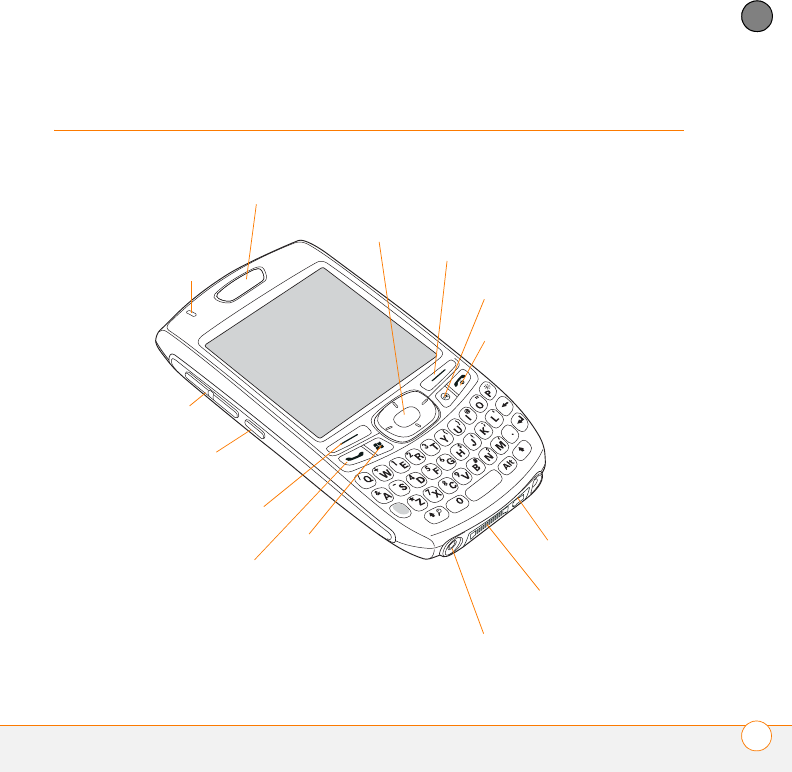
SETTING UP
PALM TREO 800W SMARTPHONE OVERVIEW 7
2
CHAPTER
Palm Treo 800W smartphone overview
Front view
Charge indicator light
(visible only when
smartphone is
connected to AC
charger)
Multi-connector
5-way navigator
with Center button
Earpiece
Power/End
Microphone
Headset jack
Start
Phone/Send
Side button
OK
Volume
Left action
key
Right action key
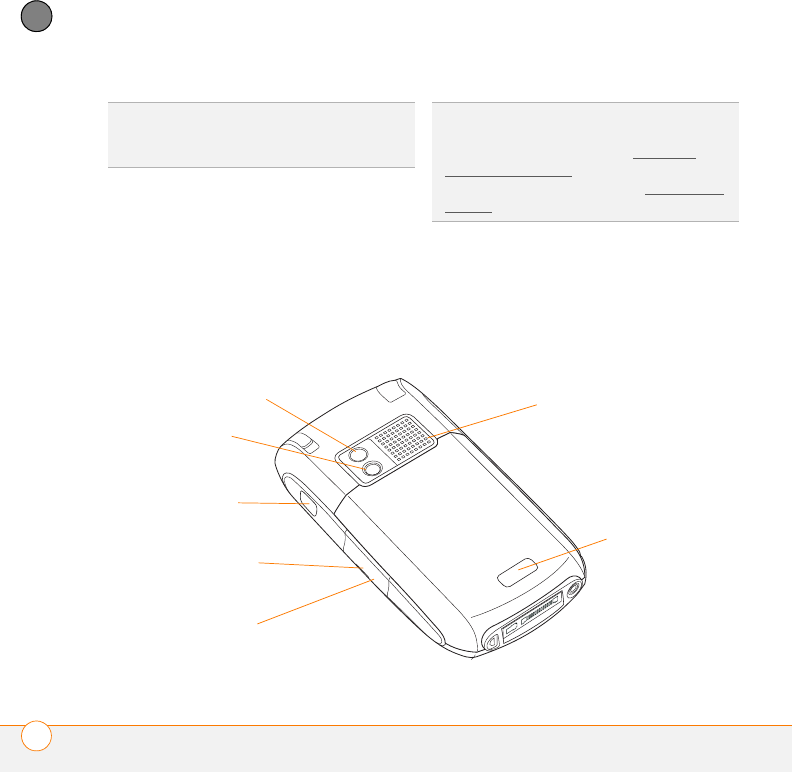
SETTING UP
PALM TREO 800W SMARTPHONE OVERVIEW
8
2
CHAPTER
IMPORTANT The smartphone speaker
includes a large magnet, so be sure not to
store your smartphone near credit cards or
other items that could be demagnetized.
Back view
TIP
Be careful not to scratch or crush your
smartphone screen. Do not store it in a place
where other items might damage it.
DID
YOU
KNOW
?
By default, pressing and holding
the Side button opens the Windows Media®
Player Mobile application (see Windows
Media Player Mobile). You can change the
function of the Side button (see Reassigning
buttons).
Camera lens
Battery door
release
Speaker
Self-portrait mirror
Infrared (IR)
port
Expansion card
(miniSD) slot
Reset button
(located inside
expansion card
slot door)
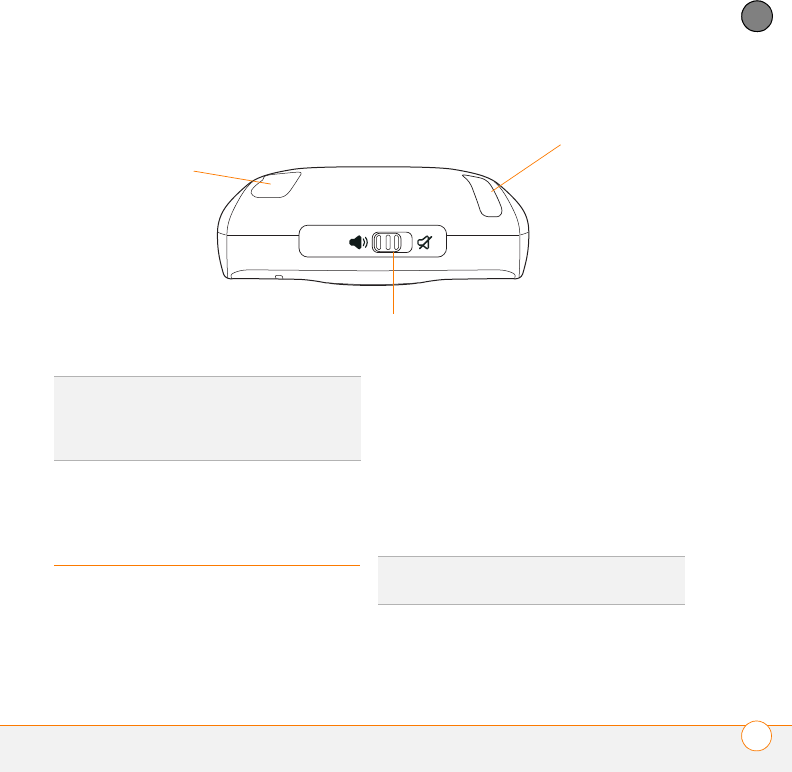
SETTING UP
INSERTING THE SIM CARD AND BATTERY 9
2
CHAPTER
Top view
Inserting the SIM
card and battery
Your SIM card contains account
information such as your phone number
and voicemail access number. To use your
smartphone’s phone, email, or web
features, you need to insert a SIM card. If a
SIM card is not included in your
smartphone box, your wireless service
provider will provide you with one.
To take advantage of the high-speed data
connection available on your smartphone,
you need to have a 3G SIM card. A 3G SIM
card has “3G” on it.
Ringer switch
Stylus
Car kit jack
DID
YOU
KNOW
?
The Ringer switch silences all
sounds, including music, at once; you don’t
need to hunt for “off” or “mute” settings in
individual applications.
TIP
If you don’t have a SIM card, contact your
wireless service provider.
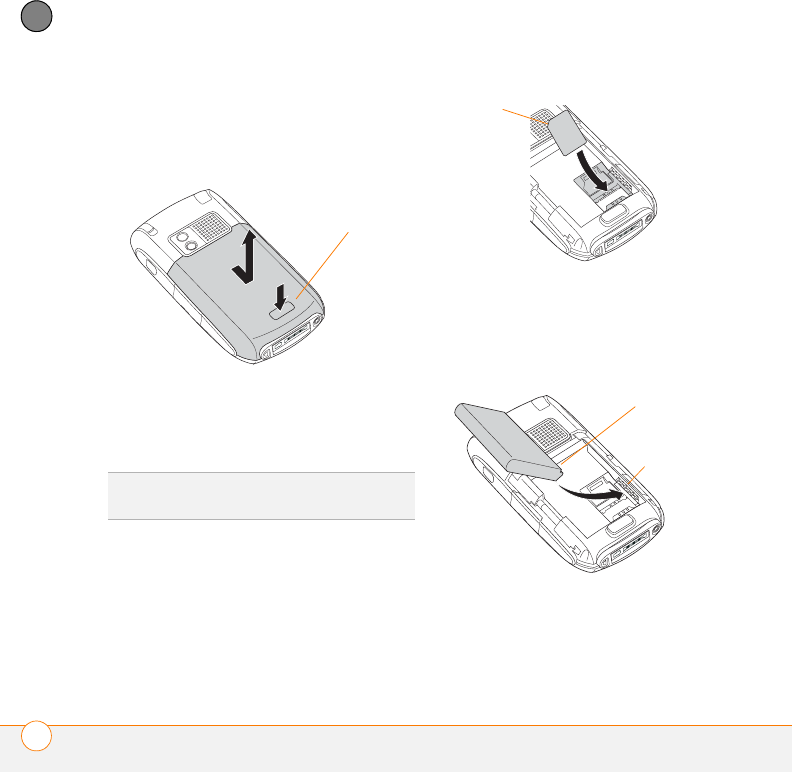
SETTING UP
INSERTING THE SIM CARD AND BATTERY
10
2
CHAPTER
1Use one hand to press the Battery
door release, and use your other hand
to slide the battery door downward to
remove it from your smartphone.
2If the battery is installed, remove it.
Slide your finger under the left side of
the battery (nearest the stylus) and lift
up to remove it.
3With the metal contacts facing the
battery compartment, slide the SIM
card into the cutout in the lower-right
corner of the compartment until you
feel it snap into place. Align the notches
to make sure you have the card oriented
correctly.
4Align the metal contacts on the battery
with the contacts inside the battery
compartment, insert the battery into the
compartment at a 45-degree angle, and
then press it into place.
5Slide the battery door back into place.
Your smartphone screen turns on.
Wait for the progress bar to fill and the
Windows Mobile® screen to appear.
TIP
It is easier to remove the battery if you first
remove the stylus from your smartphone.
Battery door
release
Notch
Battery
contacts
Phone
contacts

SETTING UP
CHARGING THE BATTERY 11
2
CHAPTER
6Follow the onscreen instructions to
finish the installation.
7If your SIM card is not already activated,
follow the activation steps provided by
your wireless service provider, or
contact your wireless service provider
directly for assistance. If you plan to use
email and web browsing, you need a
data service plan from your wireless
service provider in addition to your
service contract. You may also need a
data service plan to send and receive
multimedia messages.
Charging the battery
Although the battery may come with a
sufficient charge to complete the setup
process, we recommend that after setup
you charge your smartphone for three
hours (or until the indicator light is solid
green) to give it a full charge. See
Maximizing battery life for tips on making
your battery’s power last longer.
BEFORE YOU BEGIN Make sure the
battery is inserted in your smartphone
before you charge. If you connect your
smartphone to a power source without the
battery inserted, nothing happens.
1If you have international adapters in your
smartphone package, prepare the AC
charger by inserting the adapter that fits
the wall outlet you’re going to use.
2Plug the AC charger into a wall outlet.
3With the arrow on the connector facing
up (toward your smartphone screen),
connect the charger cable to the bottom
of your smartphone.
TIP
If your smartphone does not turn on after
you insert the battery, you need to connect it
to the AC charger to charge it (see Charging
the battery). If it still doesn’t start, perform a
soft reset (see Performing a soft reset).
TIP
You can buy an extra battery as a spare for
long airplane trips or periods of heavy data
use. To ensure proper functioning and avoid
voiding the warranty, be sure to use batteries
from Palm only. Visit www.palm.com.
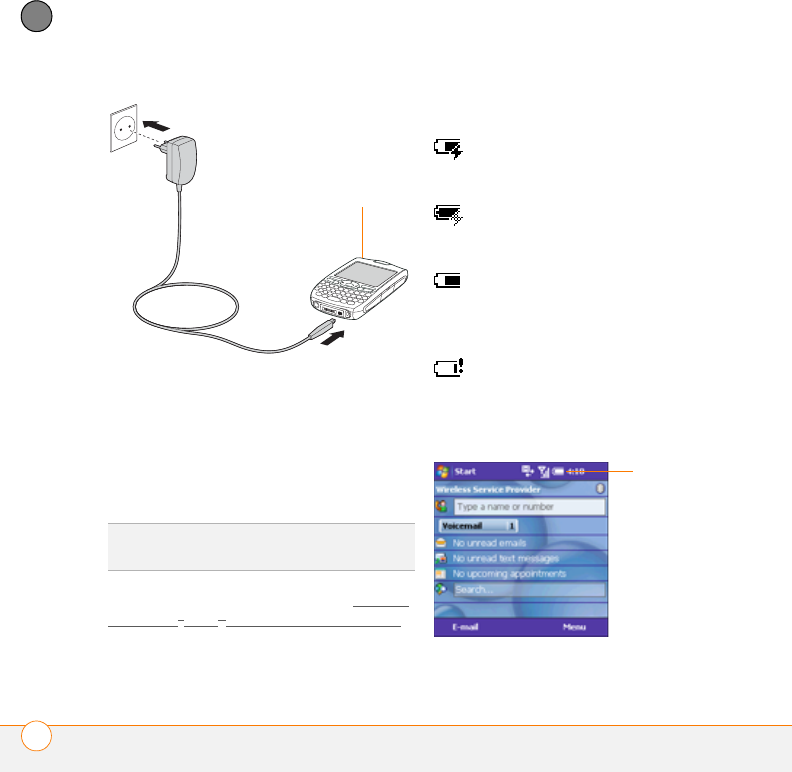
SETTING UP
CHARGING THE BATTERY
12
2
CHAPTER
4Check the indicator light to confirm that
your smartphone is charging.
•Solid red indicates that your
smartphone is charging.
•Solid green indicates that your
smartphone is fully charged.
When your smartphone is on (see Turning
your Palm® Treo™800W smartphone on/off),
the onscreen battery icon displays the
charging status:
DID
YOU
KNOW
?
If the battery is low, the indicator
light flashes red.
Indicator light
A solid lightning bolt indicates that
the battery is connected to a wall
outlet and is charging.
A shaded lightning bolt indicates
that the battery is connected to a
wall outlet and is fully charged.
A partial battery without a lightning
bolt indicates that the battery is not
connected to a wall outlet and that
it has some power.
An exclamation point (!) indicates
that the battery needs to be
charged immediately.
Battery
icon
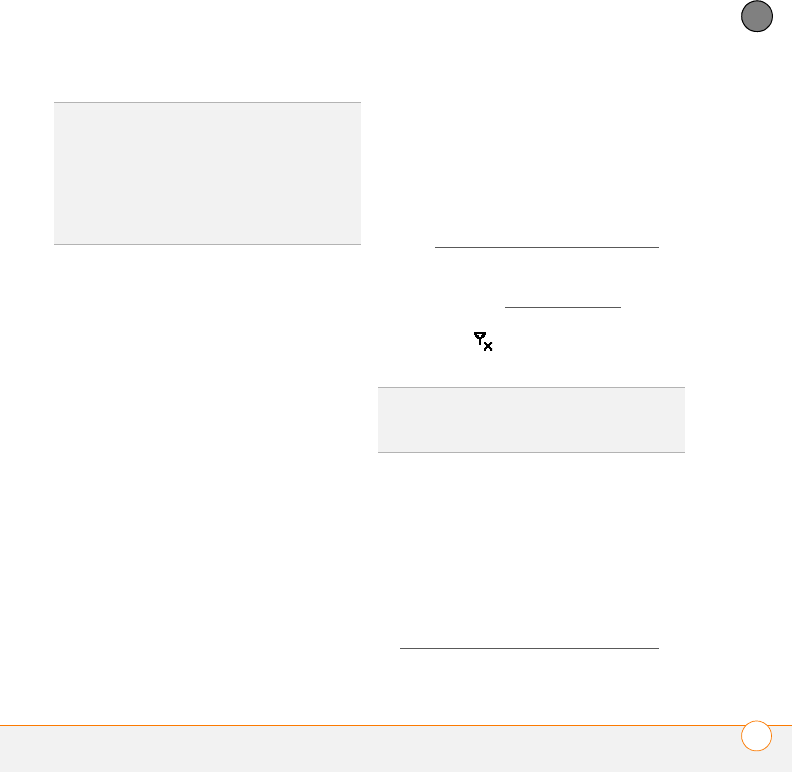
SETTING UP
CHARGING THE BATTERY 13
2
CHAPTER
Maximizing battery life
Battery life depends on how you use your
smartphone. You can maximize the life of
your battery by following a few easy
guidelines:
•Charge your smartphone whenever
you’re at your desk, or charge
it overnight each day. The battery in your
smartphone has a much longer useful
life if you charge it frequently instead of
waiting until it’s fully drained.
•If you spend a lot of time using the
camera, games, media players
(including listening to music with
wireless headphones using the built-in
Bluetooth® wireless technology), or
other applications, keep an eye on the
battery icon and charge when
necessary.
•The wireless features (phone, email,
messaging, and web) on your
smartphone generally consume more
power than the organizer features.
If you don’t plan to use the wireless
features on your smartphone for a
while, turn off your wireless services
(see Turning wireless services on/off).
You can forward calls to a different
number or let all calls be picked up by
voicemail (see Forwarding calls). To see
if your wireless services are on, tap the
phone-off icon and select Wireless
Manager.
•If you are synchronizing email and other
information directly with your corporate
Exchange server using Microsoft
Exchange ActiveSync®, set the
synchronization interval to a maximum
of every 15 minutes during peak times
and every hour (or turned off
completely) during non-peak times (see
Setting the synchronization schedule).
DID
YOU
KNOW
?
If your battery ever becomes fully
drained, your info remains safely stored on
your smartphone. Recharge the battery to
access your info.
TIP
You can also charge your smartphone from
your computer by connecting them with the
sync cable.
DID
YOU
KNOW
?
You can also see if your wireless
services are on by pressing Menu (right action
key) and selecting Wireless Manager.
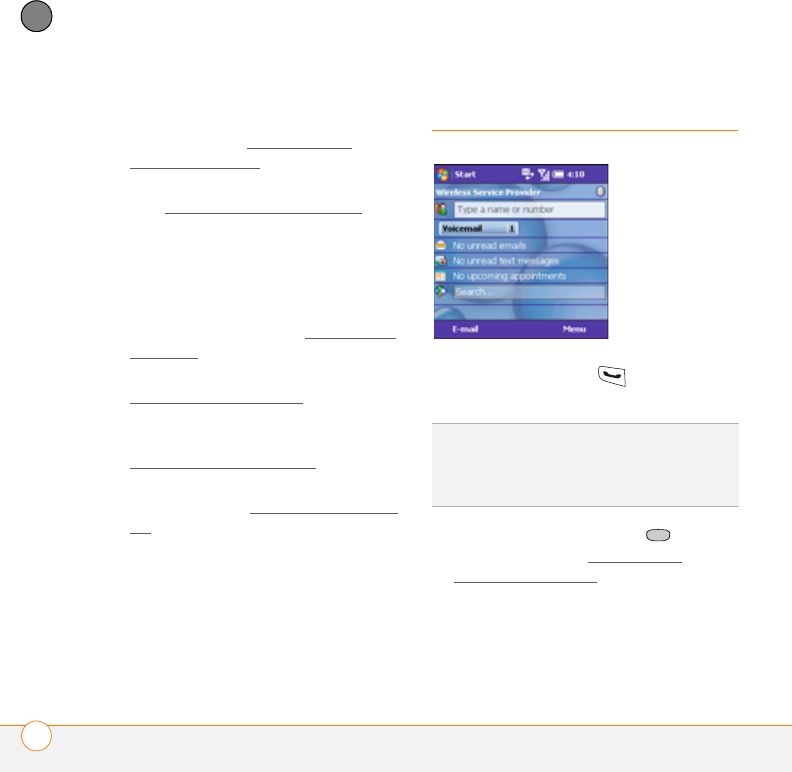
SETTING UP
MAKING YOUR FIRST CALL
14
2
CHAPTER
•Turn off the Bluetooth feature when you
do not need to make a Bluetooth
connection (see Entering basic
Bluetooth settings).
•Turn the voice command feature off
(see Setting up voice commands).
•As with any mobile phone, if you are in
an area with no wireless coverage, your
smartphone searches for a signal, which
consumes power. If you cannot move to
an area of better coverage, temporarily
turn off your phone (see Turning your
phone off).
•Turn down the screen brightness (see
Adjusting the brightness).
•Set your screen to turn off automatically
after a shorter period of inactivity (see
Optimizing power settings).
•Turn off the option to receive beamed
information (see Beaming an entry or
file).
•Keep your battery away from direct
sunlight and other sources of heat.
Temperatures over 50 degrees Celsius
(120 degrees Fahrenheit) can
permanently reduce the capacity and
life span of any lithium-ion battery.
Making your first call
1Press Phone/Send to display your
Today screen.
2If prompted, press Center to turn
off Keyguard (see Locking your
keyboard (Keyguard) for more info).
3Use the number pad on the keyboard to
enter the number you want to call.
TIP
You can also press Power/End to display
your Today screen, unless you are on a call. If
you’re on a call, pressing Power/End hangs up
the call.
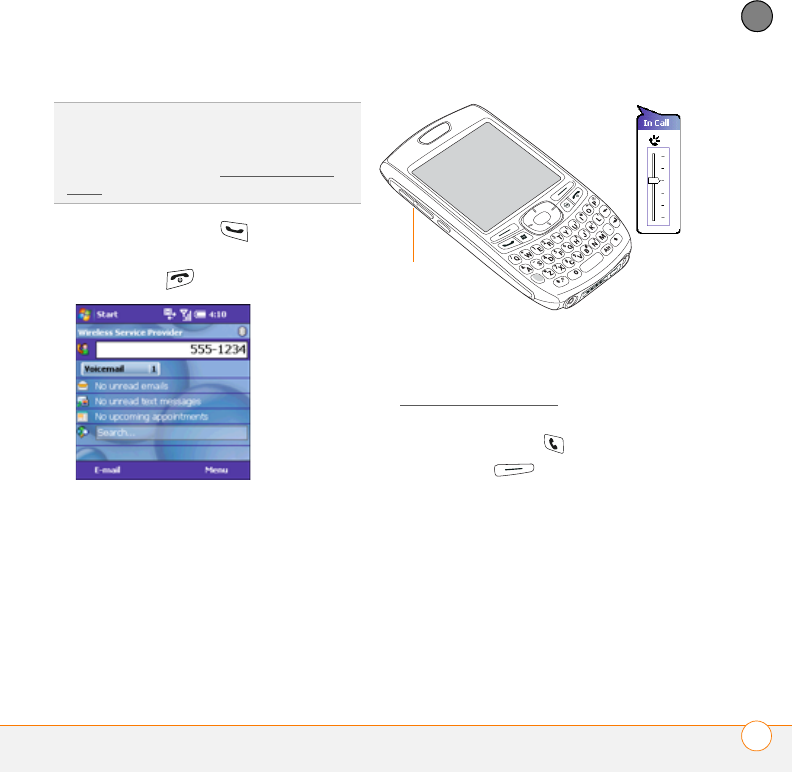
SETTING UP
MAKING YOUR FIRST CALL 15
2
CHAPTER
4Press Phone/Send to dial.
5When your call is complete, press
Power/End to end the call.
Adjusting call volume
While a call is in progress, press the
Volum e button on the side of your
smartphone to adjust the call volume.
What’s my number?
1Make sure your phone is on (see
Turning your phone on).
2If you do not see your Today screen,
press Phone/Send .
3Press Menu (right action key).
4Select Preferences > Phone Settings.
5On the Phone tab, look for your phone
number below the title bar.
TIP
The Dial Lookup list might appear while you
are dialing a number. Continue entering
numbers to place the call. For more info on
the Dial Lookup list, see Dialing by contact
name.
Volume
button
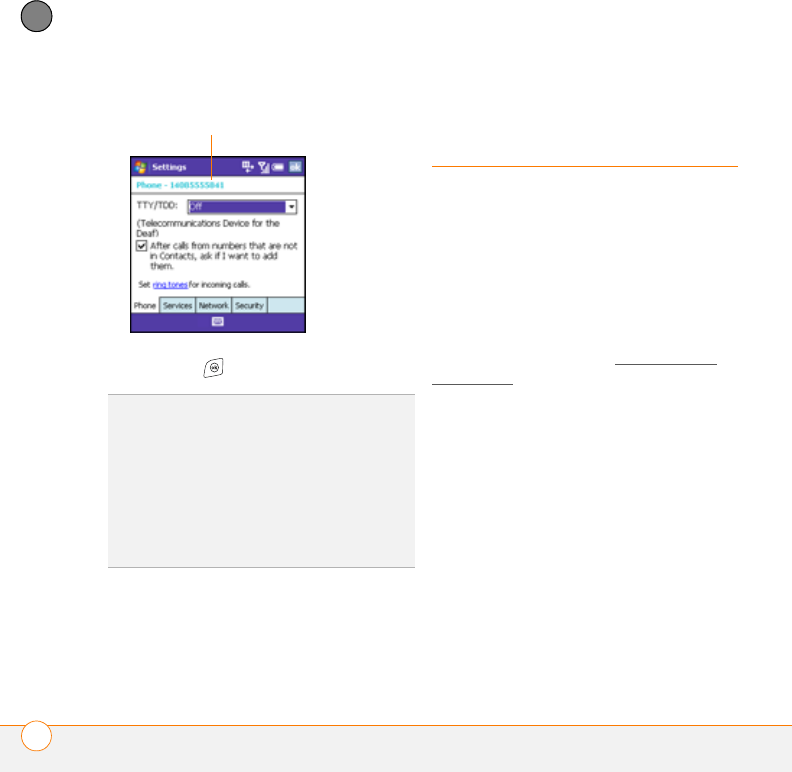
SETTING UP
SETTING UP SYNCHRONIZATION
16
2
CHAPTER
6Press OK .
Setting up
synchronization
After you’ve finished setting up your
smartphone, we recommend that you set
up a synchronization method to get the
most out of your smartphone.
Synchronizing means that information that
has been entered or updated in one
place—your smartphone, your computer,
or your corporate server—is automatically
updated in the other (see Synchronizing
information).
TIP
If your phone number doesn’t appear on
the Phone Settings screen, your network has
not yet sent the number to the SIM card (this
does not affect SIM card functionality). Turn
your phone off, wait a few hours, and then
turn on your phone and repeat these steps. If
your phone number still does not appear,
please contact your wireless service provider
for assistance.
Look here for your
phone number

CHAPTER
3
Moving around on your
Palm®Treo™ 800W smartphone
Have you ever been to a new city and felt a bit lost until you
figured out the streets? Learning to move around on your
Palm® Treo™800W smartphone is similar. Most applications that
work on your smartphone use the same set of controls. So
once you learn how to use these controls, you’ll be driving all
over town and you won’t even need a map.
Benefits
•Quickly move around and
complete tasks in applications
using one thumb on the 5-way
navigator
•Access extra features with menus
•Find and open applications quickly

In this chapter
Navigating around the screen . . . . . . . . . . . . . . . . . . . . . . . . . . . . . 19
Using the keyboard . . . . . . . . . . . . . . . . . . . . . . . . . . . . . . . . . . . . . 26
Opening and closing applications. . . . . . . . . . . . . . . . . . . . . . . . . . . 30
Using your Today screen . . . . . . . . . . . . . . . . . . . . . . . . . . . . . . . . . 31
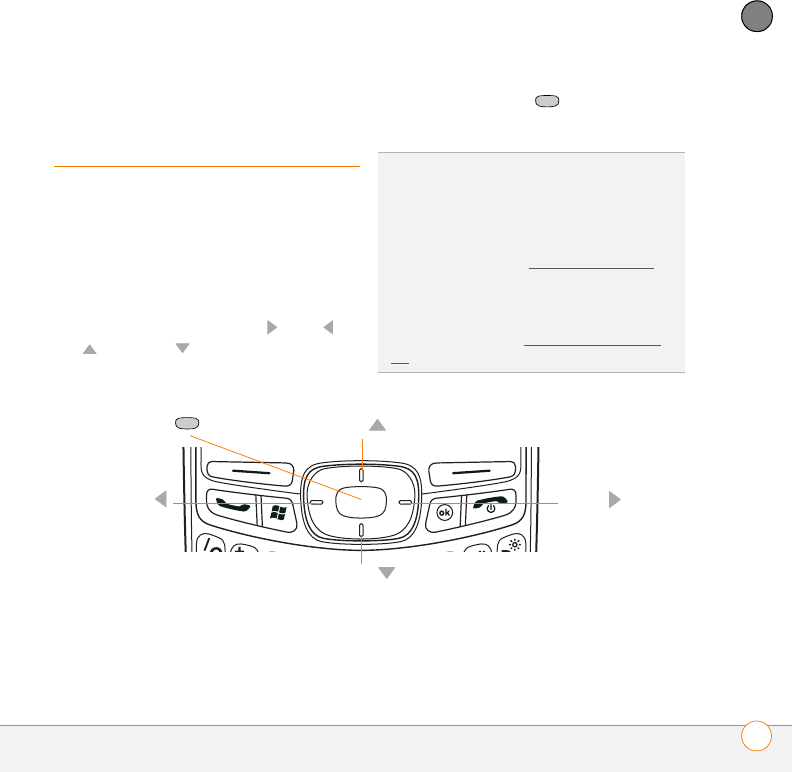
MOVING AROUND ON YOUR PALM®TREO™ 800W SMARTPHONE
NAVIGATING AROUND THE SCREEN 19
3
CHAPTER
Navigating around
the screen
To navigate around the smartphone screen,
you can use the 5-way navigator or you can
tap items on the screen with the stylus. As
you become familiar with your
smartphone, you’ll find your own favorite
way to scroll, highlight, and select items.
Using the 5-way, press Right , Left ,
Up , or Down to move around the
screen. Press Center to highlight and
select items.
TIP
Some third-party applications may not work
with the 5-way navigator, and you must use
the stylus instead.
DID
YOU
KNOW
?
Custom navigation features are
available when you browse the web using
Internet Explorer (see Viewing a web page).
TIP
The arrow icons that indicate directions on
the 5-way are different from the onscreen
scroll arrows and the arrows that indicate that
a list is available (see Selecting options in a
list).
Up
Down
Left Right
Center
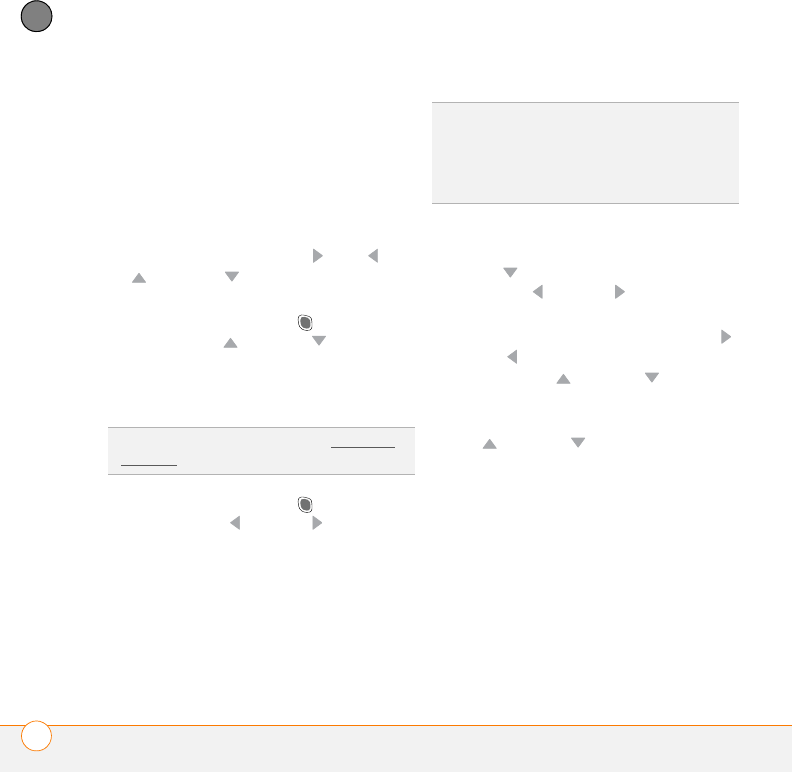
MOVING AROUND ON YOUR PALM®TREO™ 800W SMARTPHONE
NAVIGATING AROUND THE SCREEN
20
3
CHAPTER
Scrolling through screens
As on a computer, on your smartphone you
scroll to move from field to field or page to
page, or in some cases to highlight an item
or option in a list. There are several
methods of scrolling:
•Press the 5-way on the front of your
smartphone. Press Right , Left , Up
, or Down to move to the next
field, button, or action in that direction.
•Press and hold Option while
pressing Up or Down to scroll
one screen at a time. These keys work
just like the Page Up and Page Down
keys on your computer keyboard.
•Press and hold Option while
pressing Left or Right to jump to
the top or bottom of the current
document or entry.
•When viewing a screen with tabs, such
as when adding a contact, press
Down to scroll to the tabs, and then
press Left or Right to move
between tabs.
•When inside a text field, press Right
or Left to move to the next character,
and press Up or Down to move
between lines.
•When inside a list, press and hold
Up or Down to rapidly scroll
through the list.
TIP
Can’t find the Option key? See Using the
keyboard.
TIP
When you are using applications such as
Inbox, Internet Explorer Mobile, and Word
Mobile, press and hold Option while pressing
Left or Right on the 5-way to automatically go
to the top and bottom of a screen.
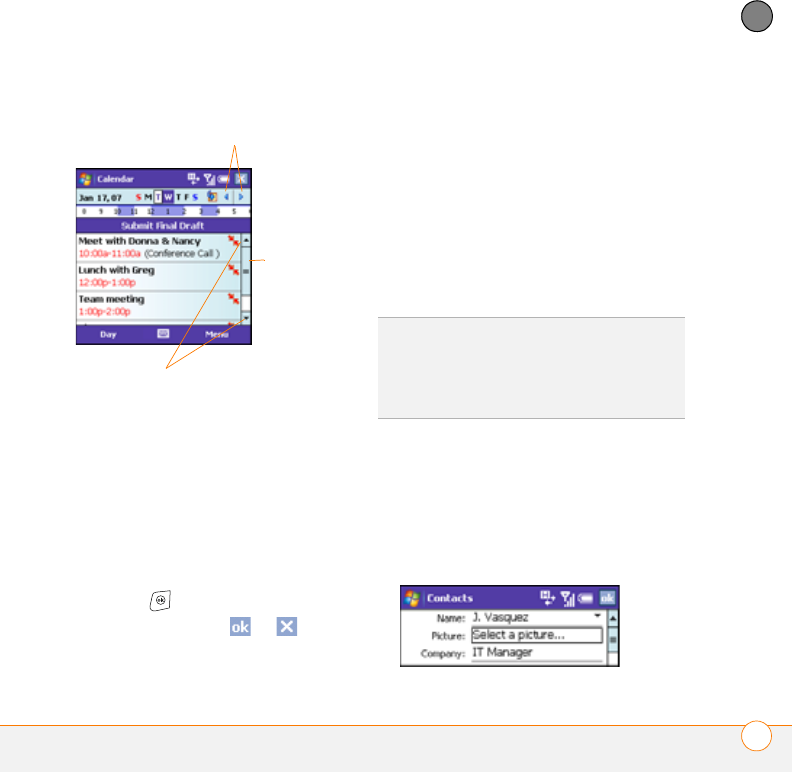
MOVING AROUND ON YOUR PALM®TREO™ 800W SMARTPHONE
NAVIGATING AROUND THE SCREEN 21
3
CHAPTER
•Tap an onscreen scroll arrow.
•Tap and drag the slider of an onscreen
scroll bar.
Closing screens
To accept the information you entered on a
screen and to return to the previous
screen—or to return to the previous screen
without making any changes—do one of
the following:
•Press OK .
•Use the stylus to tap or in the
upper-right corner of the screen. These
buttons are not accessible using the
5-way.
Highlighting and selecting items
On most screens, one item—a button, a
list entry, or a check box—is highlighted by
default. The highlight identifies which item
is affected by your next action. Use the
5-way to move the highlight from one item
to another before opening or selecting it.
The highlight can take one of two forms,
depending on what is highlighted:
•Border: This rectangular border
highlights items such as an onscreen
button (such as OK, Dismiss, or Hide), a
check box, an option, or a web link.
Scroll arrows
Scroll arrows
Scroll bar
with slider
TIP
The best way to learn to use the 5-way is to
experiment. Press the 5-way buttons, and as
you do, follow the movement of the border
around the screen. The behavior of the 5-way
varies slightly in each application.
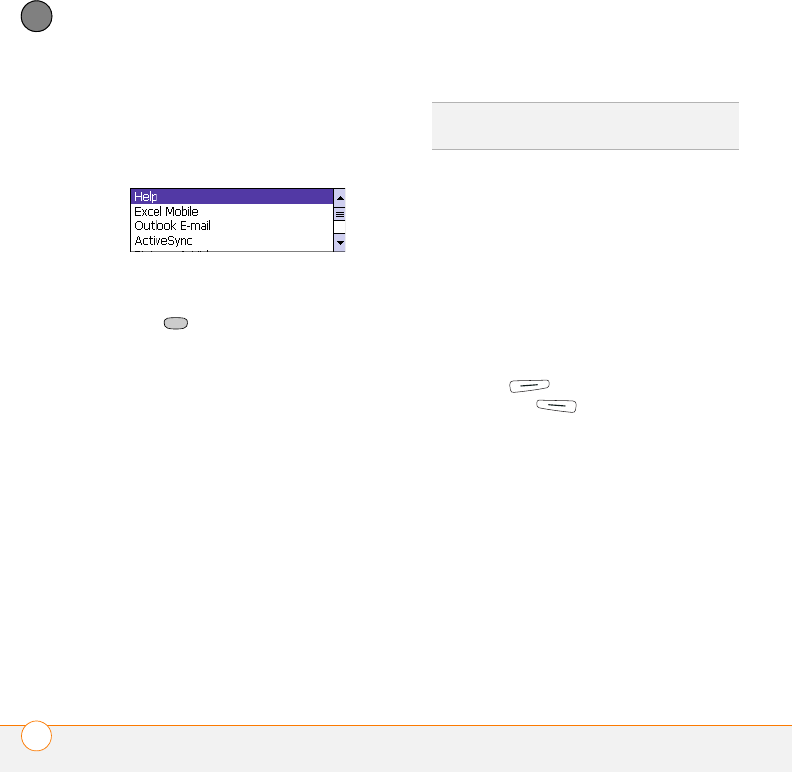
MOVING AROUND ON YOUR PALM®TREO™ 800W SMARTPHONE
NAVIGATING AROUND THE SCREEN
22
3
CHAPTER
•Light text on a dark background: This
highlights items such as a phone
number, an email address, text, or an
item in a list.
After highlighting an item with the 5-way,
you can select or activate it by pressing
Center or by tapping the item with the
stylus.
Highlighting text
You can use the stylus to highlight text on
the screen. Tap and drag the stylus across
the text you want to highlight. To highlight
a word, double-tap it. To highlight a
paragraph, triple-tap it.
Using the action keys
The left and right action keys give you quick
access to tasks that you can do on the
current screen, so the action key items
vary from application to application and
from screen to screen. Look on the screen
directly above the action key to see the
action that it takes in the current context.
In some contexts, these keys may do
nothing at all. In most cases the right
action key opens the menu, and the
left action key activates a specific
command, such as New or Edit.
Remember that action key functions vary
from screen to screen, so be sure to check
the onscreen label before pressing the
action keys.
TIP
When text is highlighted, you can press
Backspace to delete the highlighted text.
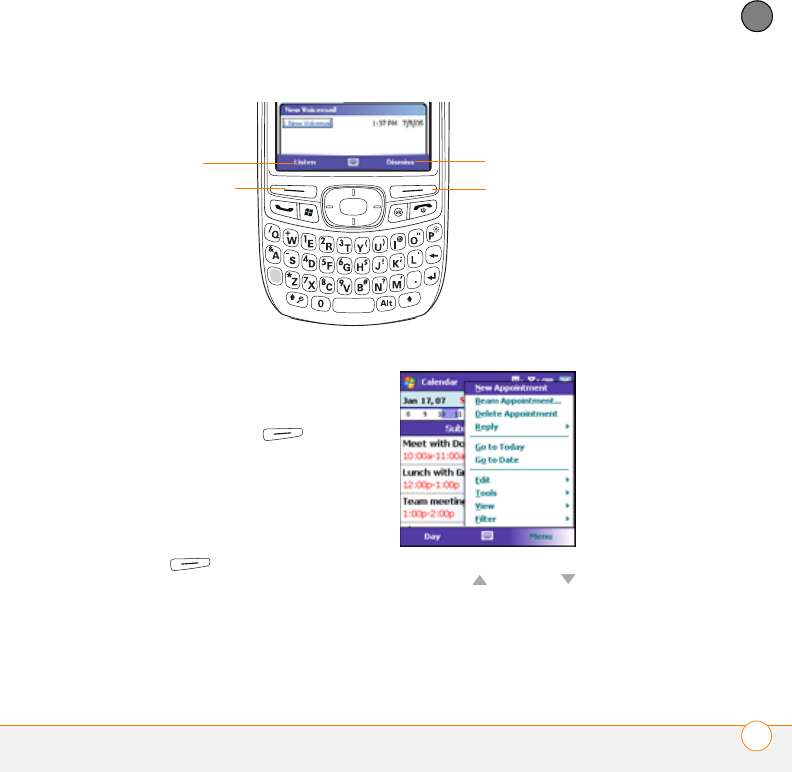
MOVING AROUND ON YOUR PALM®TREO™ 800W SMARTPHONE
NAVIGATING AROUND THE SCREEN 23
3
CHAPTER
Selecting menu items
In many applications, a menu provides
access to additional features. The menu is
hidden until you press Menu (right
action key). To get the most out of your
smartphone, it’s a good idea to familiarize
yourself with the additional features
available through the menu in various
applications.
1Press Menu (right action key) to
display an application’s menu. 2Press Up or Down to highlight a
menu item.
Left action key Right action key
Left action key
activates this
command
Right action key
activates this
command
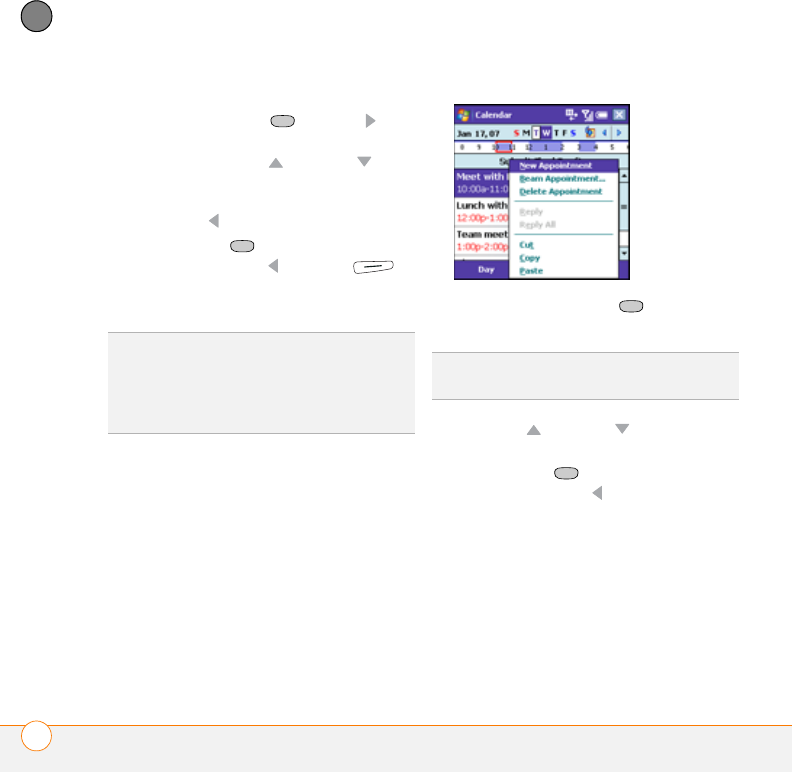
MOVING AROUND ON YOUR PALM®TREO™ 800W SMARTPHONE
NAVIGATING AROUND THE SCREEN
24
3
CHAPTER
3If an arrow appears next to a menu
item, press Center or Right to
display additional options for that item,
and then press Up or Down to
highlight a menu item. To return to the
main menu without making a selection,
press Left .
4Press Center to select the menu
item, or press Left or Menu
(right action key) to close the menu and
cancel your selection.
Selecting options in a shortcut menu
Most applications also provide access to
context-sensitive shortcut menus—similar
to the right-click menus on a computer. The
shortcut menu options vary based on the
highlighted selection.
1Highlight the item whose shortcut
menu you want to see.
2Press and hold Center to open the
shortcut menu.
3Press Up or Down to highlight a
menu item.
4Press Center to select the menu
item, or press Left to cancel your
selection.
Selecting options in a list
Lists enable you to select from a range of
options. You can identify whether a list is
available when you select the field. If a
rectangle appears around the field along
with a downward-pointing arrow, a list is
DID
YOU
KNOW
?
You can select most menu items
by pressing a key on the keyboard. To quickly
access a menu item, press Menu (right action
key) followed by the underlined letter in the
menu item’s name.
TIP
You can also tap and hold the stylus on an
item to open the shortcut menu.
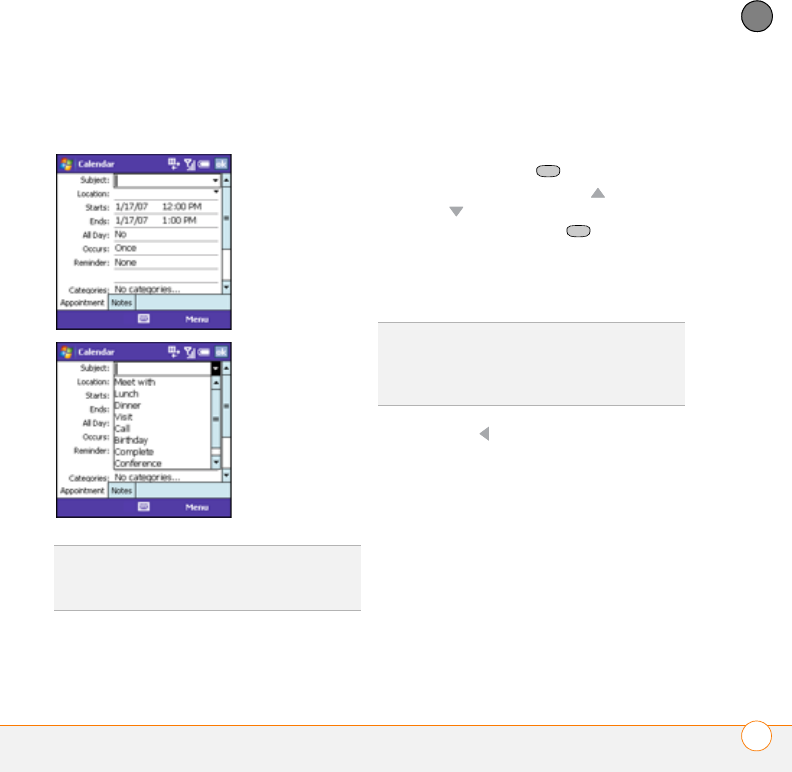
MOVING AROUND ON YOUR PALM®TREO™ 800W SMARTPHONE
NAVIGATING AROUND THE SCREEN 25
3
CHAPTER
available. Lists are different from the
menus described earlier in this section.
To select from a list, do any of the
following:
•Use the 5-way to highlight the field, and
then press Center to display the
items in the list. Press Up or
Down to highlight the item you want,
and then press Center to make
your selection.
•Use your stylus to tap the arrow, and
then tap the item in the list.
•Press Left to exit the list and cancel
your selection.
TIP
When selecting fields you might not see
the downward-pointing arrow until you press
Center on the 5-way.
DID
YOU
KNOW
?
In fields where you see a
downward-pointing arrow but no rectangle,
you must tap the arrow with the stylus to
display the list.
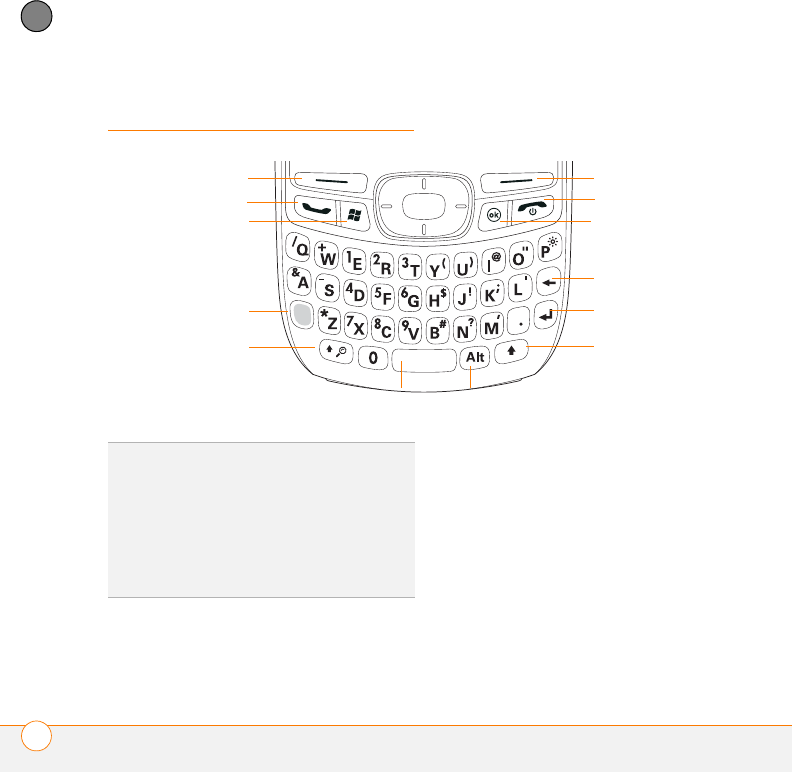
MOVING AROUND ON YOUR PALM®TREO™ 800W SMARTPHONE
USING THE KEYBOARD
26
3
CHAPTER
Using the keyboard
Understanding the keyboard backlight
Your smartphone includes a keyboard
backlight for low light conditions. The
keyboard backlight activates automatically
when the screen turns on. The backlight
turns off automatically when the screen
turns off or when you are on a call or
playing music in the background for longer
than the time specified in Backlight
Settings. You can set different time
intervals depending on whether the
smartphone is operating on battery power
Left
action key Right
action key
Phone/Send
Start
Power/End
OK
Backspace
Option
Shift/Search
Space
Return
Shift
Alt
DID
YOU
KNOW
?
You can also use the onscreen
keyboard to enter letters, numbers, and other
characters in applications that support this
feature. Tap the keyboard icon in the center at
the bottom of any screen where it appears.
After opening the keyboard, you can set
various input options by tapping the arrow to
the right of the keyboard icon.
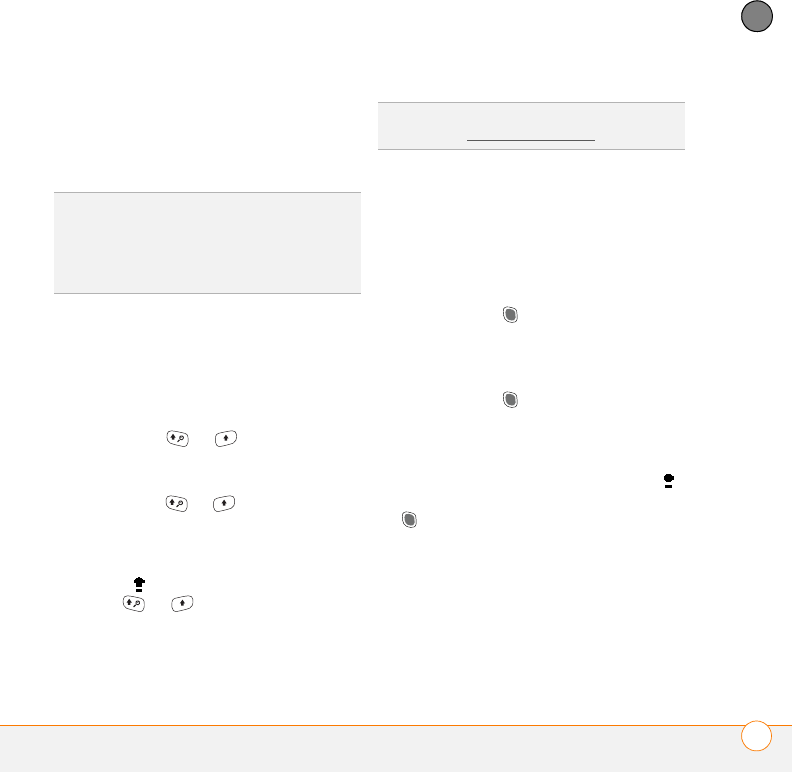
MOVING AROUND ON YOUR PALM®TREO™ 800W SMARTPHONE
USING THE KEYBOARD 27
3
CHAPTER
or is connected to an external power
source. The backlight also turns off when
an application’s power-saving features turn
it off.
Entering lowercase and uppercase letters
By default, the first letter of each sentence
or field is capitalized and the remaining text
you enter is lowercase. To enter other
uppercase letters, do one of the following:
•Press Shift ( or ), and then enter
a letter. You don’t need to press and
hold Shift while entering a letter.
•Press Shift ( or ) twice to turn on
Caps Lock, and then enter a series of
letters. When Caps Lock is on, this
symbol appears at the bottom of the
screen: . To turn off Caps Lock, press
Shift ( or ) again.
Entering numbers, punctuation, and
symbols
Numbers, punctuation, and symbols
appear above the letters on the keys. To
enter these characters, do one of the
following:
•Press Option , and then press the
key of the desired character. You don’t
need to hold Option while pressing the
key.
•Press Option twice to turn on
Option Lock, and then press the desired
keys to enter a series of characters.
When Option Lock is on, this symbol
appears at the bottom of the screen: .
To turn off Option Lock, press Option
again.
TIP
You can change the backlight shut-off
interval. Press Start and select Settings.
Select the System tab, and then select
Backlight. Set the time interval on the Battery
Power tab and on the External Power tab.
TIP
You can turn off the first-letter capitalization
setting (see Setting input options).

MOVING AROUND ON YOUR PALM®TREO™ 800W SMARTPHONE
USING THE KEYBOARD
28
3
CHAPTER
Entering other symbols and accented
characters
You can enter symbols and accented
characters that don't appear on the keys by
using the alternate characters list.
1Press Alt to display the alternate
character list.
2Narrow the list by pressing the key that
corresponds to the character you want.
For example, to enter an é, press e. See
the table below for a list of
corresponding characters.
3Press Up or Down to highlight the
desired character.
4Press Center to insert the
character.
TIP
The alternate characters are grouped
according to their similarity to the
corresponding key. For example, the alternate
character available for the R key is ®, and for
the T key is ™. If you press the wrong key,
press Backspace to return to the full list of
alternate characters. You can then press
another key.
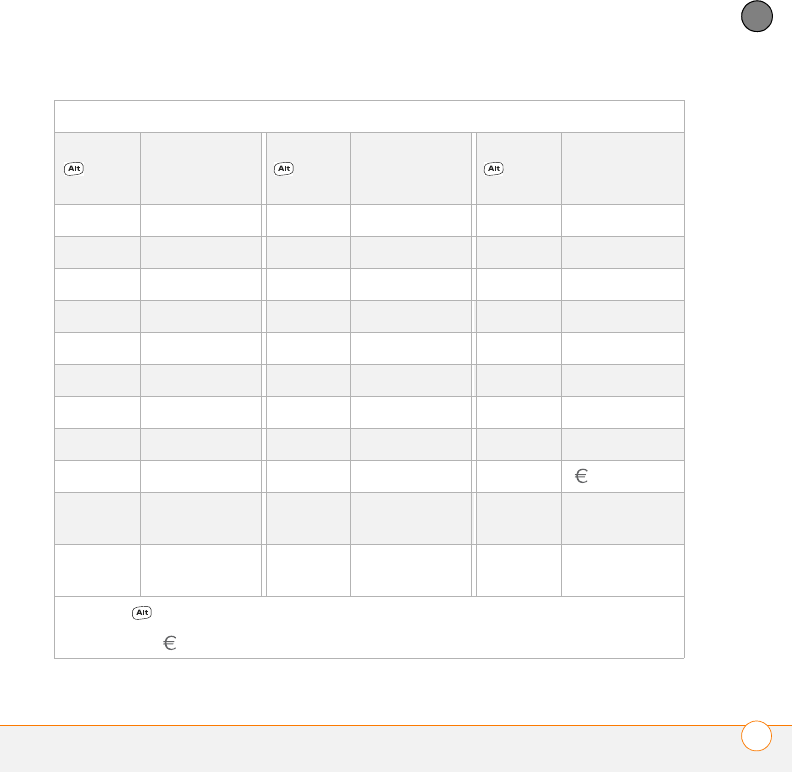
MOVING AROUND ON YOUR PALM®TREO™ 800W SMARTPHONE
USING THE KEYBOARD 29
3
CHAPTER
0
Symbols and accented characters
Press Alt
and
press…
to select… Press Alt
and
press…
to select… Press Alt
and
press…
to select…
a á à ä â ã å æ n ñ x or X x ¤
AÁ À Ä Â Ã Å Æ N Ñ y ý ÿ
b or B ß o ó ò ö ô œ õ Y Ý Ÿ
cç ¢ © OÓ Ò Ö Ô Œ Õ 0°
C Ç ¢ © p or P ¶ 1 1¼½
eé è ë ê r or R ® 2 2
E É È Ë Ê s ß š 3
3
¾
f or F ƒ S ß Š ! ¡
i í ì ï î t or T ™ $ £ ¥ ¢
IÍ Ì Ï Î uú ù ü û Option +
K (;)
: :-) :-( ;-)
l or L £ U Ú Ù Ü Û Option +
N (?)
¿
Press Alt by itself to select these characters:
: _ • % = ÷ ^ £ ¥ ¢ $ [ ] { } < > « » © ® ° ~ \ Ø μ |
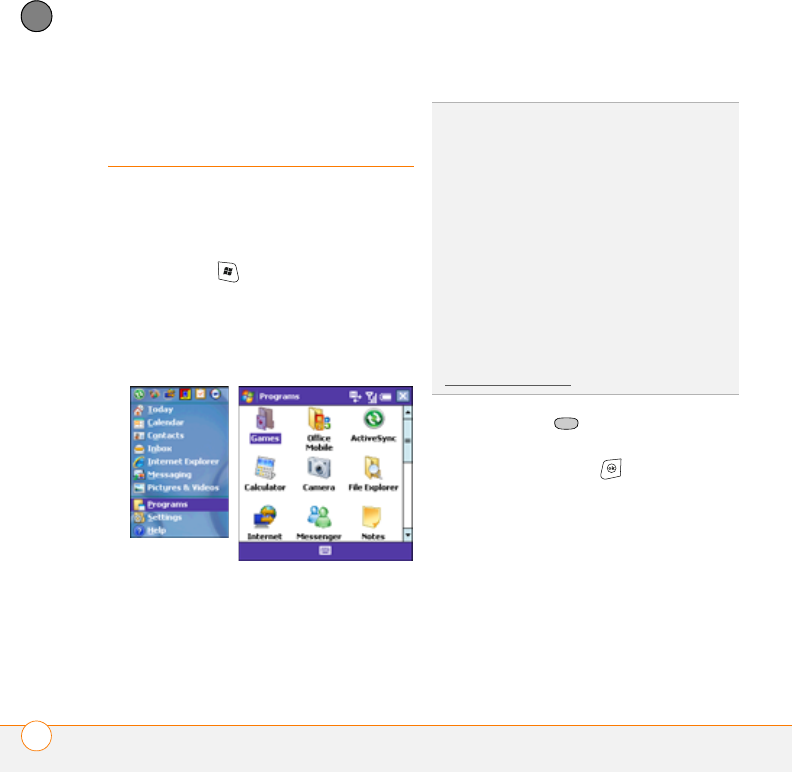
MOVING AROUND ON YOUR PALM®TREO™ 800W SMARTPHONE
OPENING AND CLOSING APPLICATIONS
30
3
CHAPTER
Opening and closing
applications
Opening applications
You can access all the applications on your
smartphone through the Start menu.
1Press Start to open the Start menu.
2Use the 5-way navigator to highlight the
application you want to use. To view
additional applications, select
Programs.
3Press Center to open the
highlighted application.
4(Optional) Press OK to return to
Programs and open another application.
The current application continues to run
in the background.
Closing applications
You can have several applications open at
once, so you don’t need to exit an
application to open another one. In most
cases, applications close automatically
TIP
With the Start menu open, press the letter
underlined in the application’s name to open
the app. For example, press H to open Help.
Or, select the shortcut icons at the top of the
Start menu to open recently used
applications.
In Programs, press a letter to jump to the first
app that begins with that letter. For example,
press C to jump to Calculator. Press C again to
jump to Camera, and so on.
DID
YOU
KNOW
?
You can open apps by pressing
and holding Option and then pressing Phone/
Send, Start, or OK. You can change which
app a button combination opens (see
Reassigning buttons).
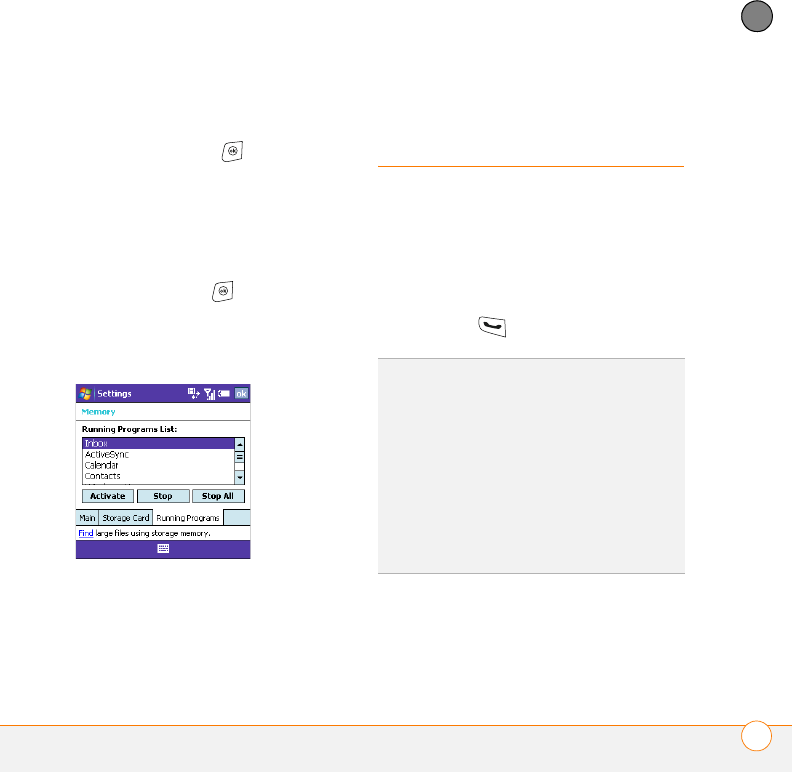
MOVING AROUND ON YOUR PALM®TREO™ 800W SMARTPHONE
USING YOUR TODAY SCREEN 31
3
CHAPTER
when available memory is low, but you can
also close applications manually.
NOTE If you press OK to leave an
application, the current application
continues to run in the background.
Manually closing applications helps
conserve battery power and frees up
memory.
1Press and hold OK to open Memory
Settings.
2On the Running Programs tab, do one
of the following:
•Select the application you want to
close, and then select Stop to close
it.
•Select Stop All to close all your open
applications.
Using your Today
screen
From your Today screen you can quickly
look up a contact, make a call, see your
latest calendar appointments, see the
number of unread email messages, and
even perform a web search.
To access your Today screen, press
Phone/Send .
TIP
If you press Phone/Send while a number
is highlighted, your smartphone dials the
number. If a number is highlighted, deselect
the number, or use the Start menu to access
the Today screen.
TIP
You can also open the Today screen by
pressing Power/End, unless you are on a call.
If you’re on a call, pressing Power/End hangs
up the call. If the Today screen is already
displayed and you’re not on a call, pressing
Power/End turns off the screen display.
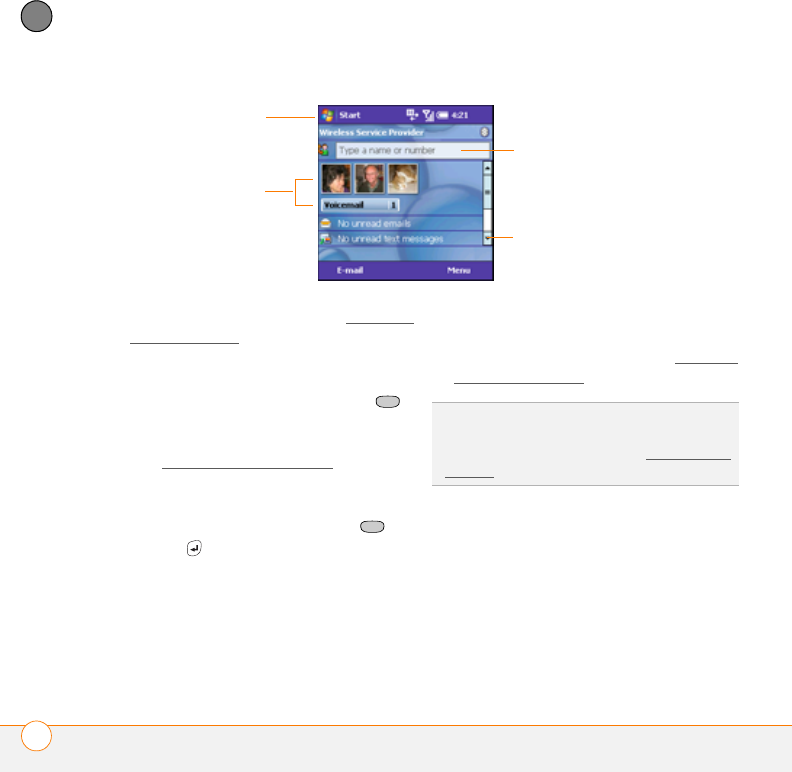
MOVING AROUND ON YOUR PALM®TREO™ 800W SMARTPHONE
USING YOUR TODAY SCREEN
32
3
CHAPTER
•Title bar and status info: See What are
all those icons? to learn about the icons
that appear in this area.
•Dial Lookup field: Type the number
you want to call and press Center
to dial, or begin typing a name to look
up the associated number in Contacts.
See Dialing by contact name for more
info.
•Web search field: Enter a web address
or a keyword, and press Center or
Return to view a list of search
results based on the address or word
(data services connection required).
•Speed-dial entries: Select a speed-dial
button—either a picture or text—to call
the number assigned to it. See Defining
speed-dial buttons to create your own.
Title bar and
status info
Dial Lookup field
Speed-dial
entries
Scroll down to view
Web search field
TIP
You can select a picture for your Today
screen background and select which items
appear in the Today screen. See Today screen
settings for details.

CHAPTER
4
Your phone
The phone, along with the Today screen, is your home base for
making and receiving calls.
You can creatively manage multiple calls; for example, you can
swap between calls, send text messages to ignored calls, and
create conference calls.
And you can do more than manage your phone calls. You can
send text messages, open applications, go to your favorite web
pages, see your upcoming appointments, and even find out
how many unread email messages you have.
Benefits
•Stay in touch—you choose how
•Work in other applications when
on an active call.
•Create speed-dial buttons with
pictures of your friends

In this chapter
Turning your Palm® Treo™800W smartphone on/off . . . . . . . . . . . . . 35
Making calls from the Today screen. . . . . . . . . . . . . . . . . . . . . . . . . 36
Other ways of making calls . . . . . . . . . . . . . . . . . . . . . . . . . . . . . . . 41
Receiving calls . . . . . . . . . . . . . . . . . . . . . . . . . . . . . . . . . . . . . . . . . 42
Using voicemail . . . . . . . . . . . . . . . . . . . . . . . . . . . . . . . . . . . . . . . . 43
What can I do during a call? . . . . . . . . . . . . . . . . . . . . . . . . . . . . . . . 44
Defining speed-dial buttons . . . . . . . . . . . . . . . . . . . . . . . . . . . . . . . 50
Customizing phone settings. . . . . . . . . . . . . . . . . . . . . . . . . . . . . . . 57
What are all those icons?. . . . . . . . . . . . . . . . . . . . . . . . . . . . . . . . . 66

YOUR PHONE
TURNING YOUR PALM® TREO™800W SMARTPHONE ON/OFF 35
4
CHAPTER
Turning your Palm®
Treo™800W
smartphone on/off
The term smartphone refers to the device
and its physical aspects. The term phone
refers to the wireless feature of your Palm®
Treo™800W smartphone that enables you
to connect to your wireless service
provider’s network so that you can make
and receive calls and send and receive
data.
The phone and the screen of your
smartphone can be turned off and on
separately. This means you can wake up
the screen to use just the organizer
features of your device without turning on
the phone. Also, when the screen is turned
off, the phone can be on and ready for you
to receive phone calls or messages.
Turning your phone on
Press and hold Power/End . When
your smartphone locates a signal, your
wireless service provider’s name appears
in the upper-left of the screen and the
signal-strength icon appears at the top
of the screen.
When you turn on your phone, it connects
to a mobile network so that you can make
and receive phone calls and use other
wireless services (if supported by the local
network). When you are inside a coverage
area, the signal-strength icon has bars
in it. If you’re outside a coverage area, the
indicator light flashes amber and no bars
appear in the signal-strength icon.
Turning your phone off
Press and hold Power/End . When
your phone is off, the phone-off icon
appears at the top of the screen and
Phone Off appears in the upper-left of the
screen. Your phone is not connected to any
mobile network. Although you can no
longer use the phone, you can still use
Microsoft Office apps and all the organizer
features of your smartphone.
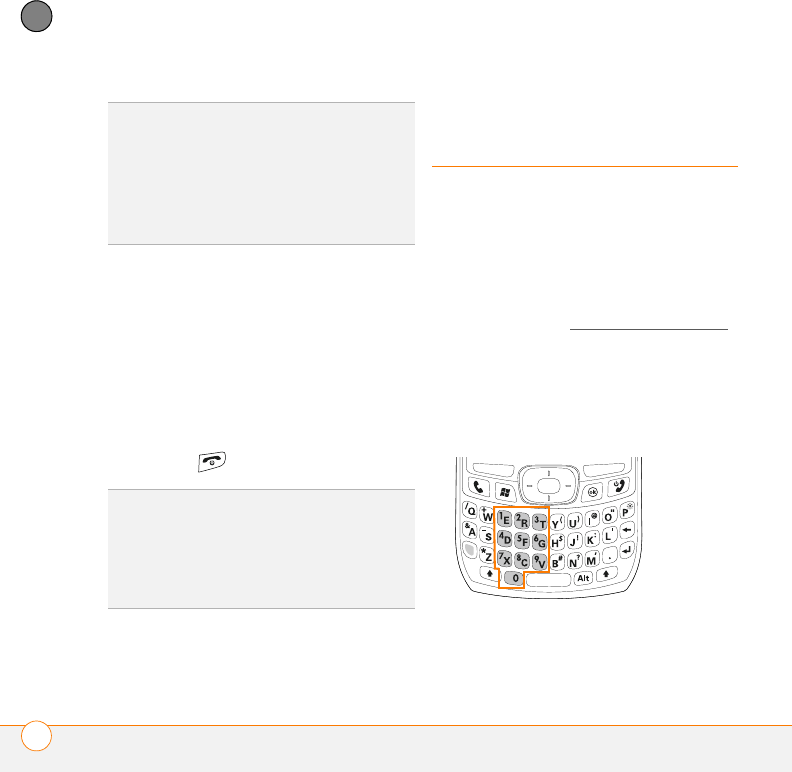
YOUR PHONE
MAKING CALLS FROM THE TODAY SCREEN
36
4
CHAPTER
Waking up the screen and turning it off
Wake up the screen and leave the phone
turned off when you want to use only the
organizer features of your smartphone, for
example, when you’re on a plane and want
to look at your calendar. You can also turn
off the screen without turning off the
wireless features on your smartphone. You
can turn your screen on and off by pressing
Power/End .
Making calls from the
Today screen
Your smartphone offers several ways to
make phone calls from the Today screen.
Dialing from the Today screen
BEFORE YOU BEGIN Make sure your
phone is on and that you’re inside a
coverage area (see Turning your phone on).
1Go to your Today screen.
2Using the numbered keys on the
keyboard, enter a phone number in the
Dial Lookup field.
DID
YOU
KNOW
?
You can also turn your phone on
and off from the Today screen by pressing
Menu (right action key), selecting Wireless
Manager, and then selecting Phone.
DID
YOU
KNOW
?
You can go to Wireless Manager
by tapping the signal-strength icon and
tapping Wireless Manager.
TIP
You can set how long the screen stays on.
Press Start, select Settings, select the
System tab, and then select Power. Select
the Advanced tab. Adjust the number of
minutes the phone stays on when idle using
the On battery power setting.
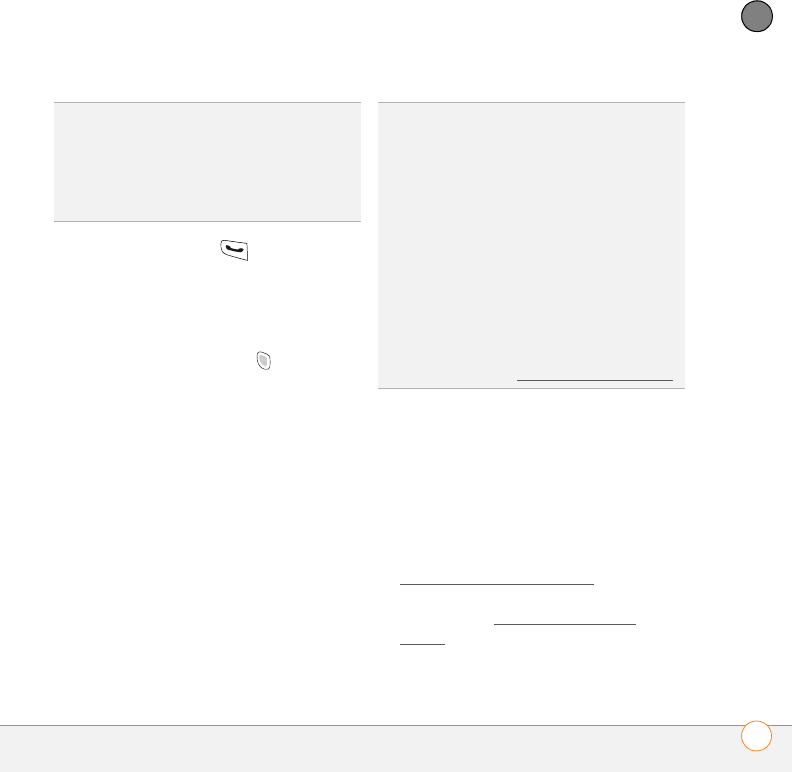
YOUR PHONE
MAKING CALLS FROM THE TODAY SCREEN 37
4
CHAPTER
3Press Phone/Send to dial.
NOTE You do not need to press Option to
access the numbers on the keyboard.
However, when dialing short numbers, the
number may conflict with a contact name.
If this occurs, press Option to avoid
starting a contact lookup. For emergencies,
you can dial your national emergency
number (such as 911 or 112) without
pressing Option first.
Dialing with a speed-dial button
Your smartphone enables you to create
both picture and text speed-dial buttons so
that you can select a button on the Today
screen to quickly dial a number.
BEFORE YOU BEGIN
•Create some speed-dial buttons. See
Defining speed-dial buttons. You can
customize the default speed-dial
buttons. See Editing a speed-dial
button.
DID
YOU
KNOW
?
When you're dialing a phone
number or are on a call, you can enter * and #
without first pressing Option. This makes it
easy to respond to further dialing instructions
or to press options when responding to
automated instructions.
TIP
If you press Phone/Send while a number
is highlighted, your smartphone dials the
number. If a number is highlighted and you
want to access the Today screen, deselect the
number or use the Start menu.
TIP
If you lock your smartphone and select
Simple PIN as the password type, you can dial
an emergency number by entering the
number in the password field and pressing
Phone/Send. You do not need to press
Option before entering the number. However,
if you select Strong alphanumeric as the
password type, you must first press Option
twice before entering the number in the
password field. See Locking your smartphone.
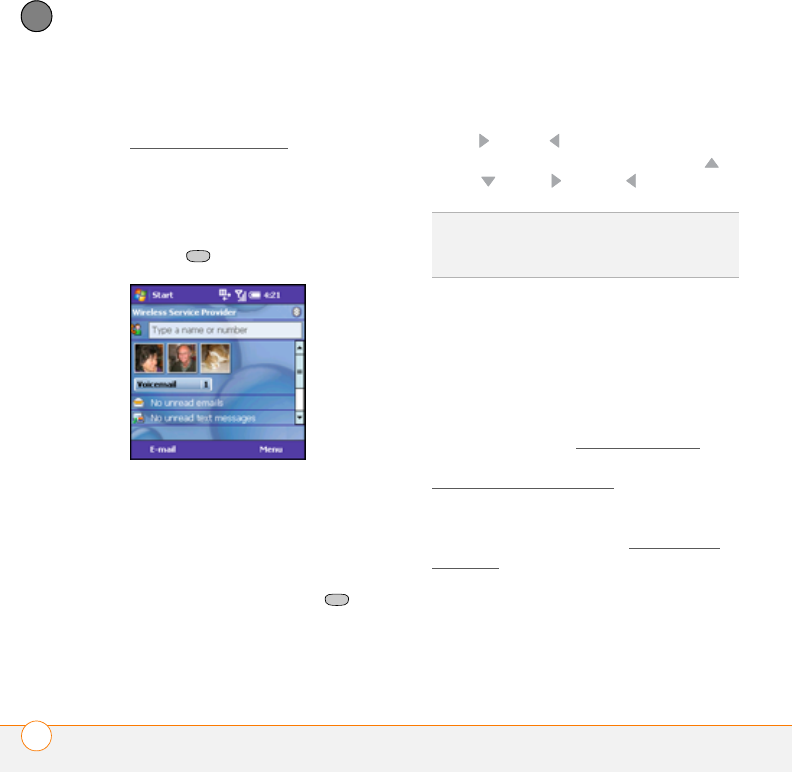
YOUR PHONE
MAKING CALLS FROM THE TODAY SCREEN
38
4
CHAPTER
•Make sure your phone is on and that
you’re inside a coverage area (see
Turning your phone on).
You can make a call using your speed-dial
buttons by doing any of the following:
•Highlight a speed-dial button with the
5-way navigator, and then press
Center .
•Tap a speed-dial button with the stylus.
•Press and hold the Quick Key that you
assigned to the speed-dial button.
•To dial an alternate number for a
contact, highlight the speed-dial button
and press and hold Center or tap
and hold the button, and then select a
number from the shortcut menu.
To see more speed-dial buttons, highlight
the picture speed-dial area and press
Right or Left repeatedly, or highlight
the text speed-dial area and press Up ,
Down , Right , or Left .
Dialing by contact name
You can look up contacts quickly by
entering just a few letters of a contact’s
name directly from your Today screen.
BEFORE YOU BEGIN Before you can dial a
number by contact name, you must create
some contacts (see Adding a contact,) or
import them by synchronizing (see
Synchronizing information).
Make sure your phone is on and that you’re
inside a coverage area (see Turning your
phone on).
1Go to your Today screen.
2Using the keyboard, begin entering one
of the following for the contact you
want to call:
TIP
You can hide your speed-dial buttons on
your Today Screen and still use your Quick
Keys to call a speed-dial number.
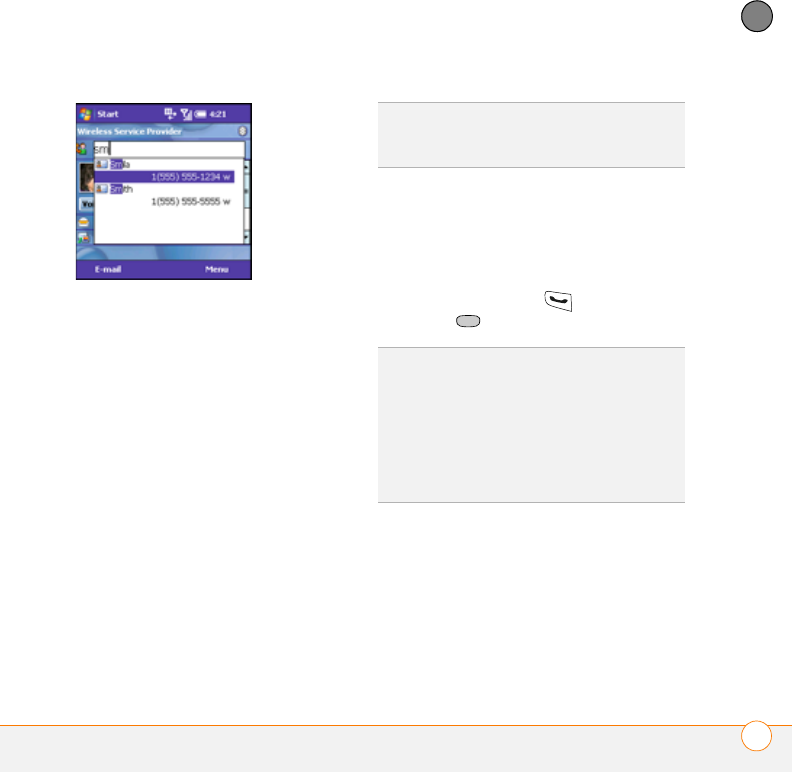
YOUR PHONE
MAKING CALLS FROM THE TODAY SCREEN 39
4
CHAPTER
•First name (JOH for John)
•Last name (SMI for Smith)
•First initial, a space, and then last
initial (J S for John Smith)
•A few letters of the first name, a
space, and then a few letters of the
last name (JOH SMI for John Smith)
For example, entering SM finds both
Smilla Anderson and John Smith.
Entering SM AN finds only Smilla
Anderson.
To clear the Dial Lookup field and start
another Contacts search, press OK. To
delete letters when correcting a
misspelled name, press Backspace.
3Several options for contacting the
person are displayed, depending on
what information you have entered for
the contact. Highlight the phone
number you want to dial for the contact.
4Press Phone/Send or press
Center to dial.
Dialing using the onscreen Dial Pad
The onscreen Dial Pad is useful when you
need to dial numbers that are expressed as
letters and when you need large numbers
that you can tap with your finger or the
stylus.
TIP
To see a contact’s address, company, and
other details, press Up on the 5-way to
highlight the name, and then press Center.
DID
YOU
KNOW
?
After you look up a contact, you
can select how you want to communicate
with that person. When a contact’s name or
phone number is highlighted on the search
results list, press and hold Center on the
5-way or tap and hold with the stylus, and
then select the communication method you
want to use.
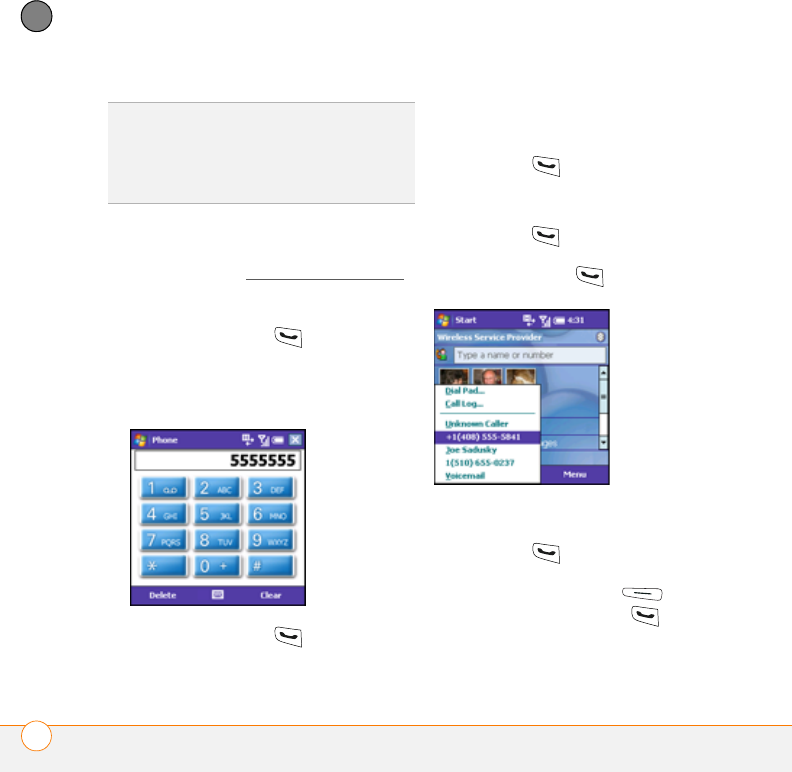
YOUR PHONE
MAKING CALLS FROM THE TODAY SCREEN
40
4
CHAPTER
BEFORE YOU BEGIN Make sure your
phone is on and that you’re inside a
coverage area (see Turning your phone on).
1Go to your Today screen.
2Press Phone/Send and select
Dial Pad.
3Use the keyboard keys or tap the
onscreen Dial Pad to enter the number.
4Press Phone/Send to dial.
Redialing a recently called number
To dial the last number you called: Go to
your Today screen, and then press and hold
Phone/Send .
To select from your most recently dialed
numbers: Go to your Today screen, press
Phone/Send , highlight the number or
contact name you want to call, and then
press Phone/Send to dial.
To select from a chronological list of
calls: Go to your Today screen, press
Phone/Send , and then select Call
Log. Highlight the number you want to call,
and then press either Call (left
action key) or Phone/Send to dial.
DID
YOU
KNOW
?
You can paste numbers directly
into the Dial Pad. Copy a number from another
application, switch to Dial Pad, and then press
and hold Center on the 5-way to paste the
number.
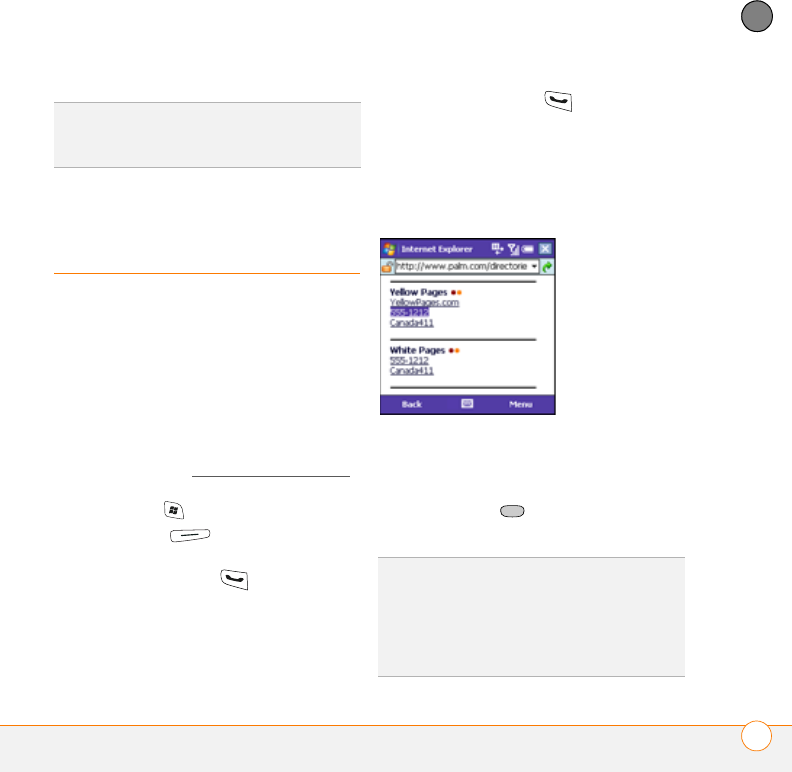
YOUR PHONE
OTHER WAYS OF MAKING CALLS 41
4
CHAPTER
Other ways of
making calls
Your smartphone offers several ways to
make phone calls other than from the
Today screen. Try them all and you’ll
discover which methods you prefer.
Dialing by company name
BEFORE YOU BEGIN Make sure your
phone is on and that you’re inside a
coverage area (see Turning your phone on).
1Press Start and select Contacts.
2Press Menu (right action key)
and select View By > Company.
3Press Phone/Send to go to your
Today screen.
4Using the keyboard, begin entering the
first few letters of the company name.
5Select the number you want to dial.
6Press Phone/Send to dial.
Dialing from a web page or message
Your smartphone recognizes most phone
numbers that appear in web pages or in
messages (text, email, or multimedia).
1Use the 5-way to highlight the phone
number you want to dial in the web
page or message.
2Press Center to open the Phone
dialog box, and then select Ye s to dial.
TIP
You can also access the Call Log and Dial
Pad from the Today screen by pressing Menu
(right action key).
TIP
If you can’t dial a phone number directly
from a web page or a message, highlight the
number, select Edit (right action key), and
then select Copy. Open the Dial Pad, and then
press and hold Center on the 5-way to paste.
Press Phone/Send to dial.
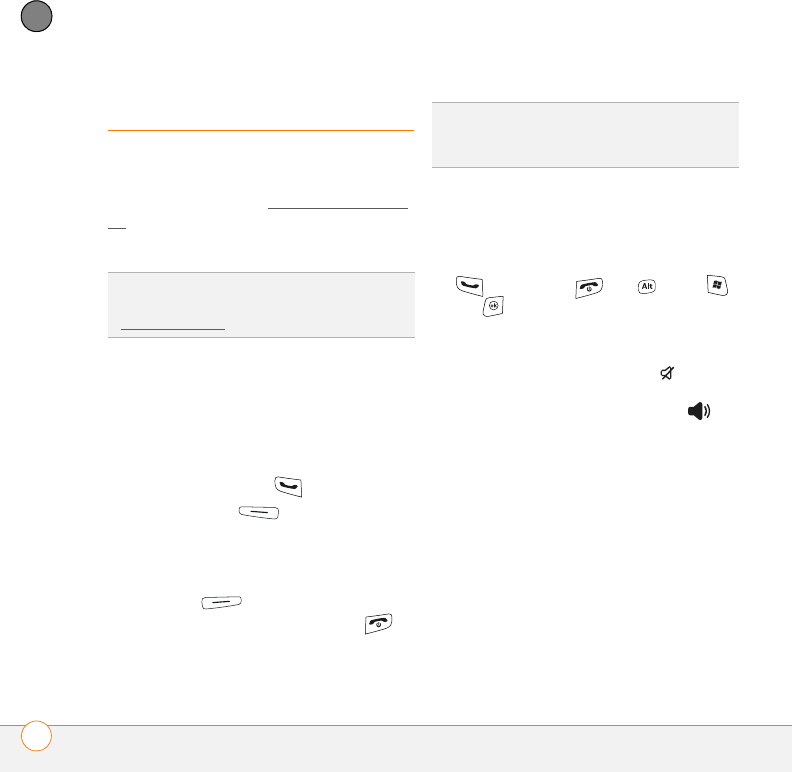
YOUR PHONE
RECEIVING CALLS
42
4
CHAPTER
Receiving calls
To answer calls, your phone must be on.
This is different from having only the
screen turned on (see Turning your phone
on). When your phone is off, your calls go
to voicemail.
If music is playing when a call arrives, the
smartphone rings softly. You can answer
the phone as you normally would. The
audio pauses during your call.
To answer a call, do one of the following:
•Press Phone/Send .
•Press Answer (left action key).
•If the headset is attached, press the
headset button.
To ignore a call and send it to voicemail,
press Menu (right action key) and
select Ignore, or press Power/End .
To silence the ringer while your
smartphone is ringing:
•Press the Volu me button or any key on
your smartphone except Phone/Send
, Power/End , Alt , Start ,
OK , or the 5-way.
•To immediately silence all system
sounds including the ringer, slide the
Ringer switch to Sound Off . All
sounds remain off until you slide the
Ringer switch back to Sound On .
When you silence the ringer, you can either
answer the call or let it ring through to
voicemail.
TIP
See a picture of the person calling you!
Learn how to assign a caller ID picture in
Adding a contact.
DID
YOU
KNOW
?
You can also ignore a call and send
a text message. Press Menu (right action key)
and select Ignore with text message.
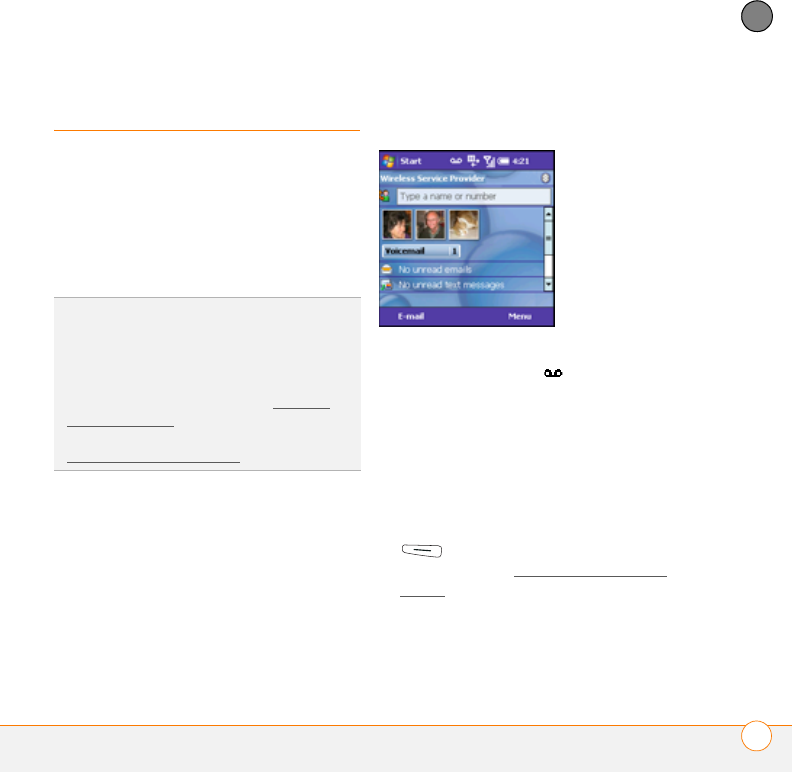
YOUR PHONE
USING VOICEMAIL 43
4
CHAPTER
Using voicemail
Setting up voicemail
1Go to your Today screen.
2Press and hold 1 on the keyboard or tap
the Voicemail speed-dial button to dial
your wireless service provider’s
voicemail system.
3Follow the voice prompts to set up your
voicemail.
Retrieving voicemail messages from the
Today screen
When you have unretrieved voicemail
messages, a Voicemail icon appears at
the top of your screen.
1Go to your Today screen.
2Press and hold 1 on the keyboard to dial
your wireless service provider’s
voicemail system.
3Enter your voicemail password using
the keyboard, or press Extra Digits
(left action key) if you defined
this option (see Creating a speed-dial
button for details).
4Follow the voice prompts to listen to
your messages.
DID
YOU
KNOW
?
For some wireless service
providers, the Voicemail speed-dial button
may not be assigned to a number. If that’s the
case, you can edit the Voicemail speed-dial
button to add the number to your service
provider’s voicemail system (see Editing a
speed-dial button), or you can create a new
speed-dial button with the number (see
Creating a speed-dial button).
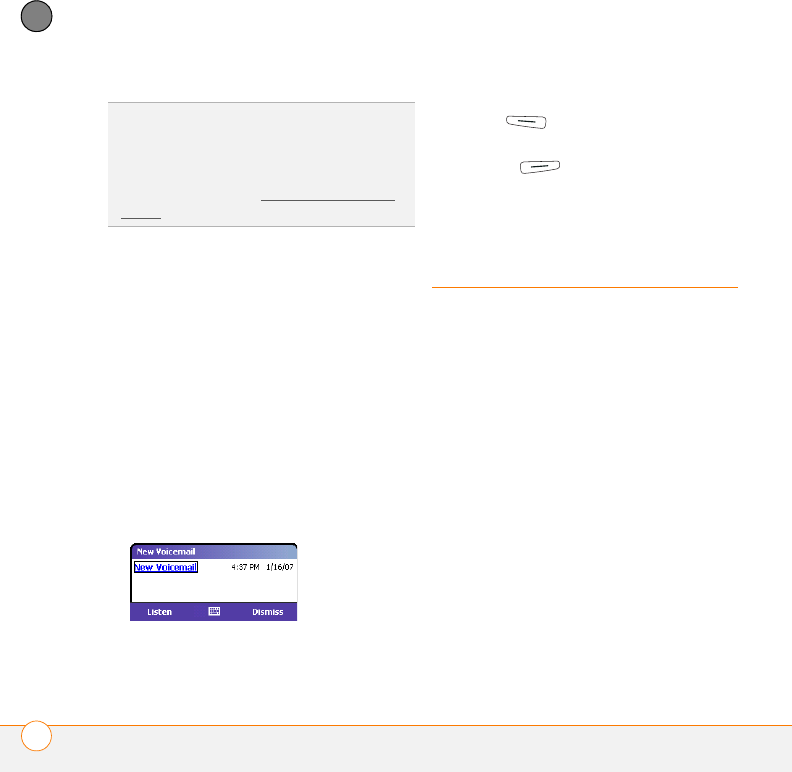
YOUR PHONE
WHAT CAN I DO DURING A CALL?
44
4
CHAPTER
Retrieving messages from a voicemail
notification
NOTE Not all service plans support
voicemail notification. Check with your
wireless service provider for more
information.
You can retrieve voicemail messages when
you receive a notification, or you can
dismiss the notification and retrieve the
messages later.
•When you have a new voicemail
message, a notification screen appears.
•To hear your message now, press
Listen (left action key).
•To retrieve your message later, press
Dismiss (right action key).
What can I do during
a call?
Your smartphone offers many advanced
telephone features, including call waiting,
six-way conferencing, and call forwarding.
These features depend on your service
plan. Please contact your wireless service
provider for more information.
When you make or receive a call, the active
call info appears on your Today screen.
DID
YOU
KNOW
?
When a Voicemail icon appears at
the top of the screen, you can tap this icon to
retrieve your voicemail.
TIP
You can display onscreen voicemail
playback controls; see Creating a speed-dial
button.
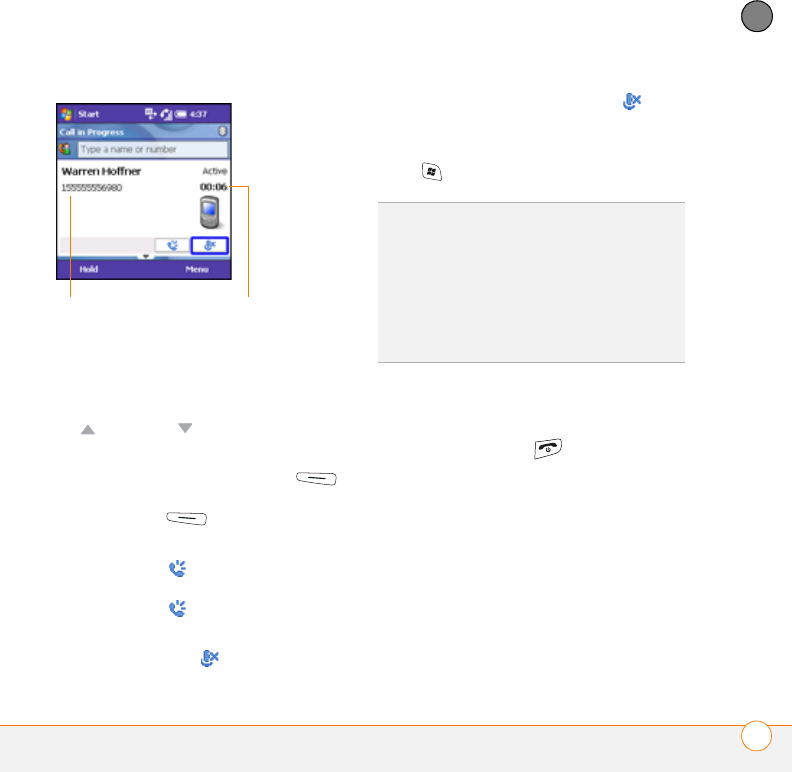
YOUR PHONE
WHAT CAN I DO DURING A CALL? 45
4
CHAPTER
During a call, you can do any of the
following:
Navigate around the Today screen: Use
Up and Down to move around or
highlight items.
Put the call on hold: Press Hold
(left action key). To take the call off hold,
press Off Hold (left action key).
Use the built-in speakerphone: Select
Speakerphone . To turn the
speakerphone off, select
Speakerphone again.
Mute the microphone so you can’t be
heard: Select Mute . To turn the
microphone back on, select Mute
again.
Switch to another application: Press
Start and select the application.
Ending a call
Do one of the following:
•Press Power/End .
•Press the headset button (if the headset
is attached and has a button on it).
Some headsets do not have a button.
Switching applications during an active
call
You can use many other applications on
your smartphone while holding a phone
conversation, including the organizer and
text message features. You cannot,
Current duration
of call
Caller’s name
and number
DID
YOU
KNOW
?
When a call lasts longer than one
minute, the screen dims. After two minutes, it
dims more. Press any key, except Power/End,
to light up the screen.
DID
YOU
KNOW
?
You can send and receive text
messages during a call. This is a great way to
stay connected with colleagues during a long
call.
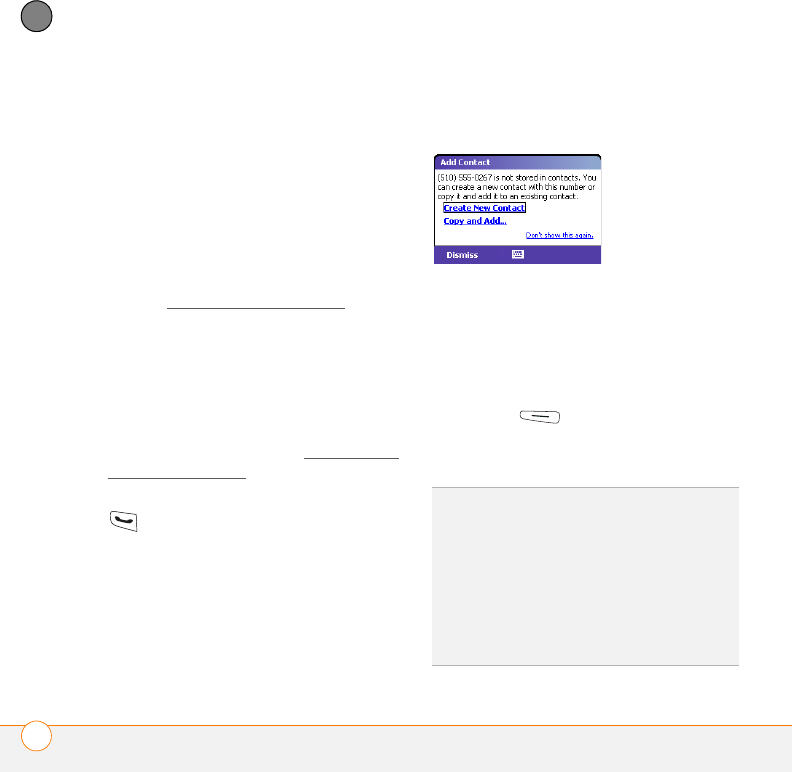
YOUR PHONE
WHAT CAN I DO DURING A CALL?
46
4
CHAPTER
however, make some data connections
during an active call while connected to a
GPRS network. If you’re connected to a
GPRS network, you cannot browse the
web or send and receive email or MMS
messages while on a voice call. If you’re
connected to a CDMA2000 (3G or HSDPA)
network, you can perform simultaneous
voice and data functions. How can you tell
which kind of network you’re connected
to? See What are all those icons?
NOTE Some wireless service providers do
not support simultaneous voice and data
functions over an HSDPA network; check
with your wireless service provider for
information.
To open an application, see Opening and
closing applications.
From any application, press Phone/Send
to return to your Today screen.
Saving phone numbers
After you hang up a call, you can add the
number of the person you were talking
with to Contacts if it's not already in your
list. If an incoming call uses caller ID
blocking, you do not see the Add Contact
prompt.
•To create a new contact for this number,
select Create New Contact.
•To add this number to an existing
contact, select Copy and Add, and
then select a contact name.
•To decline adding the number, press
Dismiss (left action key).
•To disable the Add Contact prompt,
select Don’t show this again.
TIP
If you disable the Add Contact prompt, you
can turn it on again. From your Today screen,
press Menu (right action key) and select
Preferences > Phone Settings. On the
Phone tab, check the After calls from
numbers that are not in Contacts, ask if I
want to add them box.
TIP
You can also save contact info from other
applications, such as Inbox.
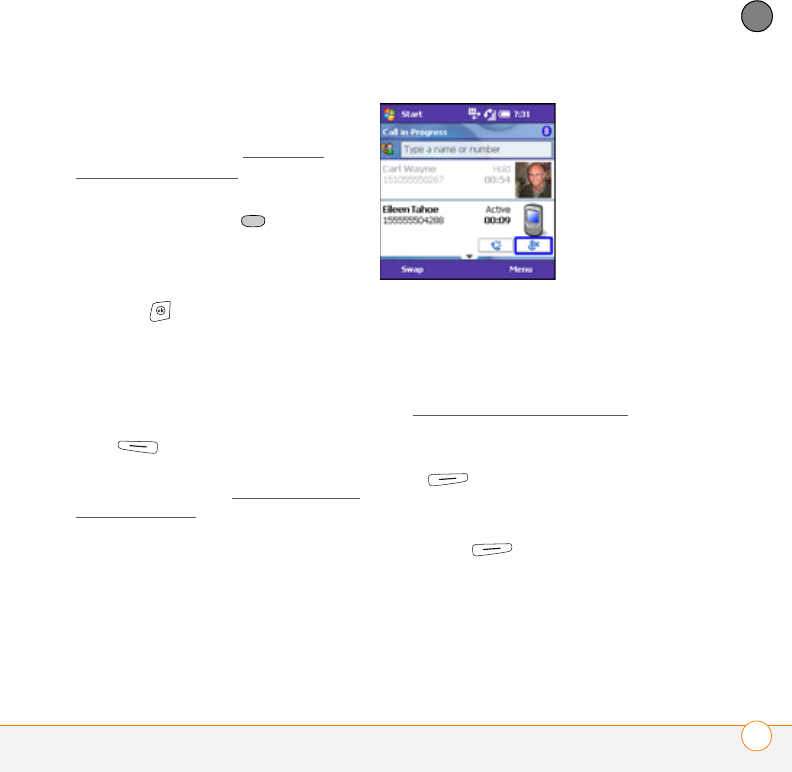
YOUR PHONE
WHAT CAN I DO DURING A CALL? 47
4
CHAPTER
If you don’t add a number right away, follow
these steps to add it later:
1Go to the Call Log (see Redialing a
recently called number).
2Highlight the number you want to save.
3Press and hold Center to open the
shortcut menu, and then select Save to
Contacts.
4Enter the information for the entry.
5Press OK .
Making a second call
You can make a second call while your first
call is still active:
1Place your first call on hold by pressing
Hold (left action key).
2Dial a second number using any of the
methods described in Making calls from
the Today screen. If you’re dialing by
contact name or with the keyboard, you
must first use the 5-way to select the
Dial Lookup field.
When two calls are active, your Today
screen includes two call status sections,
each representing one of the calls.
Answering a second call (call waiting)
When you’re on a call and you receive a
second call, the call waiting notification
appears if you have chosen to be notified
(see Setting call waiting notification). You
can do any of the following:
Send the new call to voicemail: Press
Menu (right action key) and select
Ignore.
Send the new caller a text message:
Press Menu (right action key) and
select Ignore with text message. The
second call is sent to voicemail. A new text
message opens with the phone number of
the caller entered in the To field.
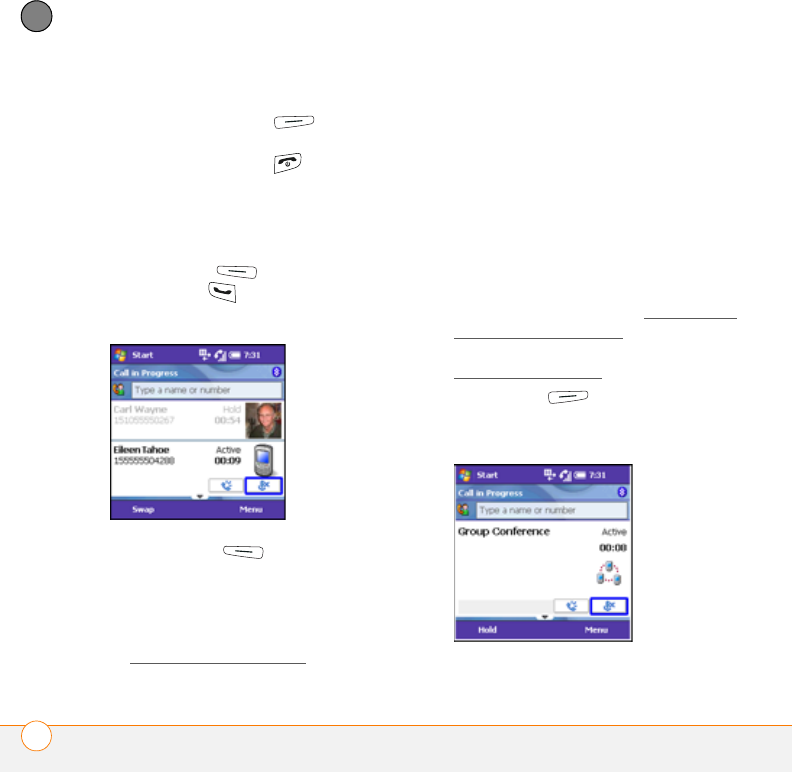
YOUR PHONE
WHAT CAN I DO DURING A CALL?
48
4
CHAPTER
Hang up the current call and answer the
new call: Press Menu (right action
key) and select Drop and Answer. You can
also press Power/End to hang up the
current call, and then choose to answer or
ignore the new call.
Place the current call on hold and
answer the new call:
Press Answer (left action key) or
Phone/Send . After you answer the
call:
•Press Swap (left action key) to
move between callers by placing the
current active call on hold and talking on
the other line.
•Make the calls a conference call. See
Making a conference call.
Making a conference call
IMPORTANT You can join up to 5 calls into
a 6-way conference call. The number of
calls you can join in conference depends on
your service plan. Additional charges may
apply, and minutes in your mobile account
may be deducted for each call. Please
contact your wireless service provider for
more information.
1Answer a second call (see Answering a
second call (call waiting)), or put the first
call on hold and make a second call (see
Making a second call).
2Press Menu (right action key)
and select Conference. This joins the
two calls with you in a conference.
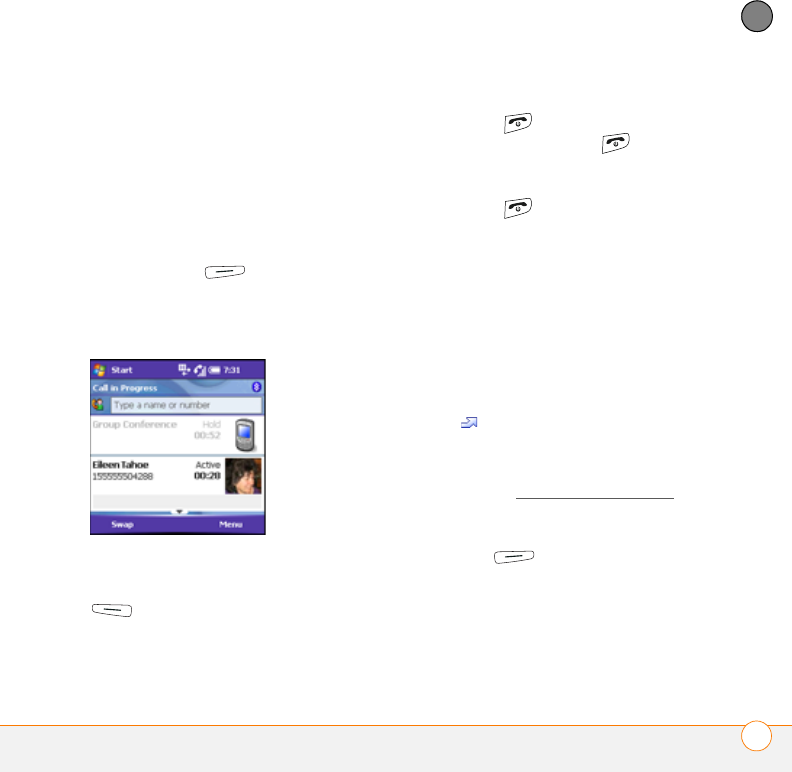
YOUR PHONE
WHAT CAN I DO DURING A CALL? 49
4
CHAPTER
3(Optional) Do one or more of the
following:
•Make more calls and join them into
the conference call. The number of
calls you can join in conference
depends on your service plan.
•Extract a caller from the conference
call to talk with them privately by
pressing Menu (right action
key), selecting Extract, and then
selecting the name. The extracted call
becomes the active call.
•Swap between the conference call
and the private call by pressing Swap
(left action key).
4When you’re done, do one of the
following:
•If you have extracted a call, press
Power/End twice to hang up all
calls or press Power/End once
to hang up the active call.
•If you have not extracted a call, press
Power/End once to hang up all
calls.
Forwarding calls
You can forward calls to another phone
number. Please check with your wireless
service provider about availability and
pricing of forwarded calls; additional
charges may apply.
When all calls are forwarded, the call
forwarding icon appears in the title bar.
BEFORE YOU BEGIN Make sure your
phone is on and that you’re inside a
coverage area (see Turning your phone on).
1Go to your Today screen.
2Press Menu (right action key)
and select Preferences > Phone
Settings.
3Select the Services tab, and then select
Call Forwarding from the list.
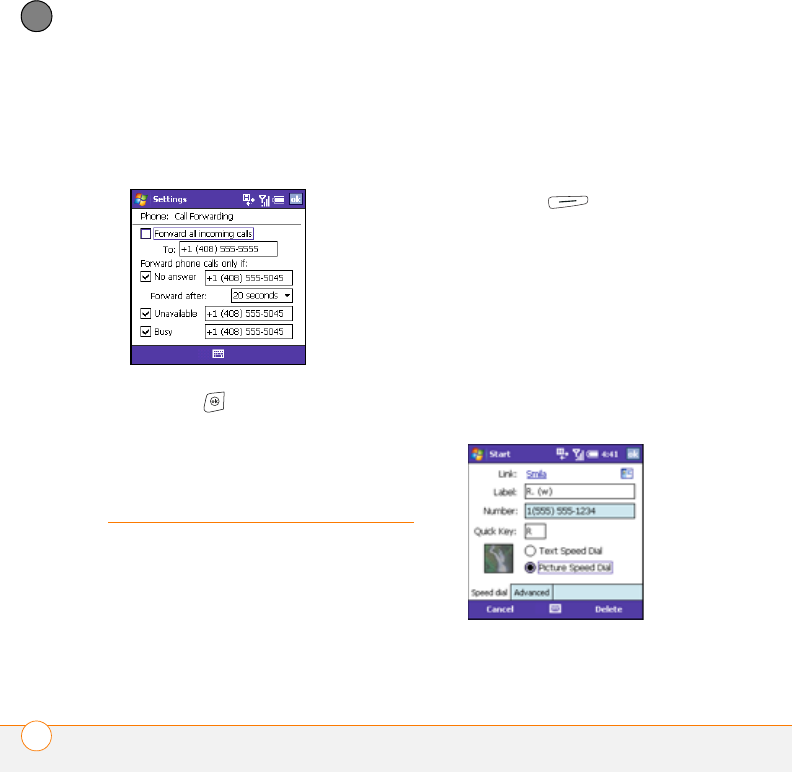
YOUR PHONE
DEFINING SPEED-DIAL BUTTONS
50
4
CHAPTER
4Specify your call forwarding settings.
Some of the settings may already be set
by your wireless service provider to
send your calls to voicemail.
5Press OK .
Defining speed-dial
buttons
Your smartphone enables you to create
both picture and text speed-dial buttons so
that you can select a button on the Today
screen to quickly dial a number.
Creating a speed-dial button
You can create up to 20 picture buttons and
50 text buttons.
1Go to your Today screen.
2Press Menu (right action key)
and select New Speed Dial.
3Do one of the following:
•Select Link to contact, select the
contact you want to link to this button,
and then select the number you want
to dial with this button.
•Select Label and enter a name for this
button, and then select Number and
enter the phone number you want to
dial with this button.
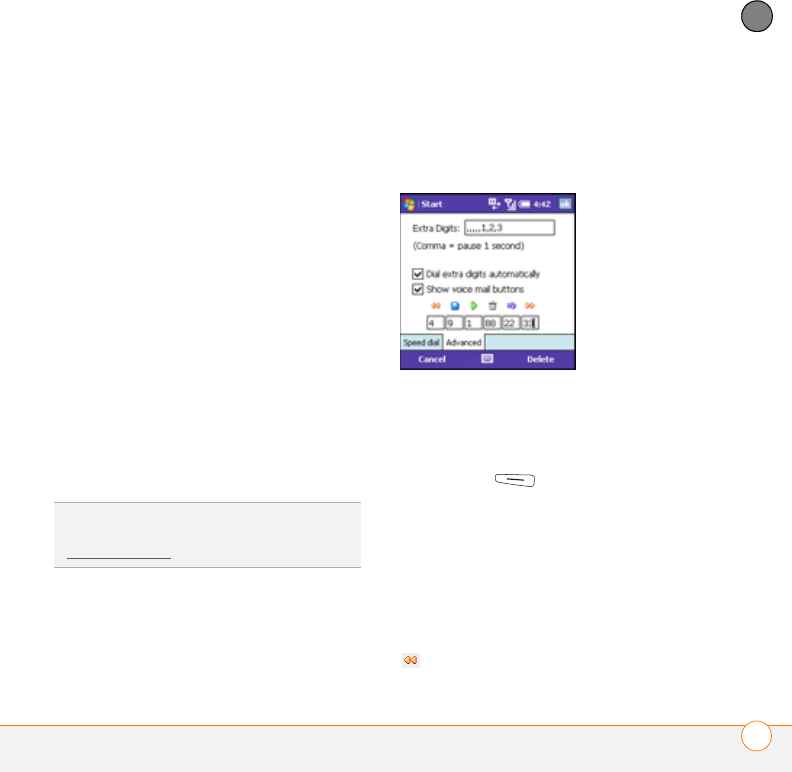
YOUR PHONE
DEFINING SPEED-DIAL BUTTONS 51
4
CHAPTER
4(Optional) Enter a Quick Key. When the
Today screen is showing, you can press
and hold the Quick Key to instantly dial
this number.
Quick Keys can be letters or numbers,
but you can’t use both the letter and
number on the same key. For example,
the voicemail Quick Key is 1. The letter
equivalent for that key is E, so you
cannot assign E as a Quick Key to
another speed-dial button.
5If this button is linked to a contact entry
with a picture, select either Text Speed
Dial or Picture Speed Dial to indicate
which type of button you want to
create. If this button is not linked to a
contact or the contact doesn’t have a
picture, the Picture Speed Dial option is
not available.
6(Optional) Select the Advanced tab and
set any of the following options:
Extra Digits: Defines additional
numbers to dial, such as a password or
extension. In addition to numbers, you
can enter the following symbols: star
(*) and pound (#). To enter a one-
second pause, enter a comma (,).
Dial extra digits automatically: Dials
predefined Extra Digits immediately
after dialing the phone number. If you
do not check this box, you must press
Extra Digits (left action key) to
dial these digits.
Show voice mail buttons: Displays the
voicemail playback controls after you
dial this speed-dial number. When this
option is checked, you can enter
numbers below each control to tailor
the controls to your voicemail system.
Plays the previous message.
TIP
You can add a special ringtone to a contact
associated with the speed-dial button. See
Adding a contact.
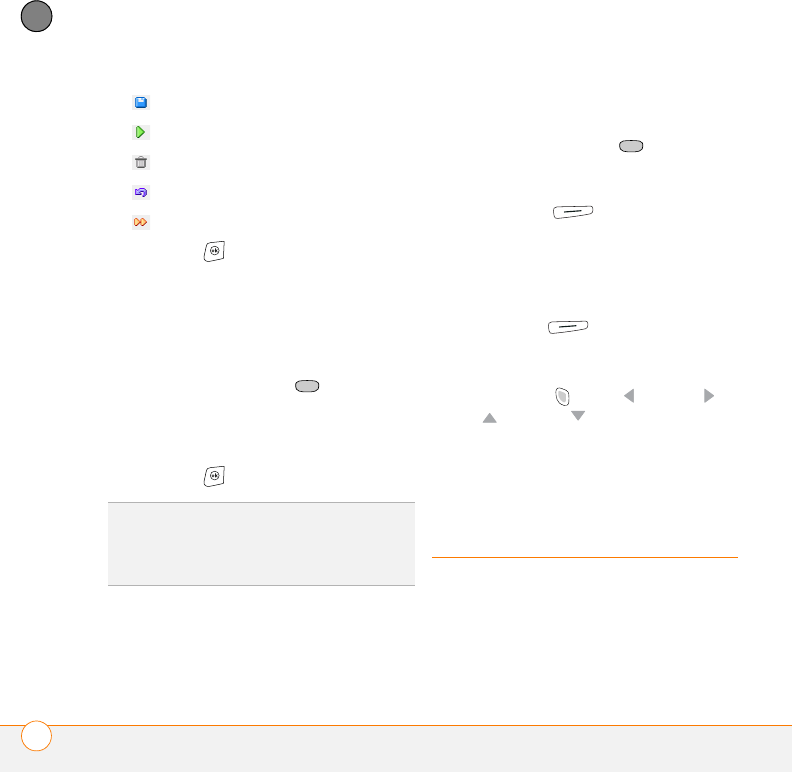
YOUR PHONE
USING A PHONE HEADSET
52
4
CHAPTER
Saves the current message.
Plays the current message.
Deletes the current message.
Repeats the current message.
Plays the next message.
7Press OK .
Editing a speed-dial button
1Go to your Today screen.
2Highlight the speed-dial button you
want to edit.
3Press and hold Center to open the
shortcut menu, and then select Edit
Speed Dial.
4Make the desired changes.
5Press OK .
Deleting a speed-dial button
1Go to your Today screen.
2Highlight the speed-dial button you
want to delete.
3Press and hold Center to open the
shortcut menu, and then select Edit
Speed Dial.
4Press Delete (right action key).
5Select Ye s to confirm the deletion.
Arranging your speed-dial buttons
1Go to your Today screen.
2Press Menu (right action key)
and select Speed Dial Options.
3Highlight the button you want to move.
4Press Option + Left or Right or
Up or Down to move the button
in that direction.
Using a phone
headset
You can connect a phone headset for
hands-free operation. You can use either
the headset that came with your
smartphone or a compatible third-party
headset.
TIP
You can also edit a speed-dial button by
pressing Menu, selecting Speed Dial
Options, and then selecting the button you
want to edit.
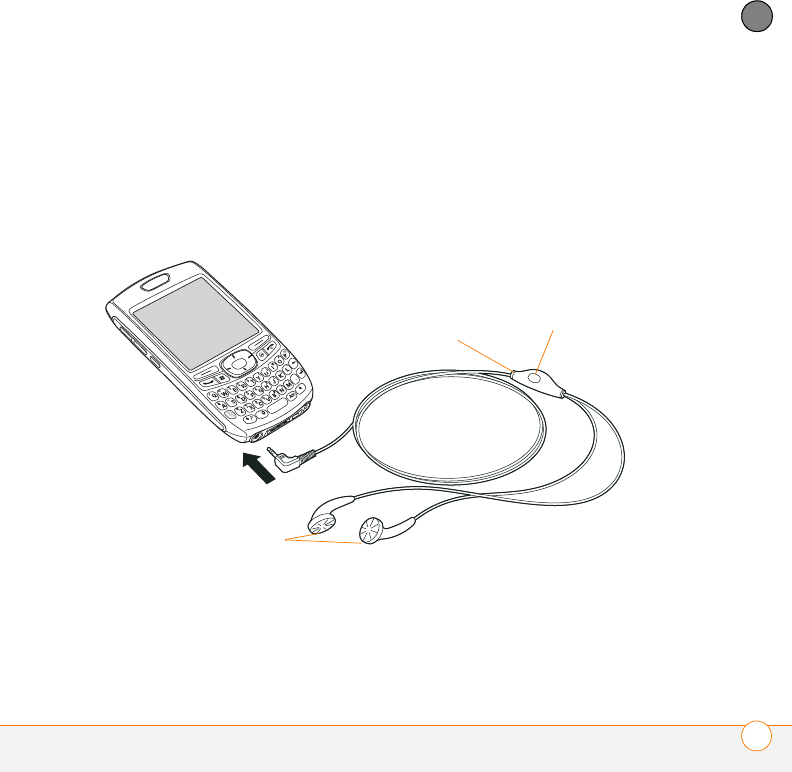
YOUR PHONE
USING A PHONE HEADSET 53
4
CHAPTER
IMPORTANT If driving while using a
smartphone is permitted where you are
and you need to make a call, we
recommend using a phone headset or a
hands-free car kit (sold separately). If you
must use the wired headset while driving,
place a speaker in only one ear. Leave the
other ear free to hear outside noises. Make
such a call only if it is legal to do so and you
can do so safely.
Using a wired headset
The headset button is context-sensitive,
and it performs various actions based on
the situation. You can press the headset
button to perform any of the following
tasks:
•Answer an incoming call
•Respond to call waiting
•Hang up a single active call or all calls on
a conference call if there is no extracted
call
Microphone
Speakers
Headset button
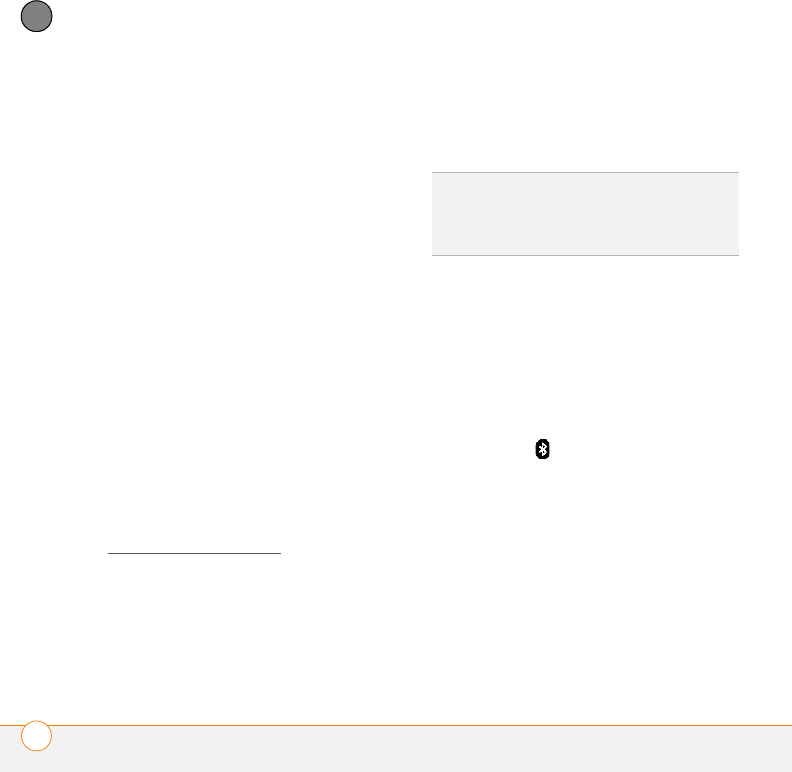
YOUR PHONE
USING A PHONE HEADSET
54
4
CHAPTER
•Swap between calls if there is one
active call and one call on hold
NOTE Your smartphone works with
headsets that have a 2.5mm, 3-pin
connector (look for two colored bands on
the plug). When in doubt, ask the
third-party headset manufacturer if the
product is compatible with your
smartphone. If you hear a headset buzz or
poor microphone performance, your
headset may be incompatible with your
smartphone.
Connecting to a Bluetooth® hands-free
device
Your smartphone is also compatible with
many headsets and car kits (sold
separately) enabled with Bluetooth®
wireless technology version 1.1 or 1.2.
For a list of compatible hands-free devices
with Bluetooth wireless technology, go to
www.palm.com/treo800W-support.
After you set up a connection with a
Bluetooth headset or hands-free car kit,
you can communicate with that device
whenever it is within range and the
Bluetooth feature on your smartphone is
turned on. The range varies greatly,
depending on environmental factors. The
maximum is about 9 meters (30 feet).
1If necessary, prepare the device with
which you want to connect to accept a
new connection. Check the device’s
documentation for details. Be sure to
find out if the device has a predefined
passkey that you need to enter on your
smartphone in step 7.
2Go to your Today screen and tap
Bluetooth .
3Select the Mode tab and check the Tu r n
on Bluetooth box.
DID
YOU
KNOW
?
If you have both a compatible
Bluetooth headset and a car kit, the one you
connected to your smartphone last becomes
the active device.
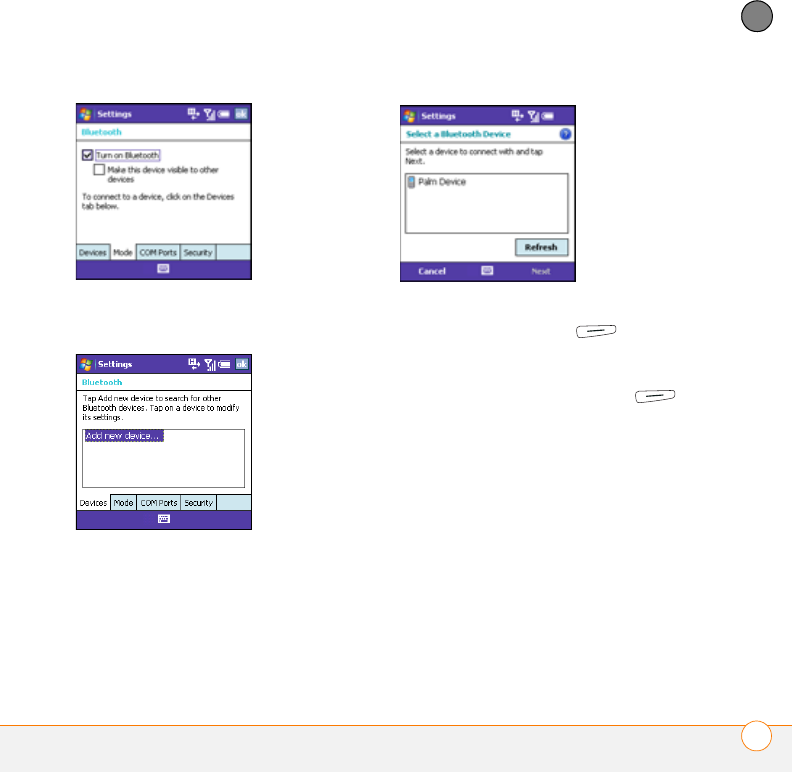
YOUR PHONE
USING A PHONE HEADSET 55
4
CHAPTER
4Select the Devices tab, and then select
Add new device.
5Wait for your smartphone to search for
devices and to display the device list.
6Select the device you want to connect
to, and then press Next (right
action key).
7Enter a passkey between 1 and 16
digits long, and then press Next
(right action key).
IMPORTANT Some hands-free devices
have a predefined passkey. If your
hands-free device has a predefined
passkey, you can find it in the
documentation for that device. Other
devices provide a screen where you enter
a passkey that you make up. In either case,
you must use the same passkey on both
your smartphone and your hands-free
device. We recommend that you use a
passkey of 16 digits, where possible, to
improve the security of your smartphone.
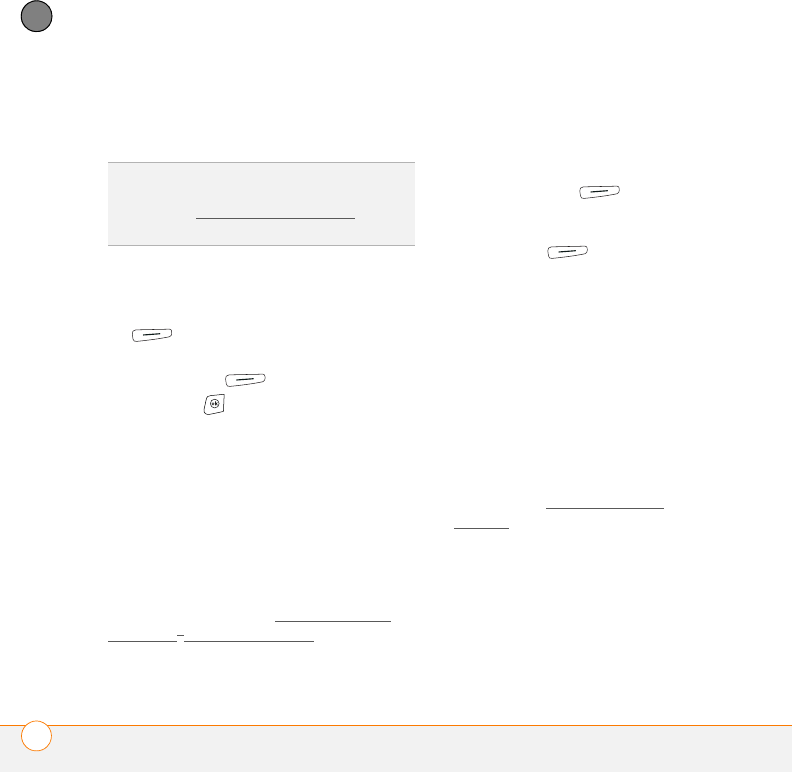
YOUR PHONE
USING A PHONE HEADSET
56
4
CHAPTER
The longer the passkey, the more difficult
it is for the passkey to be deciphered.
8If the passkey is not predefined, enter
the same passkey on the other
Bluetooth device, and then press Finish
(right action key).
9Check the Hands Free box, and then
press Finish (right action key).
10 Press OK .
You can now communicate with this device
whenever it is within range and the
Bluetooth feature on your smartphone is
turned on. The range varies greatly,
depending on environmental factors. The
maximum is about 9 meters (30 feet).
Using a Bluetooth hands-free device
To learn how to set up and connect to
Bluetooth devices, see Connecting to a
Bluetooth® hands-free device.
Here are tips for working with a Bluetooth
hands-free device:
•To transfer a call from the handset to a
Bluetooth hands-free device during a
call, press Menu (right action
key) and select Connect Bluetooth. To
transfer the call back to the headset,
press Menu (right action key)
and select Cancel Bluetooth.
•To transfer a call from a wired headset
to a Bluetooth headset or car kit that is
within range and with which you’ve
previously set up a partnership
(Bluetooth headset or car kit required,
sold separately), unplug the wired
headset and press the button on the
Bluetooth headset or car kit.
•To find out how to transfer your
contacts from your smartphone to your
car kit, go to www.palm.com/
treo800W-support.
DID
YOU
KNOW
?
The Bluetooth icon on your Today
screen indicates the status of the Bluetooth
feature See The Bluetooth status icon for
details.
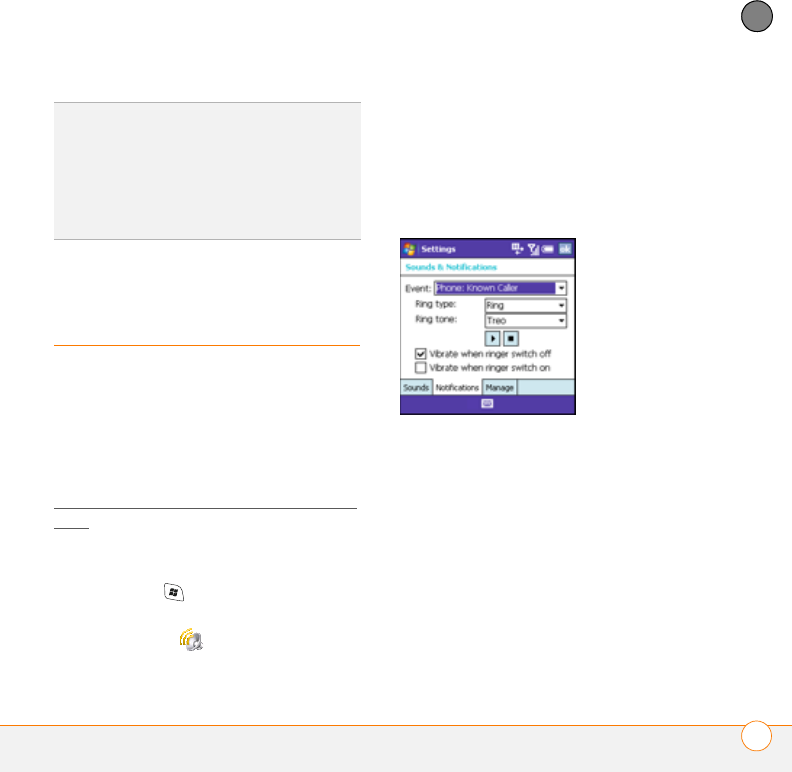
YOUR PHONE
CUSTOMIZING PHONE SETTINGS 57
4
CHAPTER
Customizing phone
settings
Selecting ringtones and display notices
You can set different tones for different
types of incoming phone calls and
notifications. You can download MP3,
MIDI, AMR, WAV, and WMA ringtones
directly to your smartphone (see
Downloading files and images from a web
page). You can also download ringtones to
your computer and then email them to your
phone.
1Press Start and select Settings.
2On the Personal tab, select Sounds &
Notifications .
3Select the Notifications tab.
4Select the Event list, and then select
the type of call or notification for which
you want to set the ringtone:
Phone: Known Caller: An incoming call
from someone in your Contacts list or
Speed Dial list.
Phone: Missed call: A call you did not
answer.
DID
YOU
KNOW
?
If you’re using a Bluetooth
hands-free device and it is within range, your
smartphone routes all calls to the hands-free
device instead of to the earpiece on your
smartphone. Bluetooth range is up to 9
meters (30 feet) in optimum environmental
conditions.
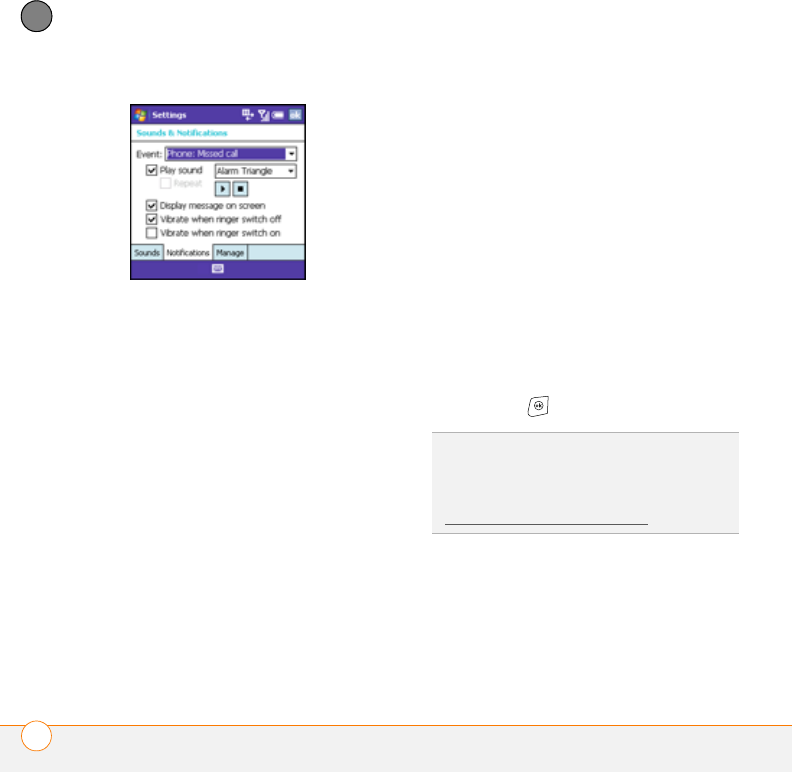
YOUR PHONE
CUSTOMIZING PHONE SETTINGS
58
4
CHAPTER
Phone: Roaming: A call that comes in
when you’re outside your home mobile
network.
Phone: Unknown Caller: An incoming
call from someone identified by caller
ID who is not in your Contacts list or
Speed Dial list.
Phone: Voice mail: A new voicemail.
5If you selected Known Caller, Roaming,
or Unknown Caller, select the ring type
and the ringtone. Select the Play icon to
preview the ringtone sound.
6If you selected Missed call or Voice
mail, set the following options:
•Check the Play Sound box if you
want to have a sound played when
the event occurs.
•If you checked the Play Sound box,
then select the sound for the selected
type of call. You can also check the
Repeat box to have the sound repeat.
•(Optional) Select the Play icon to
preview the sound.
•Check the Display message on
screen box to have a message
displayed when the event occurs.
7Check the Vibrate when… boxes to
turn the vibrate feature on/off based on
the Ringer switch setting.
8Repeat steps 4–7 to select ringtones for
other types of calls.
9Press OK .
DID
YOU
KNOW
?
You can record, preview, delete,
and send sounds on your smartphone. You
can also set sounds for messaging
notifications and calendar reminders. See
Selecting Sounds & Notifications.
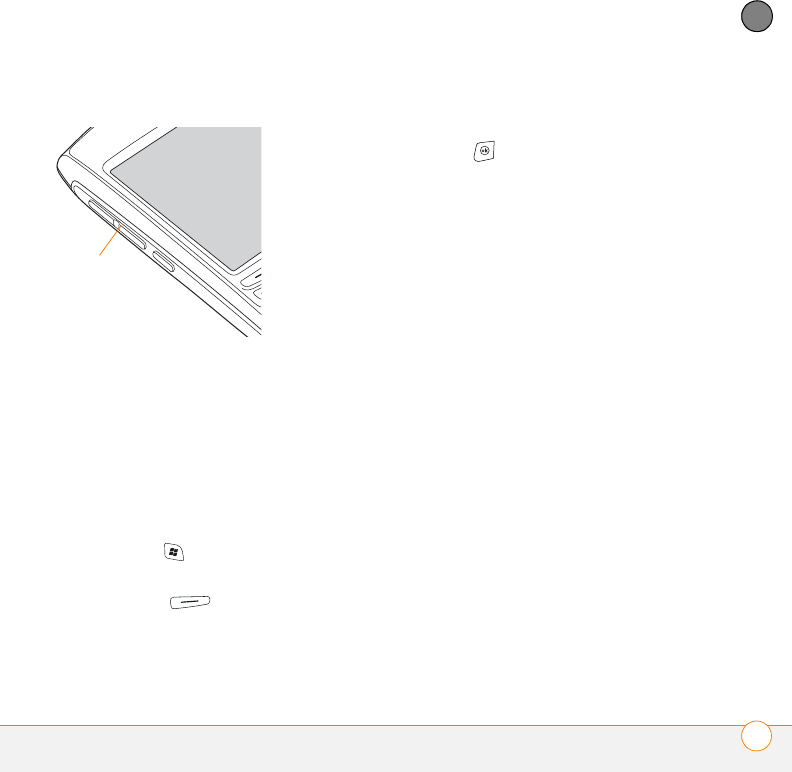
YOUR PHONE
CUSTOMIZING PHONE SETTINGS 59
4
CHAPTER
Adjusting call and ringer volume
•Call volume: While a call is in progress,
press Volum e (on the side of your
smartphone) to adjust the call volume.
•Ringer volume: When a call is not in
progress and you are not playing music
or a video, press Volume to adjust
ringer volume.
Assigning a caller ID ringtone
1Press Start and select Contacts.
2Highlight the contact’s name.
3Press Menu (right action key)
and select Edit.
4Select Ring tone.
5Select a tone for this contact entry.
6Press OK .
Enabling TTY
You can enable your smartphone for use
with a TTY/TDD device. A TTY (also known
as a TDD or Text Telephone) is a
telecommunications device that enables
people who are deaf or hard of hearing, or
who have speech or language disabilities,
to communicate by telephone.
Your smartphone is compatible with select
TTY devices. You can connect a TTY/TDD
machine, headset, or hands-free kit to your
smartphone through the headset jack while
in TTY/TDD mode. Please check with the
manufacturer of your TTY device for
connectivity information. Be sure that the
TTY device supports digital wireless
transmission.
NOTE Not all wireless service providers
support the TTY feature on your
smartphone. Check with your wireless
service provider for information.
Volume
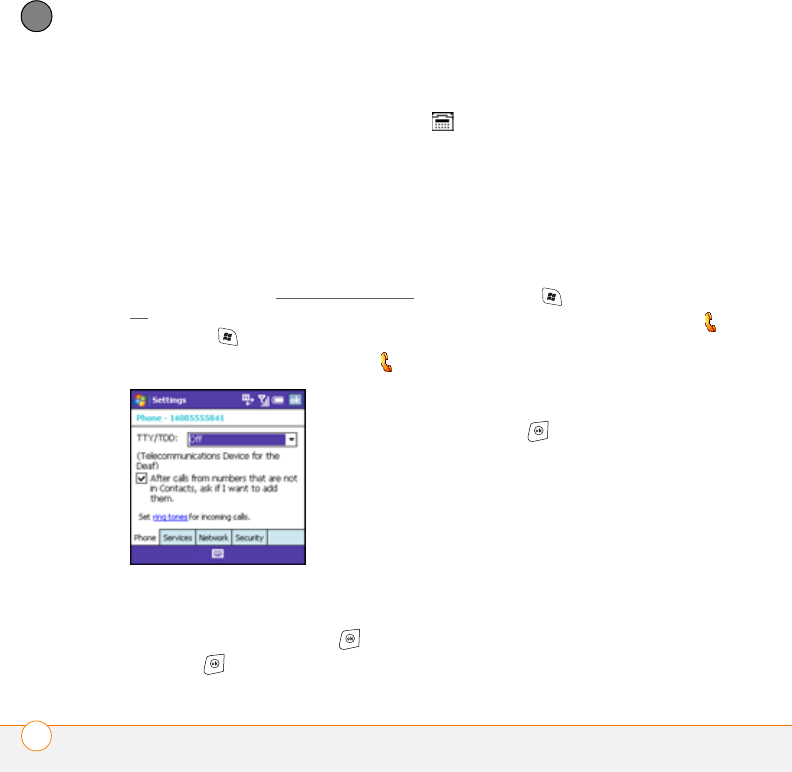
YOUR PHONE
CUSTOMIZING PHONE SETTINGS
60
4
CHAPTER
BEFORE YOU BEGIN
•Make sure your smartphone is
connected to a TTY/TDD machine using
the headset jack. When you enable TTY,
all audio modes are disabled on your
smartphone, including holding the
smartphone up to your ear and
listening.
•Turn on your phone to access your
Phone Settings. See Turning your phone
on.
1Press Start and select Settings.
2On the Personal tab, select Phone .
3On the Phone tab, select the TTY/TDD
list and then select either On or Off.
4If an alert appears, press OK .
5Press OK .
NOTE When TTY/TDD is on, a TTY/TDD
icon appears at the top of the Today
screen.
Adding contact numbers from new callers
By default, you are prompted to add
contact entries for numbers that are not
already in your Contacts list. You can turn
this feature on or off.
1Press Start and select Settings.
2On the Personal tab, select Phone .
3On the Phone tab, check the After calls
from numbers that are not in
Contacts, ask if I want to add them
box.
4Press OK .
Blocking calls
You can block (bar) incoming or outgoing
calls.
BEFORE YOU BEGIN You need to do the
following:
•Make sure that call barring is supported
by your service plan. Check with your
wireless service provider for more
information.
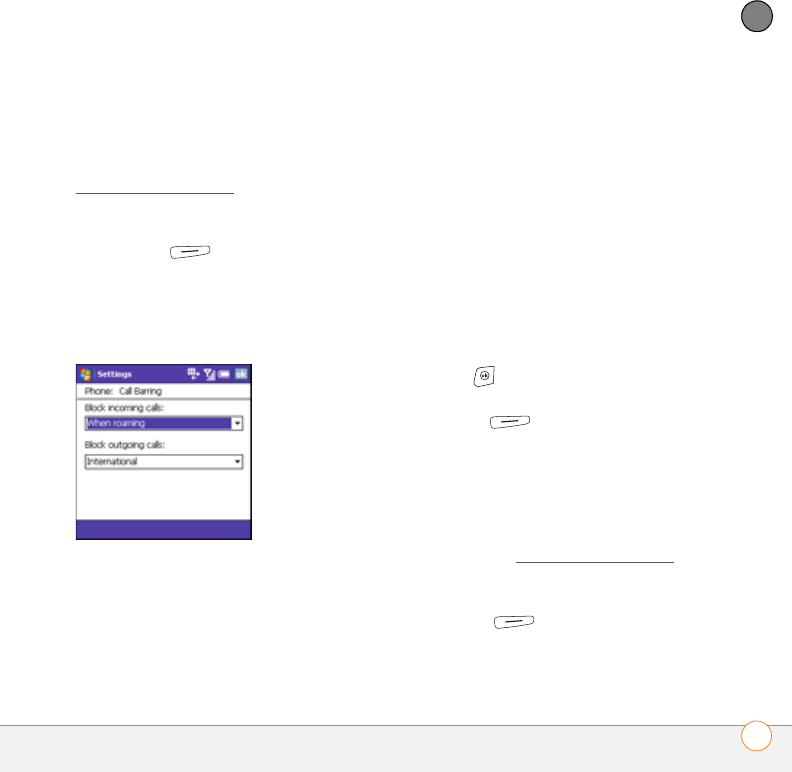
YOUR PHONE
CUSTOMIZING PHONE SETTINGS 61
4
CHAPTER
•Get a call barring password from your
wireless service provider.
•Make sure your phone is on and that
you’re inside a coverage area (see
Turning your phone on).
1Go to your Today screen.
2Press Menu (right action key)
and select Preferences > Phone
Settings.
3Select the Services tab, and then select
Call Barring from the list.
4Select the Block incoming calls list,
and then select one of the options:
Off: No incoming calls are blocked.
When roaming: All incoming calls are
blocked when roaming.
All calls: All incoming calls are blocked.
5Select the Block outgoing calls list and
then select one of the options:
Off: No outgoing calls are blocked.
International: All outgoing international
calls are blocked.
International except to home
country: All outgoing international calls
are blocked except to the country
where the phone is based.
All calls: All outgoing calls are blocked.
6Press OK .
7Enter the call barring password and
press Done (right action key).
Setting caller ID
You can turn caller ID on or off.
BEFORE YOU BEGIN Make sure your
phone is on and that you’re inside a
coverage area (see Turning your phone on).
1Go to your Today screen.
2Press Menu (right action key)
and select Preferences > Phone
Settings.
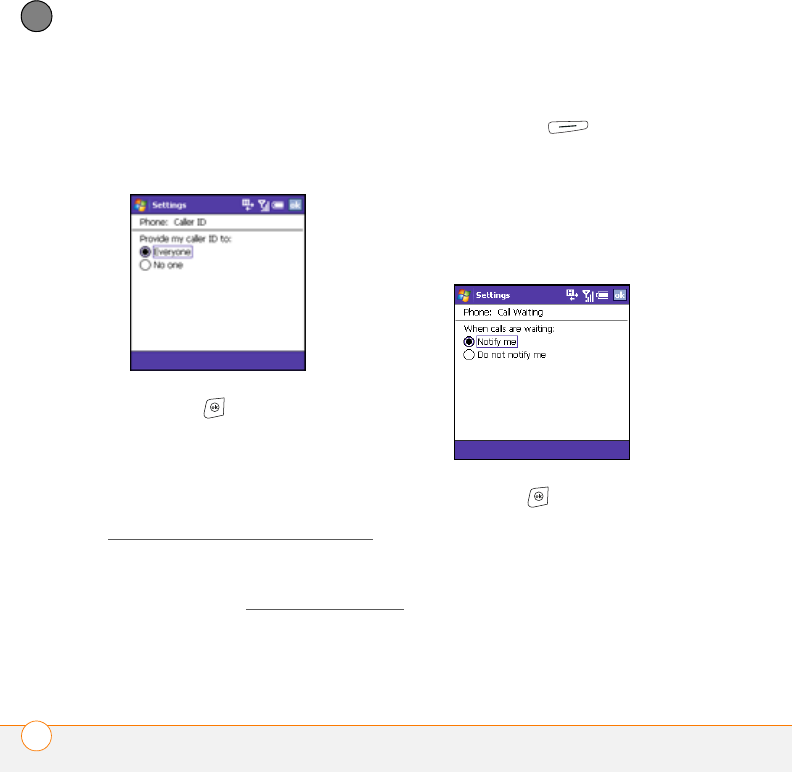
YOUR PHONE
CUSTOMIZING PHONE SETTINGS
62
4
CHAPTER
3Select the Services tab, and then select
Caller ID from the list.
4Select the appropriate option to provide
your caller ID to Everyone or No one.
5Press OK .
Setting call waiting notification
You can choose to be notified when you
receive a call while you are on a call. You
can choose to accept the call or not. See
Answering a second call (call waiting).
BEFORE YOU BEGIN Make sure your
phone is on and that you’re inside a
coverage area (see Turning your phone on).
1Go to your Today screen.
2Press Menu (right action key)
and select Preferences > Phone
Settings.
3Select the Services tab, and then select
Call Waiting.
4Select the appropriate option to receive
a notification or not.
5Press OK .
Manually selecting your wireless band
IMPORTANT The wireless band setting is
preset for optimum performance. Do not
change this setting unless instructed to do
so by a representative from your wireless
service provider.
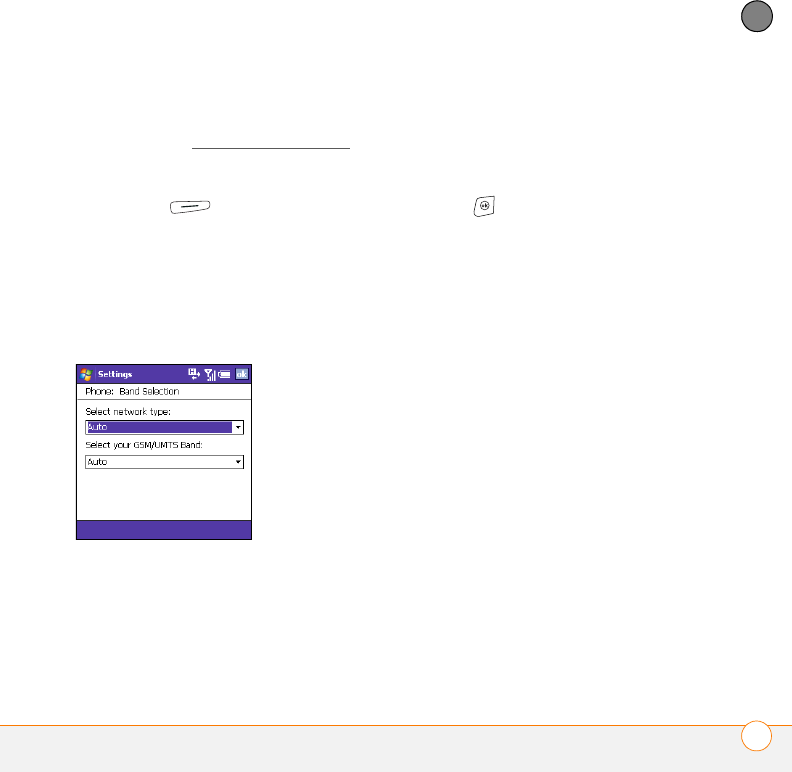
YOUR PHONE
CUSTOMIZING PHONE SETTINGS 63
4
CHAPTER
BEFORE YOU BEGIN Make sure your
phone is on and that you’re inside a
coverage area (see Turning your phone on).
1Go to your Today screen.
2Press Menu (right action key)
and select Preferences > Phone
Settings.
3Select the Services tab, and then select
Band Selection from the list.
4Select the Select network type list,
and then select one of the following:
Auto: Automatically selects a network.
GSM: Connects only to GSM networks.
CDMA2000: Connects only to
CDMA2000 (3G or HSDPA) networks.
5Select the Select your
CDMA2000 Band list, and then select
either Auto or one of the bands listed.
The band options differ depending on
your wireless service provider.
6Press OK .
Enabling fixed dialing
Fixed dialing allows you to restrict your
outgoing calls and messages to selected
phone numbers included in your fixed
dialing list. After the service is activated,
you can call and send messages only to the
phone numbers from the list.
The list is protected by a PIN2 code. If you
enter an incorrect PIN2 more times than
allowed by your wireless service provider,
the SIM card locks. After the SIM card
locks, you need the PUK2 (pin unblocking
key) to unlock the SIM card. Contact your
wireless service provider for more
information and your PIN2 and PUK2.
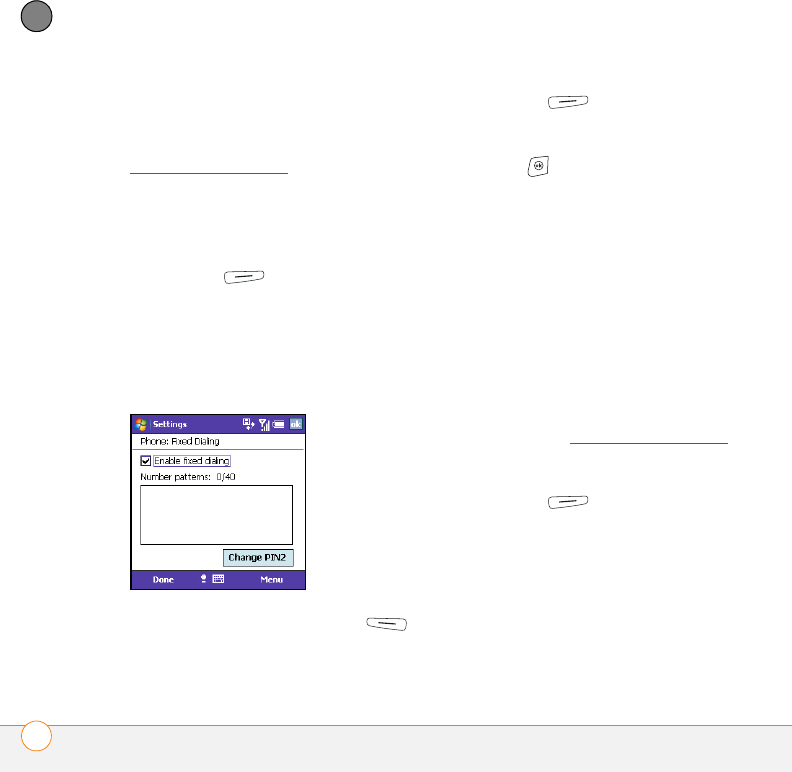
YOUR PHONE
CUSTOMIZING PHONE SETTINGS
64
4
CHAPTER
BEFORE YOU BEGIN
•Make sure your phone is on and that
you’re inside a coverage area (see
Turning your phone on).
•Get your PIN2 from your wireless
service provider
1Go to your Today screen.
2Press Menu (right action key)
and select Preferences > Phone
Settings.
3Select the Services tab, and then select
Fixed Dialing.
4Check the Enable fixed dialing box.
5Enter your PIN2 and press Done
(left action key).
6Press Menu (right action key) to
add, delete, or edit the phone numbers
in the list.
7Press OK .
Manually selecting your network settings
IMPORTANT The network settings are
preset for optimum performance. Do not
change these settings unless instructed to
do so by a representative from your
wireless service provider. The network
settings options vary according to your
wireless service provider.
BEFORE YOU BEGIN Make sure your
phone is on and that you’re inside a
coverage area (see Turning your phone on).
1Go to your Today screen.
2Press Menu (right action key)
and select Preferences > Phone
Settings.
3Select the Network tab.
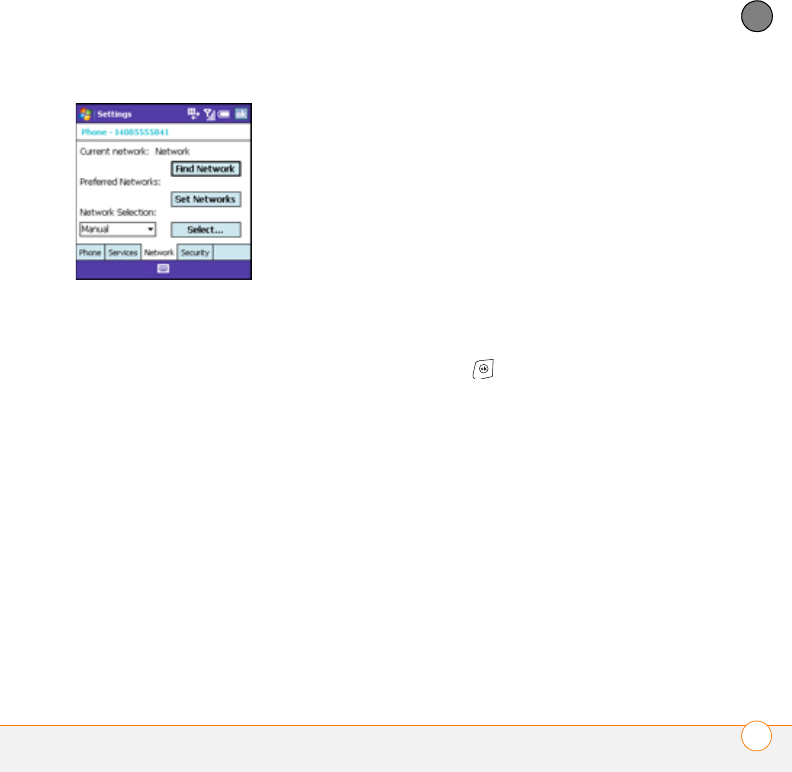
YOUR PHONE
CUSTOMIZING PHONE SETTINGS 65
4
CHAPTER
4To switch to another network, select
Find Network and select an available
network.
5To change your preferred network,
select Set Networks, check the box
next to the networks you want, and
then select your order of preference.
6From the Network Selection list, select
an option:
Automatic: The network connection is
automatically made.
Manual: Network connections are
manually made. If you are manually
selecting a network, select a network
from the list of available networks.
7Press OK .
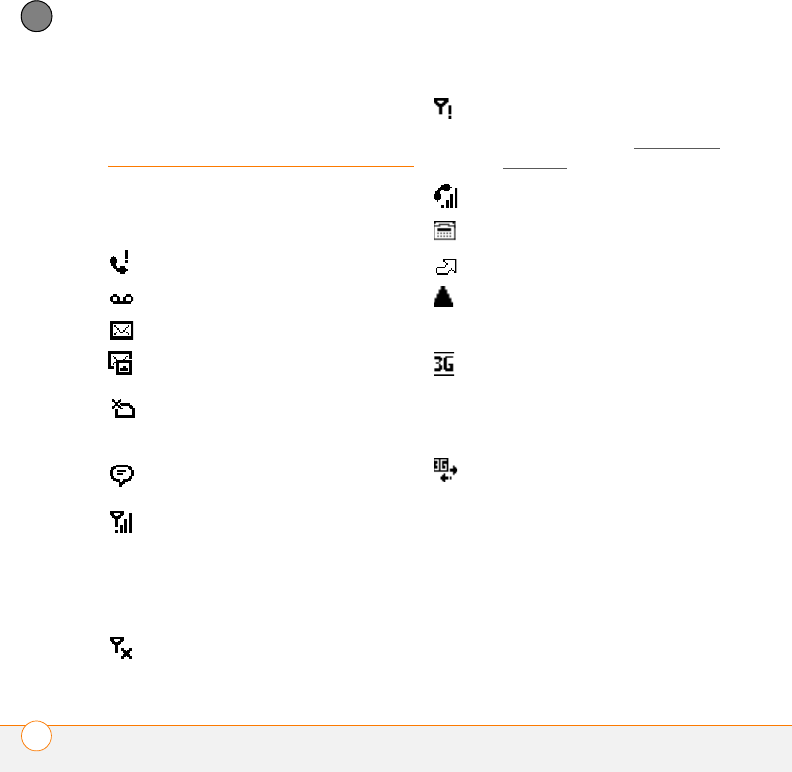
YOUR PHONE
WHAT ARE ALL THOSE ICONS?
66
4
CHAPTER
What are all those
icons?
You can monitor the status of several items
using icons at the top of your Today screen:
You missed an incoming call.
You have a voicemail message.
You have a new email message.
You have a new text or
multimedia message.
No SIM card is inserted or
software is unable to recognize
the SIM.
You have more than one of the
conditions listed above.
Your phone is on. The bars
display the signal strength.
The stronger the signal, the
more bars that appear. If you are
outside a coverage area, no bars
appear.
Your phone is off.
The SIM card is locked. You need
to enter a PIN or a PUK to unlock
the SIM card (see Locking the
SIM card).
A voice call is in progress.
TTY/TDD is turned on.
All calls are being forwarded.
You are in a roaming coverage
area. Additional fees may apply
for calls or data transmission.
Your phone is connected to a
CDMA2000 (3G or HSDPA)
network, but you are not actively
transmitting data. You can still
make or receive calls.
Your phone is on and a 3G
CDMA2000 data connection is
active. You can make and receive
calls and transmit data
simultaneously.

YOUR PHONE
WHAT ARE ALL THOSE ICONS? 67
4
CHAPTER
Your phone is connected to a
HSDPA CDMA2000 network, but
you are not actively transmitting
data. You can still make or
receive calls.
NOTE In most cases, when your
phone is connected to a
CDMA2000 network (either 3G
or HSDPA) but you are not
actively transmitting data, the 3G
icon appears. The H icon may
appear when your phone is
connected to a HSDPA
CDMA2000 network, but you are
not actively transmitting data
Your phone is on and an HSDPA
CDMA2000 data connection is
active. You can make and receive
calls and transmit data
simultaneously.
Your phone is connected to an
EDGE network, but you are not
actively transmitting data. You
can still make or receive calls.
Your phone is on and an EDGE if
data connection is active. You
can still make or receive calls,
but the data transmission is
automatically interrupted.
Your phone is connected to a
GPRS network, but you are not
actively transmitting data. You
can still make or receive calls.
Your phone is on and a GPRS
data connection is active. You
can still make or receive calls,
but the data transmission is
automatically interrupted.
ActiveSync synchronization is in
progress.
Your smartphone is connected to
a computer or network, or
Windows Mobile Device Center
synchronization is in progress.
A data connection is not available
or your phone is off.
Your smartphone’s battery is low.
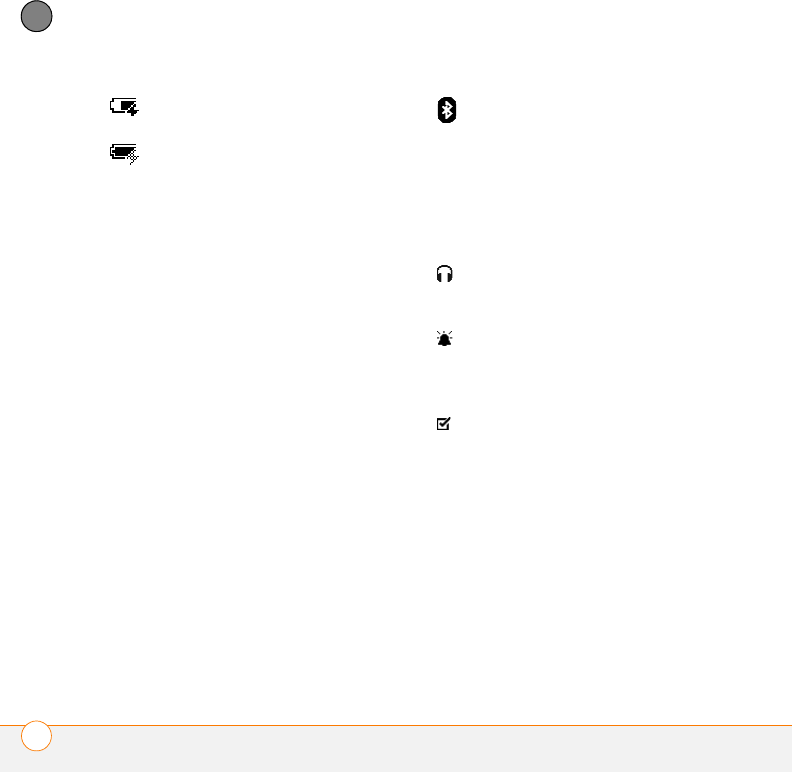
YOUR PHONE
WHAT ARE ALL THOSE ICONS?
68
4
CHAPTER
Your smartphone’s battery is
charging.
Your smartphone is connected to
a power outlet and the battery is
fully charged.
Wireless
service
provider
name
Your phone is on. When you turn
off your phone, Phone Off
appears instead.
The Bluetooth® wireless
technology status indicator
appears in gray when this feature
is off, in blue when this feature is
on, and in reverse blue when
your smartphone
is communicating with another
Bluetooth device.
A call is in progress and your
smartphone is connected to a
Bluetooth headset or car kit.
You have a reminder. If the
reminder is not displayed on your
Today screen, tap the icon to
open the reminder.
You have an alert from Microsoft.
If the alert is not displayed on
your Today screen, tap the icon
to open the alert.

CHAPTER
5
Synchronizing information
Synchronizing means that information that has been entered or
updated in one place—your Palm
®
Treo
™
800
W
smartphone, your
computer, or your corporate server—is automatically updated in
the other. There’s no need to enter information twice. Some
types of synchronization can happen on an automated schedule,
so you don’t even have to think about it.
After you get into the habit of synchronizing regularly, you’ll
know what a powerful tool synchronization is for transferring,
updating, and backing up large amounts of information on your
smartphone.
Benefits
•Quickly enter and update
information on your computer and
your smartphone
•Protect your information
•Send photos and videos to your
smartphone from your desktop
computer

In this chapter
Synchronization overview. . . . . . . . . . . . . . . . . . . . . . . . . . . . . . . . . 71
How do I synchronize?. . . . . . . . . . . . . . . . . . . . . . . . . . . . . . . . . . . 71
What can I synchronize? . . . . . . . . . . . . . . . . . . . . . . . . . . . . . . . . . 72
Setting up your computer for synchronization . . . . . . . . . . . . . . . . . 75
Synchronizing using the sync cable . . . . . . . . . . . . . . . . . . . . . . . . . 80
Setting up wireless synchronization. . . . . . . . . . . . . . . . . . . . . . . . . 81
Other ways to synchronize. . . . . . . . . . . . . . . . . . . . . . . . . . . . . . . . 86
Setting synchronization options . . . . . . . . . . . . . . . . . . . . . . . . . . . . 88

SYNCHRONIZING INFORMATION
SYNCHRONIZATION OVERVIEW 71
5
CHAPTER
Synchronization
overview
This chapter discusses using desktop sync
software and other methods to synchronize
your smartphone and your computer.
When you synchronize, info you enter on
your smartphone, your computer, or your
corporate server is automatically updated
in the other location. There’s no need to
enter the info twice. This is true whether
you sync with your computer using
desktop synchronization software (see
Setting up your computer for
synchronization) or wirelessly with your
company’s Exchange server using
Microsoft Exchange ActiveSync (see
Setting up wireless synchronization).
How do I
synchronize?
There are a number of ways to make
synchronization occur. You can install
desktop sync software on your computer
to synchronize in one of several ways, or
you may be able to synchronize wirelessly
with an Exchange server. You can also
maximize your sync options and sync with
both an Exchange server and desktop sync
software to maximize your sync options.
Synchronizing with desktop sync
software
BEFORE YOU BEGIN Install the software
from the Windows Mobile Getting Started
CD, which came with your smartphone.
You must install this software even if you
have already installed a previous version of
desktop sync software. See Installing
ActiveSync desktop software: Windows XP
or Installing Windows Mobile Device
Center: Windows Vista for instructions.

SYNCHRONIZING INFORMATION
WHAT CAN I SYNCHRONIZE?
72
5
CHAPTER
After you install desktop sync software,
you can synchronize in any of the following
ways:
•By connecting your smartphone to your
computer using the sync cable (see
Synchronizing using the sync cable)
•By connecting your smartphone to your
computer using Bluetooth® wireless
technology (see Synchronizing over a
Bluetooth connection)
•By connecting your smartphone to your
computer using the infrared (IR) ports
(see Synchronizing over an infrared
connection)
If you have a Windows XP computer:
The desktop sync software is called
ActiveSync® desktop software.
If you have a Windows Vista computer:
The desktop sync software is called
Windows Mobile Device Center. The sync
application on your smartphone is called
ActiveSync.
Synchronizing wirelessly with the server
You can set up your smartphone to
synchronize email and other information
wirelessly with Microsoft Exchange Server
2003 or Exchange Server 2007 using
Microsoft Exchange ActiveSync (see
Setting up wireless synchronization). If you
choose this method, synchronization takes
place automatically after setup. You do not
need to install the software from the
Windows Mobile Getting Started CD.
NOTE We recommend that you install the
desktop sync software from the CD even if
you synchronize wirelessly with the server.
You need the desktop sync software to
synchronize pictures, videos, music files,
and other info directly with your computer.
What can I
synchronize?
If you have Microsoft Office Outlook® 2002
or later installed on your computer, by
default, the following information is
synchronized when you synchronize using
either desktop sync software or Microsoft
Exchange ActiveSync:

SYNCHRONIZING INFORMATION
WHAT CAN I SYNCHRONIZE? 73
5
CHAPTER
You can, however, customize sync settings
to suit your needs and sync only some of
these applications.
If you set up synchronization with your
computer using the desktop sync
software, information in the Favorites
application is synchronized by default as
well. You can also change settings to
synchronize Word, Excel, PowerPoint, and
PDF files, as well as pictures, music,
videos, and other types of files (see
Changing which applications sync).
IMPORTANT To synchronize Calendar,
Contacts, Inbox (email), and Tasks, you
must have Outlook 2002 or later installed
on your computer. If you want to
synchronize pictures, music, and videos,
you need to have Windows Media Player
10 or later installed on your computer.
This table lists the types of info you can
synchronize and the methods to use.
DID
YOU
KNOW
?
Synchronizing Favorites gives you
an easy way to get favorites from the web
browser on your computer into the web
browser on your smartphone. Just add them
to the folder called Mobile Favorites, which
shows up in your computer's browser. When
you sync, they become available on your
smartphone as well. Backup copies of any
favorites that you add on the smartphone
browser are also stored in the Mobile
Favorites folder.
TIP
If you don’t already have Outlook or
Windows Media Player installed on your
computer, you can install them from the
Windows Mobile Getting Started CD. Insert
the CD into your computer’s CD drive, select
Add Programs (Windows XP) or Bonus
Software (Windows Vista), and then select
Windows Media Player or the link to
download a trial version of Outlook 2007.
TIP
If you want to synchronize with a personal
information manager (PIM) other than
Microsoft Office Outlook, you must install a
third-party solution. Contact the PIM’s vendor
to learn if software is available for your
smartphone
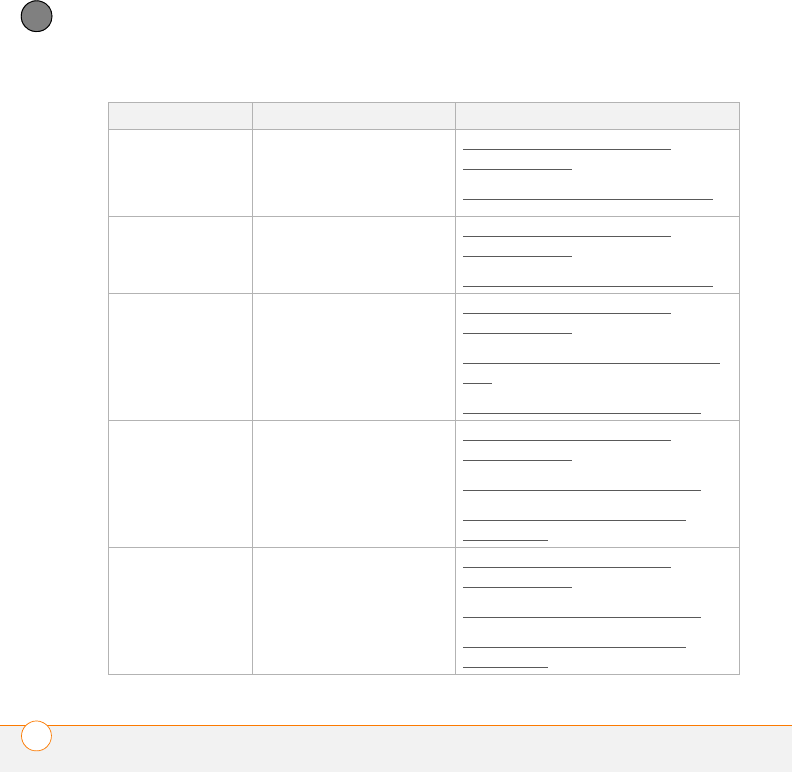
SYNCHRONIZING INFORMATION
WHAT CAN I SYNCHRONIZE?
74
5
CHAPTER
Info type Method Where to learn more
Outlook Contacts,
Calendar, Tasks
Desktop sync software
(sync with computer) or
Exchange ActiveSync
(direct sync with server)
Setting up your computer for
synchronization or
Setting up wireless synchronization
Outlook Email Desktop sync software or
Exchange ActiveSync
Setting up your computer for
synchronization or
Setting up wireless synchronization
Word, Excel,
PowerPoint, PDF
files
Desktop sync software Setting up your computer for
synchronization
Synchronizing your Microsoft Office
files
Changing which applications sync
Music and video
files
Desktop sync software
and Windows Media
Player
Setting up your computer for
synchronization
Changing which applications sync
Transferring media files to your
smartphone
Pictures Windows XP: Desktop
sync software
Windows Vista: Desktop
sync software and
Windows Media Player
Setting up your computer for
synchronization
Changing which applications sync
Transferring media files to your
smartphone (Windows Vista)
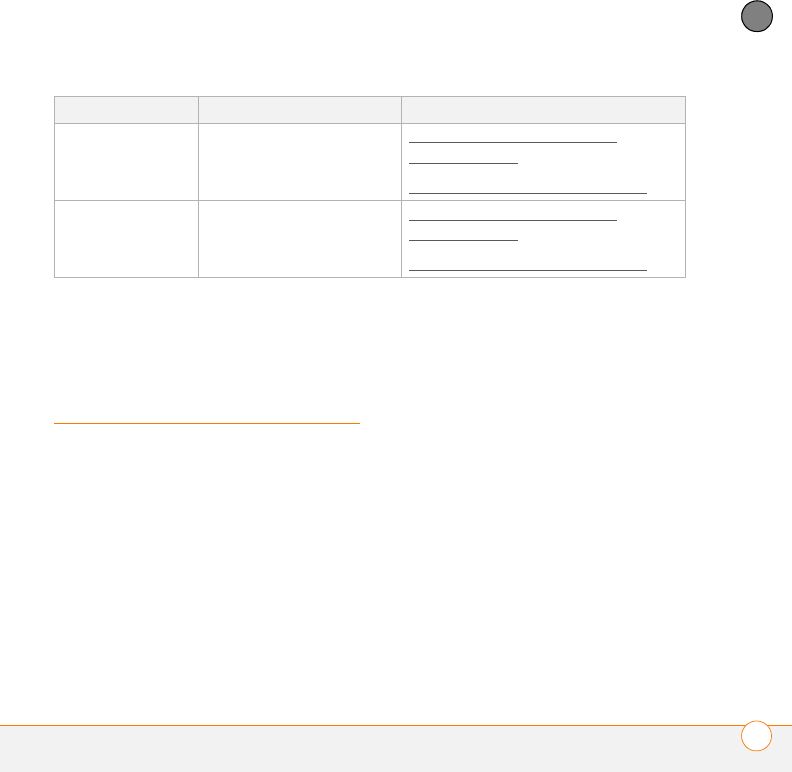
SYNCHRONIZING INFORMATION
SETTING UP YOUR COMPUTER FOR SYNCHRONIZATION 75
5
CHAPTER
Setting up your
computer for
synchronization
Before you can synchronize, you need to
install your desktop sync software and
connect the sync cable to your computer.
Even if you already have desktop sync
software installed on your computer, you
must install the software that came with
your smartphone on the Windows Mobile
Getting Started CD.
System requirements
Your computer must meet the following
minimum system requirements:
•Windows XP Service Pack 2 or
Windows Vista (later versions may also
be supported)
•32MB of available memory (RAM)
•170MB of free hard disk space
•CD drive
•Available USB port
•USB sync cable (included with your
smartphone)
•Adobe Flash Player (required to run the
installation program)
Outlook Notes Desktop sync software Setting up your computer for
synchronization
Changing which applications sync
Files to be
transferred to an
expansion card
Desktop sync software Setting up your computer for
synchronization
Changing which applications sync
Info type Method Where to learn more

SYNCHRONIZING INFORMATION
SETTING UP YOUR COMPUTER FOR SYNCHRONIZATION
76
5
CHAPTER
Installing ActiveSync desktop software:
Windows XP
If you have a Windows XP computer, the
desktop sync software is called ActiveSync
desktop software. The Windows Mobile
Getting Started CD recognizes that you
have a Windows XP computer and
automatically directs you to install
ActiveSync desktop software. On your
smartphone, the sync application is called
ActiveSync.
BEFORE YOU BEGIN If you are installing
the software on a computer at work, make
sure your company allows you to install
new software. Contact your company’s
IT department for help.
1Close any applications that are currently
running on your computer, including
those running in the background. Your
computer must have all its resources
available to install the software.
2Insert the Windows Mobile Getting
Started CD into the CD drive on your
computer.
3Follow the installation instructions that
appear on both your computer and your
smartphone.
During installation, you connect your
smartphone to your computer and sync
for the first time. Be sure to watch
what’s happening on both your
computer and your smartphone. For
more info, see Connecting your
smartphone to your computer and
Synchronization.
TIP
If you do not have Adobe Flash Player on
your computer, you can download it for free
from www.adobe.com.
TIP
During software installation, you can select
an option to synchronize email, contacts,
calendar events, and tasks directly with
Microsoft Exchange Server 2003 or 2007. If
you choose this option, you are prompted to
enter your mail server address and domain
name and your Exchange server account
username and password.
DID
YOU
KNOW
?
You can also install additional
software from the Windows Mobile Getting
Started CD (see Installing bonus software
from the CD).

SYNCHRONIZING INFORMATION
SETTING UP YOUR COMPUTER FOR SYNCHRONIZATION 77
5
CHAPTER
Installing Windows Mobile Device Center:
Windows Vista
If you have a Windows Vista computer, the
desktop sync software is called Windows
Mobile Device Center. The Windows
Mobile Getting Started CD recognizes that
you have a Windows Vista computer and
automatically directs you to install
Windows Mobile Device Center. On your
smartphone, the sync application is called
ActiveSync.
BEFORE YOU BEGIN If you are installing
the software on a computer at work, make
sure your company allows you to install
new software—for example, that you have
Administrator privileges. Contact your
company’s IT department for help.
1Close any applications that are currently
running on your computer, including
those running in the background. Your
computer must have all its resources
available to install the software.
2Insert the Windows Mobile Getting
Started CD into the CD drive on your
computer.
3If prompted, click RunStart.exe.
4Click Continue.
5Select your language and click Next.
6Select Setup and Installation.
7Make sure the Windows Mobile
Device Center box is checked, and click
Install.
8Follow the installation instructions that
appear on both your computer and your
smartphone.
During installation, you connect your
smartphone to your computer and sync
for the first time. Be sure to watch
what’s happening on both your
computer and your smartphone. For
more info, see Connecting your
smartphone to your computer and
Synchronization.
Using the desktop sync software
After you install the desktop sync software,
synchronization happens automatically
anytime you connect your smartphone to
your computer, as described in the next
section. You can also open the desktop
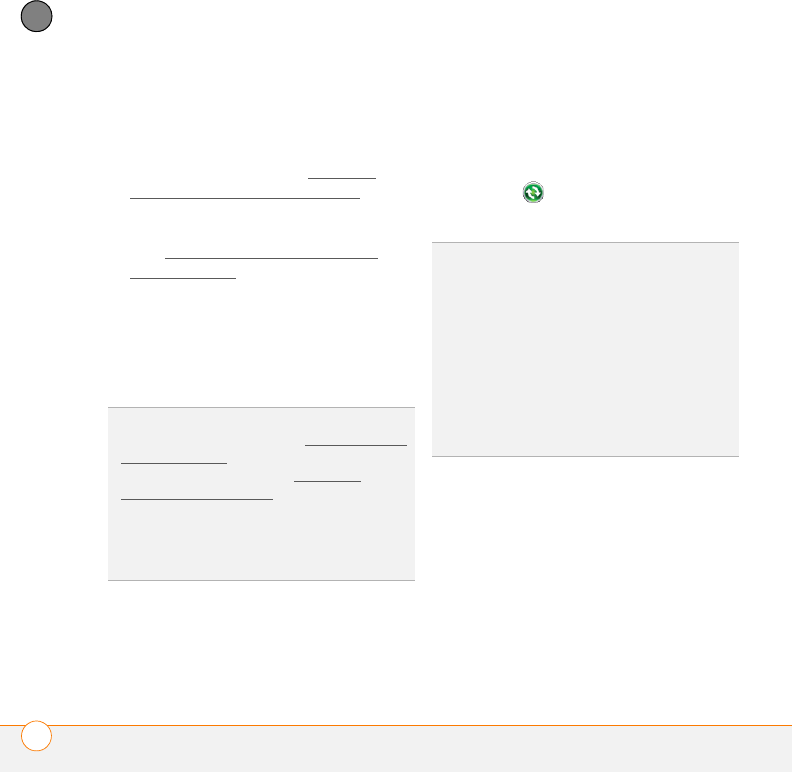
SYNCHRONIZING INFORMATION
SETTING UP YOUR COMPUTER FOR SYNCHRONIZATION
78
5
CHAPTER
sync software window on your computer
to perform the following tasks:
•Install applications from your computer
to your smartphone (see Installing
applications from your computer) or to
an expansion card inserted into the
expansion card slot on your smartphone
(see Installing applications onto an
expansion card)
•Change which applications synchronize
•In ActiveSync desktop software on a
Windows XP computer, enter settings
to synchronize wirelessly with Microsoft
Exchange Server 2003 or 2007
To open the desktop sync software, do one
of the following:
Windows XP: To open the ActiveSync
desktop software window, double-click the
ActiveSync icon in the taskbar in the
lower-right corner of your computer screen.
Windows Vista: To open Windows Mobile
Device Center, click Start > All Programs
> Windows Mobile Device Center.
Desktop software installation also creates
a folder for your smartphone on your
computer. When your smartphone is
connected to your computer, opening My
Computer or Windows Explorer (Windows
XP) or Computer (Windows Vista) displays
DID
YOU
KNOW
?
You can also change which
applications synchronize (see Changing which
applications sync) and enter settings to
synchronize wirelessly (see Setting up
wireless synchronization) in the ActiveSync
app on your smartphone. Whether you enter
changes on your smartphone or on your
computer, the changes are transferred to the
other location the next time you synchronize.
TIP
If the ActiveSync icon does not appear in
the taskbar, go to Start, navigate to
Programs, and then select Microsoft
ActiveSync to open the ActiveSync window.
TIP
You can enter a setting to have the
ActiveSync window open automatically when
you connect your computer and your
smartphone. In the ActiveSync window, select
File > Connection Settings, and then check
the Open ActiveSync when my device
connects box.

SYNCHRONIZING INFORMATION
SETTING UP YOUR COMPUTER FOR SYNCHRONIZATION 79
5
CHAPTER
an icon representing your smartphone.
Double-clicking this icon displays folders
containing items you synchronized, such as
music files, pictures, and videos.
Connecting your smartphone to your
computer
NOTE If you’re transferring info from a
previous Windows Mobile® device or from
a Palm OS® device, you can learn more
about how to move content, such as
pictures, music, and files, to your
smartphone by going to www.palm.com/
treo800W-support.
1If international adapters are included in
your smartphone package, prepare the
AC charger by connecting the adapter
that fits the wall outlet you’re going to
use.
2Plug the AC charger into a wall outlet.
3Plug the USB sync cable into an
available USB port or into a powered
USB hub on your computer.
4Connect the sync cable to your
smartphone by inserting it into the two
sockets to the left on the bottom of the
smartphone.
5Connect the charger cable to the
remaining socket on the bottom of your
smartphone.
TIP
For best performance, plug your sync cable
directly into a USB port on your computer. If
your computer has USB ports on both the
front and back, we suggest using the back
port. If you use a USB hub, make sure it’s a
powered hub.
DID
YOU
KNOW
?
The AC charger contains an
indicator light that glows when the charger is
connected to a power source.
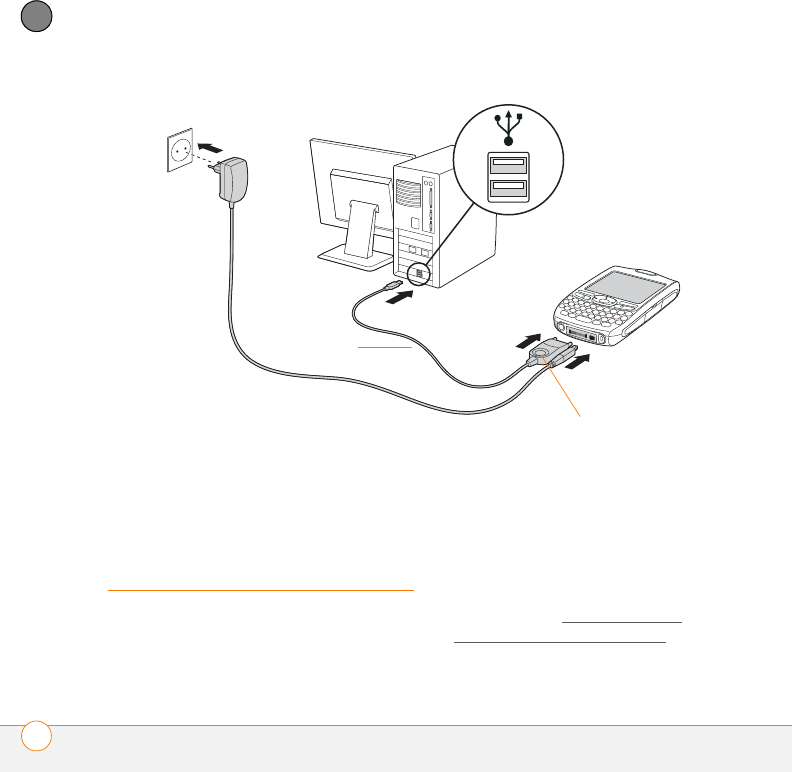
SYNCHRONIZING INFORMATION
SYNCHRONIZING USING THE SYNC CABLE
80
5
CHAPTER
Synchronizing using
the sync cable
Every time you connect your smartphone
to your computer, the desktop sync
software automatically turns on and checks
whether changes you made on the
computer or on the smartphone need to be
synchronized.
1Connect your smartphone to your
computer (see Connecting your
smartphone to your computer).
USB sync
cable
This button has no
function with your
smartphone
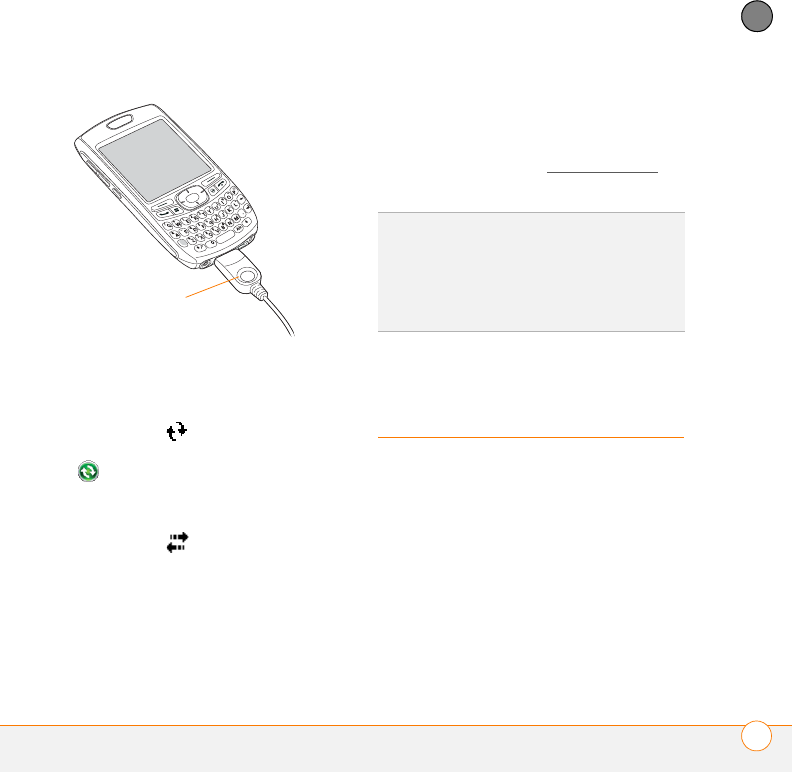
SYNCHRONIZING INFORMATION
SETTING UP WIRELESS SYNCHRONIZATION 81
5
CHAPTER
2Check for synchronization progress:
Windows XP: Look for the animated
ActiveSync icon at the top of your
smartphone screen and the ActiveSync
icon in the taskbar on your
computer.
Windows Vista: Look for the animated
connection icon at the top of your
smartphone screen.
•If you don’t see the correct icon, make
sure the desktop sync software that
came with your smartphone is
running on your computer.
•If you have any problems
synchronizing, see Synchronization for
troubleshooting suggestions.
Setting up wireless
synchronization
Does your company use Microsoft Outlook
as its email solution? Does your company
also use Microsoft Exchange Server 2003
or 2007 as its email server? If so, you may
be able to wirelessly synchronize the email
and other Outlook info on your smartphone
and the same info stored on the Exchange
server using Microsoft Exchange
ActiveSync.
This button has no
function with your
smartphone
TIP
We recommend that you install the backup
and restore app from the Windows Mobile
Getting Started CD. A backup and restore app
preserves your data and settings if your
smartphone is ever lost or stolen, and it
protects your data during a hard reset.
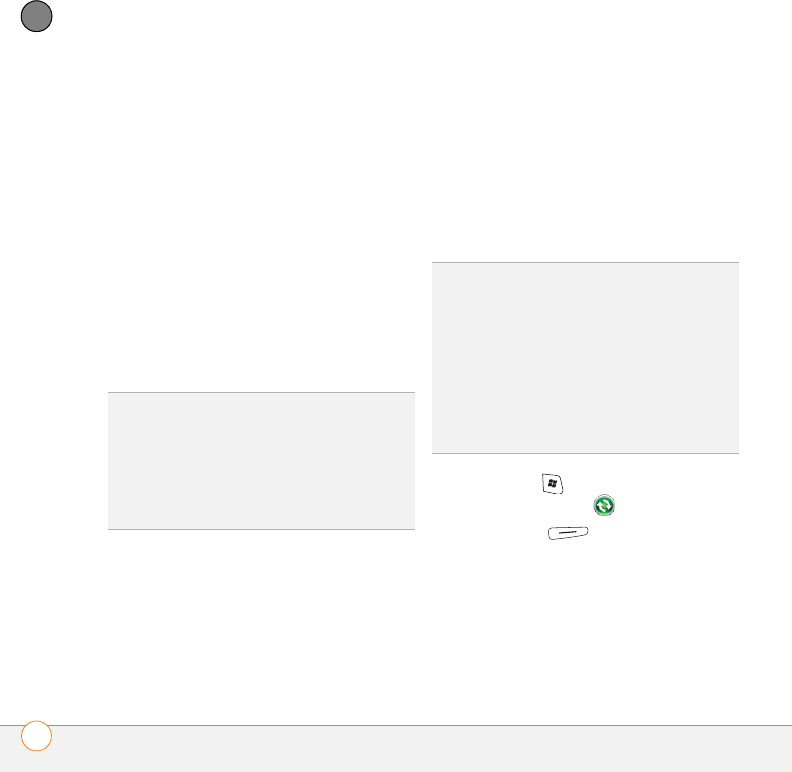
SYNCHRONIZING INFORMATION
SETTING UP WIRELESS SYNCHRONIZATION
82
5
CHAPTER
If you are using Exchange Server 2007 or
Exchange Server 2003 that has been
upgraded to Service Pack 2, you may be
able to take advantage of the additional
features of Direct Push Technology. Direct
Push Technology is a two-way wireless
delivery method that keeps your Outlook
information always up-to-date and provides
more efficient communication between the
server and your smartphone. It includes
features like Global Address List; Tasks
Over The Air (OTA); and IP-based push
updating of Calendar, Messaging, and
Inbox (email).
BEFORE YOU BEGIN To synchronize
wirelessly, you need to set up an Exchange
Server account. Work with your system
administrator to gather the following info,
and then follow the steps in this section to
set up an account:
•Mail server address and domain name.
•The username and password you use to
access your corporate mail server.
•Security connection: Does your server
use an encrypted (SSL) connection?
1Press Start and select Programs.
2Select ActiveSync .
3Press Menu (right action key)
and select Add Server Source.
4Enter the server address. Check the
This server requires an encrypted
DID
YOU
KNOW
?
Because your desktop copy of
Outlook also syncs with the server, whatever
is synchronized to the server from your
smartphone also shows up in Outlook; and
whatever you enter or change in Outlook on
your computer syncs to the server and then
shows up on your smartphone.
TIP
If you installed ActiveSync desktop
software on a Windows XP computer, you
may have already set up your smartphone to
synchronize wirelessly with the server. To
check, press Start, select Programs, and
then select ActiveSync. Press Menu (right
action key). If Configure Server appears
instead of Add Server Source, wireless sync is
already set up, and you can skip this
procedure.
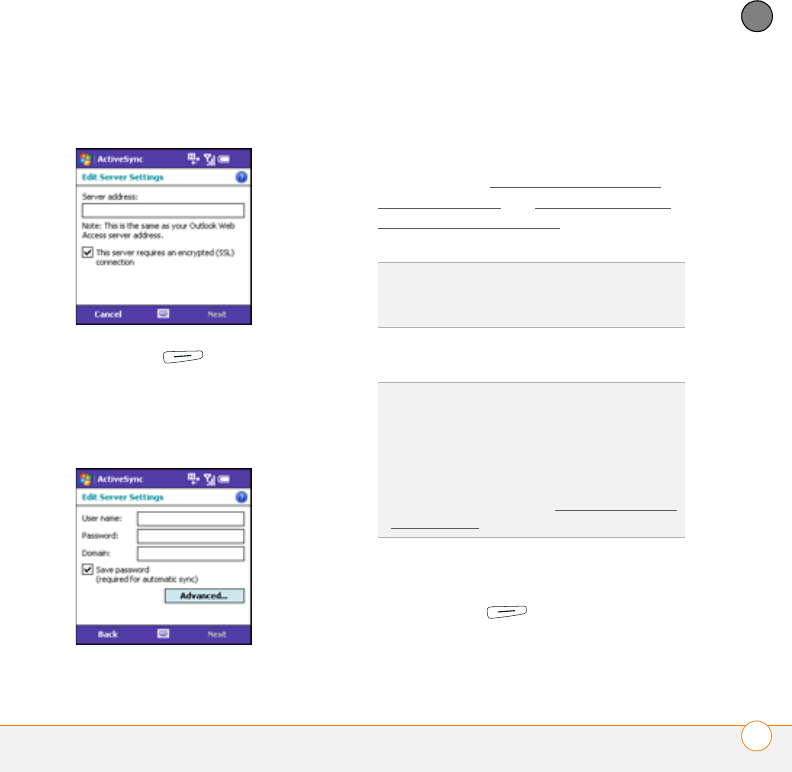
SYNCHRONIZING INFORMATION
SETTING UP WIRELESS SYNCHRONIZATION 83
5
CHAPTER
(SSL) connection box if your server
uses an encrypted connection.
5Press Next (right action key).
6Enter the username and password you
use to access your corporate mail
server, and enter the Exchange server
domain.
NOTE You can’t see your password as you
enter it, so be careful. Be sure Caps Lock
and Option Lock are not on unless you
need them. For info on how to enter
characters, see Entering lowercase and
uppercase letters and Entering numbers,
punctuation, and symbols.
7Check the Save password box.
8(Optional) Select Advanced to set the
rules for fixing sync conflicts.
9Press Next (right action key) and
check the boxes for the types of
TIP
The Exchange server settings are case-
sensitive. Be sure to enter uppercase and
lowercase letters properly.
TIP
Ask your system administrator if it is OK to
store your corporate email password on your
smartphone (for increased security, you may
need to enter your password each time you
access your email). If it is not OK, don’t check
the Save password box; you must
synchronize manually (see Initiating a wireless
sync manually).
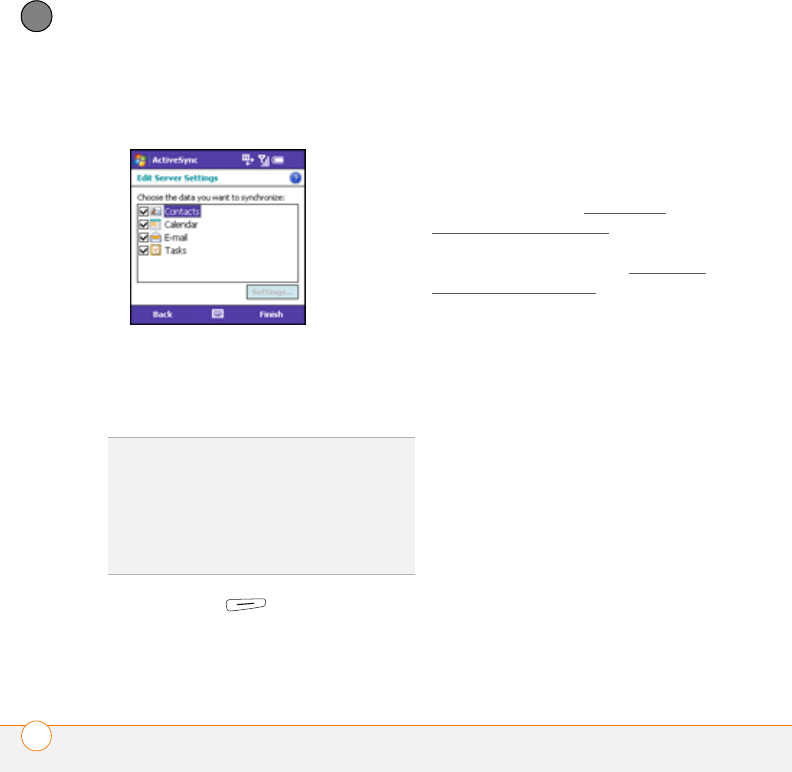
SYNCHRONIZING INFORMATION
SETTING UP WIRELESS SYNCHRONIZATION
84
5
CHAPTER
information you want to synchronize
with the Exchange server.
10 (Optional) Highlight an item and select
Settings to change the synchronization
settings for that type of information.
Settings are not available for all items.
11 Press Finish (right action key).
Synchronization with your Exchange
server begins automatically. A status
bar appears onscreen indicating sync
progress.
You can set a schedule for synchronization
to take place anytime info is updated on
either your smartphone or the server or at
certain intervals (see Setting the
synchronization schedule), or allow
synchronization to take place only when
you initiate it manually (see Initiating a
wireless sync manually).
Setting the synchronization schedule
You can set a synchronization schedule in
either of the following situations:
If you use Microsoft Exchange Server
2007 or Microsoft Exchange Server 2003
with Service Pack 2: By default, wireless
sync takes place anytime info is updated
on either your smartphone or the server
using Direct Push Technology. To save
battery life, however, you can set
synchronization to take place at intervals
that you specify.
If you use Microsoft Exchange Server
2003 that is not upgraded to Service
Pack 2: By default, wireless sync does not
take place automatically. Set a
TIP
To automatically download more of an
incoming email message than the default
setting, select E-mail in step 9 and select a
higher number from the Download size limit
list. If you don’t increase this setting, you can
manually download the rest of the message at
your convenience.
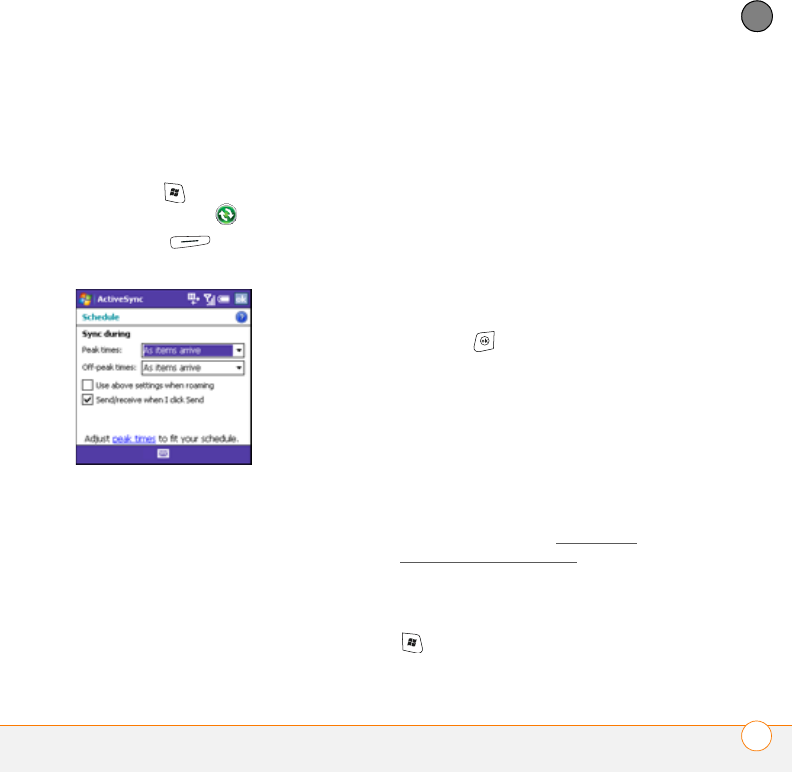
SYNCHRONIZING INFORMATION
SETTING UP WIRELESS SYNCHRONIZATION 85
5
CHAPTER
synchronization schedule to have sync take
place either anytime info is updated on
your smartphone or the server, or at certain
intervals.
1Press Start and select Programs.
2Select ActiveSync .
3Press Menu (right action key)
and select Schedule.
4Set any of the following options:
Peak times: Sets the frequency for
high-traffic time periods such as when
you are at work or when email volume
is high.
Off-peak times: Sets the frequency for
low-traffic time periods such as late at
night.
Use above settings when roaming:
Sets the frequency while you are
roaming outside your wireless service
provider’s network. You should keep
this box checked to ensure that wireless
sync works properly.
Send/receive when I click Send: Sets
whether items are sent as soon as you
select Send in the Inbox application,
or whether they are held until the next
synchronization.
5Press OK .
Initiating a wireless sync manually
If you want to control exactly when a
wireless sync takes place, or if it is not OK
to store your corporate email password on
your smartphone, you can initiate sync
manually.
1To set up manual sync, follow the
preceding procedure, Setting the
synchronization schedule. In the Peak
times and Off-peak times lists, select
Manual.
2To initiate a manual sync, press Start
and select Programs.
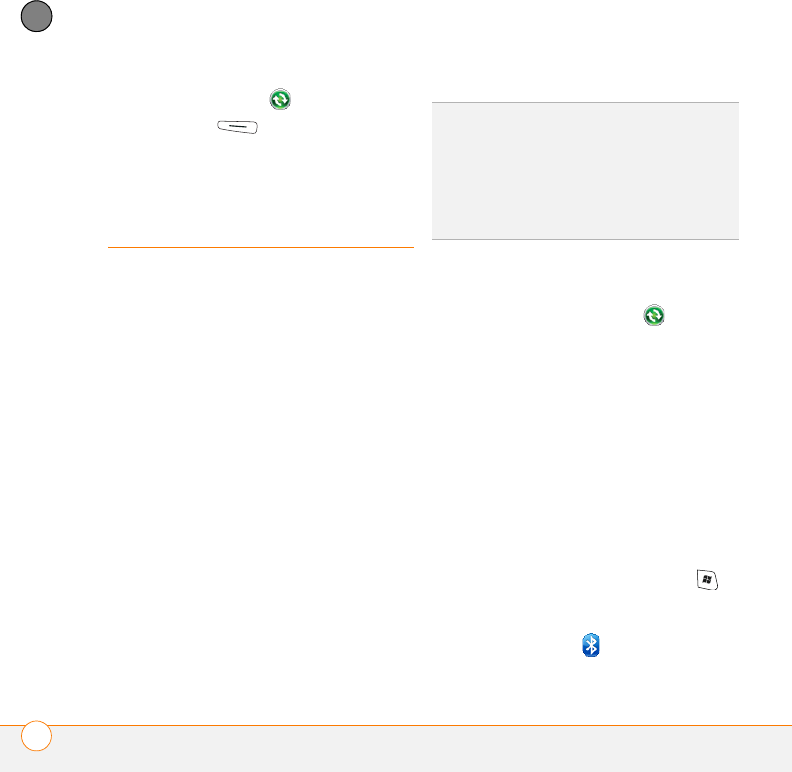
SYNCHRONIZING INFORMATION
OTHER WAYS TO SYNCHRONIZE
86
5
CHAPTER
3Select ActiveSync .
4Press Sync (left action key).
Other ways to
synchronize
Synchronizing over a Bluetooth
connection
You can synchronize your computer and
smartphone using Bluetooth wireless
technology.
BEFORE YOU BEGIN Do the following:
•Make sure your computer is equipped
with Bluetooth wireless technology.
•If you have not already done so, install
the ActiveSync Plug-in for Bluetooth
wireless technology from the Windows
Mobile Getting Started CD. The plug-in
is installed on your computer and is
needed to synchronize over a Bluetooth
connection with your smartphone.
1Do one of the following:
Windows XP: On your computer,
right-click the ActiveSync icon in
the taskbar in the lower-right corner of
the screen, and select Connection
Settings.
Windows Vista: Click Start > All
Programs > Windows Mobile Device
Center. Select Connect without
setting up your device, and then
select Connection settings.
2Check the Allow connections for one
of the following box, and then select
Bluetooth.
3On your smartphone, press Start
and select Settings.
4Select the Connections tab, and then
select Bluetooth .
TIP
To install the plug-in for Bluetooth
technology, insert the Windows Mobile
Getting Started CD into your computer’s CD
drive, and select Add Programs (Windows
XP) or Bonus Software (Windows Vista).
Select the plug-in option and follow the
onscreen instructions.
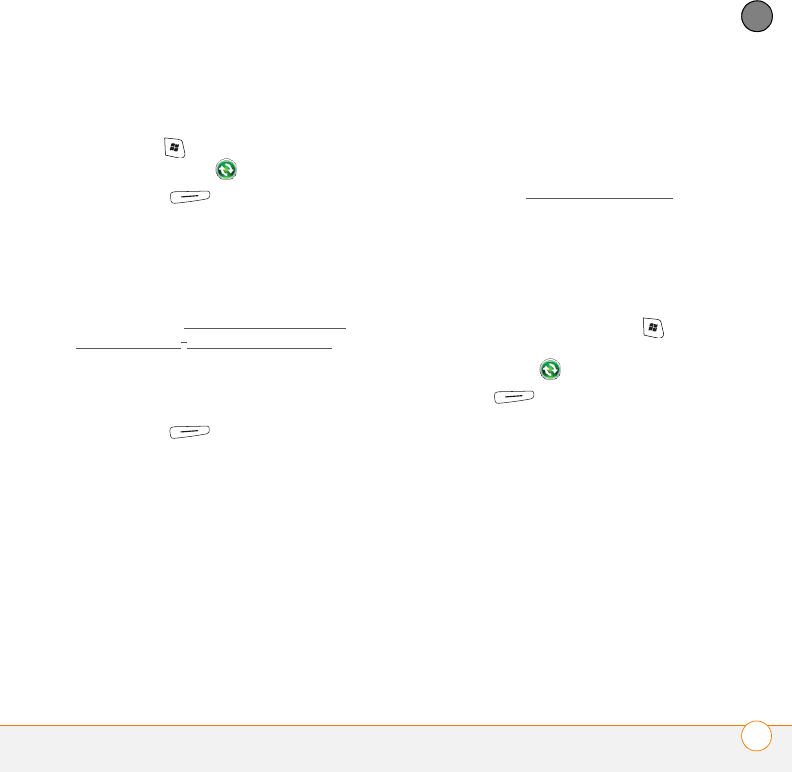
SYNCHRONIZING INFORMATION
OTHER WAYS TO SYNCHRONIZE 87
5
CHAPTER
5Select the Mode tab and check the Tu r n
on Bluetooth box.
6Press Start and select Programs.
7Select ActiveSync .
8Press Menu (right action key)
and select Connect via Bluetooth.
9If this is the first time you’re making a
Bluetooth connection to this computer,
follow the onscreen prompts to set up a
Bluetooth partnership with this
computer. See Connecting to devices
with Bluetooth® wireless technology for
more information on partnerships.
10 Select Sync.
11 When synchronization has finished,
press Menu (right action key)
and select Disconnect Bluetooth.
Synchronizing over an infrared
connection
If your computer has an IR (infrared) port,
you can synchronize with your computer
wirelessly using the IR port on your
smartphone.
BEFORE YOU BEGIN
•Make sure your computer is equipped
with an IR port.
•Turn on your smartphone’s IR
functionality (see Beaming information).
1Set up your computer to receive
infrared beams. See ActiveSync Help on
your computer for details.
2Point the IR port directly on your
smartphone at your computer’s IR port.
3On your smartphone, press Start
and select Programs.
4Select ActiveSync .
5Press Menu (right action key)
and select Connect via IR.
6Select Sync.
Synchronizing with multiple computers
You can set up your smartphone to
synchronize with up to two computers as
well as with Exchange Server 2003 or 2007.
When synchronizing with multiple
computers, the items that you synchronize
appear on all the computers.
For example, if you set up to sync your
smartphone with two computers named
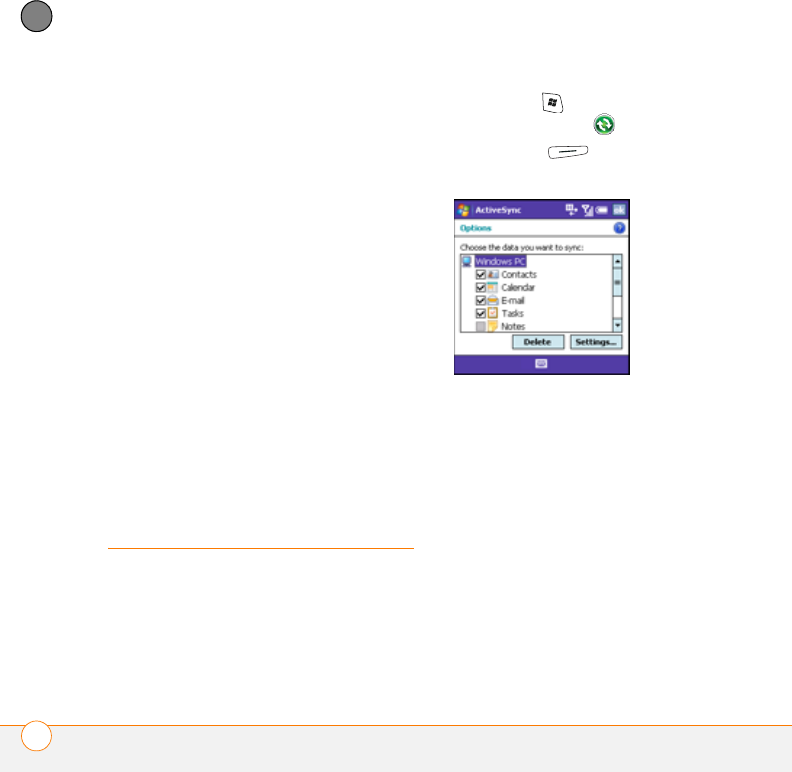
SYNCHRONIZING INFORMATION
SETTING SYNCHRONIZATION OPTIONS
88
5
CHAPTER
C1 and C2, when you sync Contacts and
Calendar on your smartphone with both
computers, you get the following results:
•The contacts and calendar
appointments that were on C1 are now
also on C2.
•The contacts and calendar
appointments that were on C2 are now
also on C1.
•The contacts and calendar
appointments from both computers are
on your smartphone.
NOTE Microsoft® Office Outlook® E-mail
can synchronize with only one computer.
Setting
synchronization
options
Changing which applications sync
You must select sync options if you want to
synchronize notes, pictures, and other
types of files.
1Press Start and select Programs.
2Select ActiveSync .
3Press Menu (right action key)
and select Options.
4Do any of the following:
•Check the box next to any items you
want to synchronize. If you cannot
check a box, you might have to
uncheck a box for the same
information type elsewhere in the list.
•Uncheck the box next to any items
you want to stop synchronizing.
•Select an item and then select
Settings to customize the settings for
that item. Settings are not available
for all items.
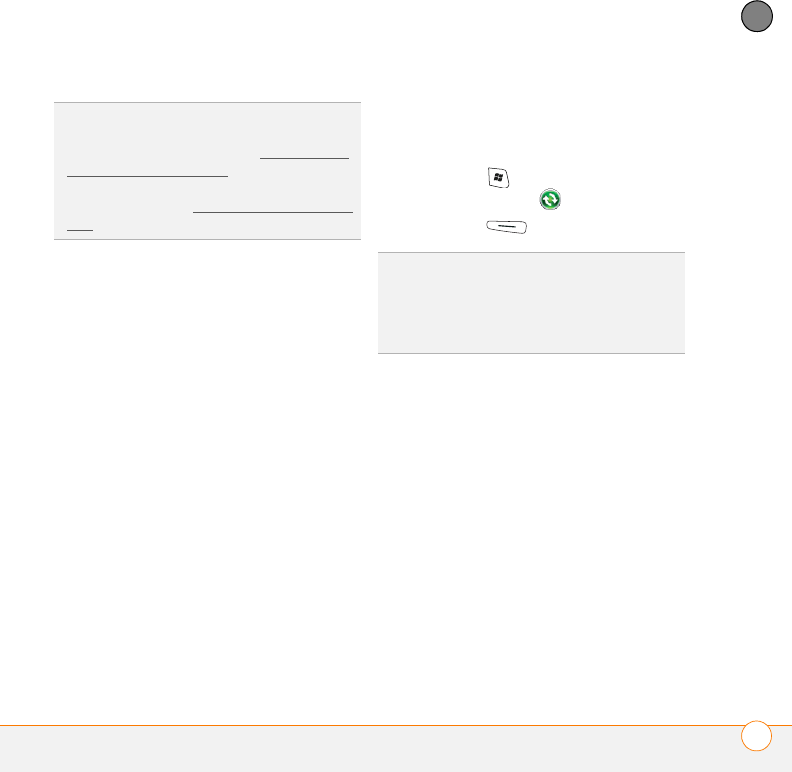
SYNCHRONIZING INFORMATION
SETTING SYNCHRONIZATION OPTIONS 89
5
CHAPTER
Stopping synchronization
If you ever need to manually stop
synchronization, follow these steps:
1Press Start and select Programs.
2Select ActiveSync .
3Press Stop (left action key).
TIP
For detailed information on synchronizing
Word documents, Excel spreadsheets, and
PowerPoint presentations, see Synchronizing
your Microsoft Office files. For detailed
information on synchronizing pictures, videos,
and music files, see Synchronizing your media
files.
TIP
To end the sync relationship between you
smartphone and a computer so that items are
no longer synchronized with that computer,
select the computer name on the ActiveSync
screen, and then select Delete.

SYNCHRONIZING INFORMATION
SETTING SYNCHRONIZATION OPTIONS
90
5
CHAPTER

CHAPTER
6
Your email
You already know how efficient email is for staying in touch.
Now your Palm® Treo™800W smartphone brings you a new level
of convenience: email on the go. Enjoy the ease and speed
of communicating with friends, family, and colleagues
anywhere you can access your wireless service provider’s data
network.
You can send photos to your friends and family, or create
Microsoft Word or Excel files and send them to your
colleagues. You can also receive attachments to view and edit
at your convenience.
Benefits
•Receive photos, sound files, Word
and Excel files, and more
•Attach and send files of almost any
type
•Save messages from your
computer to view at a convenient
time

In this chapter
Setting up email . . . . . . . . . . . . . . . . . . . . . . . . . . . . . . . . . . . . . . . . 93
Sending and receiving messages . . . . . . . . . . . . . . . . . . . . . . . . . . 101
Working with email messages. . . . . . . . . . . . . . . . . . . . . . . . . . . . . 106
Working with meeting invitations . . . . . . . . . . . . . . . . . . . . . . . . . . 116

YOUR EMAIL
SETTING UP EMAIL 93
6
CHAPTER
Setting up email
You can use the Inbox application to send
and receive email. Before you use your
smartphone to send or receive messages,
consult your wireless service provider for
pricing and availability of email services and
data rate plans.
BEFORE YOU BEGIN
•Make sure your phone is on and you’re
inside a coverage area before you send
or receive messages.
•If you want delivery of Outlook email
using Direct Push Technology, make
sure that your IT organization uses
Exchange Server 2007 or Exchange
Server 2003 with Service Pack 2.
Entering settings for an email account
DID
YOU
KNOW
?
You can enter settings for more
than one email account; and you can use
different email setup applications on your
smartphone to enter settings for different
accounts, depending on which app best
meets your needs.
Email account type Type of email you can access How to set up
POP/IMAP You can obtain email from an
ISP or Internet email account
such as EarthLink, or from a
small business or corporate
Internet email account.
See Setting up a POP/IMAP
account in the Inbox
application: Common email
providers or Setting up a POP/
IMAP account in the Inbox
application: Other email
providers.
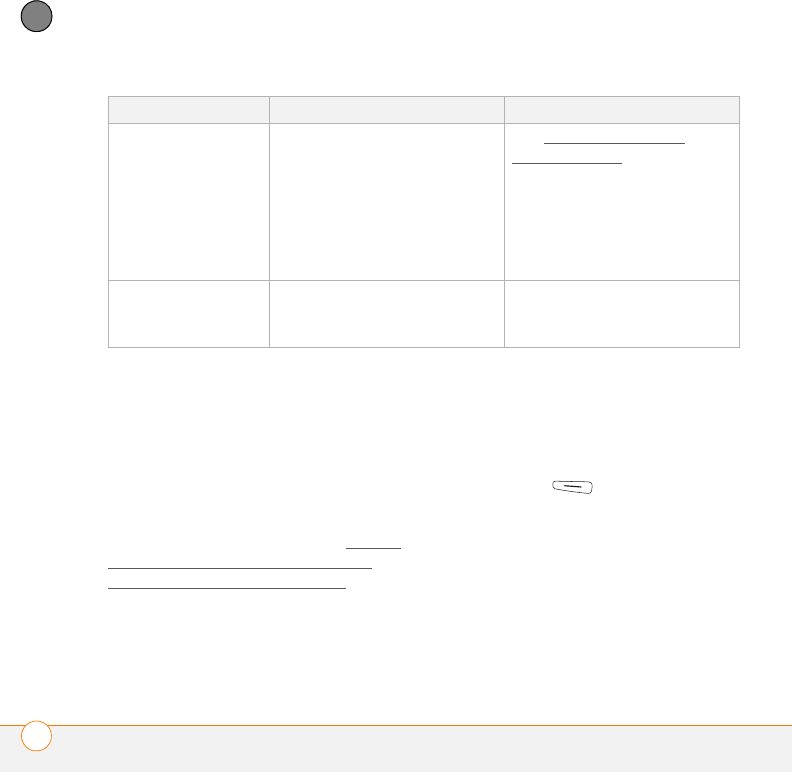
YOUR EMAIL
SETTING UP EMAIL
94
6
CHAPTER
Setting up a POP/IMAP account in the
Inbox application: Common email
providers
Follow this procedure if you have a
common email provider such as AOL,
EarthLink, or Yahoo!. If you are setting up
the Inbox application to work with your
corporate email account, or you have a
less-common email provider, see Setting
up a POP/IMAP account in the Inbox
application: Other email providers.
BEFORE YOU BEGIN Ask your email
provider or system administrator for your
account username and password if you
don’t know them.
1Go to your Today screen.
2Press E-mail (left action key).
3Select New E-mail Account.
4Enter the email address that you want
to set up. Check the box to have the
setup process get your account settings
from the Internet.
Microsoft Exchange
server
You can retrieve corporate
email using a Microsoft
Exchange server. You can
access email wirelessly if your
company is using Microsoft
Exchange ActiveSync®.
See Setting up wireless
synchronization.
You may need to check with
your IT organization to ensure
that Exchange ActiveSync® is
supported and to obtain the
configuration settings.
Free web-based
email
You can access mail from
Yahoo! and other free
web-based systems.
Access the email website
directly using your
smartphone’s web browser.
Email account type Type of email you can access How to set up
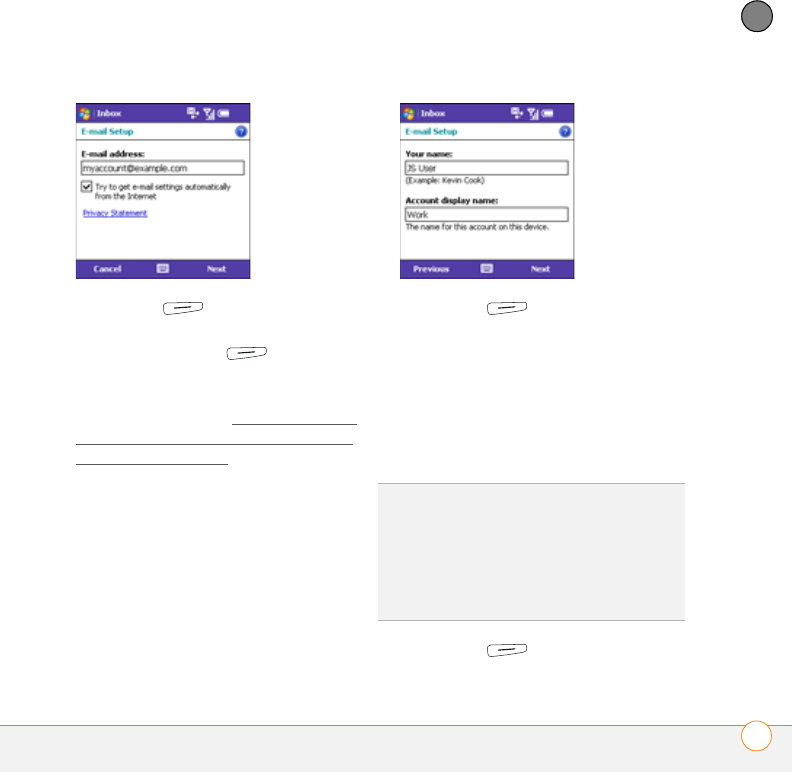
YOUR EMAIL
SETTING UP EMAIL 95
6
CHAPTER
5Press Next (right action key).
6If the setup process finds your account
settings, press Next (right action
key).
If the setup process does not find your
account settings, see Setting up a POP/
IMAP account in the Inbox application:
Other email providers and continue with
step 7 of that procedure.
7Enter your name and, if you want,
change your account display name to
something meaningful. For example, if
this is your work email account, you can
change the display name to “Work” or
your company’s name.
8Press Next (right action key).
9Enter your account username and
password.
10 If you want your password entered
automatically, check the Save
password box. If you want to enter
your password each time you access
this account, do not check this box.
11 Press Next (right action key).
DID
YOU
KNOW
?
Checking the Save password box
makes it easier to check your email, because
you don’t have to enter your password each
time. Leaving the box unchecked keeps your
email more secure, because no one can
download messages without entering your
password.
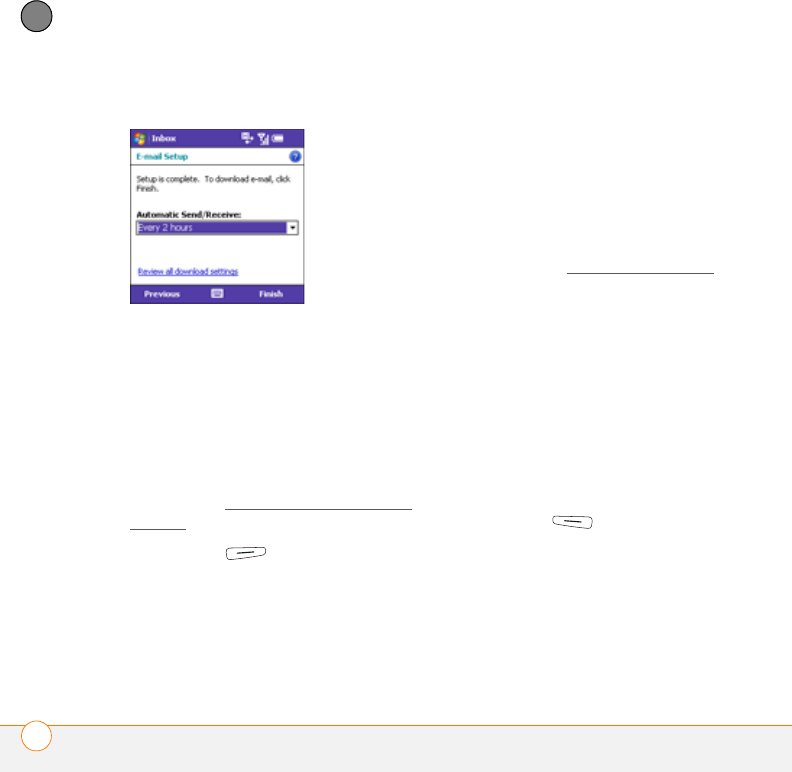
YOUR EMAIL
SETTING UP EMAIL
96
6
CHAPTER
12 (Optional) Select either of the following:
Automatic Send/Receive: Change the
time interval for automatically
downloading email, from every 5
minutes to once a day. If you do not
want to automatically download
messages, select Manually.
Review all download options: Select
this option to change download
settings; see Changing email download
settings for information.
13 Press Finish (right action key). If
prompted, select OK to download
messages for this account now.
Setting up a POP/IMAP account in the
Inbox application: Other email providers
You can set up an account in the Inbox
application to send and receive email
messages using an email account that you
have with an Internet service provider
(ISP), an email account that you access
using a VPN server connection (such as a
work account; see Connecting to a VPN),
or any other IMAP or POP email account.
BEFORE YOU BEGIN Work with your
email provider or system administrator to
gather the following info:
•Account type (POP3 or IMAP)
•Mail server name for receiving mail
•Your username and password
•Any special security requirements
1Go to your Today screen.
2Press E-mail (left action key).
3Select New E-mail Account.
4Enter the email address that you want
to set up. Check the box if you want the
setup process to try to get your account
settings from the Internet.
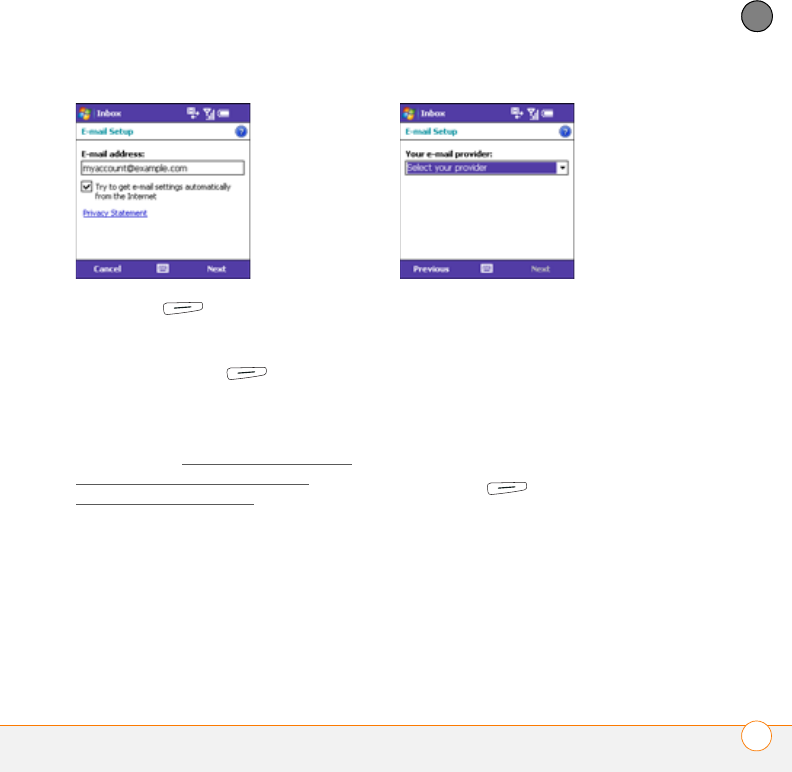
YOUR EMAIL
SETTING UP EMAIL 97
6
CHAPTER
5Press Next (right action key).
6If you did not check the box in step 4 or
the setup process does not find account
settings, press Next (right action
key).
If you did check the box and the account
setup process finds your account
settings, go to Setting up a POP/IMAP
account in the Inbox application:
Common email providers and continue
with step 7 of that procedure.
7If prompted, select either of the
following as your email provider:
Internet e-mail: Select this option if you
access email from any type of email
account except a corporate account that
uses an Exchange mail server.
Exchange server: Select this option if
you access email from a corporate
email account using an Exchange
server.
8Press Next (right action key).
9Enter your name and, if you want,
change your account display name to
something meaningful. For example, if
this is your work email account, you can
change the display name to “Work” or
your company’s name.
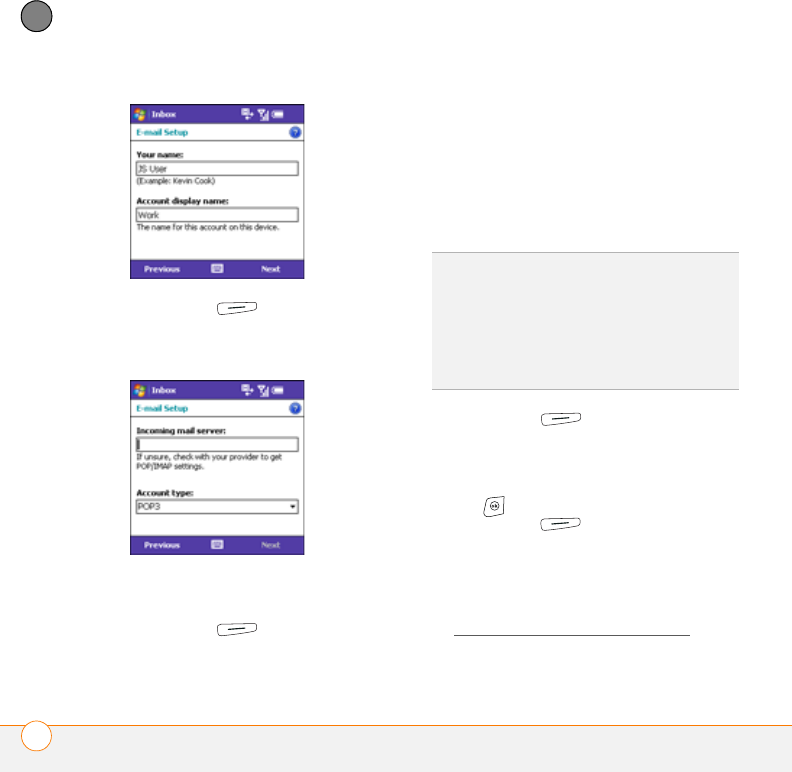
YOUR EMAIL
SETTING UP EMAIL
98
6
CHAPTER
10 Press Next (right action key).
11 Enter the name of the incoming mail
server.
12 Select the Account type list, and then
select POP3 or IMAP.
13 Press Next (right action key).
14 Enter your account username and
password.
15 If you want your password entered
automatically, check the Save
password box. If you want to enter
your password each time you access
this account, do not check this box.
16 Press Next (right action key).
17 If you receive an alert that your wireless
service provider has already customized
the outgoing mail server settings, press
OK to close the alert, and then
press Next (right action key) on
the outgoing mail server settings
screen. Do not enter or change anything
on the screen.
If you do not receive an alert, go to
Entering outgoing server settings.
TIP
For a corporate email account, ask your
system administrator if it is OK to store your
corporate email password on your
smartphone (for increased security, you may
need to enter your password each time you
access your email). If it is not OK, don’t check
the Save password box.
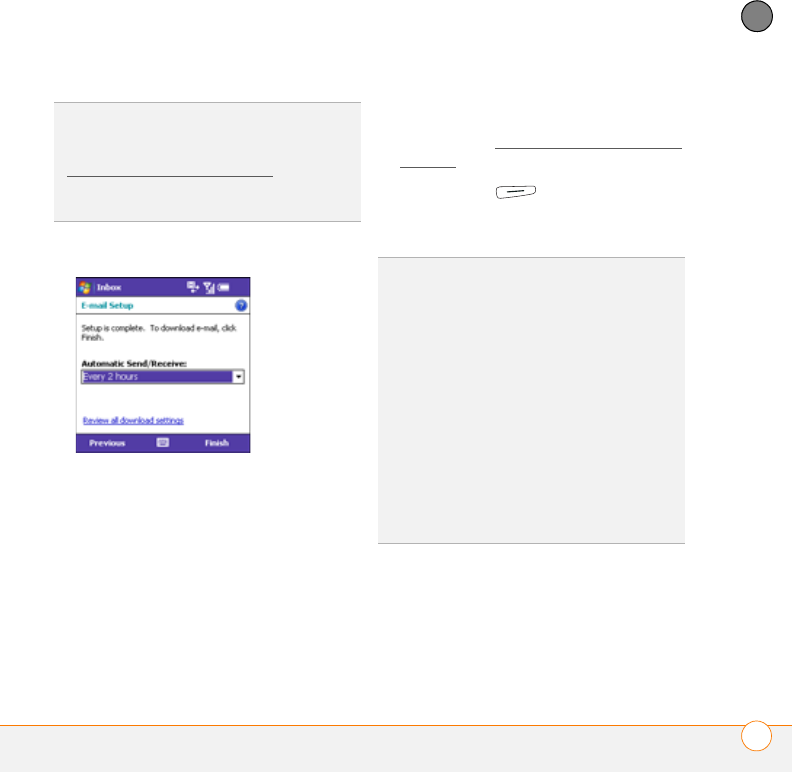
YOUR EMAIL
SETTING UP EMAIL 99
6
CHAPTER
18 (Optional) Select either of the following:
Automatic Send/Receive: Change the
time interval for automatically
downloading email, from every 5
minutes to once a day. If you do not
want to automatically download
messages, select Manually.
Review all download settings: Select
this option to change download
settings; see Changing email download
settings for information.
19 Press Finish (right action key). If
prompted, select OK to download
messages for this account now.
Entering outgoing server settings
If, during account setup, you do not receive
an alert saying that your wireless service
provider has set the outgoing mail options,
you need to manually enter these settings.
TIP
If you do not receive an alert, and if your
incoming mail requires SSL, you set that
option with the outgoing server settings. See
Entering outgoing server settings and check
the Require SSL for Incoming e-mail box on
the Advanced Server Settings screen.
DID
YOU
KNOW
?
On the Accounts tab in Messaging
Options, an asterisk appears next to the
accounts you create.
TIP
To delete an email account or to edit
account settings—for example, if you need to
change the name of the outgoing mail
server—press Menu (right action key) and
select Tools > Options. To delete an account,
highlight the account you want, press and
hold Center on the 5-way, and then select
Delete. (To delete an Outlook Email account,
use the ActiveSync application, not the Inbox
application.) To edit an account, select the
account and go through the screens to change
the settings you want to edit.
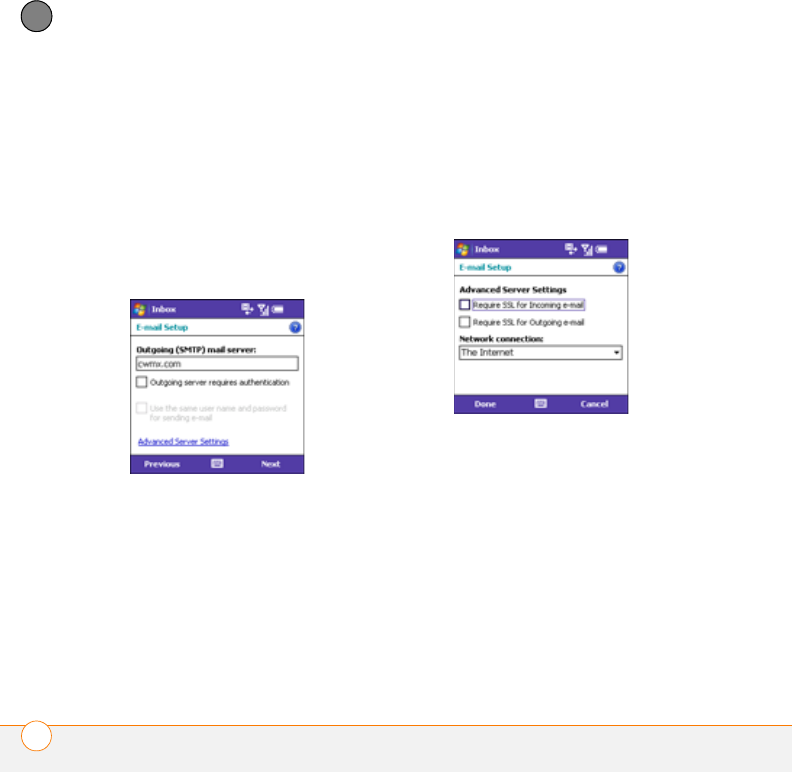
YOUR EMAIL
SETTING UP EMAIL
100
6
CHAPTER
BEFORE YOU BEGIN Work with your
email provider or system administrator to
gather the following info:
•Mail server name for sending mail
•Any special security requirements
1On the screen for entering outgoing
mail settings, select the correct settings
for the following:
Outgoing (SMTP) mail server: Enter
the server name.
Outgoing server requires
authentication: Check the box if your
outgoing mail server requires
authentication.
Use the same user name and
password for sending e-mail: Check
the box if the server requires you to use
your account username and password
when sending email.
2Select Advanced Server Settings, and
then select the correct settings for
either of the following:
Require SSL for Incoming e-mail:
Check the box if your account requires
SSL for incoming messages.
Require SSL for Outgoing e-mail:
Check the box if your account requires
SSL for outgoing messages.
Network connection: Select the type
of connection to use for sending and
receiving email.
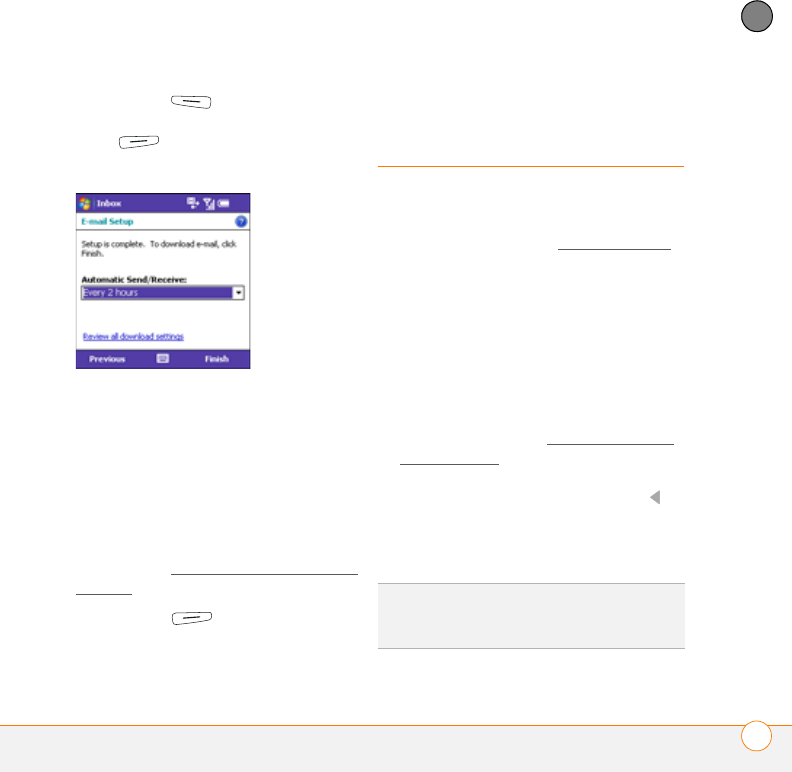
YOUR EMAIL
SENDING AND RECEIVING MESSAGES 101
6
CHAPTER
3Select Done (left action key). On
the outgoing mail server screen, press
Next (right action key).
4(Optional) Select either of the following:
Automatic Send/Receive: Change the
time interval for automatically
downloading email, from every 5
minutes to once a day. If you do not
want to automatically download
messages, select Manually.
Review all download settings: Select
this option to change download
settings; see Changing email download
settings for information.
5Press Finish (right action key). If
prompted, select OK to download
messages for this account now.
Sending and
receiving messages
Selecting which email account to use
If you set up more than one email account
on your smartphone (see Setting up email),
you can select the account you want to use
to view or send messages in one of two
ways:
•By default, when you open the Inbox
application, a list of all of your email
accounts appears. Select the account
you want.
•If you turn off the option to display the
list of accounts (see Customizing your
email settings), when you open the
Inbox application, the last account you
were using is displayed. Press Left to
cycle through your accounts until the
name of the account you want appears
in the title bar.
TIP
Also press Left to switch to a different
account after you are finished working in the
first account you selected.
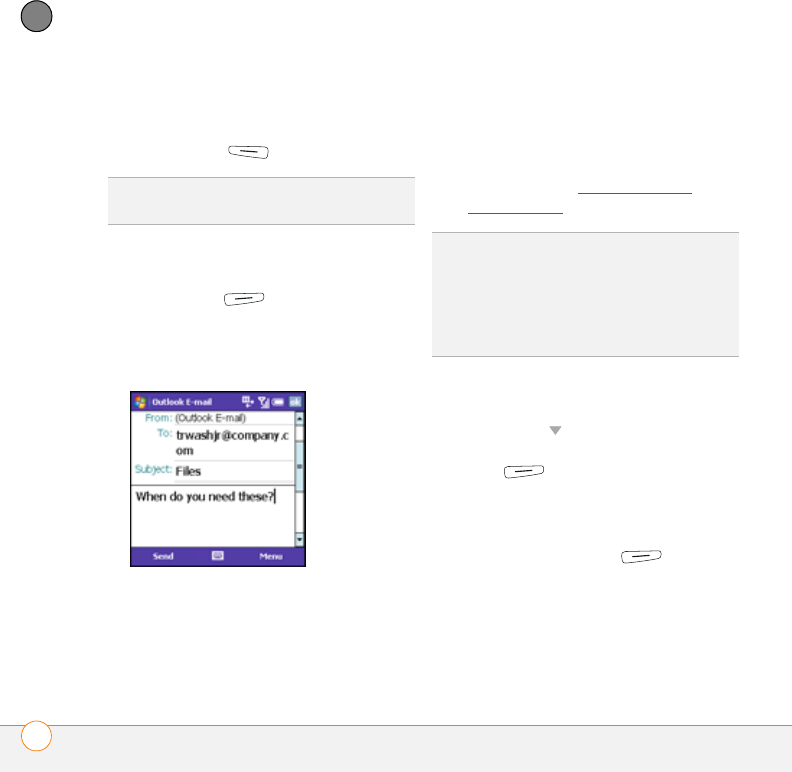
YOUR EMAIL
SENDING AND RECEIVING MESSAGES
102
6
CHAPTER
Creating and sending an email message
1Go to your Today screen.
2Press E-mail (left action key).
3Select the account you want to use to
send a message.
4Press Menu (right action key)
and select New.
5Enter the recipient’s email address.
Here are some shortcuts:
•If the recipient’s name and email
address are in your Contacts list,
enter the first few letters of the
recipient’s first name, last name, or
email address, and then select the
recipient’s name.
•If the recipient’s name is in an online
address book, you can find the name
and add it. See Using an online
address book.
6Select Subject and enter a title for the
message.
7Press Down to go to the body of the
message. Enter your message, or press
Menu (right action key), select
My Text, and then select a predefined
phrase you want to insert.
8(Optional) To attach an item to the
message, press Menu (right
action key) and select Insert. Select the
type of item you want to attach, and
then select the file or record a voice
note.
DID
YOU
KNOW
?
You can also access the Inbox
application from the Start menu.
DID
YOU
KNOW
?
When addressing a message, you
can enter the contact’s first and last initials
separated by a space.
TIP
To address a message to multiple
recipients, separate the addresses by
pressing Enter or entering a semicolon (;).

YOUR EMAIL
SENDING AND RECEIVING MESSAGES 103
6
CHAPTER
9(Optional) Press Menu (right
action key) and do one or both of the
following:
•Select Spell Check. When the spell
check is complete, press OK .
•Select Message Options. Select the
Priority list, select a priority setting
for the message, and then press
OK .
10 Press Send (left action key).
Receiving email messages
How you receive email messages depends
on the type of account you are using and
how you synchronize:
•If you synchronize wirelessly with your
Exchange server using Microsoft
Exchange ActiveSync, new email
messages are sent to your smartphone
when they appear on the server,
according to the schedule you set up
(see Setting the synchronization
schedule), or when you manually initiate
a sync (see Initiating a wireless sync
manually.
•If you use desktop sync software to
synchronize your smartphone with your
computer, messages in Outlook on your
computer are transferred to your
smartphone when you connect your
TIP
You can send an email message with a file
attached from directly within other
applications on your smartphone; see Sending
email messages from within another
application.
TIP
To save memory on your smartphone, turn
off the option to save sent messages in the
Saved folder. In the Inbox, press Menu (right
action key) and select Tools > Options. Select
the Message tab, and then uncheck the Keep
copies of sent items in Sent folder box.
TIP
If you sync email with Microsoft Exchange
Server 2003 or 2007, you can synchronize
messages in subfolders you create. In the
Inbox, press Menu (right action key) and
select Tools > Manage Folders. Folders
containing subfolders display a +. Select the +
to view the subfolders. Check the box to the
left of any subfolder you want to sync.
TIP
If you synchronize email with Microsoft
Exchange Server 2007, and you receive a
message containing a link to a document on
SharePoint or an internal file server, you can
view the document by selecting the link.
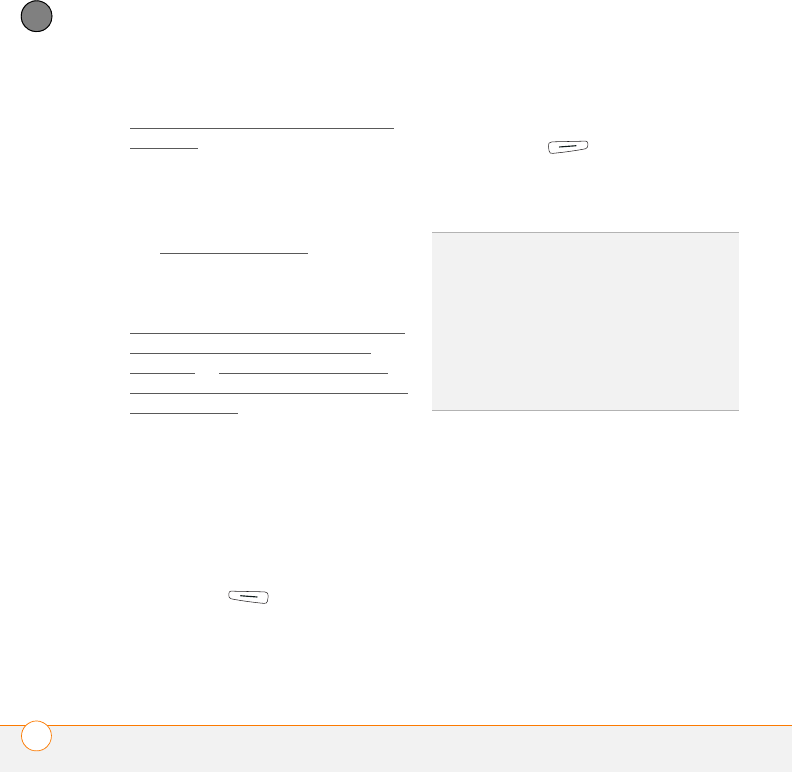
YOUR EMAIL
SENDING AND RECEIVING MESSAGES
104
6
CHAPTER
computer and your smartphone (see
Connecting your smartphone to your
computer).
•For all other types of accounts,
including ISP accounts and accounts
you access using a VPN server
connection (typically a work account;
see Connecting to a VPN), message
retrieval depends on the option you
chose from the Automatic Send/
Receive list during account setup (see
Setting up a POP/IMAP account in the
Inbox application: Common email
providers or Setting up a POP/IMAP
account in the Inbox application: Other
email providers), as follows:
If you chose a time interval: Your
smartphone automatically checks for
and downloads new messages
according to that interval.
If you chose Manually: Follow these
steps to send and receive messages:
1Go to your Today screen.
2Press E-mail (left action key).
3Select the account containing the
messages you want to view.
4Press Menu (right action key)
and select Send/Receive to
synchronize your smartphone with your
email server.
Receiving attachments
1Scroll to the attachment name (below
the subject) to highlight it. This marks it
for download.
2Synchronize the email account that
contains the message as described in
the previous sections.
3Scroll to and select the attachment
name (below the subject) to open the
attachment.
TIP
Partially downloaded messages appear in
the message list with a partial envelope icon
to the left of the subject. To view the full
message, either press Menu (right action key)
and select Download Message, or open the
message and select Get the rest of this
message.
DID
YOU
KNOW
?
You can view messages sent as
HTML with the HTML formatting intact.
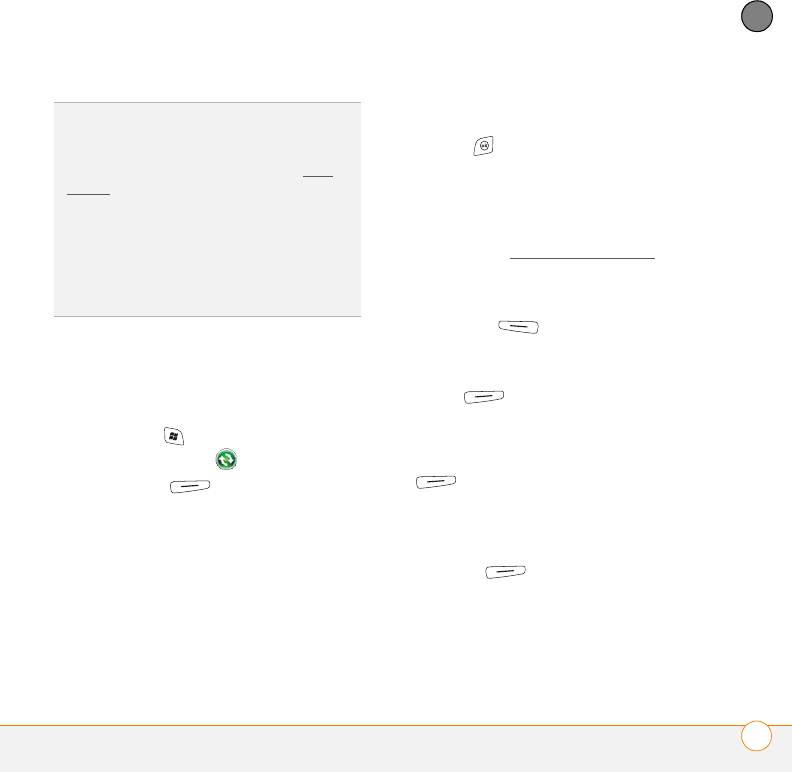
YOUR EMAIL
SENDING AND RECEIVING MESSAGES 105
6
CHAPTER
If you are synchronizing with Outlook on
your computer and want to download
attachments automatically, do the
following:
1Press Start and select Programs.
2Select ActiveSync .
3Press Menu (right action key)
and select Options.
4Select E-mail, and then select
Settings.
5Check the Include file attachments
box.
6(Optional) To automatically download
attachments up to a certain size only,
check the Only if smaller than box and
enter the maximum attachment size.
7Press OK .
To automatically download attachments
from an IMAP4 email account (typically an
ISP account) or an account that you access
using a VPN server connection (typically a
work account; see Connecting to a VPN, do
the following:
1Go to your Today screen.
2Press E-mail (left action key).
3Do one of the following:
•If the account list is displayed, press
Menu (right action key) and
select Options.
•If the message list for a specific
account is displayed, press Menu
(right action key) and select
To o l s > Options.
4On the Accounts tab, select the IMAP4
account name.
5Press Next (right action key) until
you reach Server information, and then
select Options.
6Press Next twice, and then select
either Get full copy of messages and
DID
YOU
KNOW
?
You can receive and open
attachments in a number of different formats,
including PDF. PDF file attachments open in
PDF Viewer on your smartphone (see PDF
Viewer).
TIP
To store attachments on an expansion card,
insert the card into your smartphone’s
expansion card slot, press Menu (right action
key) and select To o l s > Options. Select
Storage and check the When available, use
this storage card to store attachments box.
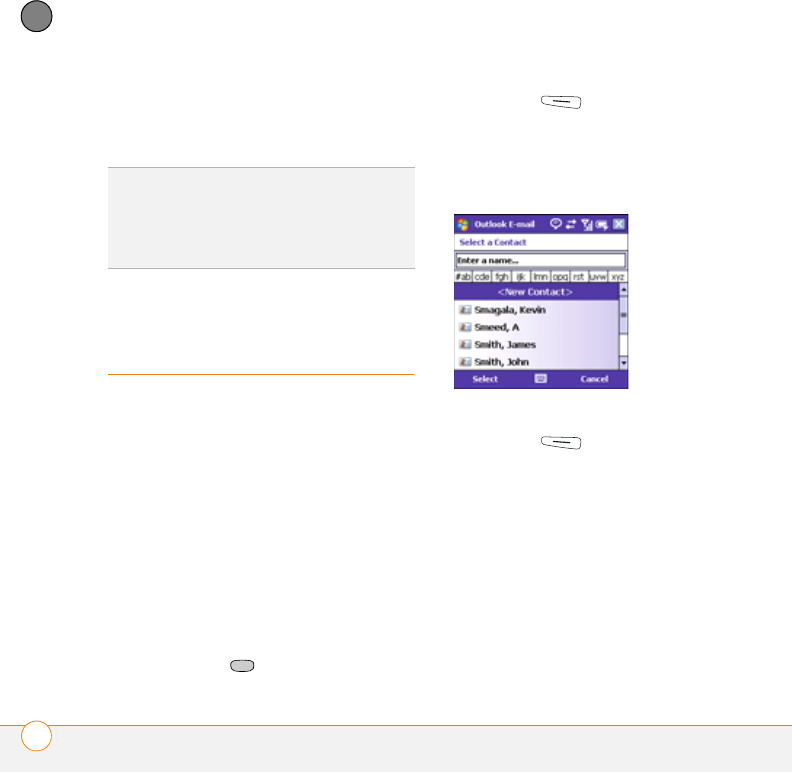
YOUR EMAIL
WORKING WITH EMAIL MESSAGES
106
6
CHAPTER
When getting full copy, get
attachments or Entire message,
depending on the option displayed.
Working with email
messages
Adding a contact from an email message
You can add a contact name or email
address to your Contacts list directly from
the To, cc, or bcc field of an email
message. You can select the name or
address from either an outgoing or an
incoming message, and you can either
create a new contact or add the
information to an existing contact.
1In an open message, highlight the name
or address of the contact you want to
add.
2Press Center .
3Press Save (left action key).
4Select <New Contact> to create a new
contact entry for this name or address,
or select an existing contact to add the
name or address to that entry.
5Enter or edit the contact information.
6Press Save (left action key).
Adding an online address book
Many email servers, including servers
running Exchange Server, can verify names
with an online address book, also called a
directory service or a Global Address List.
After you create and enable an email
account, the Inbox application checks your
contacts list and then the directory service
to verify names that you enter in the To, cc,
and bcc fields.
DID
YOU
KNOW
?
Embedded images and objects
cannot be received as attachments, unless
you have an IMAP4 email account with TNEF
disabled. Note that TNEF must be enabled to
receive meeting requests.

YOUR EMAIL
WORKING WITH EMAIL MESSAGES 107
6
CHAPTER
BEFORE YOU BEGIN Do the following:
•Ask your system administrator for the
name of the directory service and the
server, and whether authentication is
required for accessing an online address
book.
•If your company is using Exchange
Server 2003 upgraded to Service Pack 2
or Exchange Server 2007, you must first
synchronize with the Exchange server
to enable the Global Address List to find
a contact.
1In the message list, press Menu
(right action key) and select To o l s >
Options.
2Select the Address tab.
3Select the address book you want to
check for email addresses, and then
select Add.
4Enter the name of the directory service.
5Enter the server name.
6If your server requires authentication,
check the box and enter your username
and password.
7(Optional) Check the Check name
against this server box to enable this
directory service.
8Select OK.
Using an online address book
You can access contact information, such
as an email address or phone number, from
your organization’s online address book or
Global Address List (GAL). To access a
GAL, make sure you are accessing either
Exchange Server 2007 or Exchange Server
2003 upgraded to Service Pack 2. This
feature is useful only if you know the exact
name as it appears in the directory.
TIP
To delete a directory service, highlight it,
press and hold Center on the 5-way, and
select Delete.
DID
YOU
KNOW
?
You can use the Global Address
List to find a contact. In Contacts, press
Menu (right action key) and select Company
Directory. When sending a meeting request,
select Attendees, press Menu (right action
key) and select Company Directory.

YOUR EMAIL
WORKING WITH EMAIL MESSAGES
108
6
CHAPTER
BEFORE YOU BEGIN Add access to an
online address book to your smartphone
(see Adding an online address book).
1In a new message, select To .
2Press Menu (right action key)
and select Add Recipient.
3Press Menu (right action key)
and select Company Directory.
4Enter the contact name as it appears in
the directory and press Find (left
action key). You must spell the contact
name correctly.
Finding messages
You can find messages containing a
specific word or phrase. The find feature
searches names, email addresses, and
subject lines.
1Press E-mail (left action key).
2Select the account you want.
3Begin typing the word or phrase you
want to find. The list display changes to
show only those messages containing
the letters you have entered.
4Continue entering letters to narrow the
display until the message you want
appears.
Replying to a message
1Open the message to which you want
to reply.
2Press Reply (left action key).
3Address the message and enter any
text you want to add.
4(Optional) Select Edit sender’s
message to edit the original sender’s
message text that you include in your
reply.
5Press Send (left action key).
TIP
When you sync with Outlook on your
computer, disable your online address books
to avoid errors. Press Menu (right action key)
and select Tools > Options. Select Address,
select each online address book, and then
uncheck the Check name against this server
box. Be sure to turn this option back on if you
synchronize other email accounts.
DID
YOU
KNOW
?
If you synchronize with Microsoft
Outlook 2007, you can also find messages
stored on your mail server.
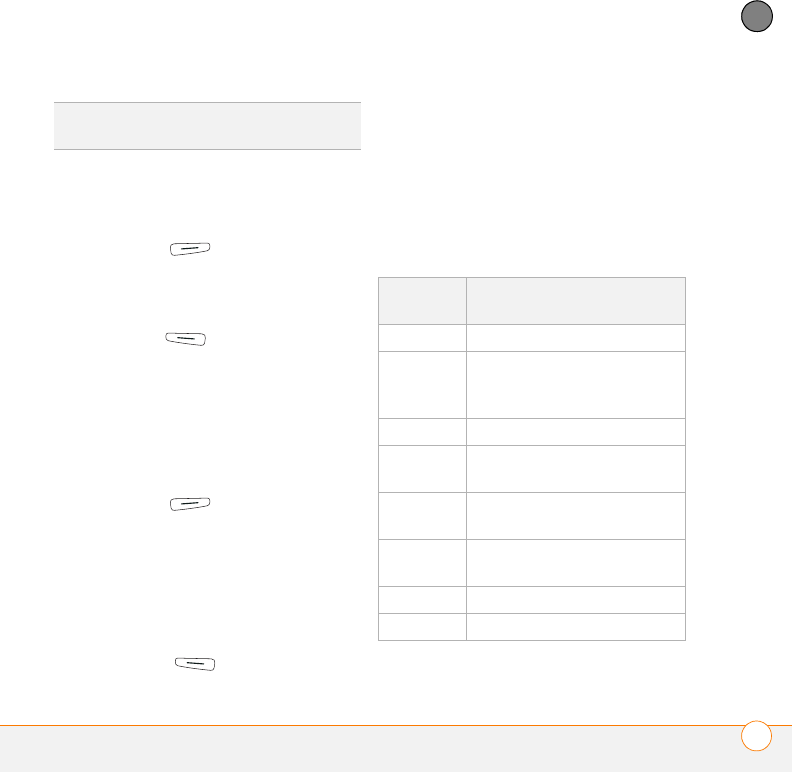
YOUR EMAIL
WORKING WITH EMAIL MESSAGES 109
6
CHAPTER
Forwarding a message
1Open the message you want to
forward.
2Press Menu (right action key)
and select Forward.
3Address the message and enter any
text you want to add.
4Press Send (left action key).
Deleting messages
You can delete a message you are reading,
or you can delete one or more messages
from the message list.
To delete a message you are reading:
•Press Menu (right action key)
and select Delete.
To delete messages from the message list:
1Highlight the message(s) you want to
delete. To highlight multiple messages,
tap and drag the stylus across the
messages in the list.
2Press Delete (left action key).
3Select Ye s to confirm the deletion.
Using email shortcuts
You can perform common email tasks by
pressing and holding certain keys on the
keyboard. Open the message you want,
and then press and hold any of the
following:
DID
YOU
KNOW
?
If you reply to a message sent as
HTML, the reply is sent in HTML also.
Press and
hold... To...
H View all email shortcuts
A Reply to the sender of a
message and all other
addressees
R Reply to the sender only
K Mark a message read or
unread
F Flag a message as high
priority
M Move a message between
folders
O Forward a message
D Delete a message
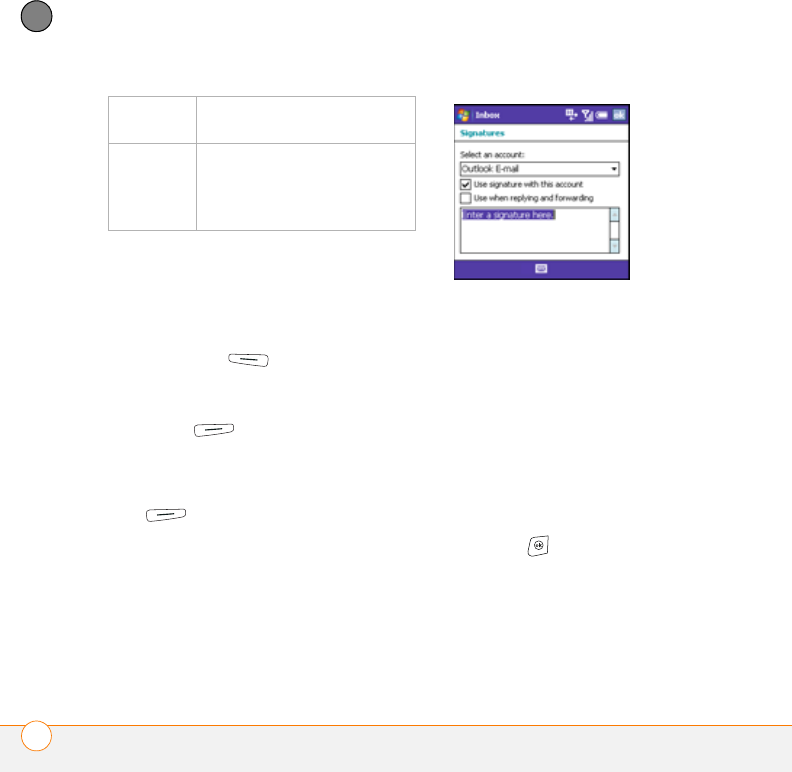
YOUR EMAIL
WORKING WITH EMAIL MESSAGES
110
6
CHAPTER
Adding a signature to your messages
You can use a different signature with each
email account.
1Go to your Today screen.
2Press E-mail (left action key).
3Do one of the following:
•If the account list is displayed, press
Menu (right action key) and
select Options.
•If the message list for a specific
account is displayed, press Menu
(right action key) and select
To o l s > Options.
4On the Accounts tab, select
Signatures.
5Select the account for which you want
to create a signature.
6Check the Use signature with this
account box to add this signature to
new messages you create with this
account.
7(Optional) Check the Use when
replying and forwarding box to add
this signature to messages you reply to
or forward with this account.
8Highlight the text “Enter a signature
here” and enter the signature text you
want to use.
9Press OK .
Customizing your email settings
When you customize settings for an email
account, the options you choose apply to
that account only.
L Fully download a partially
downloaded message
S Synchronize your
smartphone with the server
to get and send new
messages
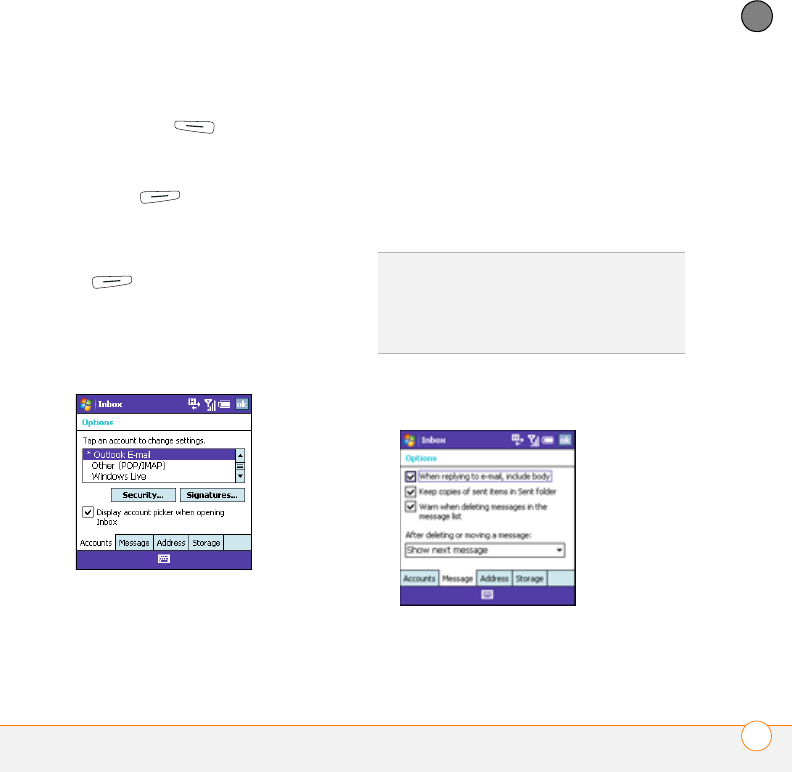
YOUR EMAIL
WORKING WITH EMAIL MESSAGES 111
6
CHAPTER
1Go to your Today screen.
2Press E-mail (left action key).
3Do one of the following:
•If the account list is displayed, press
Menu (right action key) and
select Options.
•If the message list for a specific
account is displayed, press Menu
(right action key) and select
To o l s > Options.
4On the Accounts tab, highlight the
account you want and set any of the
following options:
Security: Allows you to specify
whether you receive a warning
message before you open a URL or file
link that is not on your smartphone.
Display account picker when opening
Inbox: Specifies whether a list of your
email accounts appears when you open
the Inbox application, allowing you to
select the one you want to use. If the
box is unchecked, the Inbox application
opens to the last account you used.
5Select the Message tab and set any of
the following options:
TIP
If the Display account picker when
opening Inbox box is unchecked, repeatedly
press Left on the 5-way after you open the
Inbox application to cycle through your
accounts.
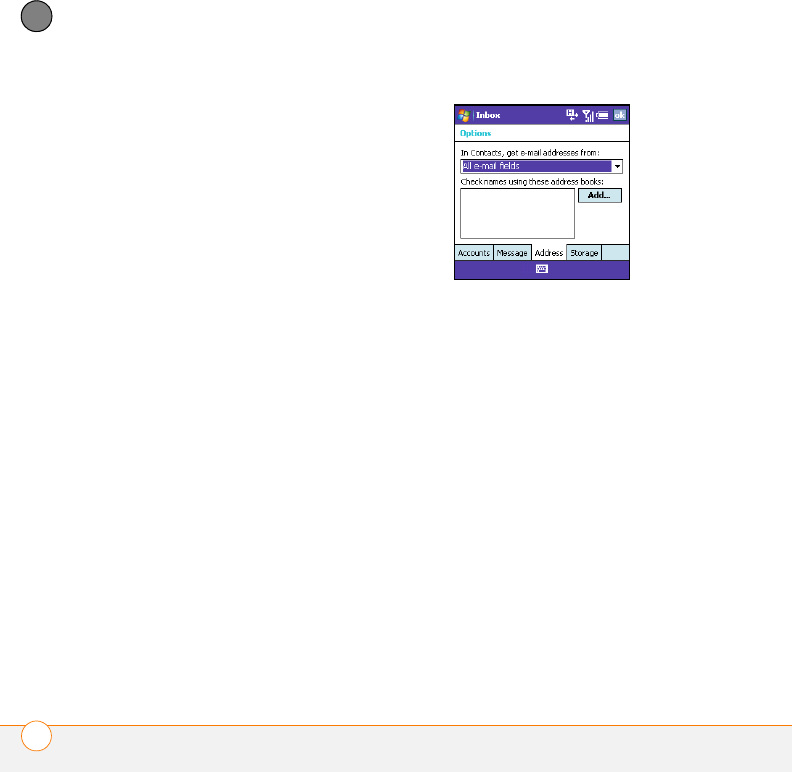
YOUR EMAIL
WORKING WITH EMAIL MESSAGES
112
6
CHAPTER
When replying to e-mail, include
body: Indicates whether the body of a
message you received appears in your
response to that message.
Keep copies of sent items in Sent
folder: Indicates whether messages
you send are stored in the Sent folder.
Warn when deleting messages in the
message list: Specifies whether a
confirmation message appears when
you delete one or more messages from
the message list.
After deleting or moving a message:
Specifies what you want to see after
you delete or move an email message
you are reading: the account Inbox or
the next message.
6Select the Address tab and set any of
the following options:
In Contacts, get e-mail addresses
from: Indicates whether you want to
check Contacts in addition to any
directory services for email addresses.
Check names using these address
books: Indicates which directory
services you want to check for email
addresses.
Add: Enables you to add directory
services to the list of online address
books.
7Select the Storage tab and set any of
the following options:
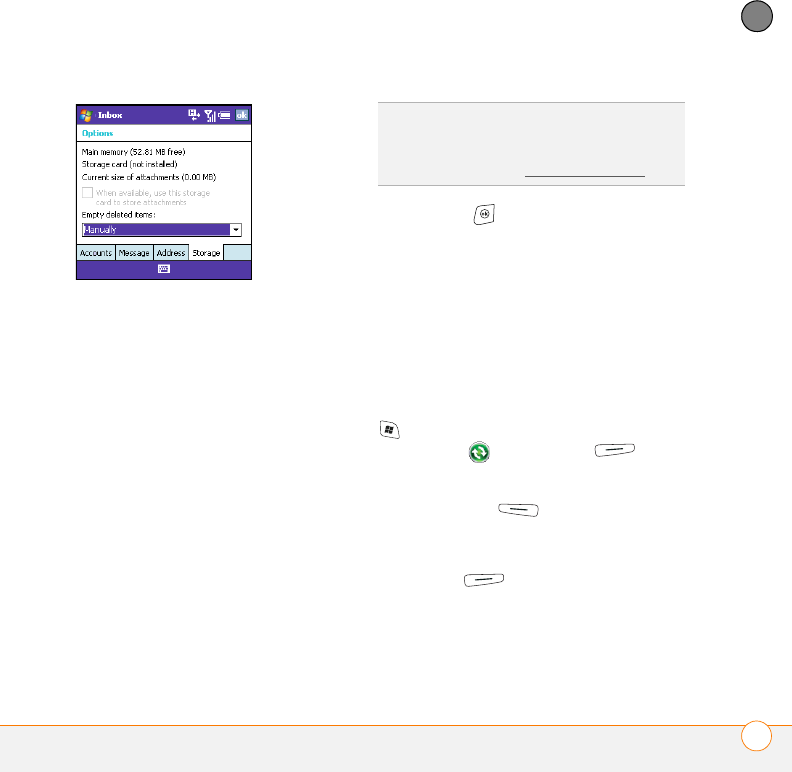
YOUR EMAIL
WORKING WITH EMAIL MESSAGES 113
6
CHAPTER
When available, use this storage card
to store attachments: Indicates
whether you want to automatically
store email attachments on an
expansion card. You must have a card
inserted in your smartphone’s
expansion card slot to select this option.
Empty deleted items: Select
Immediately to have the Deleted folder
emptied anytime you delete a message.
Select On connect/disconnect to have
the folder deleted anytime you open or
quit the Inbox application. Select
Manually to manually empty the
Deleted folder.
8Press OK .
Changing email download settings
You can customize the download options
for each email account that you have with
an Internet service provider (ISP) or that
you access using a VPN server connection
(typically a work account).
NOTE To change options for a Microsoft
Office Outlook E-mail account, press Start
, select Programs, and then select
ActiveSync . Press Menu (right
action key) and select Options.
1Press E-mail (left action key).
2Do one of the following:
•If the account list is displayed, press
Menu (right action key) and
select Options.
•If the message list for a specific
account is displayed, press Menu
TIP
If you choose to manually empty the
Deleted folder, you delete messages from this
folder in the same way that you delete any
other messages (see.Deleting messages).
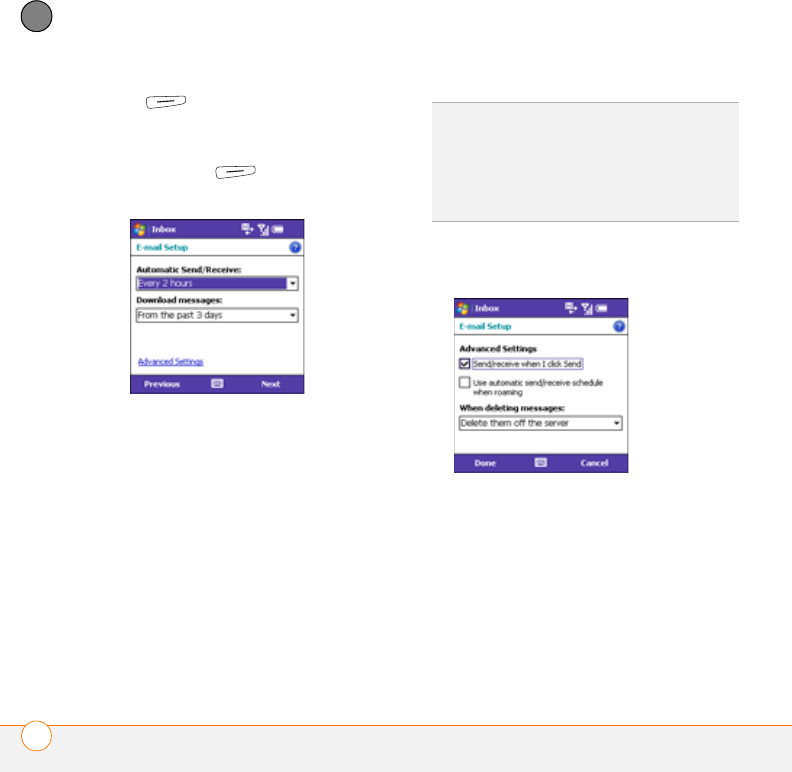
YOUR EMAIL
WORKING WITH EMAIL MESSAGES
114
6
CHAPTER
(right action key) and select
To o l s > Options.
3Select the email account you want.
4Press Next (right action key) until
the following screen is displayed.
5Select either of the following:
Automatic Send/Receive: Specifies
the time interval for automatically
downloading email, from every 5
minutes to once a day. If you do not
want to automatically download
messages, select Manually.
Download messages: Specifies the
number of days’ worth of email to be
retrieved for each automatic or manual
retrieval.
6Select Advanced Settings, and then
select any of the following:
Send/receive when I click Send:
Specifies whether you can manually
send and receive messages, in addition
to automatically downloading them.
Use automatic send/receive schedule
when roaming: Specifies whether
automatic downloading takes place
when you are roaming. This may result
TIP
To save memory, limit the number of
emails that are downloaded to your
smartphone by selecting a larger time interval
for automatically downloading messages or a
smaller time interval for how many days’
worth of messages are downloaded.
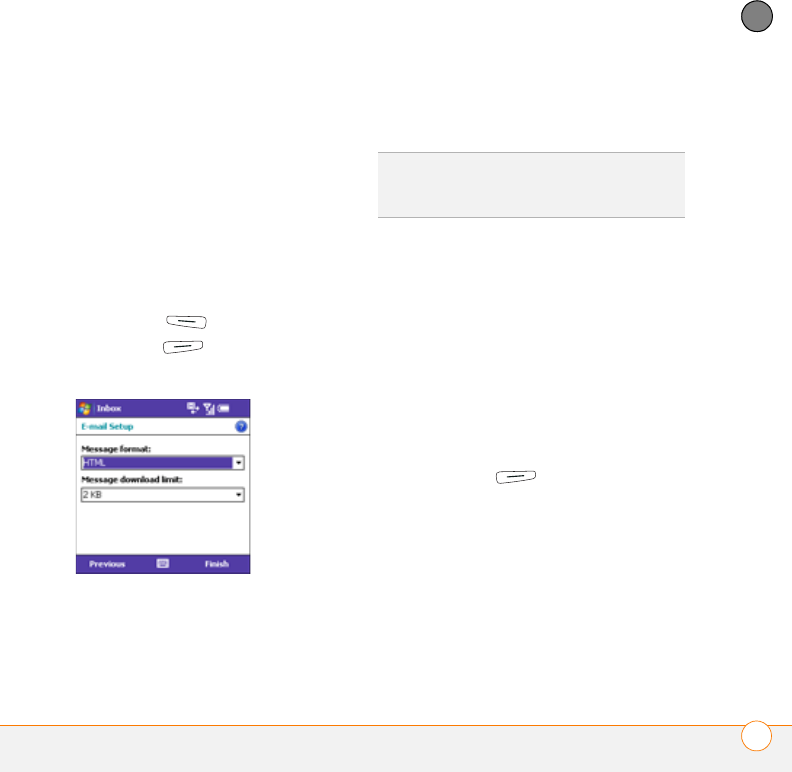
YOUR EMAIL
WORKING WITH EMAIL MESSAGES 115
6
CHAPTER
in higher connection charges than
downloading while in your home
network.
When deleting messages: Specifies
whether messages should be deleted
from the mail server when you delete
them on your smartphone, or whether
messages you delete on your
smartphone should remain on the
server.
7Press Done (left action key).
8Press Next (right action key).
9Select either of the following:
Message format: Select the format for
sending and receiving messages. If you
select HTML, messages sent to you as
HTML are received with their formatting
intact. If you select Plain Text, all
messages are received as plain text.
Message download limit: Select the
size of an incoming message that is
automatically downloaded. For any
message that exceeds this size, you
must manually download the rest of the
message. Selecting a higher limit
means more of your messages will be
fully downloaded, but message retrieval
might take longer. You can also choose
to download message headers only,
regardless of size.
10 Press Finish (right action key).
DID
YOU
KNOW
?
Messages sent to you as plain
text are always received as plain text, even if
you select HTML.
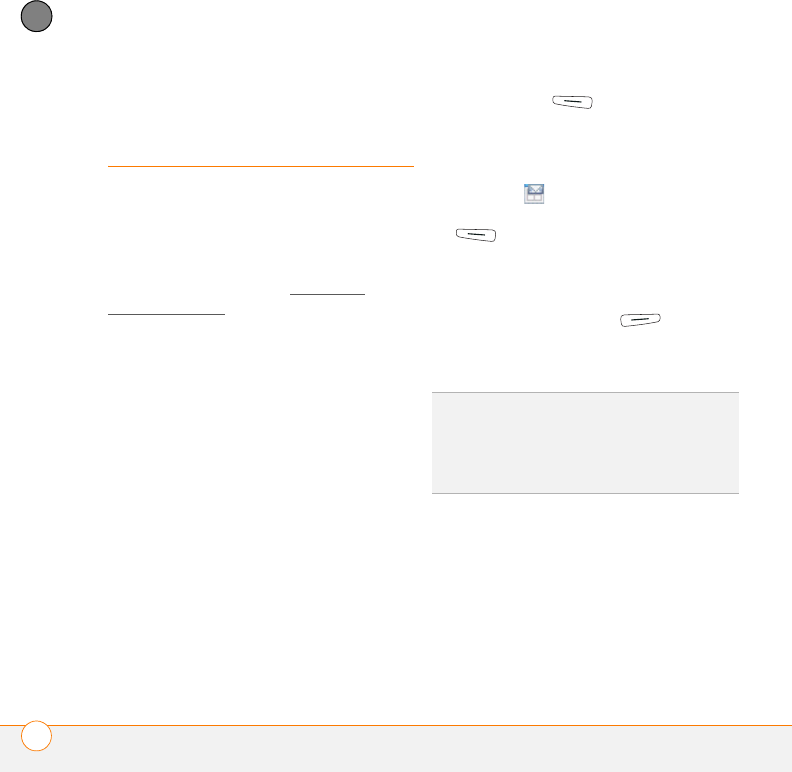
YOUR EMAIL
WORKING WITH MEETING INVITATIONS
116
6
CHAPTER
Working with
meeting invitations
You can receive meeting invitations on your
smartphone in the same way that you
receive email messages.
NOTE You can create meeting invitations
on your smartphone; see Sending a
meeting request.
Here are the key features of meeting
invitations:
•Meeting invitations appear on your
smartphone in the Inbox application, not
in the Calendar application.
•From within the Inbox application, you
can accept, decline, or tentatively
accept a meeting invitation.
•If you accept an invitation, the meeting
shows up as an appointment in the
Calendar application.
•You can reply to and forward meeting
invitations in the same way as email
messages.
1Press E-mail (left action key).
2Select the account you want.
3Select a meeting invitation to open it.
Meeting invitations are displayed with
this icon: .
4To accept the invitation, press Accept
(left action key), select whether
to edit (include comments with) your
response, and then select OK.
To decline or tentatively accept the
invitation, press Menu (right
action key) and select Decline or
Te n t a t i v e .
TIP
If you receive an updated meeting
invitation, you can again choose to accept,
decline, or tentatively accept. If you receive a
meeting cancellation, you don’t need to do
anything.

YOUR EMAIL
SENDING EMAIL MESSAGES FROM WITHIN ANOTHER APPLICATION 117
6
CHAPTER
Sending email
messages from
within another
application
You can send files such as pictures, videos,
and ringtones as attachments to email
messages (see Creating and sending an
email message).
You can send certain files as attachments
from within the application where the file is
created or stored. For example, if you take
a picture with the built-in camera on your
smartphone, you can select an option to
send the picture as an attachment to an
email message. You can also use this
feature with videos and sound files. For
details, see the chapter on the specific
application.

YOUR EMAIL
SENDING EMAIL MESSAGES FROM WITHIN ANOTHER APPLICATION
118
6
CHAPTER

CHAPTER
7
Your text and multimedia
messages
If you need to get a short message to a friend or a coworker
fast, send a text message from your Palm® Treo™800W
smartphone to their mobile phone or email address.
If you need more than text to express yourself, use multimedia
messaging to give your message extra impact by adding a
photo, video, or sound file.
Benefits
•Enjoy quick communication
•Use text messaging to chat with
friends
•Be as simple or as creative as you
want

In this chapter
Using the Messaging application . . . . . . . . . . . . . . . . . . . . . . . . . . . 121
Customizing the Messaging application. . . . . . . . . . . . . . . . . . . . . . 130
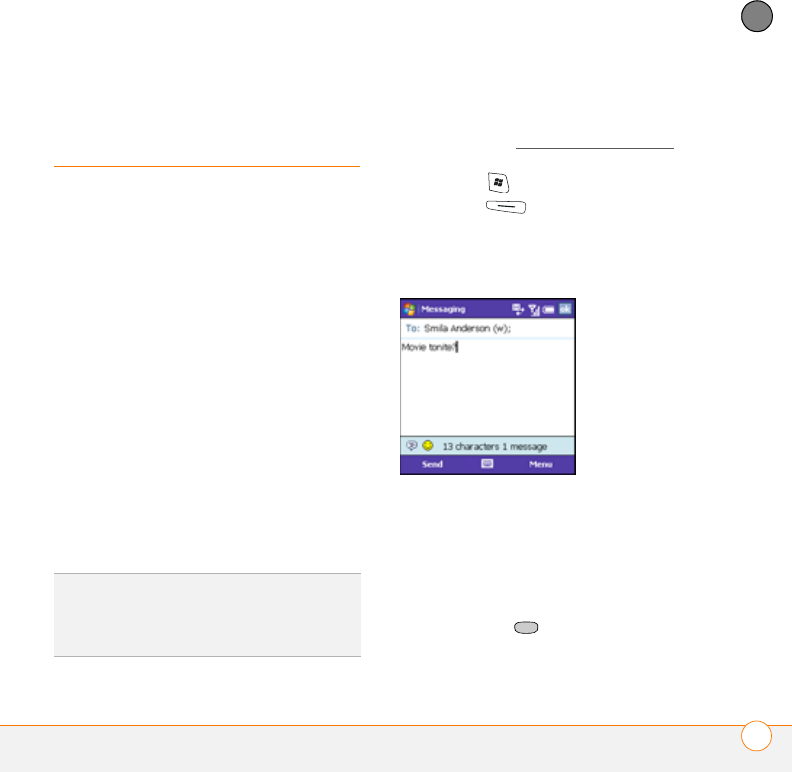
YOUR TEXT AND MULTIMEDIA MESSAGES
USING THE MESSAGING APPLICATION 121
7
CHAPTER
Using the Messaging
application
You can use the Messaging application to
send and receive brief text messages
(SMS) and multimedia messages (MMS).
Before you use your smartphone to send or
receive messages, consult your wireless
service provider for pricing and availability
of text and multimedia messaging
services.
Creating and sending a text message
Each text message can have up to 160
characters. You can send a message of
more than 160 characters, but the
message will automatically be split into
several messages. If you send a text
message to an email address, the email
address is deducted from the
160-character count.
BEFORE YOU BEGIN Make sure that your
phone is on and that you’re inside a
coverage area (see Turning your phone on).
1Press Start and select Messaging.
2Press New (left action key).
3Enter the recipient’s name, mobile
phone number, or email address. Here
are some shortcuts:
•If the recipient’s name and mobile
number are in your Contacts list, type
the first few letters of the first or last
name or simply enter the first initial,
followed by a space, and then the last
initial to find a name.
•Press Center to view a list of
recently used addresses, and select
the recipient from the list. Select Add
DID
YOU
KNOW
?
You can send and receive text
messages even while you are on a phone call.
This is easiest when using a hands-free
headset or the speakerphone.
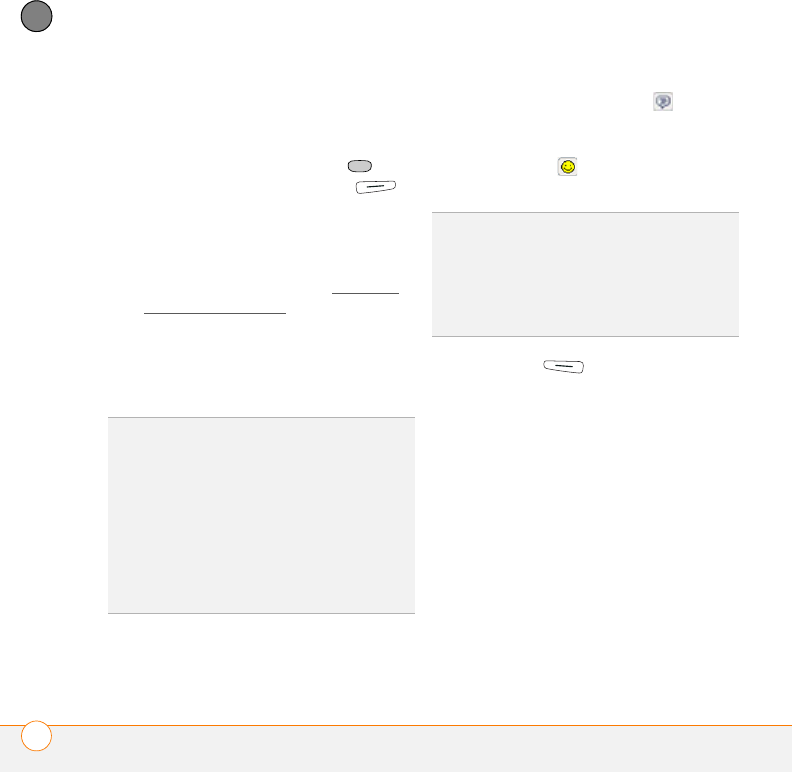
YOUR TEXT AND MULTIMEDIA MESSAGES
USING THE MESSAGING APPLICATION
122
7
CHAPTER
Recipient to add a recipient from your
Contacts list.
•If the recipient’s name is in an online
address book, press Center ,
enter the name, press Menu
(right action key), and then select
Company Directory. Select the
name, and then select either the
phone number or the email address.
For more information, see Using an
online address book.
•If the recipient’s name and mobile
number are not in your Contacts list,
enter the full mobile number or email
address.
4Enter your message, or tap and
then select a predefined phrase you
want to insert.
5(Optional) Tap and then select an
emoticon to add to your message.
6Press Send (left action key).
Creating and sending a multimedia
message
Multimedia messages consist of pictures,
videos, text, and sounds presented as one
or more slides. You can include any of the
following items:
Ringtones
•MIDI
Sound clips
•AMR
•QCELP
TIP
To address a message to multiple
recipients, separate the addresses by
pressing Enter or entering a semicolon (;). You
can send a message to up to 20 addresses.
TIP
To send a message to a different number
for a contact, select the contact in the To field,
and then edit the number that appears in the
box directly below the contact number. You
can also select a number by pressing Center
on the 5-way, and then edit it.
TIP
You can also access predefined phrases
and emoticons by pressing Menu (right action
key) on the message compose screen.
TIP
Some symbols can’t be used in text
messages. Invalid characters are automatically
replaced by the Messaging application.
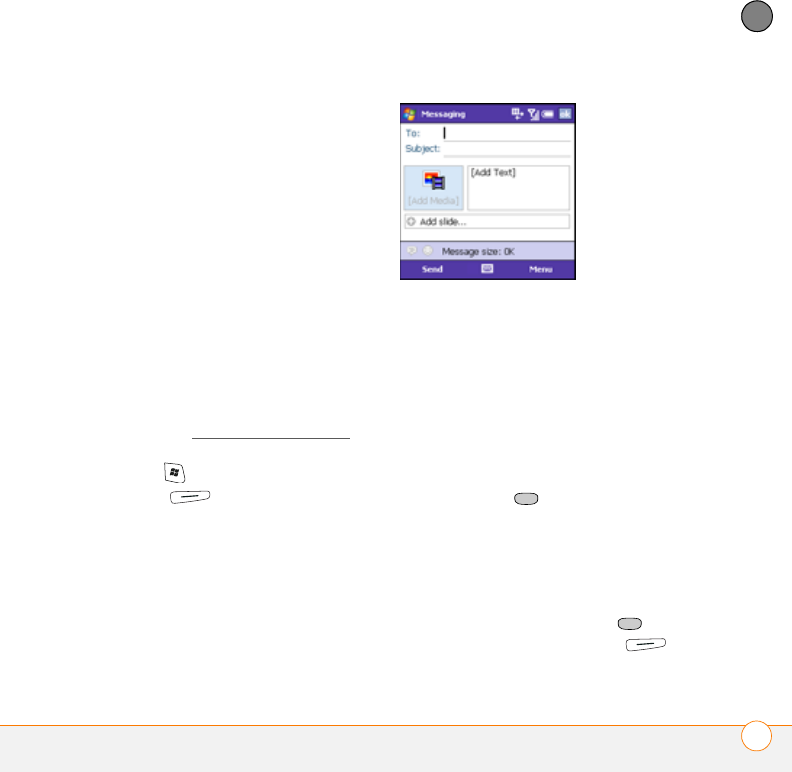
YOUR TEXT AND MULTIMEDIA MESSAGES
USING THE MESSAGING APPLICATION 123
7
CHAPTER
Pictures
•JPEG
•GIF
•WBMP
Videos
•3GPP
•3GPP2
•MPEG4
Outgoing multimedia messages can be up
to 300KB by default, but your wireless
service provider may have a different
maximum message size.
BEFORE YOU BEGIN Make sure that your
phone is on and that you’re inside a
coverage area (see Turning your phone on).
1Press Start and select Messaging.
2Press Menu (right action key)
and select New MMS.
3Enter the recipient’s mobile phone
number or email address. Here are
some shortcuts:
•If the recipient’s name and mobile
number are in your Contacts list, type
the first few letters of the first or last
name or simply enter the first initial,
followed by a space, and then the last
initial to find a name.
•Press Center to view a list of
recently used addresses, and select
the recipient from the list. Select Add
Recipient to add a recipient from your
Contacts list.
•If the recipient’s name is in an online
address book, press Center ,
enter the name, press Menu
(right action key), and then select
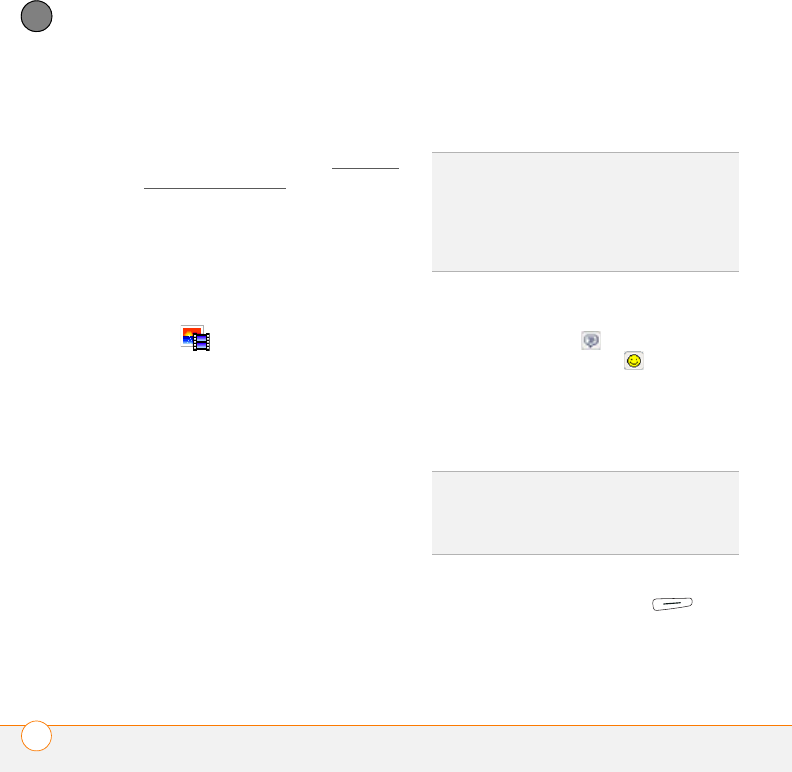
YOUR TEXT AND MULTIMEDIA MESSAGES
USING THE MESSAGING APPLICATION
124
7
CHAPTER
Company Directory. Select the
name, and then select either the
phone number or the email address.
For more information, see Using an
online address book.
•If the recipient’s name and mobile
number are not in your Contacts list,
enter the full mobile number or email
address.
4Select Subject and enter a title for the
message.
5Select and select one of the
following:
Add Picture: Enables you to insert a
picture. You can take a new picture with
the built-in camera or insert an existing
picture.
Add Video: Enables you to insert a
video. You can capture a new video with
the built-in camera or insert an existing
video.
Add Sound: Enables you to record a
message, such as a voice caption for a
picture, or insert an existing sound, such
as a ringtone. You can add one sound
per slide; to send more than one sound
in a message, add another slide to your
message.
6(Optional) Select Add Text and enter a
text caption or message for the slide
you inserted. Tap to insert a
predefined phrase. Tap to insert an
emoticon.
7(Optional) Select Add slide and repeat
steps 5 and 6 to add another slide in this
message.
8(Optional) To add a vCard (contact file)
to a message, press Menu (left
action key) and select Add Media >
Add vCard.
TIP
You can add both a picture and a sound clip
to the same slide in a message. To add a
sound to a picture, select the picture
thumbnail and select Add Sound. To add a
picture to a sound, select the sound icon, and
then select Add Picture.
DID
YOU
KNOW
?
If you add more than one slide to a
message, you can set the length of time each
slide is displayed. Press Menu (right action
key) and select Slide Timing.
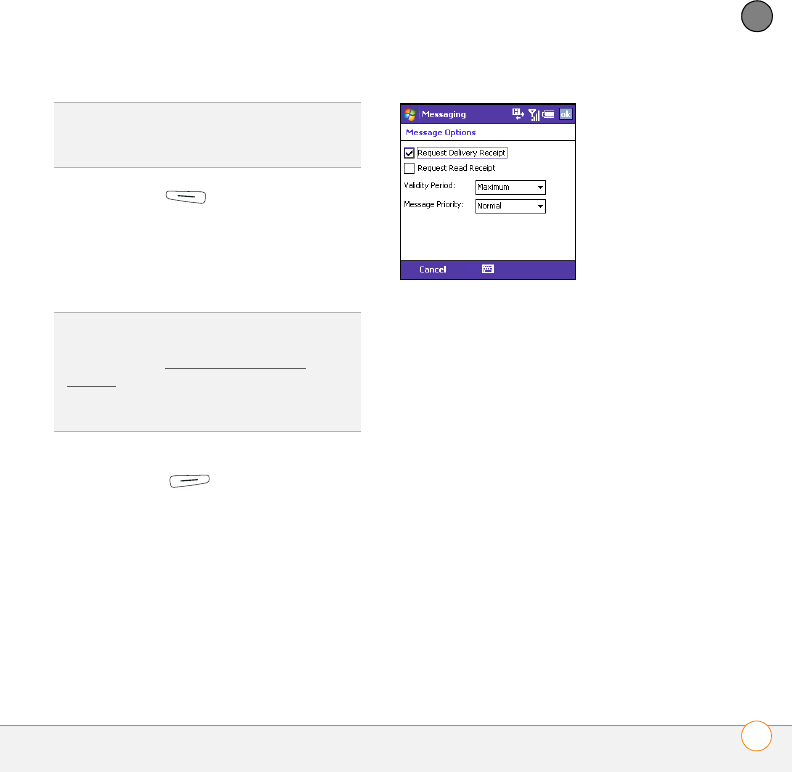
YOUR TEXT AND MULTIMEDIA MESSAGES
USING THE MESSAGING APPLICATION 125
7
CHAPTER
9Press Send (left action key).
Setting message options
You can set options for individual text and
multimedia messages you send.
1On the message compose screen,
press Menu (right action key).
2Select Message Options.
3Select any of the following options:
Request Delivery/Read Receipt
(multimedia messages only):
Indicates whether you want to receive
confirmation that the message has
been delivered or has been read.
Validity Period: Indicates how long the
message remains available to be sent if
the recipient’s phone or email address is
not available when you originally send
the message. For example, if a
message contains information that will
not be useful to the recipient after an
hour, you can set the validity for one
hour.
Message Priority (multimedia
messages only): Indicates the priority
for this message.
TIP
To preview a multimedia message as the
recipient will see it, press Menu (right action
key) and select Preview Message.
DID
YOU
KNOW
?
You can set general preferences
that apply to all incoming and outgoing
messages (see Customizing message
settings). If you set options for an individual
message, those options override your general
preferences for that message only.
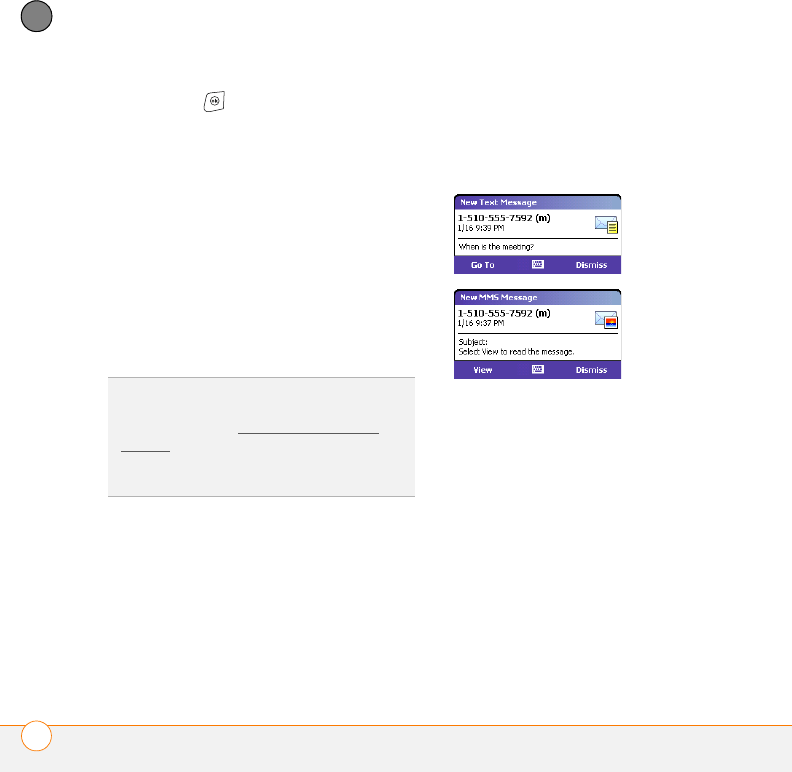
YOUR TEXT AND MULTIMEDIA MESSAGES
USING THE MESSAGING APPLICATION
126
7
CHAPTER
4Press OK .
Receiving text and multimedia messages
When your phone is on and you are in a
wireless coverage area, you automatically
receive new text messages. For
multimedia messages, you can set your
smartphone to automatically download
new messages or to notify you that
messages are ready to download. You can
also set your smartphone to notify you
when a new text or multimedia message
arrives.
The new message notification may include
any of the following options:
•Go To: Opens a text message so you
can view its full contents.
•View: Opens a multimedia message
and plays the included media.
•Download: Downloads the full content
of a multimedia message.
•Dismiss: Closes the notification and
puts the message into your Inbox.
If you have multiple messages, the
notification includes the number of
messages and the type (text or
multimedia).
Viewing/playing a message
You can open a message from a
notification or from the Inbox of the
Messaging application. When you open a
multimedia message, playback starts
automatically.
DID
YOU
KNOW
?
Message notifications include the
message text unless you have turned on
privacy mode (see Customizing message
settings). If privacy mode is on, the
notification states only the type of incoming
message.
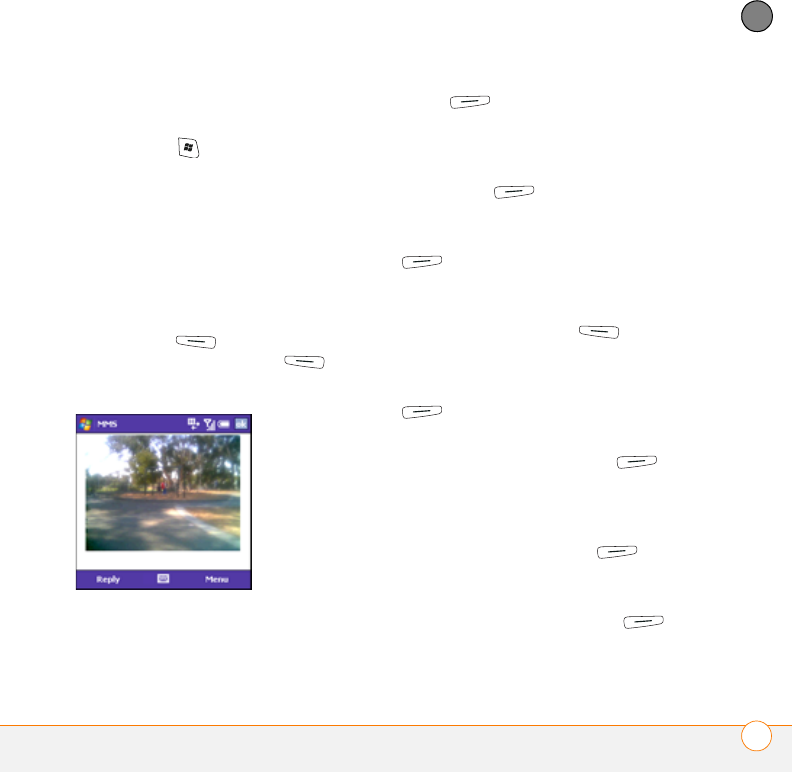
YOUR TEXT AND MULTIMEDIA MESSAGES
USING THE MESSAGING APPLICATION 127
7
CHAPTER
1Do one of the following to open the
message:
•Press Start and select
Messaging. From the Inbox, select
the message you want to view.
•From a notification, select Go To (for
text messages) or View (for
multimedia messages).
2Do any of the following:
Pause or resume playback
(multimedia message only):
Select Pause (left action key). To
resume playback, select Play (left
action key).
Save the item that is playing
(multimedia message only): Press
Menu (right action key) and
select Save.
See a summary of the message,
including sender, date, and time:
Press Menu (right action key)
and select Message Details.
Reply to the message: Press Menu
(right action key) and select
Reply or Reply All.
NOTE If the message is a single picture
with no audio, select Reply (left
action key) to reply to the message.
Forward the message: Press Menu
(right action key) and select
Forward.
Call the sender: Press Menu
(right action key) and select Call
Sender.
Add the sender’s information to your
Contacts list: Press Menu (right
action key) and select Add to Contacts.
Save the message as a template for
other messages: Press Menu
(right action key) and select Save as
Te m p l a t e .
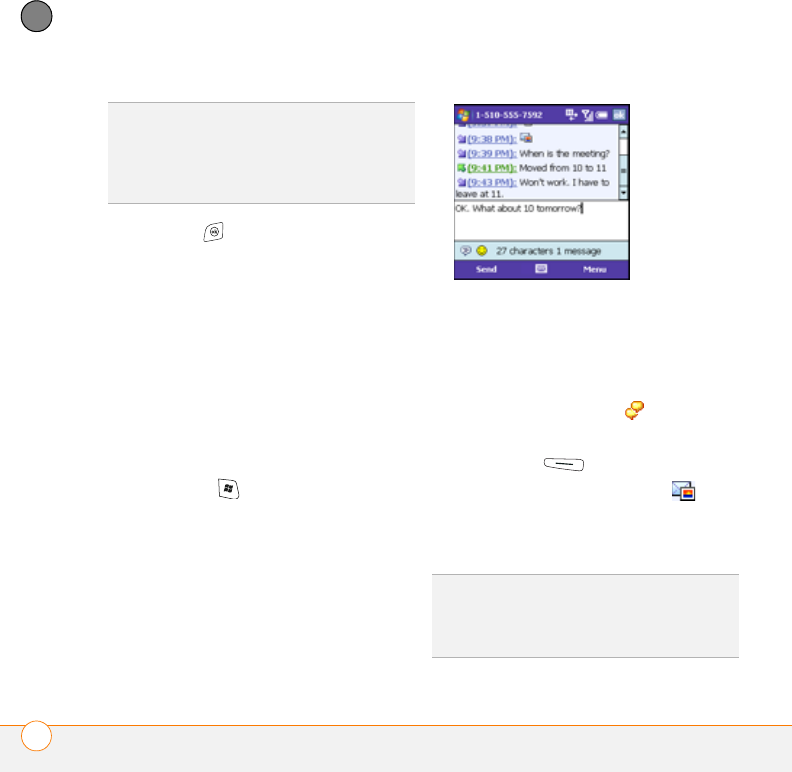
YOUR TEXT AND MULTIMEDIA MESSAGES
USING THE MESSAGING APPLICATION
128
7
CHAPTER
3Press OK .
Using Messaging to chat
When you exchange more than one
message with a single contact, the
messages you exchange with that person
are grouped into a chat session. When you
select a chat session from your message
list, the upper part of the screen displays all
messages you’ve exchanged with this
contact, and the lower part provides a text
entry area.
1Press Start and select Messaging.
2Do one of the following:
Start a new chat: Select a message
and reply to it.
Continue an existing chat: Select a
message with the chat icon.
3Enter your message.
4Press Send (left action key).
5In a received message, select to
open a media file, or click a link to
download and open a new multimedia
message.
DID
YOU
KNOW
?
When viewing a multimedia
message containing multiple slides, you can
press Right on the 5-way to move to the next
slide, or press Left on the 5-way to move to
the previous slide.
TIP
Only the last 50 messages in a chat
session are displayed. Select View older
messages near the top of the screen to see
earlier messages.

YOUR TEXT AND MULTIMEDIA MESSAGES
USING THE MESSAGING APPLICATION 129
7
CHAPTER
Using links in messages
When you receive a text message that
contains a telephone number, email
address, or URL, you can dial the number,
send an email message, or go to the web
page immediately. Your smartphone
automatically opens the appropriate
application from the link.
1Open a message in the Inbox or another
folder.
2Select the phone number, email
address, or URL (appears as underlined
blue text).
Message status icons
The status icons that appear next to each
message in the Inbox, Outbox, and Sent
folders indicate the following:
An unread text message.
An unread message with pictures or
videos.
An unread message with sound.
A read text message.
A read message with pictures or
videos.
A read message with sound.
A message that was sent with
delivery confirmation turned on
(Sent folder only).
Multiple messages exchanged with
a single recipient (chat).
An urgent message. This icon
appears below the message size on
the right side of the screen.
TIP
Unread messages appear in bold.
Messages you’ve read appear in plain text.
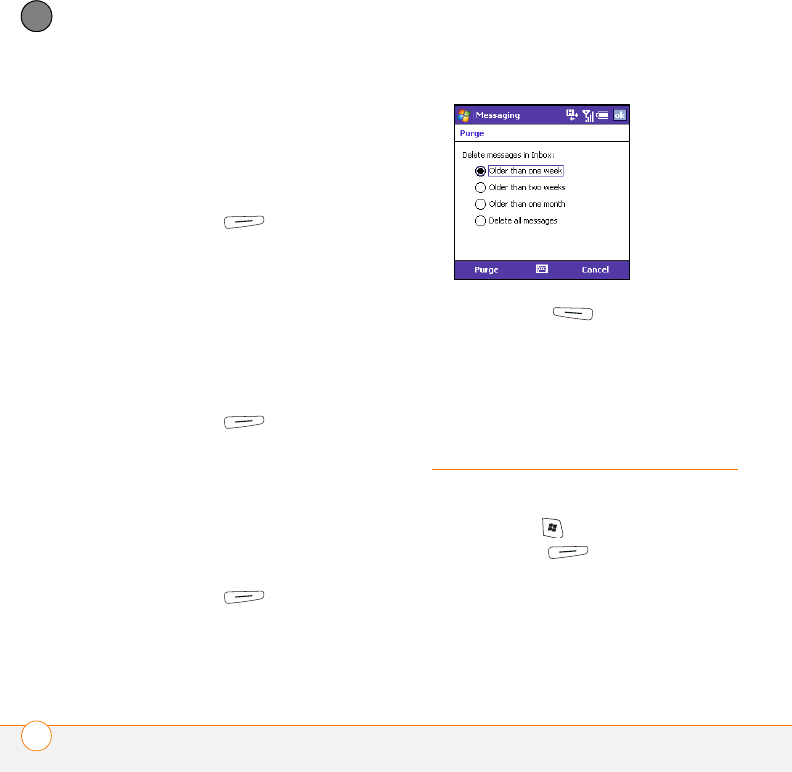
YOUR TEXT AND MULTIMEDIA MESSAGES
CUSTOMIZING THE MESSAGING APPLICATION
130
7
CHAPTER
Sorting your messages
You can sort the messages in any folder by
date or by sender.
1Go to the Inbox or other folder you want
to sort.
2Press Menu (right action key)
and select Sort.
3Select By Date or By Name.
Deleting a single message
1Go to the Inbox or other folder
containing the message you want to
delete.
2Highlight the message.
3Press Menu (right action key)
and select Delete.
4Select Ye s to confirm the deletion.
Deleting multiple messages
1Go to the Inbox or other folder
containing the messages you want to
delete.
2Press Menu (right action key)
and select Purge.
3Select the age of messages to be
deleted, or select Delete all messages.
4Select Purge (left action key).
Customizing the
Messaging
application
Customizing message settings
1Press Start and select Messaging.
2Press Menu (right action key)
and select Options.
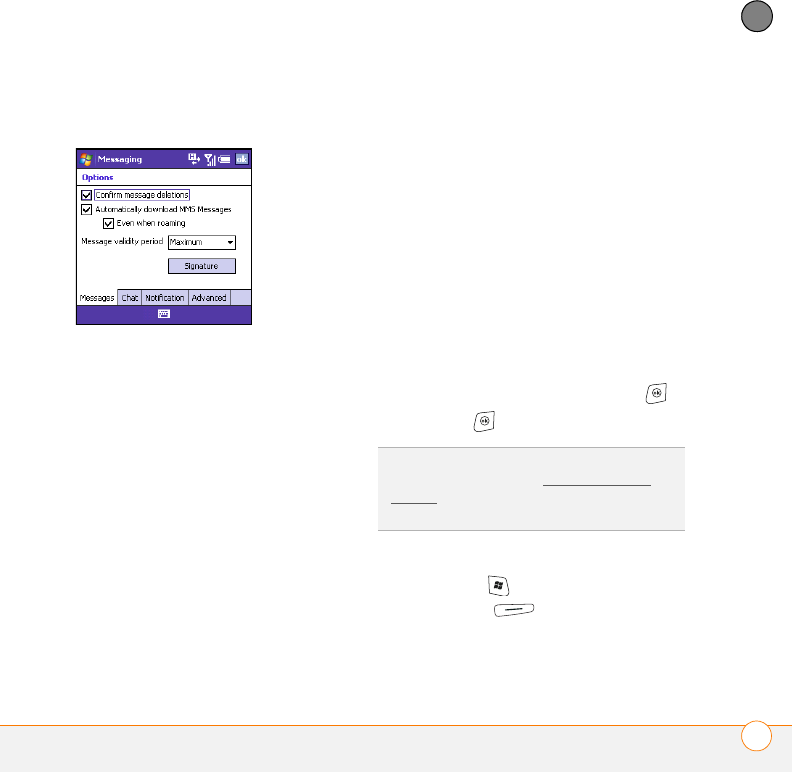
YOUR TEXT AND MULTIMEDIA MESSAGES
CUSTOMIZING THE MESSAGING APPLICATION 131
7
CHAPTER
3On the Messages tab, set any of the
following options:
Confirm message deletions: Indicates
whether you want deletion confirmation
messages to appear.
Automatically download MMS
messages: Indicates whether you want
to automatically receive multimedia
messages. Check the Even when
roaming box to download multimedia
messages both on your home network
and while roaming.
NOTE You might incur additional charges if
you download multimedia messages while
roaming.
Message validity period: Indicates
how long messages remain available to
be sent if the recipient’s phone or email
address is not available when you
originally send the message. For
example, if your messages generally
contain information that will not be
useful to recipients after an hour, you
can set the validity for one hour.
Signature: Enables you to add a
signature to outgoing messages. Select
the button; then, on the Signature
screen, check the Use signature with
new messages box, enter your
signature text, and then press OK .
4Press OK .
Customizing chat settings
1Press Start and select Messaging.
2Press Menu (right action key)
and select Options.
DID
YOU
KNOW
?
Options you select for an
individual message (see Setting message
options) override the general preferences you
set for all messages.
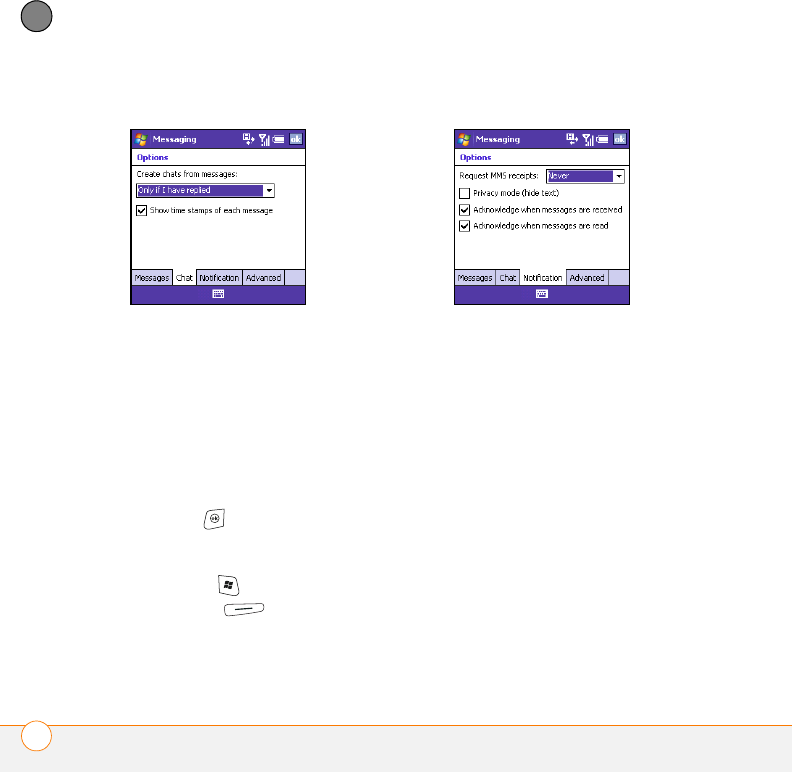
YOUR TEXT AND MULTIMEDIA MESSAGES
CUSTOMIZING THE MESSAGING APPLICATION
132
7
CHAPTER
3Select the Chat tab.
4Select any of the following options:
Create chat from messages: Indicates
the conditions under which a chat
session starts.
Show time stamps of each message:
Indicates whether you want chat
session items to display a date and time
indicator.
5Press OK .
Customizing notification settings
1Press Start and select Messaging.
2Press Menu (right action key)
and select Options.
3Select the Notification tab.
4Select any of the following options:
Request MMS receipts: Indicates
whether you want to receive a
confirmation when a multimedia
message is delivered or when it is read.
Privacy mode (hide text): Indicates
whether you want only the message
type displayed on a notification for a
single incoming message. If the box is
unchecked, the notification displays the
text of the message.
Acknowledge when messages are
received/read (multimedia messages
only): Indicates whether you want a
confirmation sent to the sender when
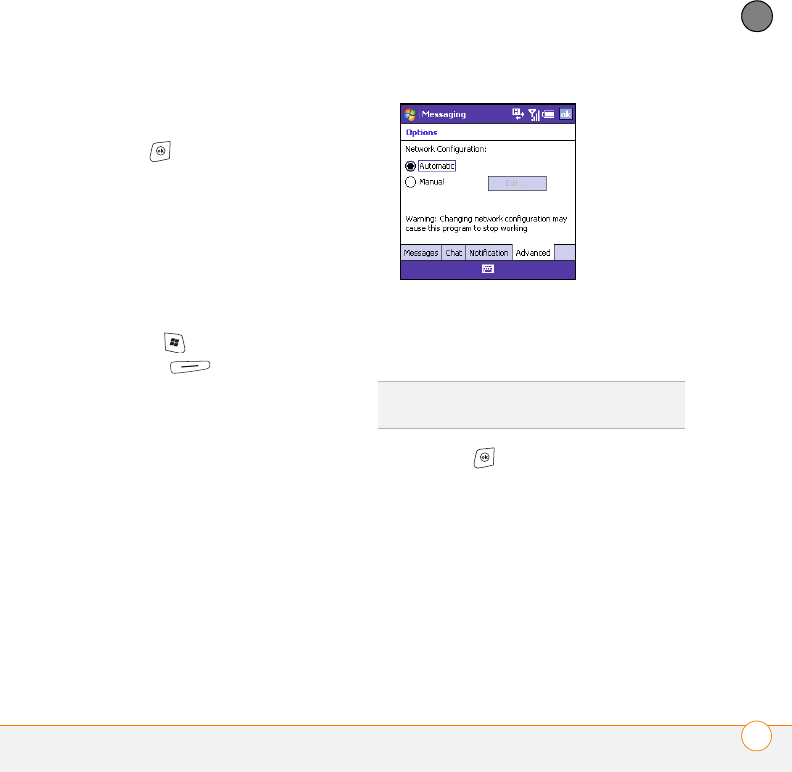
YOUR TEXT AND MULTIMEDIA MESSAGES
CUSTOMIZING THE MESSAGING APPLICATION 133
7
CHAPTER
you receive or read a multimedia
message.
5Press OK .
Customizing network settings
IMPORTANT Changing the network
settings can cause the Messaging
application to stop working correctly. We
recommend that you keep the default
network settings.
1Press Start and select Messaging.
2Press Menu (right action key)
and select Options.
3Select the Advanced tab.
4Select Manual, and then select Edit.
5Edit the network settings you want to
change.
6Press OK twice.
TIP
Select Automatic on the Advanced tab to
restore the default settings.

YOUR TEXT AND MULTIMEDIA MESSAGES
CUSTOMIZING THE MESSAGING APPLICATION
134
7
CHAPTER

CHAPTER
8
Your connections to the web
and wireless devices
You use the web for so many things: finding driving directions,
getting news, buying gifts, checking web-based email. Now, with
your wireless service provider’s network and your smartphone’s
built-in web browser, you can take the web with you almost
anywhere you go.
The built-in Bluetooth
®
wireless technology on your Palm
®
Treo
™
800
W
smartphone helps you easily set up wireless
connections to a number of devices, so you can enjoy the
convenience of cable-free connectivity. You can also use your
smartphone to connect your computer to the Internet and to
share contacts or your favorite photos with other people.
Benefits
•Carry the web with you
•Store web pages for offline
viewing
•Connect to Bluetooth headsets
and car kits
•Connect your computer to the
Internet through your smartphone

In this chapter
Browsing the web . . . . . . . . . . . . . . . . . . . . . . . . . . . . . . . . . . . . . . 137
Connecting to devices with Bluetooth® wireless technology. . . . . . 143
Using your device as a wireless modem . . . . . . . . . . . . . . . . . . . . . 147

YOUR CONNECTIONS TO THE WEB AND WIRELESS DEVICES
BROWSING THE WEB 137
8
CHAPTER
Browsing the web
Internet Explorer Mobile provides quick and
easy access to web pages. You can view
most sites on your smartphone that you
can view on your computer, including those
with security and advanced features, such
as JavaScript and frames.
Internet Explorer Mobile supports
JavaScript, Secure Sockets Layer (SSL),
and cookies, but does not support plug-ins
(Flash, Shockwave, VBScript, WML script,
and so on) or Java applets.
BEFORE YOU BEGIN Do the following:
•Be sure to subscribe to data services
from your wireless service provider.
This is necessary for browsing the web.
•Make sure your phone is on and that
you’re inside a coverage area (see
Turning your phone on).
Viewing a web page
By default, Internet Explorer Mobile scales
web page content to fit your smartphone
screen so that you can view most of the
information without scrolling left or right.
1Press Start and select Internet
Explorer.
2Highlight the address line, enter the
address of the web page you want to
view, and then press Center . To
return to a recently viewed page, select
the address line list, and then select the
web address.
DID
YOU
KNOW
?
The Security certificates and
128-bit SSL strong encryption enable you to
browse secure sites, such as online shopping,
banking, and email. Remember, some secure
sites also require a specific browser and may
not work with Internet Explorer Mobile. Ask
the organization for an alternate access point
that is compatible with Internet Explorer
Mobile.
DID
YOU
KNOW
?
You can also start a web search
from your Today screen by selecting the Web
search field, entering the item you want to
find, and then pressing Center on the 5-way.
DID
YOU
KNOW
?
If you browse to a secure web
page, the lock icon in the address line appears
closed instead of open.
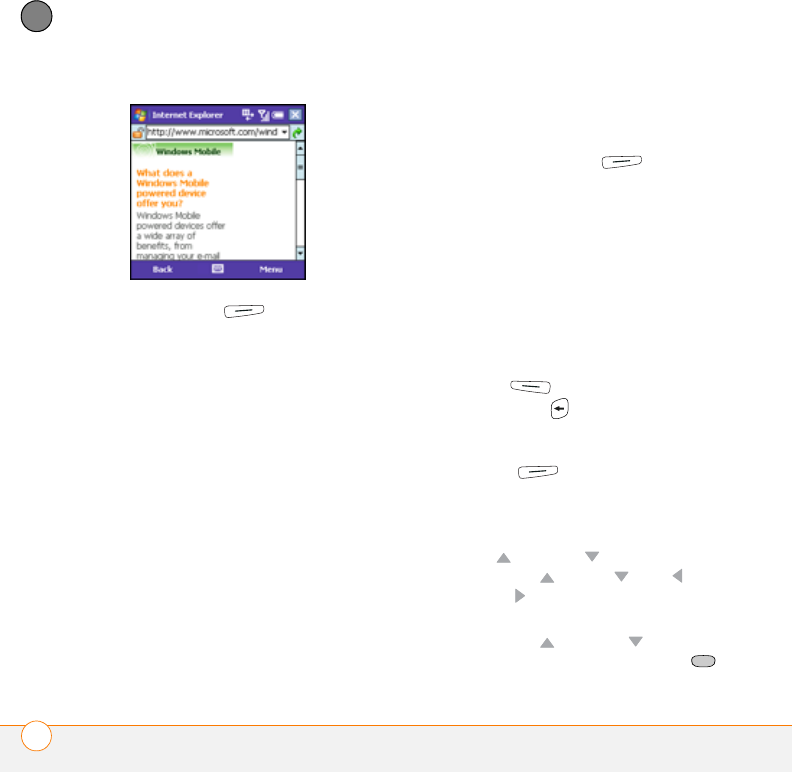
YOUR CONNECTIONS TO THE WEB AND WIRELESS DEVICES
BROWSING THE WEB
138
8
CHAPTER
3Press Menu (right action key),
select View, and then select one of the
following:
One Column: Arranges web pages into
one column that is as wide as the
screen, so that you don’t have to scroll
horizontally.
Fit To Screen: Maintains a layout similar
to what you see on a desktop computer,
but it makes items smaller and arranges
the content so that you can see most of
it without scrolling horizontally.
Desktop: Keeps the same layout and
size as on a desktop computer, which
requires both horizontal and vertical
scrolling.
Full Screen: Hides the status and
navigation areas and fills the entire
screen with the web page. To exit full
screen mode, press (right action
key), or tap and hold anywhere on the
screen and uncheck Full Screen.
Show Pictures: Shows or hides
pictures on web pages. Hiding pictures
speeds up the time it takes to load
pages.
4Here are some tips on viewing web
pages and moving around in them:
•To view the previous page, press
Back (left action key) or
Backspace .
•To refresh the page with the latest
content from the Internet, press
Menu (right action key) and
select Refresh.
•To scroll through the page in One
Column View or Default View, press
Up or Down . In Desktop View,
press Up , Down , Left , or
Right to scroll in all directions.
•To follow a link to another web page
press Up or Down to highlight
the link, and then press Center to

YOUR CONNECTIONS TO THE WEB AND WIRELESS DEVICES
BROWSING THE WEB 139
8
CHAPTER
go to the selected page. You can also
tap the link on the screen with the
stylus.
•To send email from a web page,
select the address link. You need to
configure an email application on your
smartphone before you can use this
feature (see Your email).
•To adjust the size of the text on web
pages, press Menu (right
action key), select View > Text Size,
and then select the size you want.
•To view a web page’s properties,
press Menu (right action key)
and select Tools > Properties.
•To view each item in a list, select the
list and scroll using Up or
Down .
•In a list, press Left or Right to
cycle between items, and then press
Center to accept the change.
•In a form, such as a browser search
field, press Center to interact
with the form, and then press Center
to stop interacting with the form.
5Press OK to close Internet Explorer
Mobile.
Creating a favorite
Favorites let you bookmark a web page so
that you can instantly access it without
entering the web address.
BEFORE YOU BEGIN Create the folders
where you want to store your favorites
first. After you create a favorite, you can’t
move it to another folder (see Organizing
your favorites).
1Go to the page you want to mark as
a favorite.
2Press Menu (right action key)
and select Add to Favorites.
TIP
To send a link, press Menu (right action
key) and select To o l s > Send Link. Select the
option you want to use to send the link: SMS,
MMS, or an email account.
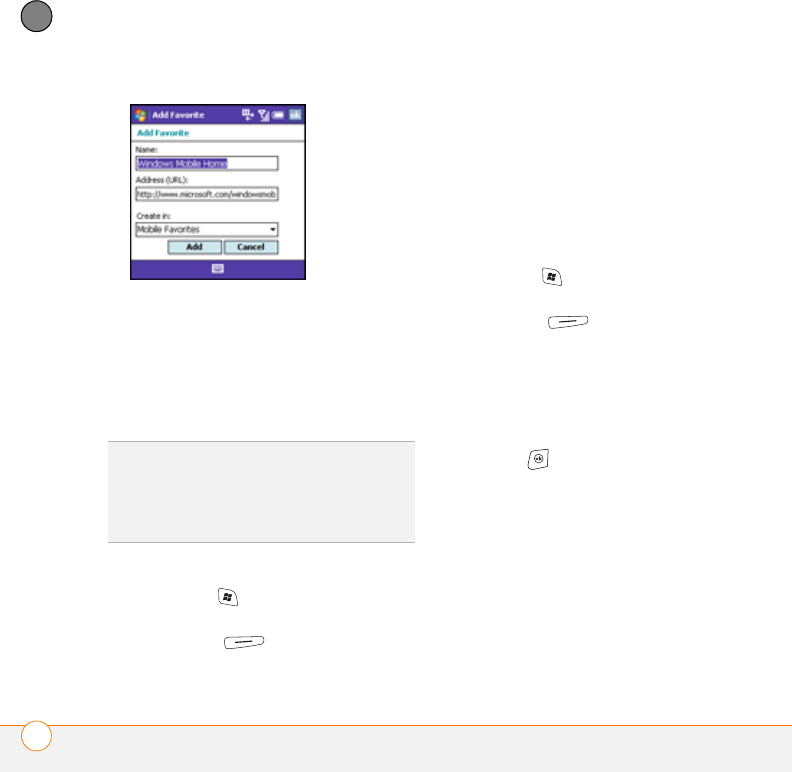
YOUR CONNECTIONS TO THE WEB AND WIRELESS DEVICES
BROWSING THE WEB
140
8
CHAPTER
3(Optional) Select Name and enter a
different description.
4(Optional) Select Create in, and then
select the folder where you want to
create the favorite.
5Select Add.
Viewing a favorite
1Press Start and select Internet
Explorer.
2Press Menu (right action key)
and select Favorites.
3Select the page you want to view in the
list.
Organizing your favorites
You can create folders to organize your
favorites. For example, you can store travel
links in one folder, stock links in another,
and business links in a third folder.
1Press Start and select Internet
Explorer.
2Press Menu (right action key)
and select Favorites.
3Select the Add/Delete tab.
4Select New Folder.
5Enter a name for this folder, and then
select Add.
6Press OK .
Downloading files and images from a web
page
You can download files that are usable on
your smartphone, such as new
applications, MIDI ringtones, or pictures.
TIP
To delete a favorite or folder, press Menu
and select Favorites. Select the Add/Delete
tab, highlight the item you want to delete, and
then select Delete. Select Ye s to confirm
deletion and press OK.

YOUR CONNECTIONS TO THE WEB AND WIRELESS DEVICES
BROWSING THE WEB 141
8
CHAPTER
1Go to the page that contains the link to
the file you want to download.
2To download a file, press Left or
Right to highlight the link to the file.
Press and hold Center , and then
select Save As. To download an image,
tap and hold on the image, select Save
Image, and then select Save As.
3Select Name and enter a new name for
the file.
4Select the Folder list, and then select
the folder where you want to save the
file.
5Select the Location list, and then select
where you want to store the file: Main
memory or Storage card.
6Press OK .
Copying text from a web page
You can copy text from a web page and
paste it in other applications.
1Use the stylus to highlight the text you
want to copy.
2Press Menu (right action key)
and select Edit > Copy.
3Go to the application in which you want
to paste, and then position the cursor
where you want to paste the text.
4Press Menu (right action key)
and select Edit > Paste.
Returning to recently viewed pages
The History list stores the addresses of the
pages you visited recently.
1Press Menu (right action key)
and select History.
DID
YOU
KNOW
?
You can select the (Downloads)
favorite to access your wireless service
provider’s downloads page.
TIP
You can copy the text from the entire web
page. Tap and hold on the page, and then tap
Select All Text. Tap and hold on the page
again, and then tap Copy.
TIP
If Internet Explorer Mobile does not
recognize a phone number as dialable, you
can copy the phone number (as text) and
paste it into the phone Dial Pad.
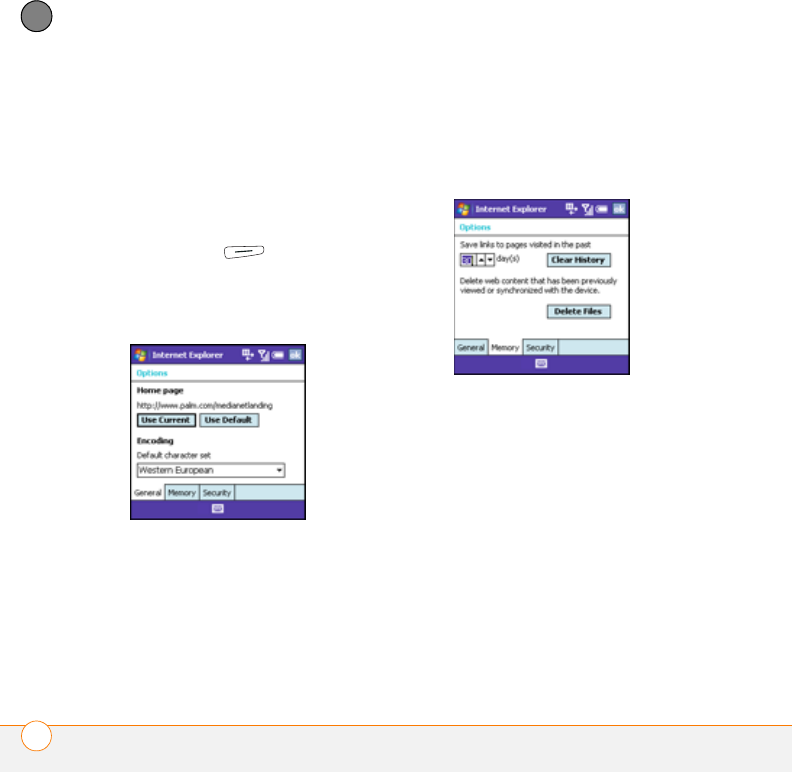
YOUR CONNECTIONS TO THE WEB AND WIRELESS DEVICES
BROWSING THE WEB
142
8
CHAPTER
2(Optional) Tap the Show list in the
upper-left, and then select how you
want to sort the History list.
3Select the web page you want to view.
Customizing your Internet Explorer
Mobile settings
1Press Menu (right action key)
and select To o l s > Options.
2On the General tab, set any of the
following options:
Home Page: Sets the page that appears
when you open Internet Explorer
Mobile. To use the page you were on
when you opened the menu, select Use
Current. To select the original home
page, select Use Default.
Encoding: Sets the character set for
the web pages you view.
3Select the Memory tab and set any of
the following options:
Save links to pages visited in the
past: Sets how many days of activity
the History list stores.
Clear History: Empties the History list.
Delete Files: Removes web files that
you previously viewed synchronized
with your computer.
4Select the Security tab and set any of
the following options:
Allow cookies: Sets whether your
smartphone accepts cookies (small files
containing info about your identity and
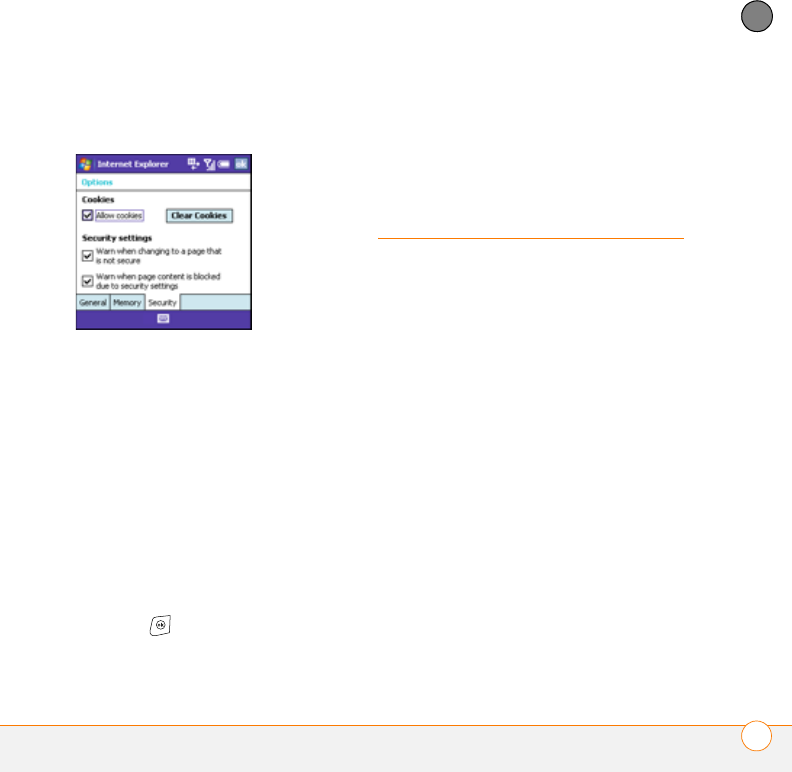
YOUR CONNECTIONS TO THE WEB AND WIRELESS DEVICES
CONNECTING TO DEVICES WITH BLUETOOTH® WIRELESS TECHNOLOGY 143
8
CHAPTER
preferences). The page sends the file
and stores it on your smartphone.
Clear Cookies: Deletes any cookies
stored on your smartphone.
Warn when changing to a page that
is not secure: Sets whether a message
appears when you switch from a secure
page to one that is not secure.
Warn when page content is blocked
due to security settings: Sets whether
a message appears when you attempt
to open a page that does not meet the
security standards associated with your
smartphone.
5Press OK .
Connecting to
devices with
Bluetooth®
wireless technology
With the built-in Bluetooth® wireless
technology on your smartphone, you can
connect to a number of Bluetooth devices
such as a headset or hands-free car kit, as
well as to other phones, handhelds, or
piconets. When you connect to another
device, you create a partnership (also
referred to by terms such as trusted pair,
trusted device, or pairing) with that device.
If your computer is enabled with Bluetooth
wireless technology, you can also
synchronize wirelessly or use your phone
as a wireless modem.
You can create a list of Bluetooth devices
that you trust to communicate with your
smartphone. When communicating with
trusted devices, your smartphone skips the
discovery process and creates a secure link
as long as the device is within range.
Bluetooth range is up to
10 meters
(
30 feet
)
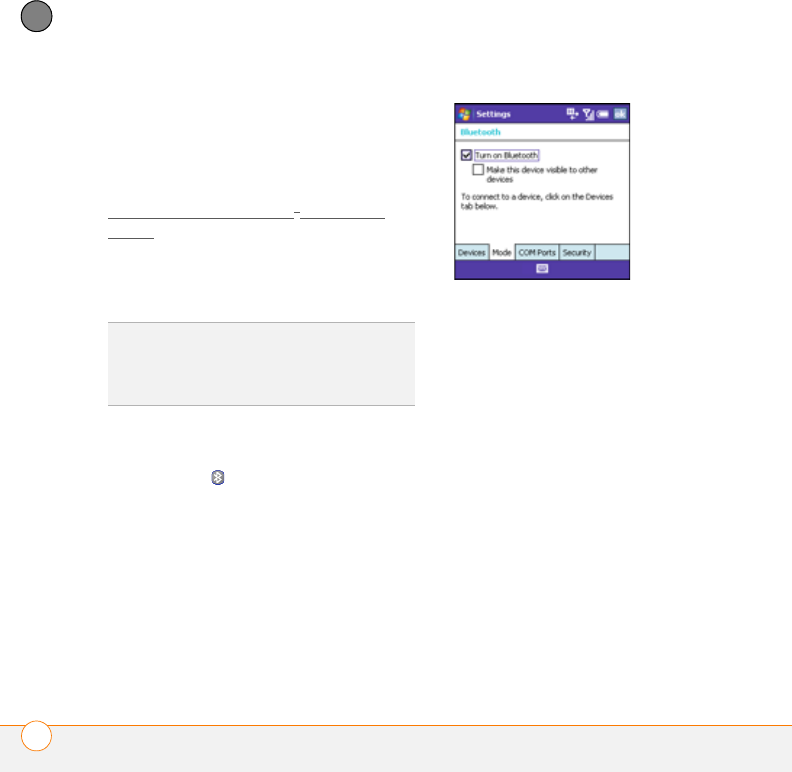
YOUR CONNECTIONS TO THE WEB AND WIRELESS DEVICES
CONNECTING TO DEVICES WITH BLUETOOTH® WIRELESS TECHNOLOGY
144
8
CHAPTER
in ideal conditions. Performance and range
are affected by physical obstacles, radio
interference from nearby electronic
equipment, and other factors.
When you configure a headset (see
Connecting to a Bluetooth® hands-free
device), the headset is automatically added
to your trusted device list. Follow the steps
in this section to add other devices to your
trusted device list, such as your computer.
Entering basic Bluetooth settings
1Go to your Today screen and tap
Bluetooth .
2Select the Mode tab and check the Tu r n
on Bluetooth box to turn on the
Bluetooth feature on your smartphone.
3Check or uncheck the Make the device
visible to other devices box.
Check this box to allow Bluetooth
devices that are not on your Trusted
Device list to request a connection with
your device. Your device remains
accessible to other devices until you
uncheck the box.
The Bluetooth status icon
The Bluetooth icon on your Today screen
indicates the status of the Bluetooth
feature:
DID
YOU
KNOW
?
Check your battery level before
establishing a Bluetooth connection. If the
battery level is low, you can’t make a
Bluetooth connection.
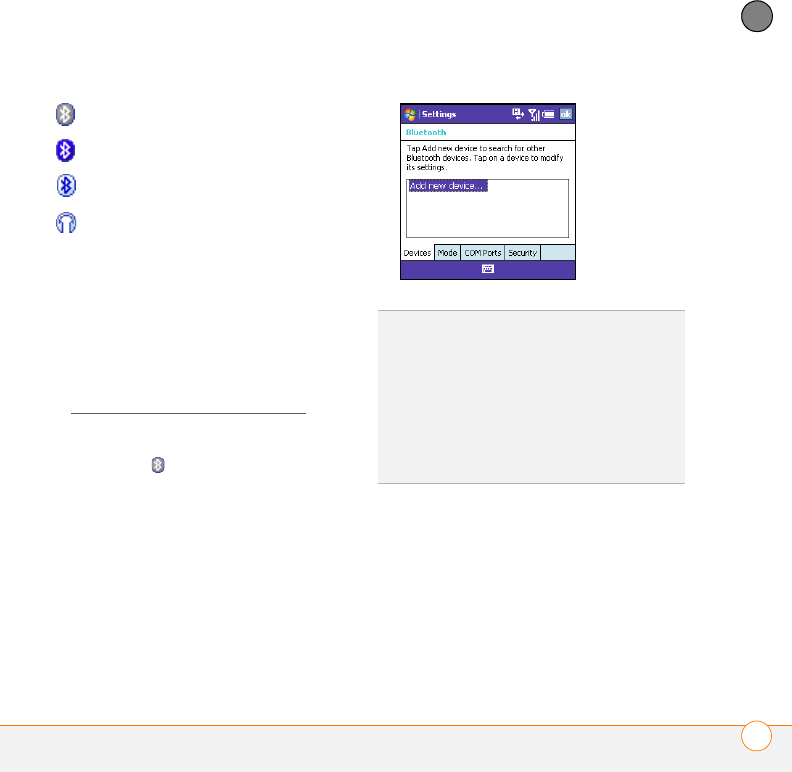
YOUR CONNECTIONS TO THE WEB AND WIRELESS DEVICES
CONNECTING TO DEVICES WITH BLUETOOTH® WIRELESS TECHNOLOGY 145
8
CHAPTER
Requesting a connection with another
Bluetooth device
BEFORE YOU BEGIN To prepare your
smartphone to be able to accept a
connection from a requesting device, enter
the basic Bluetooth settings as described
in Entering basic Bluetooth settings.
1Go to your Today screen and tap
Bluetooth .
2Select the Mode tab and check the Tu r n
on Bluetooth box to turn on the
Bluetooth feature on your smartphone.
3Select the Devices tab, and then select
Add new device.
4Wait for your smartphone to search for
devices and to display the device list.
Bluetooth off.
Bluetooth on.
Connected to a Bluetooth device.
Call in progress with a Bluetooth
headset or car kit.
KEY
TERM
Partnership Two devices—for
example, your smartphone and a hands-free
device—that can connect because each
device finds the same passkey on the other
device. After you form a partnership with a
device, you don’t need to enter a passkey to
connect with that device again. Partnership is
also known as paired relationship, pairing,
trusted device, and trusted pair.
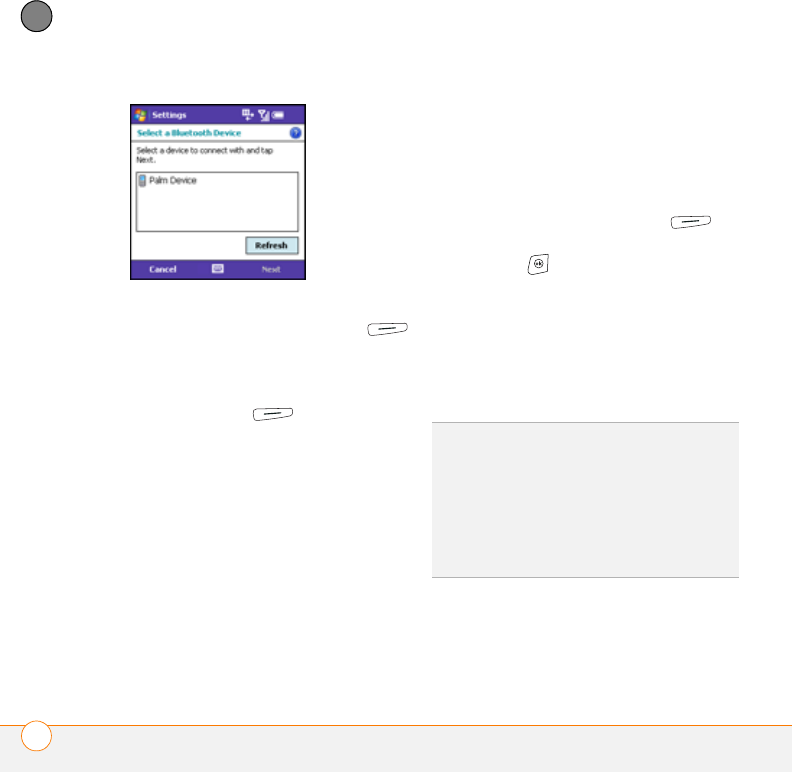
YOUR CONNECTIONS TO THE WEB AND WIRELESS DEVICES
CONNECTING TO DEVICES WITH BLUETOOTH® WIRELESS TECHNOLOGY
146
8
CHAPTER
5Select the device with which you want
to connect, and then press Next
(right action key).
6Enter an alphanumeric passkey
between 1 and 16 characters long, and
then press Next (right action
key).
IMPORTANT Some hands-free devices
have a predefined passkey. If your device
has a predefined passkey, you can find it in
the documentation for that device. Other
devices provide a screen where you enter
a passkey that you make up. In either case,
you must use the same passkey on both
your smartphone and the other device. We
recommend that where possible, you
make up a passkey of 16 alphanumeric
characters (letters and numerals only) to
improve the security of your smartphone.
The longer the passkey, the more difficult it
is for the passkey to be deciphered.
7If the passkey is not built-in, enter the
same passkey on the other Bluetooth
device, and then press Finish
(right action key).
8Press OK .
You can now communicate with this device
whenever it is within range and the
Bluetooth feature on your smartphone is
turned on. The range varies greatly
depending on environmental factors. The
maximum is about 9 meters (30 feet).
TIP
To delete the established partnership with
a device, go to the Bluetooth Settings screen
and select the Devices tab. Highlight the
connection you want to remove, press and
hold Center on the 5-way, and then select
Delete. Select Ye s to confirm the deletion.
The deleted device can no longer
automatically connect with your smartphone.

YOUR CONNECTIONS TO THE WEB AND WIRELESS DEVICES
USING YOUR DEVICE AS A WIRELESS MODEM 147
8
CHAPTER
Accepting a connection from another
Bluetooth device
BEFORE YOU BEGIN To prepare your
smartphone to be able to accept a
connection from a requesting device, enter
the basic Bluetooth settings as described
in Entering basic Bluetooth settings.
1Go to your Today screen and tap
Bluetooth .
2Select the Mode tab and check the Tu r n
on Bluetooth box to turn on the
Bluetooth feature on your smartphone.
3If you have already set up a partnership
with the transmitting device, your
smartphone is ready to receive the info.
If you haven’t set up a connection,
check the Make this device visible to
other devices box to let the device find
your smartphone and request a
connection.
4When prompted to add this device,
select Ye s .
5Enter the same passkey on your
smartphone and on the Bluetooth
device.
6(Optional) To give the partnership a
more meaningful name, select Display
Name and enter a new name.
7Press Finish (right action key).
8When your smartphone is receiving
info, a notification tells you that a
transmission is in progress. To stop the
transmission, press Cancel (right
action key). To close the notification,
press Hide (left action key).
Using your device as
a wireless modem
Internet Connection Sharing (ICS) is the
feature that converts your smartphone into
a modem so that you can access the
Internet from your computer.
You can set up Internet Connection Sharing
in one of two ways:
•Connect your smartphone to your
computer using the USB sync cable.
•If your computer is enabled with
Bluetooth wireless technology, you can
set up your smartphone as a wireless
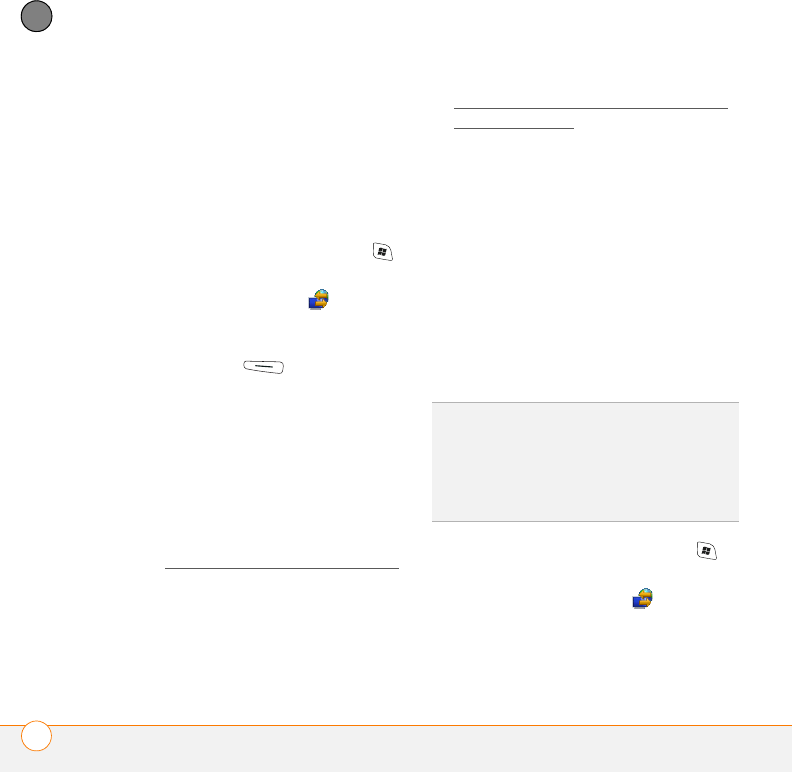
YOUR CONNECTIONS TO THE WEB AND WIRELESS DEVICES
USING YOUR DEVICE AS A WIRELESS MODEM
148
8
CHAPTER
modem using the built-in Bluetooth
technology.
Setting up a USB Internet Connection
Sharing connection
1Connect your smartphone to your
computer using the sync cable.
2On your smartphone, press Start
and select Programs.
3Select Internet Sharing .
4Select the PC Connection list, and then
select USB.
5Press Connect (left action key).
6On your computer, open your web
browser to confirm that you can
connect to the Internet.
Creating a Bluetooth Internet Connection
Sharing connection
BEFORE YOU BEGIN
•Make sure your smartphone is visible
(see Entering basic Bluetooth settings).
•Create a partnership between your
smartphone and your computer. We
recommend that you initiate the
partnership from your smartphone (see
Requesting a connection with another
Bluetooth device).
1On your computer, double-click the icon
to open the Bluetooth connections
window. Check the documentation
included with your computer for
instructions.
2Select the option to view devices within
range.
3You should see an icon representing
your smartphone. Double-click this icon
to make sure that “Network Access
Point” or something similar appears in
the list of Bluetooth services.
4On your smartphone, press Start
and select Programs.
5Select Internet Sharing .
6Select the PC Connection list, and then
select Bluetooth PAN.
TIP
Don’t see your smartphone icon or the list
of services? Check the documentation
included with your computer, or contact your
computer manufacturer for help. Different
computer models use different terminology
for the Bluetooth connection features.

YOUR CONNECTIONS TO THE WEB AND WIRELESS DEVICES
USING YOUR DEVICE AS A WIRELESS MODEM 149
8
CHAPTER
NOTE Keep the default setting on the
Network Connection list.
7Press Connect (left action key)
and follow the wizard to set up Internet
Sharing.
8On your computer, follow the steps to
accept or enable a Bluetooth PAN
connection with your smartphone.
Check the documentation included with
your computer for instructions.
9After you have connected, on your
computer, open your web browser to
confirm that you can connect to the
Internet.

YOUR CONNECTIONS TO THE WEB AND WIRELESS DEVICES
USING YOUR DEVICE AS A WIRELESS MODEM
150
8
CHAPTER

CHAPTER
9
Your photos, videos, and
music
Do you have a wallet bulging with photos of friends, family,
pets, and your most recent vacation?
Are you tired of carrying both your MP3 player and your phone?
You r Palm ® Treo™800W smartphone solves both problems. You
can keep your favorite photos right on your smartphone—
videos, too. And there's no need to carry an expensive MP3
player, because you can play music on your smartphone.
Simply transfer songs onto your smartphone or an expansion
card (sold separately) and then listen through your stereo
headphones.
Benefits
•Never be far from your favorite
people, places, and songs
•Arrange your photos, videos, and
songs
•Avoid having to use a separate
photo viewer, MP3, CD, or
mini-disc player

In this chapter
Camera. . . . . . . . . . . . . . . . . . . . . . . . . . . . . . . . . . . . . . . . . . . . . . . 154
Pictures & Videos. . . . . . . . . . . . . . . . . . . . . . . . . . . . . . . . . . . . . . . 159
Windows Media Player Mobile . . . . . . . . . . . . . . . . . . . . . . . . . . . . 163

YOUR PHOTOS, VIDEOS, AND MUSIC
SYNCHRONIZING YOUR MEDIA FILES 153
9
CHAPTER
Synchronizing your
media files
You can synchronize pictures, videos, and
music files between your smartphone and
your computer so that changes you make
show up on both your computer and your
smartphone. To synchronize media files,
you must first choose Media as one of your
synchronization options on your
smartphone; see Changing which
applications sync.
The procedure for synchronizing media
files is different for computers running
Windows XP and computers running
Windows Vista.
Synchronizing media files: Windows XP
BEFORE YOU BEGIN You must install
ActiveSync® desktop software from the
Windows Getting Started Disc (see
Installing ActiveSync desktop software:
Windows XP) and select the option to
synchronize media (see Changing which
applications sync).
When you synchronize your smartphone,
your pictures and videos are synchronized
between your smartphone and your
desktop computer. On your computer, you
can view the pictures and videos, and you
can also send them to friends using your
desktop email application.
To find all synchronized pictures and videos
on your computer, look in C:\Documents
and Settings\<Username>\My
Documents\Treo My Documents.
You use Windows Media Player to
synchronize music files; see Transferring
media files to your smartphone.
Synchronizing media files: Windows Vista
BEFORE YOU BEGIN You must install
Windows Mobile Device Center from the
Windows Getting Started Disc (see
Installing Windows Mobile Device Center:
Windows Vista) and select the option to
synchronize media (see Changing which
applications sync).
On a computer running Windows Vista,
you use Windows Media Player to
synchronize all types of media files—
pictures, videos, and music files—that are

YOUR PHOTOS, VIDEOS, AND MUSIC
CAMERA
154
9
CHAPTER
on your computer to your smartphone. See
Transferring media files to your
smartphone.
To synchronize pictures and videos from
your smartphone to your computer, follow
these steps:
1Connect your smartphone to your
computer with the USB sync cable.
2On your computer, click Start > All
Programs > Windows Mobile Device
Center.
3Select Connect without setting up
your device.
4Select Pictures, Music and Video.
5Select X new pictures/video clips are
available for import.
All new or changed pictures and videos on
your smartphone are synchronized to your
computer.
Camera
Your smartphone comes with an
easy-to-use, built-in, 1.3-megapixel camera
with 2x digital zoom. You can use the
camera to take and view pictures and
videos and send them to your friends and
family. To add a personal touch to your
smartphone, use your pictures as your
Today screen background and as caller ID
images, or use your videos to create video
ringtones.
You can receive and view pictures and
videos, and send pictures and videos as
attachments or multimedia messages (see
Pictures & Videos). Or add a picture to a
contact (see Adding a contact). You can
also move pictures and videos to a
computer by synchronizing your
smartphone with your computer.
Taking a picture
By default, pictures are stored in the My
Pictures folder on your smartphone. If you
want to store your pictures on an
expansion card, you can change where
pictures are stored (see Customizing your
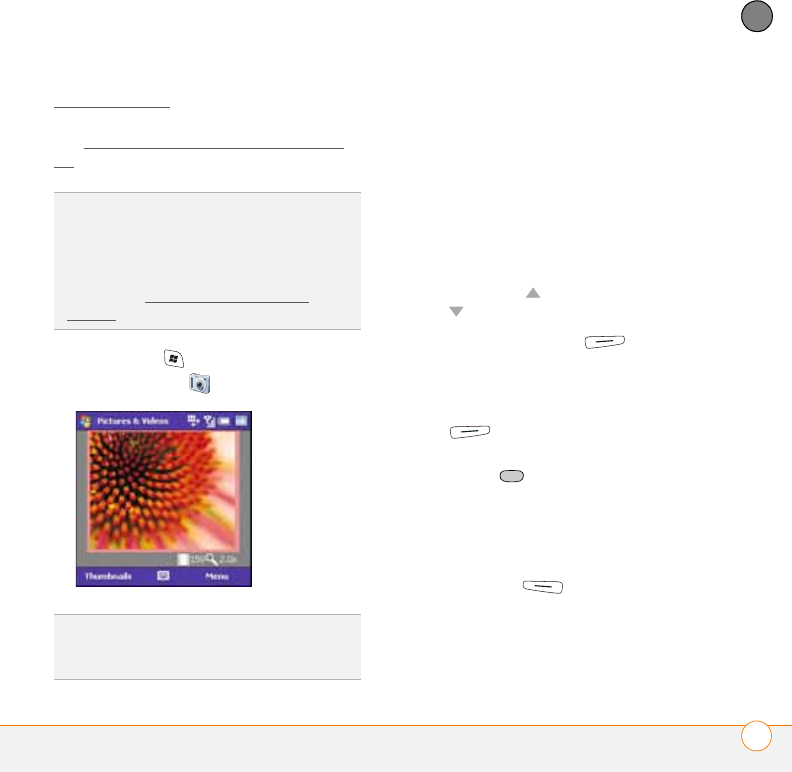
YOUR PHOTOS, VIDEOS, AND MUSIC
CAMERA 155
9
CHAPTER
Camera settings). For information on
accessing your pictures on your computer,
see Synchronizing media files: Windows
XP.
1Press Start and select Programs.
2Select Camera .
3Adjust the position of your smartphone
until you see the subject you want to
photograph on the screen. Your
smartphone has a self-portrait mirror
next to the camera lens on the back of
your smartphone. Use the mirror when
you’re taking a picture and you want to
be in the picture.
4(Optional) Adjust any of the following:
Zoom: Press Up to zoom in or
Down to zoom out.
Resolution: Press Menu (right
action key) and select Resolution to
change the image quality.
5(Optional) Set a five-second timer: Press
Menu (right action key), select
Mode, and then select Timer.
6Press Center to capture the picture
or start the timer.
7Hold your smartphone still until the
picture renders, and then do one of the
following:
•Press Camera (left action key)
to take another picture.
DID
YOU
KNOW
?
Pictures are captured and stored
in 16-bit color, JPG format. Resolution settings
range from a low end of QQVGA (120 x 160
pixels) to a high end of 1.3-megapixels (1280 x
1024 pixels). You can change the default
setting. See Customizing your Camera
settings for details.
TIP
If you see a camcorder icon below the
preview image, video mode is on. To turn on
the still camera, press Menu and select Still.
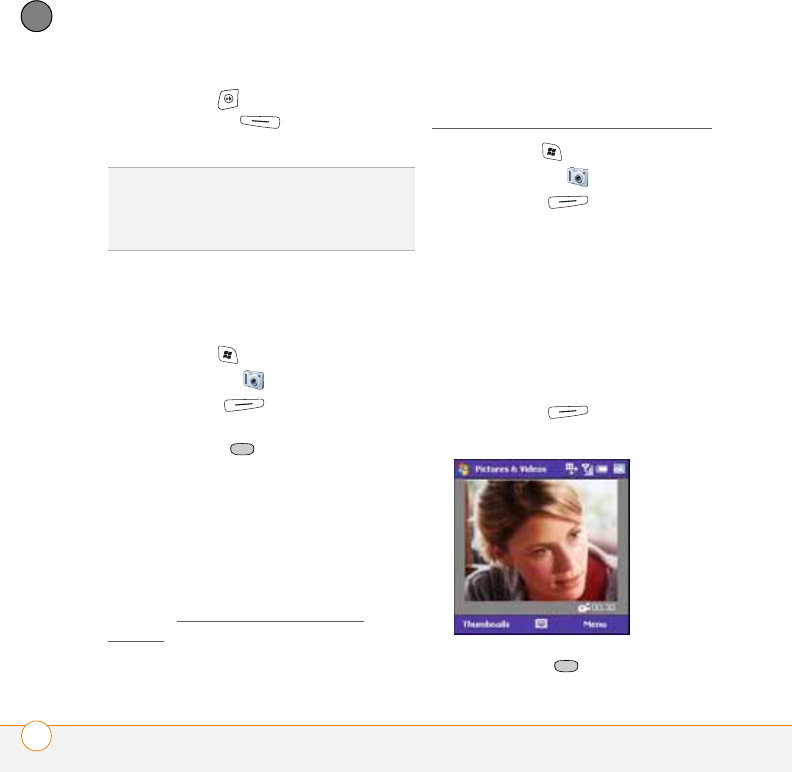
YOUR PHOTOS, VIDEOS, AND MUSIC
CAMERA
156
9
CHAPTER
•Press OK and then press
Thumbnails (left action key) to
return to Thumbnail View.
Taking pictures in burst mode
Burst mode takes five pictures in quick
succession, with one button press.
1Press Start and select Programs.
2Select Camera .
3Press Menu (right action key)
and select Mode > Burst.
4Press Center .
Recording a video
Videos can be any length, provided you
have enough storage space available. By
default, videos are stored in the My
Pictures folder on your smartphone. If you
want to store your videos on an expansion
card, see Customizing your Camera
settings to change where videos are
stored. For information on accessing your
videos on your computer, see
Synchronizing media files: Windows XP.
1Press Start and select Programs.
2Select Camera .
3Press Menu (right action key)
and select Video.
4Adjust the position of your smartphone
until you see the subject you want to
record on the screen. Your smartphone
has a self-portrait mirror next to the
camera lens on the back of your
smartphone. Use the mirror when
you’re recording a video and you want
to be in the video.
5Press Menu and select Quality
to change the video resolution.
6Press Center to start recording.
DID
YOU
KNOW
?
After three minutes of inactivity
when previewing an image, the camera goes
into standby mode. Press any key or tap the
screen to return to the image preview.
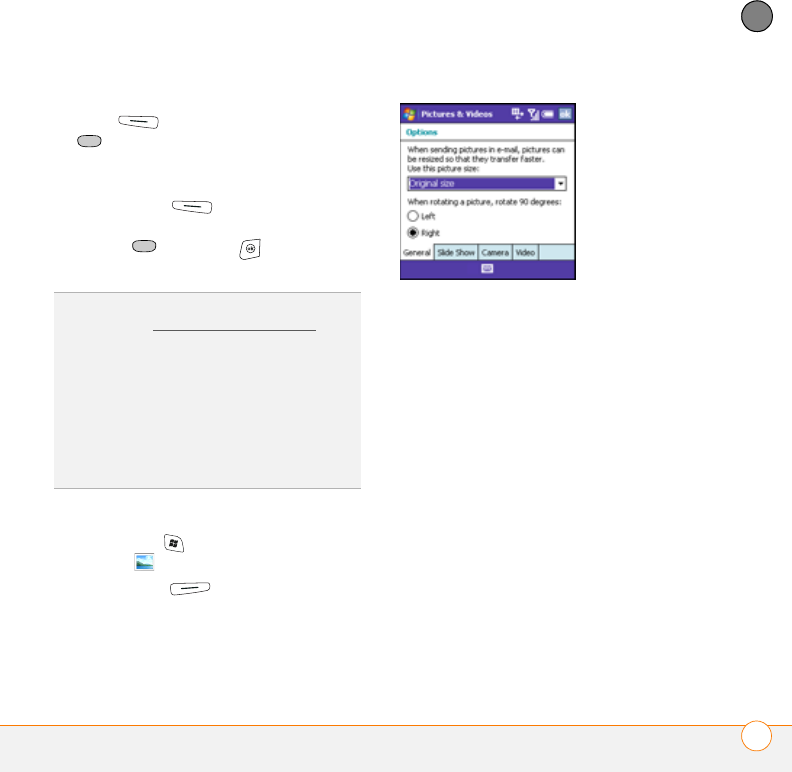
YOUR PHOTOS, VIDEOS, AND MUSIC
CAMERA 157
9
CHAPTER
7When you’re finished recording, press
Stop (left action key) or Center
to stop recording.
8(Optional) To review the video in
Windows Media Player Mobile, press
Thumbnails (left action key),
highlight the video, and then press
Center . Press OK to return to
Thumbnail View.
Customizing your Camera settings
1Press Start and select Pictures &
Videos .
2Press Menu (right action key)
and select Options.
3On the General tab, set any of the
following options:
Use this picture size: Sets the size of
pictures you send with the Inbox
application.
When rotating a picture, rotate 90
degrees: Sets the direction in which
pictures rotate.
4Select the Slide Show tab, and set any
of the following options:
TIP
If you don’t like a video you recorded,
delete it. See Deleting a picture or video for
details.
DID
YOU
KNOW
?
After three minutes of inactivity
when previewing an image, the camera goes
into standby mode. Press any key or tap the
screen to return to the image preview. If the
camera goes to standby while the recording is
paused, the video recording is stopped and
the video is saved.
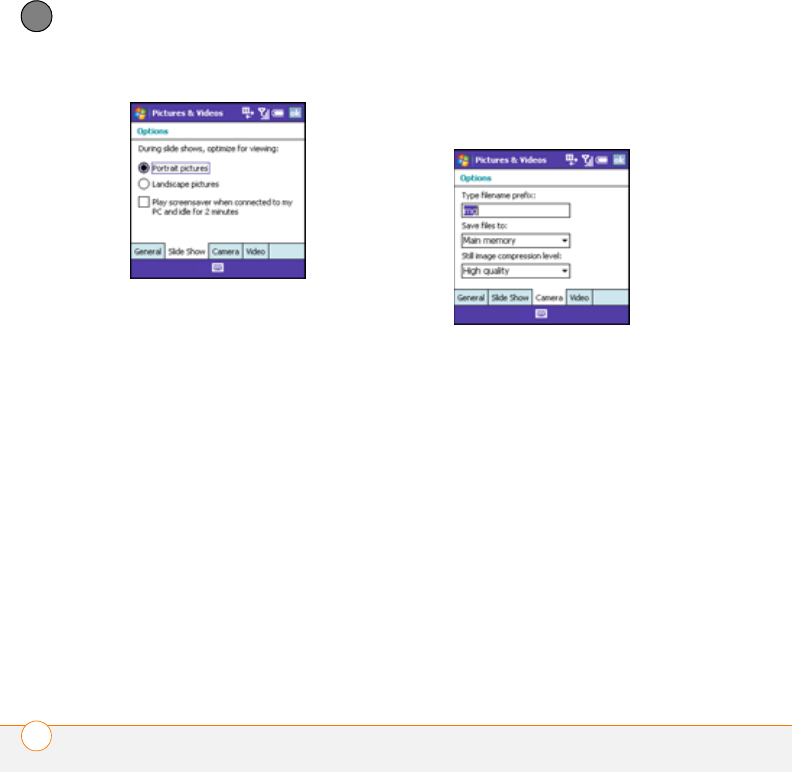
YOUR PHOTOS, VIDEOS, AND MUSIC
CAMERA
158
9
CHAPTER
During slide shows, optimize for
viewing: Sets whether pictures are
optimized for portrait or landscape
format during slide shows.
Play screensaver when connected to
my PC and idle for 2 minutes: Sets
whether the pictures in your My
Pictures folder are used as a
screensaver when your smartphone is
connected to your computer and
ActiveSync® desktop software is not
running.
5Select the Camera tab, and set any of
the following options:
Type filename prefix: Assigns a name
to a series of pictures to be captured,
such as Seattle001, Seattle002, and so
on.
Save files to: Specifies whether
pictures and videos are stored on your
smartphone or on an expansion card.
Still image compression level:
Sets the default quality and size for
newly captured still pictures.
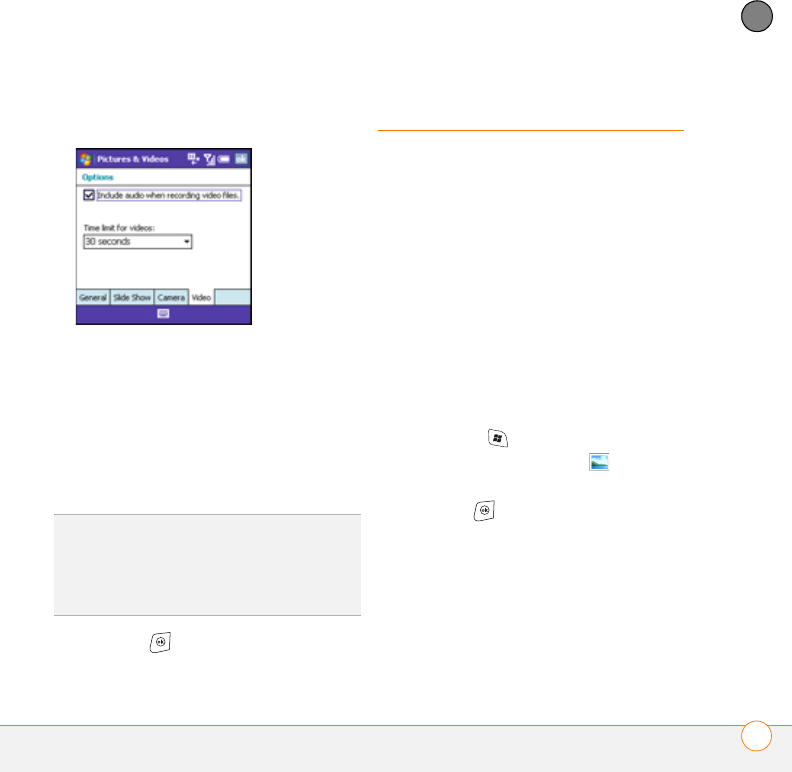
YOUR PHOTOS, VIDEOS, AND MUSIC
PICTURES & VIDEOS 159
9
CHAPTER
6Select the Video tab, and set any of the
following options:
Include audio when recording video
files: Turns the microphone on and off
so that you can record videos with or
without sound.
Time limit for videos: Limits the length
of videos you record. You can select the
No limit option.
7Press OK to return to
Thumbnail View.
Pictures & Videos
Viewing a picture
In addition to viewing the pictures you
capture with the built-in camera, you can
view pictures captured on many popular
digital cameras or downloaded from the
Internet. Your smartphone supports the
following picture formats:
•JPG
•PNG
•BMP
•GIF
1Press Start and select Programs.
2Select Pictures & Videos .
3Select the picture you want to view.
4Press OK to return to Thumbnail
View.
Viewing a video
In addition to viewing the videos you
capture with the built-in camera, you can
view videos captured on many popular
digital cameras or streamed from
DID
YOU
KNOW
?
Videos are captured and stored in
3GP format. Video resolution ranges from 176
x 144 pixels to 352 x 288 pixels. You can
change the resolution setting by pressing
Menu (right action key) and selecting Quality.
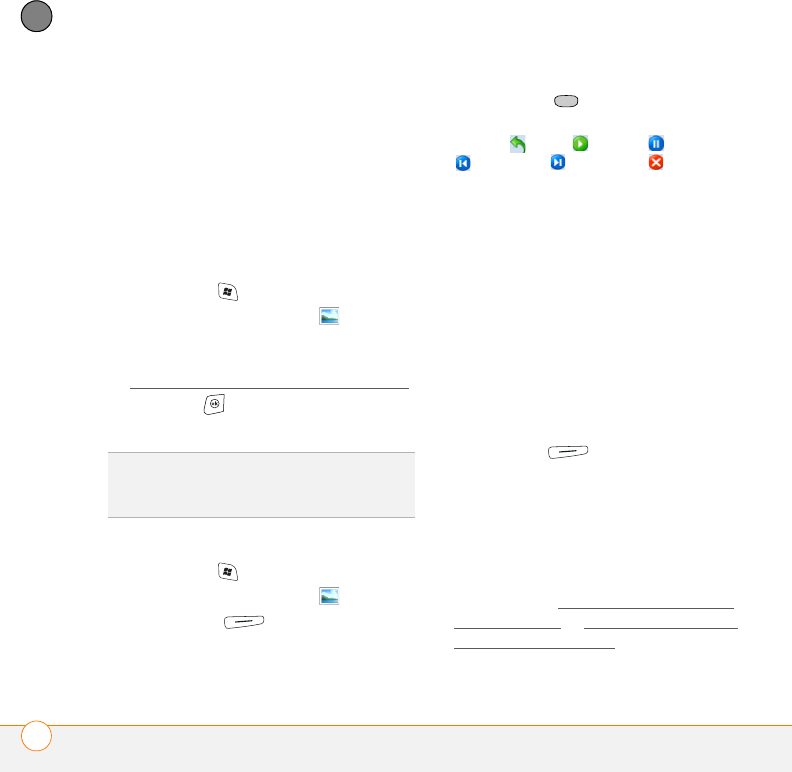
YOUR PHOTOS, VIDEOS, AND MUSIC
PICTURES & VIDEOS
160
9
CHAPTER
websites. Your smartphone supports and
streams the following types of video files:
•MPEG-4
•3GPP2
•3GPP
•WMV, WMA, ASF
•RTSP Streaming
1Press Start and select Programs.
2Select Pictures & Videos .
3Select the video you want to view. For
more info on viewing videos, see
Playing media files on your smartphone.
4Press OK to return to Thumbnail
View.
Viewing a slide show
1Press Start and select Programs.
2Select Pictures & Videos .
3Press Menu (right action key)
and select Play Slide Show. The slide
show plays automatically.
4Press Center to display the slide
show toolbar, which you can use to
Rotate , Play , Pause , Reverse
, Forward , and Stop the slide
show.
Sending a picture or video
You can send a picture or video to other
picture-enabled mobile smartphone
devices or to an email address as an
attachment.
You cannot send copyrighted pictures or
videos that appear with a lock icon in
Thumbnail View.
1Highlight the picture or video you want
to send.
2Press Menu (right action key)
and select Send.
3Select the option you want to use to
send the picture or video: an email
account or MMS
4When the Inbox or Messaging
application opens, address and send the
message (see Creating and sending an
email message or Creating and sending
a multimedia message).
TIP
To view pictures or videos in a different
folder, tap the Show list in the upper-left, and
then select the album you want to view.

YOUR PHOTOS, VIDEOS, AND MUSIC
PICTURES & VIDEOS 161
9
CHAPTER
Creating a video ringtone
You can save a video that you record as a
ringtone.
1Highlight the video you want to use as a
ringtone.
2Press Menu (right action key)
and select Save to Contact Ring Tone.
3Select the contact to whom you want to
assign the ringtone.
Organizing pictures and videos
You can move or copy pictures and videos
to other folders or between your
smartphone and an expansion card.
1Highlight the picture or video you want
to move or copy.
2Do one of the following:
•To move the picture or video to
another location, press Menu
(right action key) and select Edit >
Cut.
•To keep the picture or video in two
locations, press Menu (right
action key) and select Edit >Copy.
3Tap the Show list in the upper-left, and
select the location where you want to
place the picture or video.
4Press Menu (right action key)
and select Edit > Paste.
You can also view a specific folder or
expansion card and arrange the pictures
and videos by name, date, or size.
1Tap the Show list in the upper-left, and
then select the folder you want to view.
2Tap the Sort By list in the upper-right,
and then select the sort method:
Name, Date, or Size.
Using a picture as the Today screen
background
1Highlight the picture you want to use.
2Press Menu (right action key)
and select Set as Today Background.
3Select the Transparency level list and
select the appropriate level. Use a
higher percentage for a more
transparent picture and a lower
percentage for a more opaque picture.
4Press OK to return to Thumbnail
View.

YOUR PHOTOS, VIDEOS, AND MUSIC
PICTURES & VIDEOS
162
9
CHAPTER
Editing a picture
For more extensive edits, just download
your picture or video to your computer and
edit it in your favorite graphics program.
Then sync the picture or video back to your
smartphone.
1Select the picture you want to edit.
2Press Menu (right action key)
and select Edit.
3Do any of the following:
•To rotate the picture 90 degrees,
press Rotate (left action key).
•To crop the picture, press Menu
(right action key) and select
Crop. Tap and drag the stylus to
highlight the area to crop. Tap outside
the box to stop cropping.
•To adjust the brightness and contrast
levels of the picture, press Menu
(right action key) and select
AutoCorrect.
•To undo an edit, press Menu and
select Undo.
•To cancel all unsaved edits you made
to the picture, press Menu
(right action key) and select Revert to
Saved.
Deleting a picture or video
1Highlight the picture or video you want
to delete.
2Press Menu (right action key)
and select Delete.
3Select Ye s to confirm the deletion.
Renaming a picture or video
1Highlight the picture or video you want
to delete.
2Press Menu (right action key)
and select Properties.
3Enter a new name for the picture or
video.
4 Press OK to return to Thumbnail
View.

YOUR PHOTOS, VIDEOS, AND MUSIC
WINDOWS MEDIA PLAYER MOBILE 163
9
CHAPTER
Windows Media
Player Mobile
Windows Media Player Mobile can play
music, audio, and video files that are
stored on your smartphone or on an
expansion card (sold separately) in any of
the following file formats:
•WMA
•WMV
•MP3
•3GP
•AAC
•AAC+
•MPEG-4
IMPORTANT You must have QuickTime
Player version 6.5 or later installed on your
computer to play videos recorded by your
smartphone. You can download the videos
from an expansion card or you can click the
video thumbnail after synchronizing the
files.
You can listen to these music, audio, and
video files through the speaker on the back
of your smartphone or through stereo
headphones.
Transferring media files to your
smartphone
Use the Sync feature in the desktop
version of Windows Media Player to
transfer digital music, audio, video, and
playlist files from your computer to an
expansion card or your smartphone. Using
the Sync feature ensures that the files are
transferred correctly.
BEFORE YOU BEGIN Do the following:
•Be sure you have Windows Media
Player 10 or later installed on your
computer. On a Windows XP computer,
Windows Media Player 10 must be
DID
YOU
KNOW
?
You can also download animated
GIF files and view them in Internet Explorer
Mobile.
TIP
For tips on using the desktop version of
Windows Media Player, go to the Help menu
in Windows Media Player on your computer.

YOUR PHOTOS, VIDEOS, AND MUSIC
WINDOWS MEDIA PLAYER MOBILE
164
9
CHAPTER
installed on your computer before you
install ActiveSync desktop software.
Both Windows Media Player 10 and
ActiveSync desktop software can be
installed from the Windows Mobile
Getting Started CD that came with your
smartphone. (If you are having trouble,
see My video and music files won’t
sync.)
NOTE Windows Media Player 11 is already
installed on Windows Vista computers.
•To sync media files with your computer,
set the Media sync option on your
smartphone (see Setting
synchronization options).
1On your computer, open Windows
Media Player.
2(Optional) If you’re transferring media
files to an expansion card, insert a
32MB or larger expansion card into your
smartphone.
3Connect your smartphone to your
computer with the USB sync cable.
4Do one of the following:
Windows XP: When the Device Setup
Wizard opens on your computer,
click Automatic. Check the Customize
the playlists that will be
synchronized box.
Windows Vista: Select the Sync tab,
and then select Tr e o > Set Up Sync.
Check the Sync this device
automatically box.
5Select the playlists you want to sync.
On a Windows Vista computer, select
the All Photos and All Videos playlists
to synchronize pictures and videos
between your smartphone and your
computer.
6Click Finish to begin the transfer. If you
are transferring files to an expansion
card, be patient; transferring media files
to an expansion card can take several
minutes.
Playing media files on your smartphone
1Press Start and select Programs.
2Select Windows Media .
3Press Menu (right action key)
and select Library.
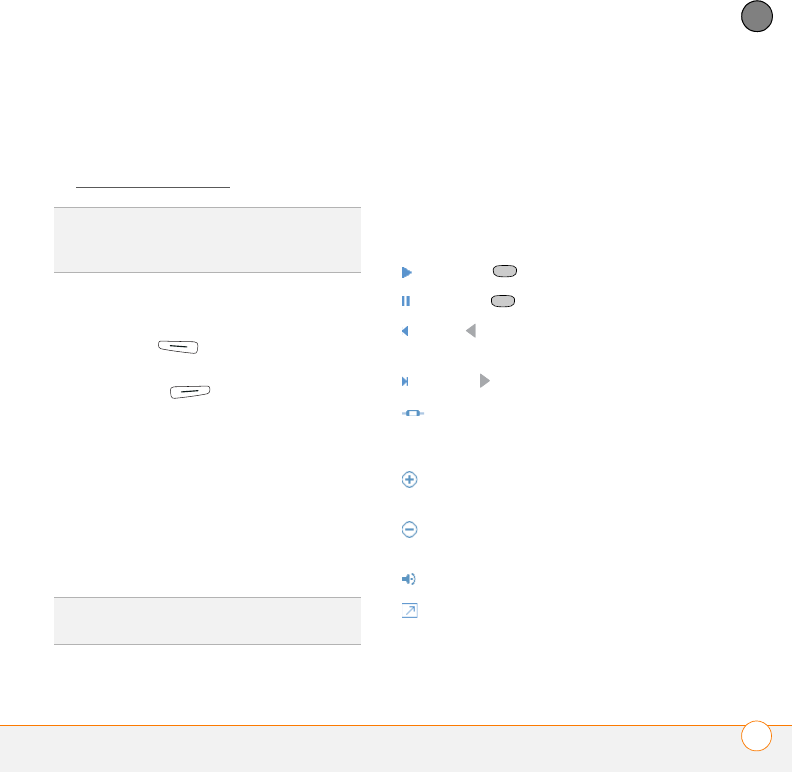
YOUR PHOTOS, VIDEOS, AND MUSIC
WINDOWS MEDIA PLAYER MOBILE 165
9
CHAPTER
4Select the Library list in the upper-left,
and then select the library you want to
use. If you can’t find a media file on your
expansion card, update the library (see
Working with libraries).
5Select the item you want to play (such
as a song, album, or artist name).
6Press Play (left action key). See
the next page for playback controls.
7Press Menu (right action key)
and select any of the following during
playback:
Library: Displays the Library screen so
you can select a different song to play.
Shuffle/Repeat > Shuffle: Plays the
Now Playing playlist in random order. A
check appears next to this command
when it is on.
Shuffle/Repeat > Repeat: Plays the
Now Playing playlist repeatedly. A check
appears next to this command when it
is on.
Stop: Ends playback.
Use any of the following onscreen controls
during playback:
or Center plays the current file.
or Center pauses the current file.
or Left skips to the beginning of the
current file or to the previous file.
or Right skips to the next file.
sets the point from which playback
begins. Tap and drag the slider to
change the current position.
or Volume button increases the
volume level.
or Volume button decreases the
volume level.
turns the sound on or off.
displays a video using the full
screen.
TIP
To play a file that is not in a library, go to
the Library screen, press Menu, and select
Open File.
TIP
To repeat the current song, press Menu
and select Repeat Song.

YOUR PHOTOS, VIDEOS, AND MUSIC
WINDOWS MEDIA PLAYER MOBILE
166
9
CHAPTER
displays a website where you can
find music and videos to play.
indicates the rating of the current
file. Select the star to change the rating.
Working with libraries
A library represents each of the storage
locations available to Windows Media
Player Mobile, so you should have two
libraries: My Device and My Storage Card.
Each library contains links to the media
files in that location. Windows Media
Player Mobile usually updates the My
Device library automatically, but you must
manually update the My Storage Card
library.
1Press Start and select Programs.
2Select Windows Media .
3Press Menu (right action key, and
select Library.
4Press Menu (right action key)
and select Update Library.
5Wait for the files to be added, and then
select Done.
DID
YOU
KNOW
?
You can play streaming files from
the web. To play an MMS (Microsoft Media
Streaming) file, press Menu on the Library
screen and select Open URL. Select URL and
enter the website address, or select History
and select a site you’ve visited before.
DID
YOU
KNOW
?
If you close the Windows Media
Player Mobile window, your music continues
to play in the background.
TIP
If you don’t see a media file that you added,
manually update the library.
TIP
To delete an item from a library, highlight
the item and then press and hold Center on
the 5-way to open the shortcut menu. Select
Delete from Library, and select Ye s to
confirm the deletion.
DID
YOU
KNOW
?
If you move files between your
smartphone and an expansion card, be sure to
update your libraries, or you won’t be able to
see the files in their new location.
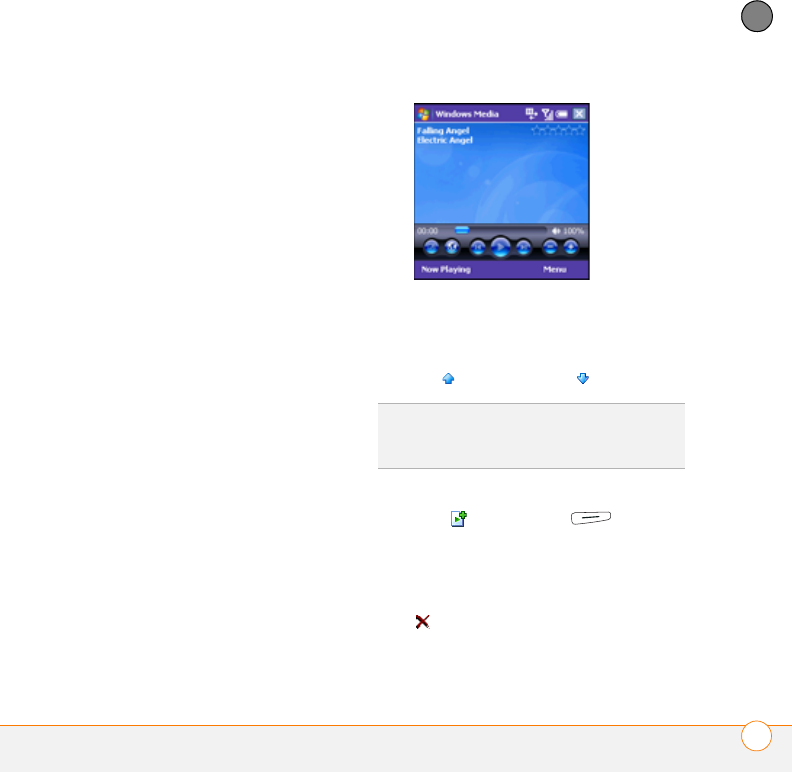
YOUR PHOTOS, VIDEOS, AND MUSIC
WINDOWS MEDIA PLAYER MOBILE 167
9
CHAPTER
Working with playlists
A playlist is a list of media files that play in
a specific order. You can use playlists to
group audio files together or video files
together for convenient playback. For
example, in the desktop Windows Media
Player, you can create a playlist of upbeat
songs for when you exercise and a playlist
of soothing songs for a long flight. When
you synchronize, your favorite playlists are
automatically copied to your smartphone.
Your playlists appear in your libraries (in the
My Playlists category).
A temporary playlist, called Now Playing,
appears on the Now Playing menu. It lists
the currently playing file, as well as any
files that are queued up to play next. You
can add to, modify, or clear the files on the
Now Playing playlist.
1Go to the Now Playing screen:
•If you are on the Library screen,
select the Now Playing category.
•If you are on the Playback screen,
select Now Playing.
2Do any of the following:
•To move a file up or down one slot,
highlight the file and select Move
Up or Move Down .
•To add a file, highlight the file, select
Add , press Menu (right
action key), and then select Queue
Up.
•To delete a file from the playlist,
highlight the file and select Remove
.
TIP
You can also move a file in the Now Playing
playlist by tapping and dragging it to a new
position.
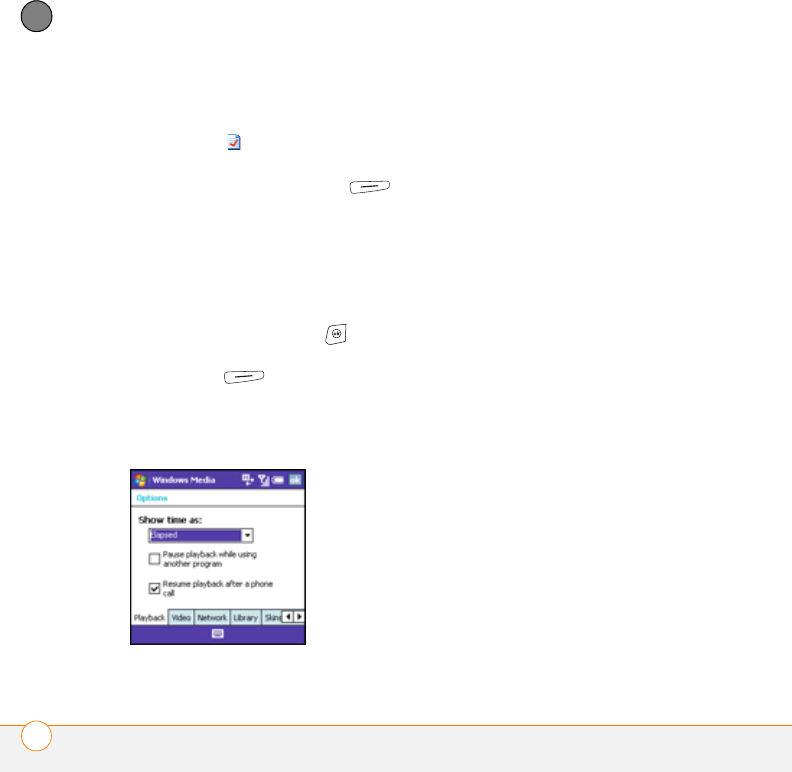
YOUR PHOTOS, VIDEOS, AND MUSIC
WINDOWS MEDIA PLAYER MOBILE
168
9
CHAPTER
•To view more info about a file,
highlight the file and select
Properties .
•To remove all items from the Now
Playing playlist, press Menu
(right action key) and select Clear
Now Playing.
Customizing Windows Media Player
Mobile
1If you are on any screen other than the
Playback screen, press OK to go to
the Playback screen.
2Press Menu (right action key)
and select Options.
3On the Playback tab, set any of the
following options:
Show time as: Sets whether the time
remaining or time elapsed appears in
the Playback screen.
Pause playback while using another
program: Sets whether playback
continues if you switch to another
application.
Resume playback after a phone call:
Sets whether playback continues after
you finish a phone call.
4Select the Video tab and set any of the
following options:
Play video in full screen: Sets whether
videos automatically play in full screen
format.
Scale to fit window: Sets whether
videos are automatically scaled to fit the
Playback screen.
5Select the Network tab and set the
following options:
Protocol: Enables and disables the
available protocols. You must select at
least one protocol. You can also set a
UDP Port.
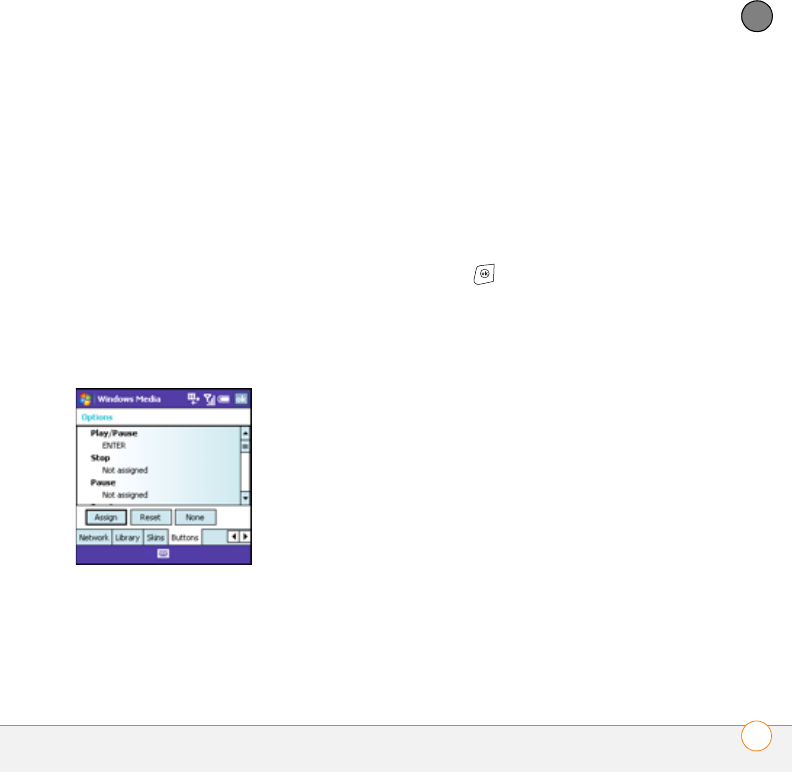
YOUR PHOTOS, VIDEOS, AND MUSIC
WINDOWS MEDIA PLAYER MOBILE 169
9
CHAPTER
Internet connection speed: Specifies
the speed of your network connection,
and specifies whether you want the
device to detect connection speed.
6Select the Library tab and set whether
you want to see the Library or Playback
screen when you open Windows Media
Player Mobile.
7Select the Skins tab and select
Previous or Next to set the player’s
background.
8Select the Buttons tab to change any of
the available button settings:
•To assign a button, highlight the item
you want to set, select Assign, and
then press the button you want to use
for that item.
•To restore an item’s factory setting,
highlight the item and select Reset.
•To unassign an item, highlight the
item and select None.
9Press OK .

YOUR PHOTOS, VIDEOS, AND MUSIC
WINDOWS MEDIA PLAYER MOBILE
170
9
CHAPTER

CHAPTER
10
Your personal information
organizer
Say good-bye to paper calendars and throw away those
scribbled to-do lists. Your Palm® Treo™800W smartphone is all
you need to organize your personal information and keep it with
you wherever you go.
You never lose your information, even if your battery is
completely drained. All your personal information is backed up
each time you synchronize, and your information is kept private
when you use the security features available on your
smartphone. Also, you can easily share info with others
electronically.
Benefits
•Track current, future, and past
appointments
•Make to-do lists that get done
•Set reminders for appointments,
birthdays, important tasks, and
more

In this chapter
Contacts. . . . . . . . . . . . . . . . . . . . . . . . . . . . . . . . . . . . . . . . . . . . . . 173
Calendar . . . . . . . . . . . . . . . . . . . . . . . . . . . . . . . . . . . . . . . . . . . . . . 176
Tasks . . . . . . . . . . . . . . . . . . . . . . . . . . . . . . . . . . . . . . . . . . . . . . . . 182
Notes . . . . . . . . . . . . . . . . . . . . . . . . . . . . . . . . . . . . . . . . . . . . . . . . 185
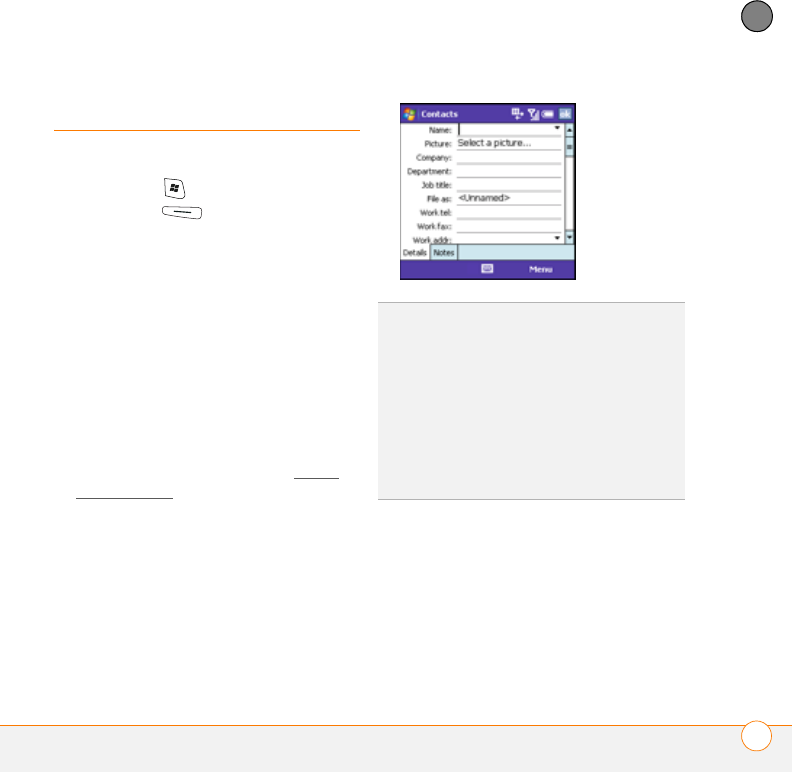
YOUR PERSONAL INFORMATION ORGANIZER
CONTACTS 173
10
CHAPTER
Contacts
Adding a contact
1Press Start and select Contacts.
2Press New (left action key).
3Select the type of contact to create:
Outlook Contact: This type of contact
is stored in the Contacts application on
your smartphone and synchronizes with
the Contacts application in Microsoft
Outlook on your computer.
SIM Contact: This type of contact is
stored on the SIM card in your
smartphone and does not synchronize.
If you use the SIM card with another
smartphone, you can access any
contacts on the SIM card (see Using
SIM Manager).
4Use the 5-way navigator to move
between fields as you enter
information.
Here are some helpful tips for entering
info:
•To enter complete name or address
(work, home, or other) information,
tap the arrow on the right side of the
line and enter the information in the
box that appears. When finished, tap
TIP
Take some time to scroll down through all
the fields in a new contact. There are fields for
multiple addresses, phone numbers, email
addresses, and much more.
TIP
Be sure to enter mobile numbers and email
addresses in the correct fields so that Inbox
and Messaging can find this info when you
address a message and Calendar can find your
contacts when you want to invite them to
meetings.

YOUR PERSONAL INFORMATION ORGANIZER
CONTACTS
174
10
CHAPTER
outside the box to accept the
information and close the box.
•To add a caller ID picture that displays
when that person calls, select
Picture, and then select Camera and
take a picture, or select an existing
picture from Thumbnail View.
•To assign the entry to one or more
categories, select Categories and
then check the categories under
which you want this entry to appear.
•To assign a ringtone to the entry,
select Ring tone and select a tone.
5To add a note to an entry, select the
Notes tab.
6After you enter all the information, press
OK .
Viewing or changing contact information
1In the Contacts list (viewed by name),
begin entering one of the following for
the contact you want to view or edit:
•First name
•Last name
•First initial and last initial separated by
a space
•Phone number
2Select the entry you want to open.
3Press Menu (right action key)
and select Edit.
4Make changes to the entry as
necessary.
5Press OK .
DID
YOU
KNOW
?
When you select a contact entry,
you are presented with several options for
contacting the person, depending on what
information you have entered for the contact.
For example, you may see options for calling a
number associated with the contact, sending
an email to the contact’s email address, or
calling the last number you dialed to call the
contact.
DID
YOU
KNOW
?
You can find a contact by company
name. Press Menu (right action key) and
select View By > Company. Select a
company name to see the contacts who work
there.
TIP
To view a particular group of contacts,
press Menu (right action key), select Filter,
and then select the category you want to
view.

YOUR PERSONAL INFORMATION ORGANIZER
CONTACTS 175
10
CHAPTER
Deleting a contact
1In the Contacts list, highlight the
contact you want to delete.
2Press Menu (right action key)
and select Delete Contact.
3Select Ye s to confirm the deletion.
Customizing Contacts
1Go to the Contacts list.
2Press Menu (right action key)
and select Options.
3 Set any of the following options:
Show alphabetical index: Displays the
alphabet at the top of the Contacts list.
You can use this index to find a contact.
Show contact names only: Enables
you to fit more names on the Contacts
list by hiding everything but the
contact’s name.
Area code: Specifies the default area
code for new contact entries.
4Press OK .
Finding a contact in an online address
book
In addition to having contacts on your
device, you can also access contact
information from your organization’s online
address book or Global Address List (GAL).
BEFORE YOU BEGIN Do the following:
•Make sure you are accessing Exchange
Server 2007 or Exchange Server 2003
upgraded to Service Pack 2.
•Add access to the online address book
to your smartphone. See Adding an
online address book.
•After adding the online address book,
you must synchronize with the
Exchange server in order for the
Company Directory option to appear.
1Press Start and select Contacts.
2Press Menu (right action key),
select Company Directory, enter the
name of the contact, and then select
Search.
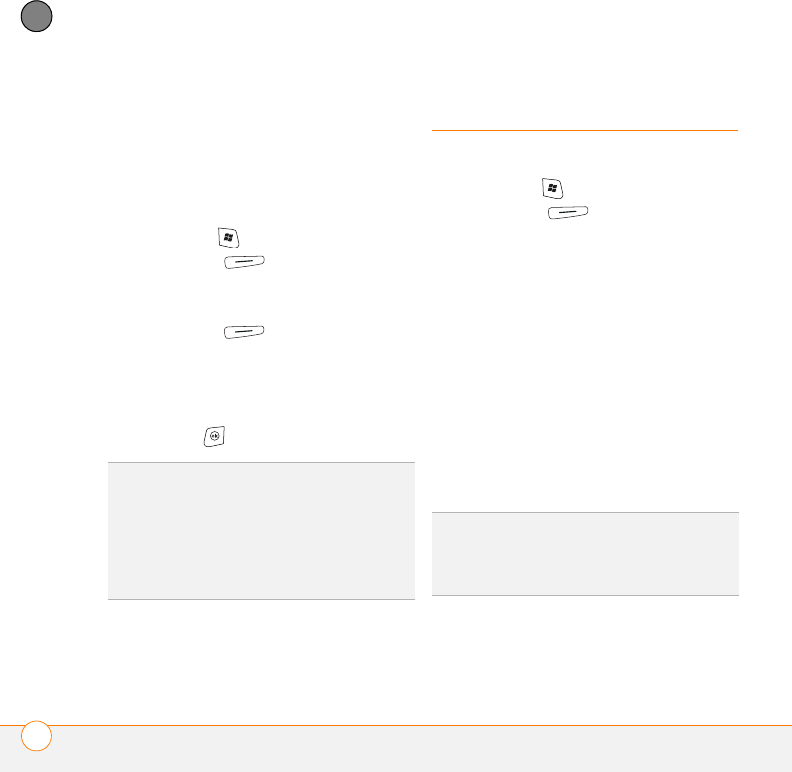
YOUR PERSONAL INFORMATION ORGANIZER
CALENDAR
176
10
CHAPTER
Using SIM Manager
You can manage the contacts on your SIM
card, including deleting numbers and
transferring numbers between the card
and the Contacts application on your
smartphone.
1Press Start and select Contacts.
2Press Menu (right action key)
and select SIM Manager.
3Highlight the contact you want.
4Press Menu (right action key)
and select the option you want to edit
the contact’s information, delete the
contact, copy it to the Contacts
application, and more.
5Press OK
Calendar
Displaying your calendar
1Press Start and select Calendar.
2Press Menu (right action key)
and select View.
3Select one of the following views:
Agenda: Shows your daily schedule in
list format. Upcoming appointments are
bold; past appointments are dimmed.
Day: Shows your daily schedule in
day-planner format. Day View displays a
horizontal time strip at the top to show
at a glance when you have
appointments.
Week: Shows your schedule for an
entire week.
TIP
If a contact has more than one phone
number, you can automatically copy one or
more of the numbers to the SIM card. In SIM
Manager, press Menu (right action key) and
select Tools > Options. Check the boxes next
to the numbers you want automatically copied
to the SIM card.
DID
YOU
KNOW
?
If your schedule contains a
conflict—two appointments that overlap—you
can see the conflict in both Day View and
Week View.
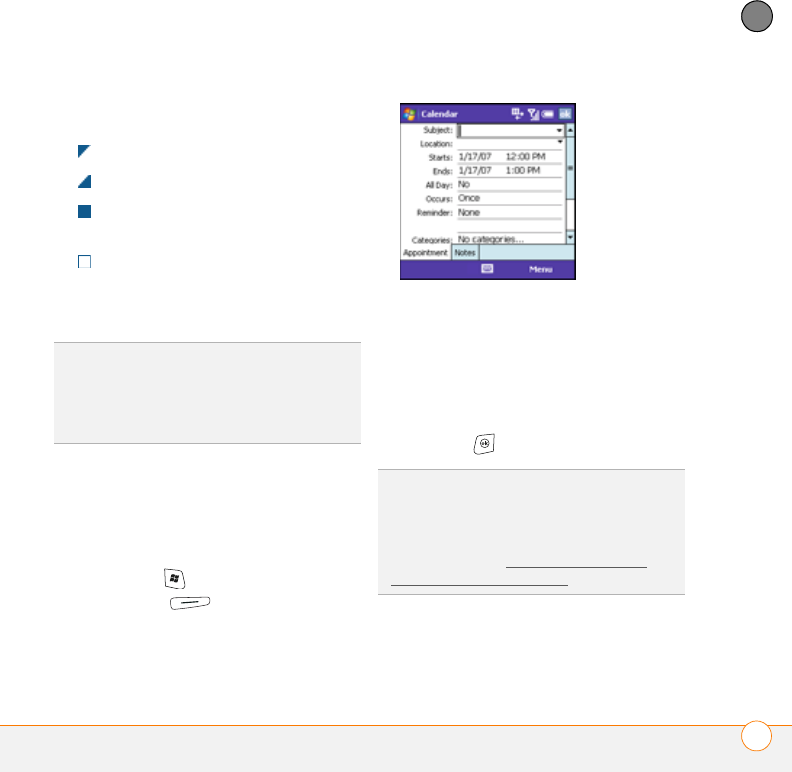
YOUR PERSONAL INFORMATION ORGANIZER
CALENDAR 177
10
CHAPTER
Month: Shows your schedule for a
whole month.
A morning appointment
An afternoon appointment
Both morning and evening
appointments
An all-day event
Year: Shows a calendar for a six-month
period.
4Use the 5-way to move to another day,
week, month, or year (depending on the
current view).
Creating an appointment
1Press Start and select Calendar.
2Press Menu (right action key)
and select New Appointment.
3Enter a subject (description) and a
location.
4Select Starts and select the starting
date and time.
5Select Ends and select the ending date
and time.
6Press OK .
TIP
To switch views, press the left action key.
Don’t confuse the view name displayed above
the left action key with the current view. The
left action key displays the name of the next
view you see when you press the key.
TIP
To “pencil in” an appointment, open the
appointment, select Status, and then select
Te n t a t i v e .
TIP
You can display your appointments on your
Today screen (see Selecting which items
appear on your Today screen).
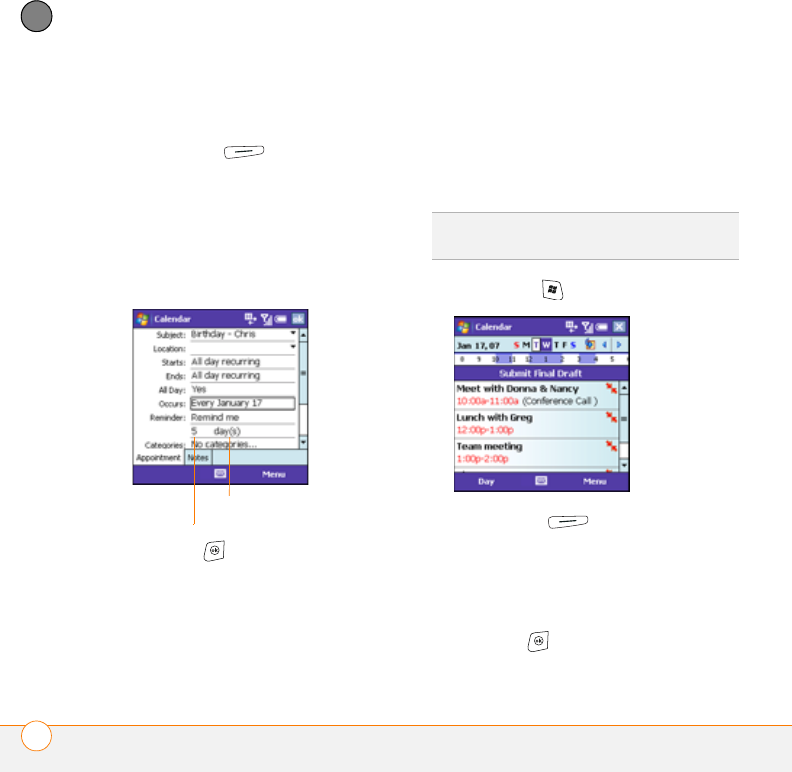
YOUR PERSONAL INFORMATION ORGANIZER
CALENDAR
178
10
CHAPTER
Adding an alarm reminder to an event
1Create an event and then select it.
2Press Menu (right action key)
and select Edit.
3Select Reminder and then select
Remind Me.
4Enter the number of minutes, hours,
days, or weeks before the event you
would like to receive the alarm.
5Press OK .
Creating an untimed event
An untimed event, such as a birthday,
anniversary, or vacation, does not occur at
a particular time of day. These events
appear as banners at the top of your
calendar; they don’t occupy blocks of time.
For example, “Submit Final Draft” in the
screenshot shown below is an untimed
event.
1Press Start and select Calendar.
2Press Menu (right action key)
and select New Appointment.
3Enter a subject (description).
4Select the starting and ending dates.
5Select All Day, and then select Ye s .
6Press OK .
Type of time units
Number of time units
DID
YOU
KNOW
?
An untimed event can last longer
than a day.

YOUR PERSONAL INFORMATION ORGANIZER
CALENDAR 179
10
CHAPTER
Scheduling a repeating appointment
1Create an appointment or untimed
event, and then select it.
2Press Menu (right action key)
and select Edit.
3Select Occurs, and then select a repeat
pattern. To create a repeat pattern,
select Edit pattern and follow the
onscreen instructions.
4Press OK .
Sending a meeting request
You can email meeting invitations to
contacts who use Microsoft Office
Outlook® or Outlook Mobile.
BEFORE YOU BEGIN Create contact
entries with email addresses for the people
you want to invite to a meeting. You can’t
access contact entries without email
addresses from your calendar.
1Create an event, and then select it.
2Press Menu (right action key)
and select Edit.
3Select Attendees. Select Add
Required Attendees, and then select
the name of the contact you want to
invite. To invite other attendees, select
Add Required Attendees, and then
select the names.
4(Optional) To invite optional attendees,
select Add Optional Attendees, and
then select the names.
5 Press OK .
The next time you synchronize, the
meeting request is sent to the attendees.
When attendees accept your meeting
request, the meeting is automatically
added to their schedules. When you
receive their response, your calendar is
updated as well.
TIP
To enter a birthday or an anniversary, create
an untimed event that repeats every year.
DID
YOU
KNOW
?
If you are using Exchange Server
2007 or Exchange Server 2003 with Service
Pack 2, you can use your corporate Global
Address List to find contact information for an
attendee. Select Attendees, press Menu
(right action key), and then select Find
Online. Enter the name of the attendee and
select Find.

YOUR PERSONAL INFORMATION ORGANIZER
CALENDAR
180
10
CHAPTER
Replying to a meeting request
You receive and reply to meeting requests
in the Inbox application (see Working with
meeting invitations). If you accept or
tentatively accept an invitation, it shows up
as an appointment in your Calendar.
Marking an event as sensitive
If other people have access to your
Microsoft Office Outlook calendar on your
computer and you don’t want them to see
an appointment, you can mark that
appointment as private to hide it from other
Microsoft Office Outlook users.
1Create an event, and then select it.
2Press Edit (left action key).
3Select Sensitivity, and then select one
of the following:
Personal: Displays the event on your
smartphone and on your computer.
Meeting attendees or recipients see
“Please treat this as Personal” near the
top of an open appointment.
Private: Displays the event on your
smartphone and on your computer.
Meeting attendees or recipients see
“Please treat this as Private” near the
top of an open appointment. If you sync
with an Exchange server, other users
who can access your folders can’t see
your private events; they see private
events as unavailable time slots.
Confidential: Displays the event on
your smartphone and on your computer.
Meeting attendees or recipients see
“Please treat this as Confidential” near
the top of an open appointment.
4Press OK .
Organizing your schedule
Use categories to view various types of
events.
1Create an event, and then select it.
2Press Menu (right action key)
and select Edit.
3Select Categories, and then check the
categories that apply to this event.
TIP
If you don’t see an option on the screen,
press Down on the 5-way to scroll to other
options. For example, when editing an event,
you don’t see the Sensitivity option until you
scroll toward the bottom of the entry.
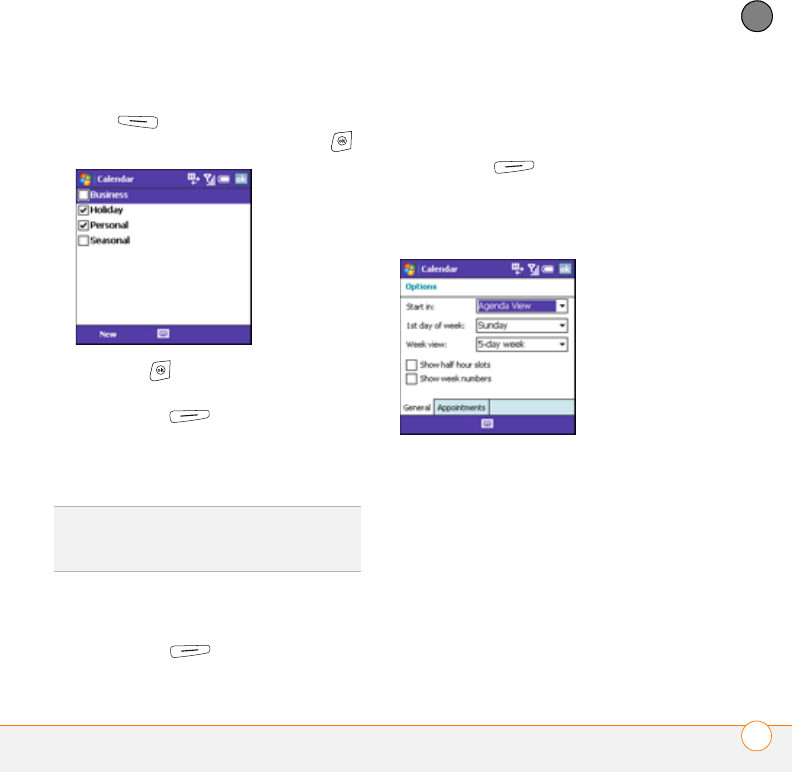
YOUR PERSONAL INFORMATION ORGANIZER
CALENDAR 181
10
CHAPTER
To add a new category, press
New (left action key), enter the
category name, and then press OK .
4Press OK two more times.
5After you assign events to categories,
press Menu (right action key)
and select Filter.
6Select the type of events you want to
view.
Deleting an event
1Highlight the event you want to delete.
2Press Menu (right action key)
and select Delete Appointment.
3Select Ye s to confirm the deletion.
Customizing Calendar
1Press Menu (right action key)
and select To o l s > Options.
2On the General tab, set any of the
following options:
Start in: Specifies which view is
displayed when you open Calendar.
1st day of week: Specifies Sunday or
Monday as the first day of the week for
all Calendar views.
Week view: Specifies whether five, six,
or seven days appear in Week View.
Show half hour slots: Specifies
whether time slots appear in hour or
TIP
Wonder why you’re not seeing all the
events in your day? Check to make sure that
the filter is set to All Appointments.
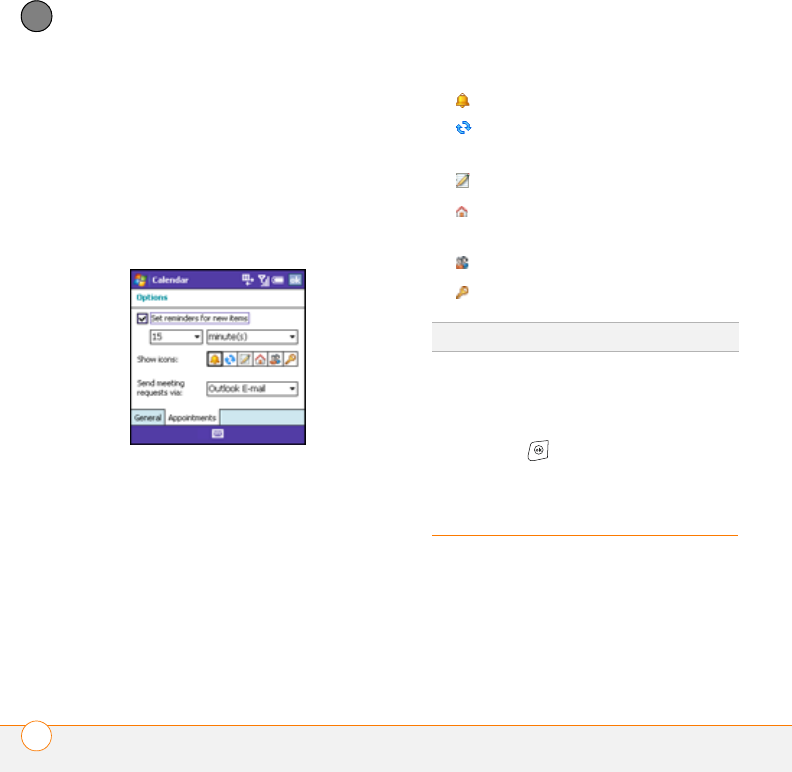
YOUR PERSONAL INFORMATION ORGANIZER
TASKS
182
10
CHAPTER
half-hour increments in Day View and
Week View.
Show week numbers: Specifies
whether week numbers (1–52) appear
in Week View.
3Select the Appointments tab and set
any of the following options:
Set reminders for new items:
Specifies whether a reminder is
automatically added to new events and
how long before the event the reminder
appears. You can override this setting
for individual events.
Show icons: Specifies which icons
appear next to events.
The event has a reminder.
The event repeats in a specified
pattern.
The event has a note attached.
A location has been assigned to the
event.
The event is a meeting.
The event is marked private.
Send meeting requests via: Specifies
the email account used to send meeting
requests.
4Press OK .
Tasks
You can use Tasks to remind you of tasks
you need to complete and to keep a record
of completed tasks.
TIP
Not all icons appear in all Calendar views.
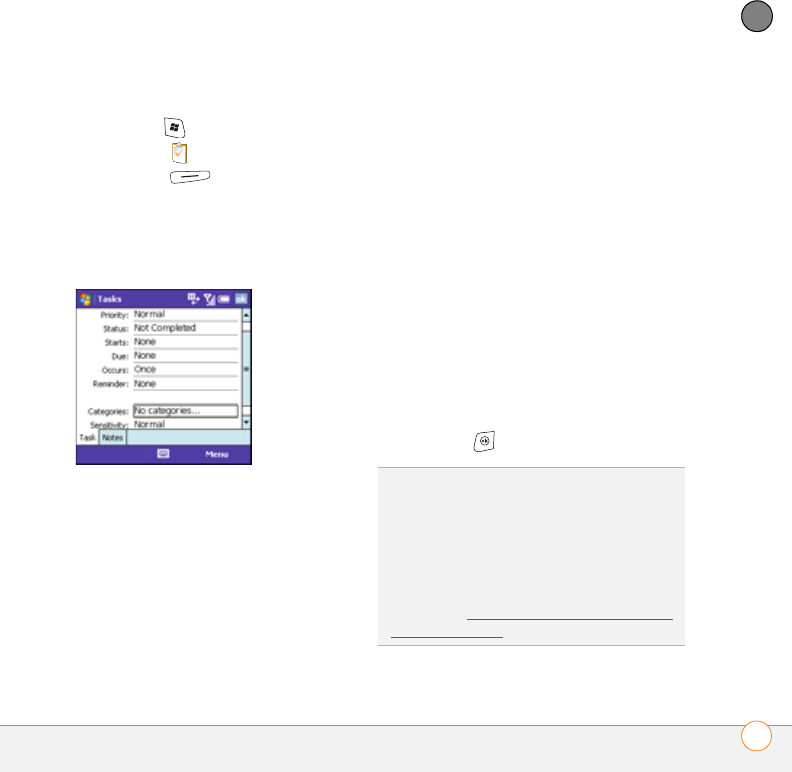
YOUR PERSONAL INFORMATION ORGANIZER
TASKS 183
10
CHAPTER
Adding a task
1Press Start and select Programs.
2Select Ta s k s .
3Press Menu (right action key)
and select New Task.
4Enter a description of the task in the
Subject field.
5Set any of the following:
Priority: Specifies the priority level for
this task. Later you can arrange your
tasks based on the importance of each
task.
Status: Indicates whether the task is
now completed.
Starts: Specifies when the task begins.
Due: Specifies the due date for the
task.
Occurs: Indicates if the task repeats at
regular intervals and how often it
repeats.
Reminder: Sets an alarm for this task
and indicates when you want to be
reminded.
Categories: Assigns the task to one or
more categories.
Sensitivity: Marks this task as Normal,
Personal, Private, or Confidential.
Notes: Enables you to enter additional
text for the task.
6Press OK .
TIP
You can also add a task by selecting the
Tasks entry bar at the top of the task list
screen, entering the task description, and
tapping anywhere outside of the entry bar.
Select the icons to the left of the bar to set
the task as high or low priority.
TIP
You can display your tasks on your Today
screen (see Selecting which items appear on
your Today screen).
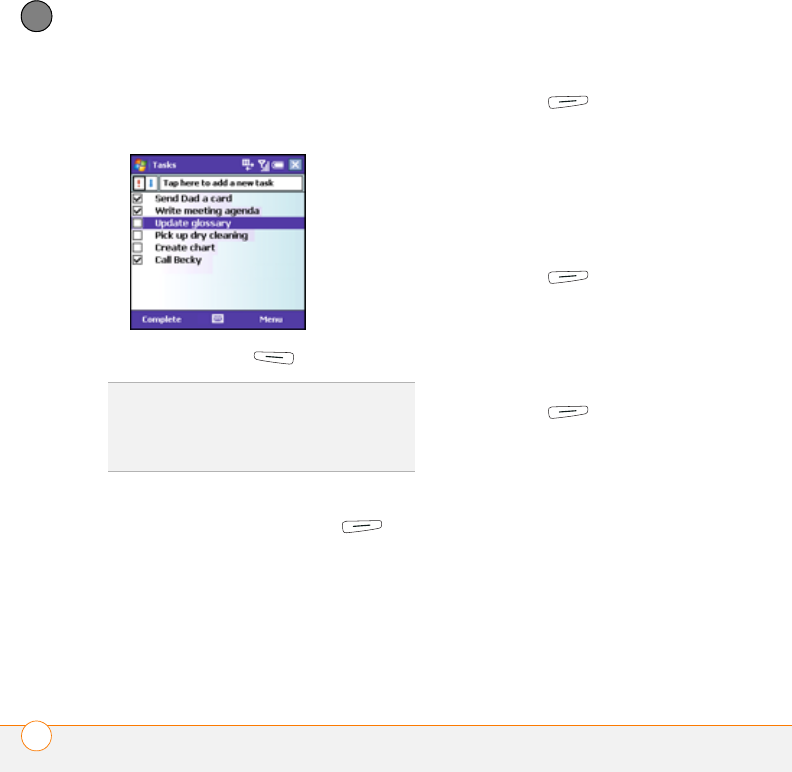
YOUR PERSONAL INFORMATION ORGANIZER
TASKS
184
10
CHAPTER
Checking off a task
1Highlight the task you want to check off.
2Press Complete (left action key).
Organizing your tasks
1In the Tasks list, press Menu
(right action key) and select Filter.
2Select which tasks you want to view:
All Tasks, Recently Viewed,
No Categories, Active Tasks,
Completed Tasks, or a specific
category, such as Business or Personal.
3Press Menu (right action key)
and select Sort By.
4Select the sort method: Status,
Priority, Subject, Start Date, or
Due Date.
Deleting a task
1Highlight the task you want to delete.
2Press Menu (right action key)
and select Delete Task.
3Select Ye s to confirm the deletion.
Customizing Tasks
1Go to the Tasks list.
2Press Menu (right action key)
and select Options.
3Set any of the following options:
Set reminders for new items:
Automatically adds a reminder to new
tasks. The default reminder is set to
8:00 on the morning the task is due. You
can override this setting for individual
tasks.
Show start and due dates: Displays
task start and due dates in the Tasks
list.
TIP
You can also mark a task complete by
tapping the check box next to the task on the
Tasks list.
DID
YOU
KNOW
?
Overdue tasks appear in red.
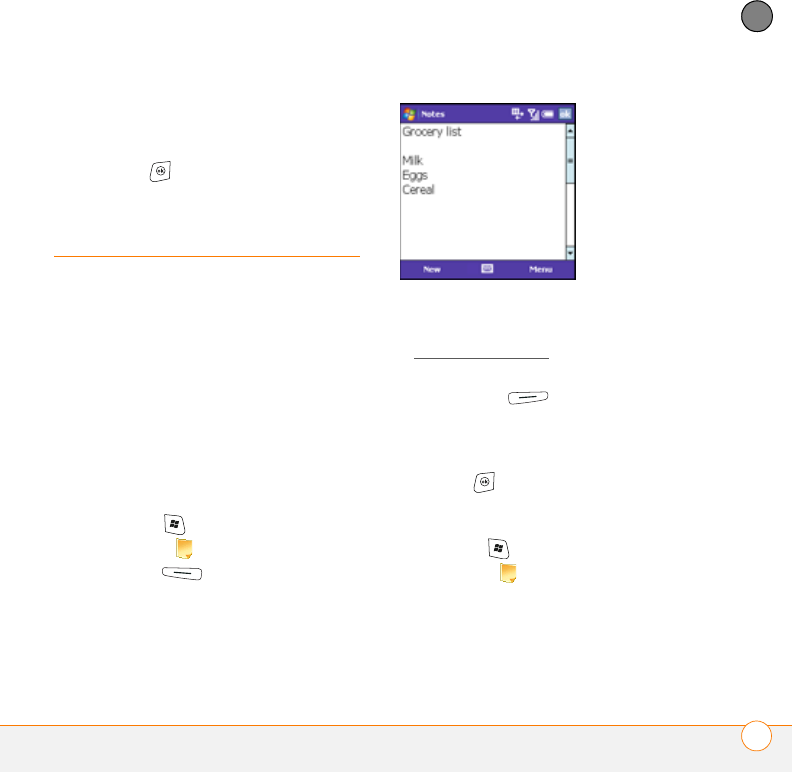
YOUR PERSONAL INFORMATION ORGANIZER
NOTES 185
10
CHAPTER
Show Tasks entry bar: Displays the
Tasks entry bar at the top of the Tasks
list.
4Press OK .
Notes
Notes are a great way to capture thoughts,
questions, and meeting notes on your
smartphone. You can also create a voice
note or add a recording to an existing note.
BEFORE YOU BEGIN To take advantage of
all the sync features available in the Notes
application, install ActiveSync desktop
synchronization software from your
Windows Mobile Getting Started CD.
Creating a note
1Press Start and select Programs.
2Select Notes .
3Press New (left action key).
4Do one of the following:
•Type the text with the keyboard.
•If you turned on writing mode (see
Customizing Notes), write the text
with the stylus.
•Press Menu (right action key),
select Draw, and then draw a sketch
with the stylus, crossing at least three
ruled lines.
5Press OK .
Creating a voice note
1Press Start and select Programs.
2Select Notes .
3To add a voice recording to an existing
note, open the note to which you want
to add the recording.
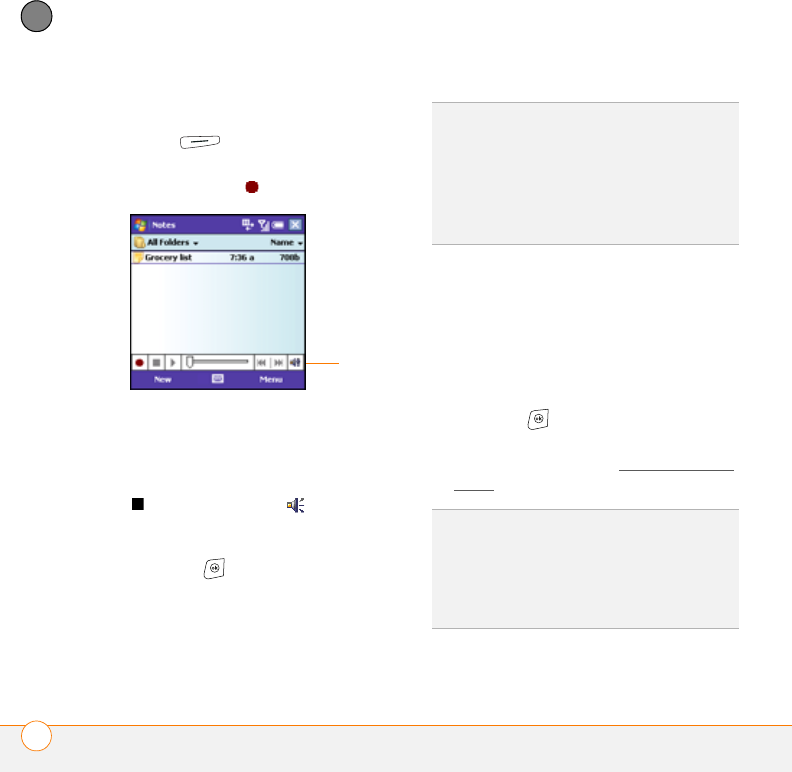
YOUR PERSONAL INFORMATION ORGANIZER
NOTES
186
10
CHAPTER
4If the voice note controls are not visible
at the bottom of the screen, press
Menu (right action key) and
select View Recording Toolbar.
5Tap the Record icon.
6Speak into the microphone on your
smartphone, or hold it close to another
sound source.
7When you finish recording, tap the Stop
icon. A Recording icon appears
in the note or note list, depending on
where you recorded the note.
8Press OK .
Creating a note from a template
1Go to the Notes list.
2Tap the Show list in the upper-left, and
then select Te m p l a t e s .
3Open the template you want to use.
4Enter the information.
5Press OK .
6Rename the note and move it to the
appropriate folder. See Organizing your
notes for details.
Voice
note
controls
DID
YOU
KNOW
?
You can add several voice notes
within a single note.
TIP
To play a recording, select the voice note in
the Notes list or open the note containing the
recording and tap the Recording icon. Tap the
controls at the bottom of the screen to control
playback and volume.
TIP
To create a new template, open the note
you want to save as a template. Press Menu
(right action key) and select Rename/Move.
Select Name, and then enter a name for the
template. Tap the Show list, select Template,
and press OK.

YOUR PERSONAL INFORMATION ORGANIZER
NOTES 187
10
CHAPTER
Organizing your notes
You can rename your notes, move notes to
another folder, and move notes between
your smartphone and an expansion
(storage) card.
1Go to the Notes list and highlight a note
you want to move.
2Press Menu (right action key)
and select Rename/Move.
3Select Name and enter a new name for
the note.
4Select Folder, and then select the folder
in which you want to store the note.
5Select Location, and then select Main
memory or Storage Card.
6Press OK .
Deleting a note
1Go to the Notes list and highlight the
note you want to delete.
2Press Menu (right action key)
and select Delete.
3Select Ye s to confirm the deletion.
Customizing Notes
1Go to the Notes list.
2Press Menu (right action key)
and select Options.
3Set any of the following options:
Default mode: Makes the default entry
mode either Writing or Typing. The
default is Typing; if you change it to
Writing, you can write notes directly on
the screen using the stylus.
Default template: Specifies the default
template for new notes.
Save to: Indicates the default location
where new notes are stored.
Record button action: Specifies what
happens when you press the Side
button to record a voice note while in
another application: whether the Notes
application opens or whether you stay
in the current application.
TIP
To create a new folder, go to the Notes list,
tap the Show list in the upper-left, and then
select Add/Delete. Select New, enter a name
for the folder, and then press OK.
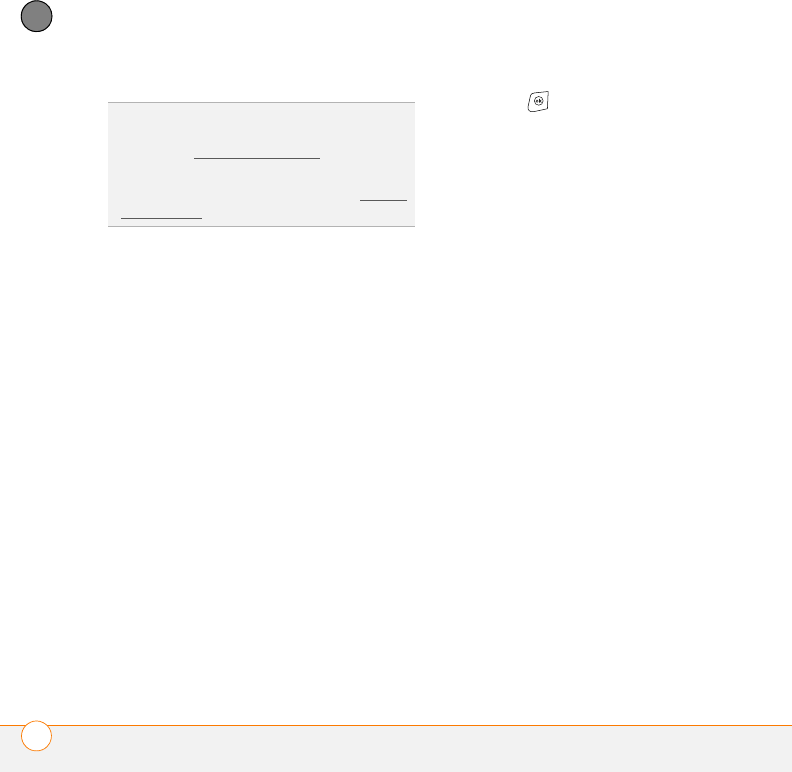
YOUR PERSONAL INFORMATION ORGANIZER
NOTES
188
10
CHAPTER
4Press OK .
TIP
To use the Record button action feature,
you need to assign the Side button to open
Notes. See Reassigning buttons.
TIP
Tap Global Input Options to set options
for entering text in any application (see Setting
input options).

CHAPTER
11
Your Microsoft Office and
other document tools
You r Palm ® Treo™800W smartphone enables you to take your
office with you—including your Microsoft Office files. With
Microsoft Office, you can carry, create, view, and edit Microsoft
Word and Excel files directly on your smartphone. You can also
view, carry, and manage PowerPoint files on your smartphone.
You can keep updated copies of the files on both your
smartphone and your computer so that you can work on them
in the most convenient location at any time.
You can also use PDF Viewer to view PDF files on your
smartphone.
Benefits
•Manage Word, Excel, and
PowerPoint files on your
smartphone
•Improve productivity by taking
important docs, spreadsheets, and
presentations with you
•Work with PDF files

In this chapter
Synchronizing your Microsoft Office files. . . . . . . . . . . . . . . . . . . . . 191
Word Mobile . . . . . . . . . . . . . . . . . . . . . . . . . . . . . . . . . . . . . . . . . . 193
PowerPoint Mobile . . . . . . . . . . . . . . . . . . . . . . . . . . . . . . . . . . . . . . 199
Excel Mobile. . . . . . . . . . . . . . . . . . . . . . . . . . . . . . . . . . . . . . . . . . . 200
PDF Viewer . . . . . . . . . . . . . . . . . . . . . . . . . . . . . . . . . . . . . . . . . . . 211
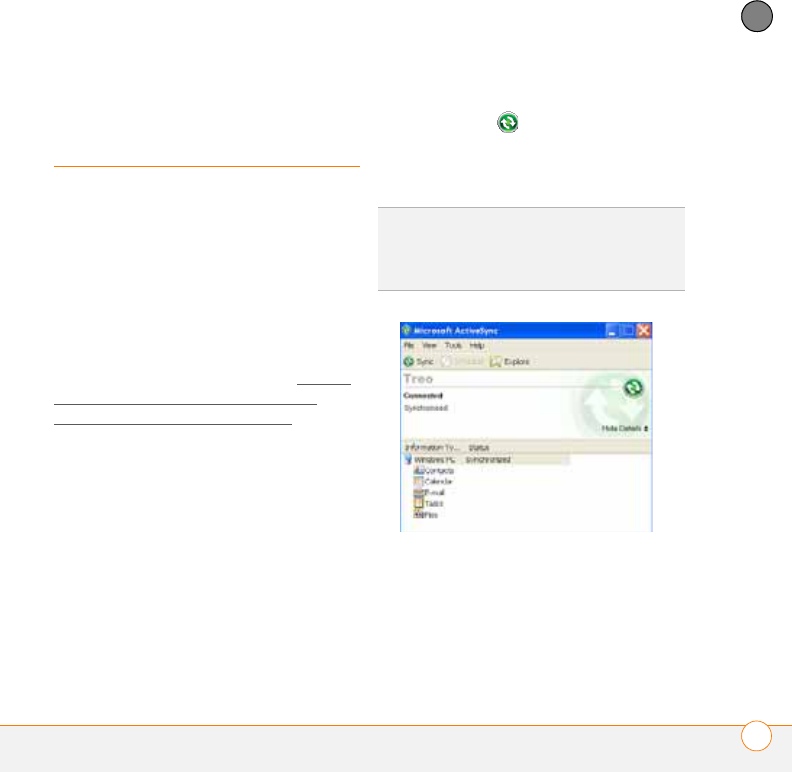
YOUR MICROSOFT OFFICE AND OTHER DOCUMENT TOOLS
SYNCHRONIZING YOUR MICROSOFT OFFICE FILES 191
11
CHAPTER
Synchronizing your
Microsoft Office files
You can create and edit Microsoft Office
files on your computer or on your
smartphone and then synchronize the files
so that changes you make show up on both
your computer and your smartphone. To
synchronize Microsoft Office files, you
must first choose Files as one of your
synchronization options on your
smartphone if you did not do so during
desktop software installation; see Setting
up your computer for synchronization and
Changing which applications sync.
The procedure for synchronizing files is
different for computers running Windows
XP and computers running Windows Vista.
Synchronizing files: Windows XP
1Connect your smartphone to your
computer with the USB sync cable.
NOTE Most ActiveSync desktop software
options are available only when your
smartphone is connected to your
computer.
2On your computer, double-click the
ActiveSync® icon in the taskbar in
the lower-right corner of your computer
screen to open the ActiveSync desktop
software window.
3Under Information Type, double-click
Files to view a list of all synchronized
files.
TIP
If the ActiveSync icon does not appear in
the taskbar, go to Start, navigate to
Programs, and then select Microsoft
ActiveSync to open the ActiveSync window.

YOUR MICROSOFT OFFICE AND OTHER DOCUMENT TOOLS
SYNCHRONIZING YOUR MICROSOFT OFFICE FILES
192
11
CHAPTER
4Do any of the following:
•To delete a file from the file sync
folder on your computer and from
your smartphone, highlight the file
name and click Remove.
•To copy a file from your computer to
your smartphone, click Add, browse
to and highlight the file, and then click
Open.
NOTE If you receive an error while
synchronizing files, make sure that all of
the files you’re trying to sync are closed on
both your computer and on your
smartphone.
Synchronizing files: Windows Vista
1On your computer, copy or save the file
to the Documents\Documents on
username’s Smartphone folder.
2Connect your smartphone to your
computer with the USB sync cable.
Synchronization takes place
automatically.
Where are the changes I made to my file?
Don't look for the changed file in its original
location on your computer. Only the
synchronized version contains the changes,
and that version is in the ActiveSync file
sync folder. To find this folder, do one of
the following:
Windows XP: On your computer desktop,
double-click the file sync folder icon. This is
a shortcut to the file sync folder.
Windows XP: In ActiveSync desktop
software, double-click Files. The location of
the file sync folder appears in the File
Synchronization Settings dialog box (under
On this computer, synchronize the files in
this folder).
Windows Vista: Open the Documents\
Documents on username’s Smartphone
folder.
On your smartphone, you can find the
synchronized file by doing either of the
following:
TIP
If Files doesn’t appear under Information
Type, open the Tools menu and select
Options. Make sure the Files box is checked.
DID
YOU
KNOW
?
The Documents on username’s
Smartphone folder is created when you select
the option to sync Files.
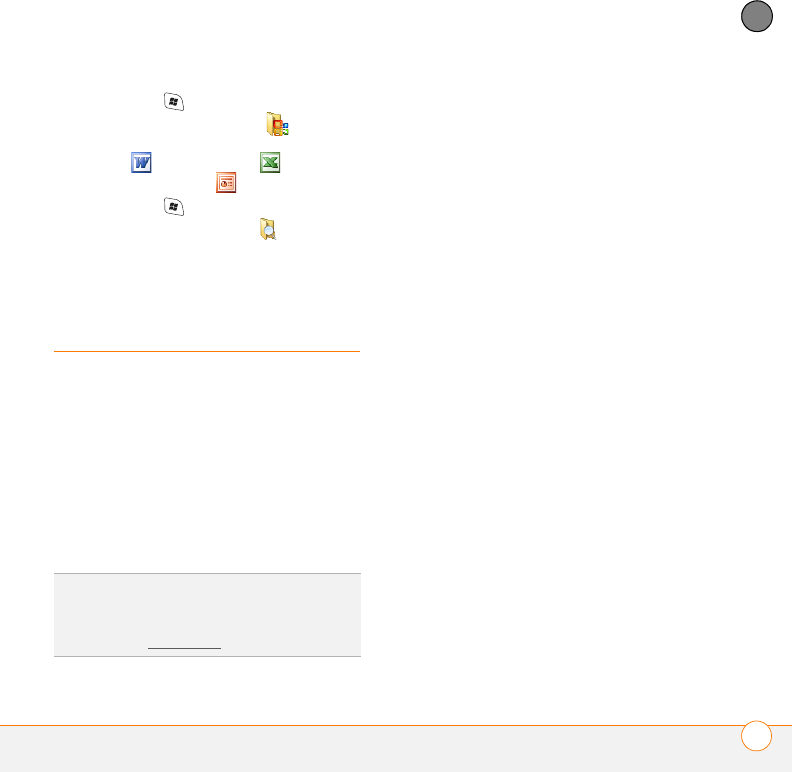
YOUR MICROSOFT OFFICE AND OTHER DOCUMENT TOOLS
WORD MOBILE 193
11
CHAPTER
•Press Start , select Programs, and
then select Office Mobile . Select
the application that opens the file: Word
Mobile , Excel Mobile , or
PowerPoint Mobile .
•Press Start , select Programs, and
then select File Explorer . Tap the
Show list in the upper-left and select
My Device > My Documents.
Word Mobile
You can create and edit documents and
templates and save them as DOC, RTF,
TXT, and DOT files. You can also edit
Microsoft Office Word documents and
templates that you create on your
computer. However, keep in mind that
some of the information and formatting
may be lost when you save the document
on your smartphone.
The following features are not supported in
Word Mobile:
•Backgrounds.
•Bidirectional text.
•Document protection.
•Metafiles.
•Artistic page borders. Lined page
borders are supported.
•Password-protected files. Remove
password protection on your computer
before opening the file on your
smartphone.
•Shapes and text boxes.
•Smart tags.
The following features are partially
supported in Word Mobile:
Picture bullets. Regular bullets are
supported.
Revision marks. Documents appear as
though all revisions were accepted; if the
document is saved, revision marks are lost.
Table styles. Some or all of the
formatting is lost if the document is saved.
DID
YOU
KNOW
?
If you have a PDF file (.pdf), you
can view the file using PDF Viewer. Press
Start, select Programs, and then select PDF
Viewer (see PDF Viewer).
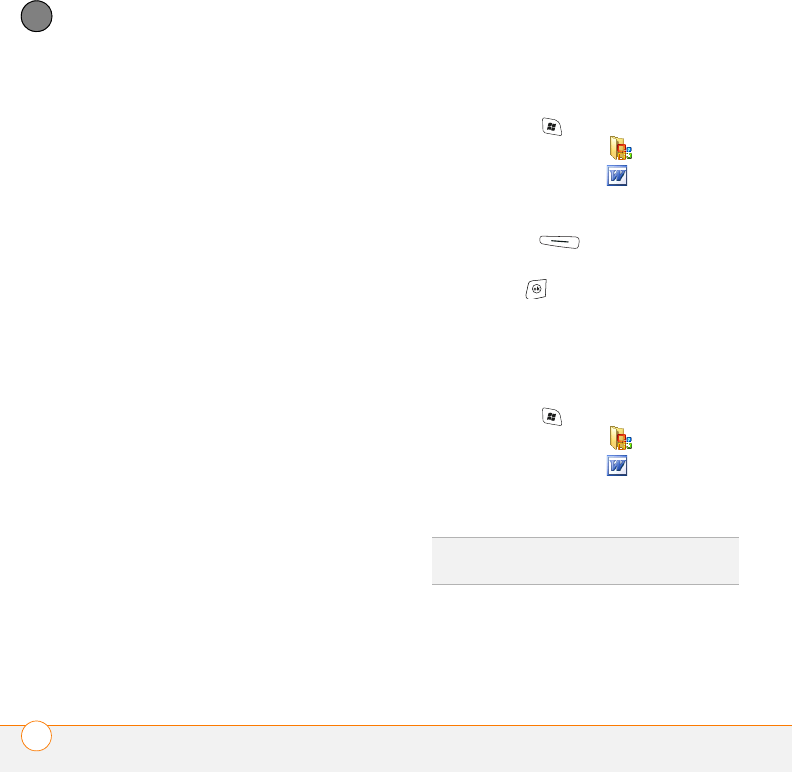
YOUR MICROSOFT OFFICE AND OTHER DOCUMENT TOOLS
WORD MOBILE
194
11
CHAPTER
Underline styles. Unsupported styles
are mapped to one of the four supported
styles: regular, dotted, wavy, or thick/bold/
wide.
Legacy Pocket Word files. You can open
PSW files, but if you edit a file, you need to
save it in DOC, RTF, TXT, or DOT format.
The following features are not supported
on your smartphone, but they remain in the
file so that when you open the file on your
computer, they appear as expected:
Fonts and font sizes. Original fonts are
listed on your smartphone and are mapped
to the closest font available.
Footnotes, endnotes, headers, and
footers.
Lists. Indented lists are mapped to the
closest indentation level supported by
Word Mobile.
Page breaks. Although not displayed, all
page breaks, except a break placed at the
end of a document, are retained in the
document.
Creating a document
1Press Start and select Programs.
2Select Office Mobile .
3Select Word Mobile .
4The first time you open Word Mobile, a
new document opens. Otherwise,
press New (left action key).
5Enter the text of the document.
6Press OK to save the file. When you
save a new document, it is
automatically named after the first
several words in the file.
Opening an existing document
1Press Start and select Programs.
2Select Office Mobile .
3Select Word Mobile .
4In the document list, select the
document you want to open.
TIP
To zoom in or out, press View, select
Zoom, and then select the zoom level.

YOUR MICROSOFT OFFICE AND OTHER DOCUMENT TOOLS
WORD MOBILE 195
11
CHAPTER
Creating a document from a template
1Go to the documents list.
2Tap the Show list in the upper-left and
select Te m p l a t e s . If you don’t see
Templates in the Show list, select More
Folders to access this folder.
3Open the template you want to use.
4Press Menu (right action key)
and select File > Save As.
5Select Name and enter a new name for
the file.
6Select the Folder list, and then select
the folder where you want to save the
file.
7Select the Ty p e list, and then select the
format in which you want to save the
file.
8Select the Location list, and then select
Main Memory or Storage Card.
9Select Save.
Finding or replacing text in a document
1Open the document containing the text
you want to find.
2Press Menu (right action key)
and select Edit > Find/Replace.
3Select Find what and enter the text you
want to find.
4(Optional) Check the Match case box to
find text that matches the capitalization
in the text you entered step 3.
5(Optional) Check the Match whole
words only box to find only full words
that match the text you entered in
step 3.
6Select Find to locate the first instance
of the text you entered in step 3, or
select Replace and enter the
replacement text.
7Select Next to find the next instance of
the text, or select Replace to replace it.
To replace all instances of the text,
select Replace All.
8When you see a message that the
search is done, press OK .
TIP
To create a new template, open the
document you want to save as a template.
Press Menu (right action key) and select File
> Rename/Move. Select Name and enter a
name for the template. Select Folder, and
then select Template. Press OK.

YOUR MICROSOFT OFFICE AND OTHER DOCUMENT TOOLS
WORD MOBILE
196
11
CHAPTER
Moving or copying text
1Open the document containing the text
you want to move or copy.
2Highlight the text you want to move or
copy.
3Press Menu (right action key)
and select Copy to copy the text, or
select Cut to move the text.
4Open the document where you want to
insert the text and position the cursor
where you want the text to appear.
5Press Menu (right action key)
and select Paste.
Saving a copy of a document
NOTE If a document was previously saved
on a computer, any unsupported formatting
may be lost when you save the file.
1Open the document you want to copy.
2Press Menu (right action key)
and select File > Save As.
3Select Name and enter a new name for
the file.
4Select the Folder list, and then select
the folder where you want to save the
file.
5Select the Ty p e list, and then select the
format in which you want to save the
file.
6Select the Location list, and then select
whether you want to store the file on
your smartphone (Main memory) or on
an expansion card (Storage card).
7Select Save.
Formatting text
1Open the document you want to
format.
2Highlight the text you want to format.
3Press Menu (right action key)
and select Format > Font.
4Set any of the following options for the
highlighted text:
Font: Specifies the typeface.
Font color: Specifies the color.
Size: Specifies the point size.
Bold: Indicates whether the text
appears normal or thick.

YOUR MICROSOFT OFFICE AND OTHER DOCUMENT TOOLS
WORD MOBILE 197
11
CHAPTER
Italics: Indicates whether the text
appears upright or slanted.
Underline: Indicates whether the text
appears with an underscore.
Highlight: Indicates whether the text
appears with a yellow highlight.
Strikethrough: Indicates whether the
text appears with a line through it.
5Press OK to return to the document.
Formatting paragraphs and lists
1Open the document you want to
format.
2Position the cursor in the paragraph you
want to format.
3Press Menu (right action key)
and select Format > Paragraph.
4Set any of the following options:
Alignment: Aligns the text paragraph
with the left, right, or center of
the page.
List: Creates a bulleted or numbered
list.
Indentation: Changes the paragraph
margins.
•Left: Sets the left margin for the
entire paragraph.
•Right: Sets the right margin for the
entire paragraph.
•Special: Lets you indent the first line
or set a hanging indent.
•By: Sets the size of the special
indentation.
5Press OK to return to the document.
Checking spelling in a document
1Open the document you want to check.
2Press Menu (right action key) and
select To o l s > Spelling. To check the
spelling of specific text, highlight it
before you select the Spelling
command.
3If an unknown or misspelled word is
encountered, do one of the following:
TIP
You can also use the Formatting toolbar to
create a list and to align text. To indent text in
lists, you must use the Formatting toolbar.

YOUR MICROSOFT OFFICE AND OTHER DOCUMENT TOOLS
WORD MOBILE
198
11
CHAPTER
•Select the correct word in the list if
the word is spelled incorrectly.
•Select Ignore if the word is spelled
correctly.
•Select Add to add a new word to the
spelling dictionary.
Organizing your documents
You can rename your documents, move
your documents to another folder, and
move your documents between your
smartphone and an expansion card.
1Go to the documents list.
2Highlight a file.
3Press Menu (right action key)
and select Rename/Move.
4Select Name and enter a new name for
the document.
5Select the Folder list, and then select
the folder to which you want to move
the document.
6Select the Location list, and then select
Main memory or Storage card.
7Press OK .
Deleting a document
1Go to the documents list.
2Highlight the document you want to
delete.
3Press Menu (right action key)
and select Delete.
4Select Ye s to confirm the deletion.
Customizing Word Mobile
1Go to the document list.
2Press Menu (right action key)
and select To o l s > Options.
3Set any of the following options:
Default template: Sets the default
template for new documents.
Save to: Sets the default location
where new documents are stored.
TIP
To create a new folder, go to the
documents list, tap the Show list in the
upper-left and select Add/Delete. Select
New, enter a name for the folder, and then
press OK.
TIP
When you go to a folder, you can easily
search your documents by sorting by type.

YOUR MICROSOFT OFFICE AND OTHER DOCUMENT TOOLS
POWERPOINT MOBILE 199
11
CHAPTER
Display in list view: Sets the types of
files that appear in the documents list.
4Press OK .
PowerPoint Mobile
With PowerPoint Mobile, you can open and
view slide show presentations created on
your computer. Many presentation
elements such as slide transitions,
animations, and URL links are also
supported. Microsoft Office PowerPoint®
features not supported on your
smartphone include the following:
•Notes written for slides
•Rearrangement or editing of slides
•Files created in PPT format earlier than
Microsoft PowerPoint 97
•HTML files in HTM and MHT formats
Playing a presentation
NOTE If a presentation is set up as a timed
slide show, the slides advance
automatically. Presentations pause during
zooming.
1Press Start and select Programs.
2Select Office Mobile .
3Select PowerPoint Mobile .
4In the presentation list, highlight the
presentation you want to play.
5Press Center .
6Do any of the following:
•Press Right to advance to the next
slide or Left to view the previous
slide.
•Press Menu (right action key),
select Go to Slide, and then select
the slide you want to view.
•Select Next or Previous to play
animations.
•Press Menu (right action key),
select Zoom In, and then select to
zoom in or to zoom out. To scroll
within the current slide, tap and drag
the slide. To return to the slide show,
select .
•Press Menu (right action key)
and select End Show.

YOUR MICROSOFT OFFICE AND OTHER DOCUMENT TOOLS
EXCEL MOBILE
200
11
CHAPTER
Setting presentation playback options
1Open the presentation for which you
want to change the settings.
2Press Menu (right action key)
and select Set up show.
3On the Orientation tab, select the
orientation you want. To select the
orientation that best fits your
smartphone screen, select Default.
4Select the Playback tab, and check the
Override playback options for all files
box.
5Set any of the following options:
Show without animation: Tur ns off
builds and other animations.
Show without slide transition: Turn s
off transition effects between slides.
Use timings, if present: Enables the
timings recorded with each slide in a
presentation. If a presentation is set up
as a timed slide show, the slides
advance automatically. Presentations
pause during zooming.
Loop continuously: Advances to the
first slide after playing the last slide in a
presentation.
6Press OK .
Excel Mobile
With Excel Mobile you can create and edit
workbooks and templates on your
smartphone. You can also edit workbooks
and templates that you create on your
computer. However, keep in mind that you
may lose some of the information and
formatting when you save the workbook on
your smartphone.
Note the following formatting
considerations:
Alignment: Vertical text appears
horizontal.
Borders: Appear as a single line.
Cell patterns: Patterns applied to cells are
removed.
TIP
To turn the presentation into a continuously
looping slide show, check both the Use slide
timings, if present, and the Loop
continuously boxes.

YOUR MICROSOFT OFFICE AND OTHER DOCUMENT TOOLS
EXCEL MOBILE 201
11
CHAPTER
Fonts and font sizes: The original font is
listed on your smartphone and mapped to
the closest font available. Original
fonts reappear on your computer.
Number formats: Microsoft Office Excel®
97 conditional formatting is displayed in
Number format.
Formulas and functions: Unsupported
functions are removed, and only the
returned value of the function appears.
Formulas containing the following are also
converted to values:
•An array or array argument, for example,
=SUM({1;2;3;4})
•External link references or an
intersection range reference
•References past row 16384 are
replaced with #REF!
Protection settings: Most protection
features are disabled but not removed.
However, password protection is removed.
You must remove the password protection
in Microsoft Office Excel on your computer
before opening the file on your
smartphone.
Zoom settings: Worksheet-specific zoom
settings are not retained. The zoom setting
applies to the entire workbook.
Worksheet names: Names that refer to
other workbooks, arrays, array formulas, or
intersection ranges are removed from the
name list, causing those formulas to be
resolved as “#NAME?” All hidden names
are not hidden.
AutoFilter Settings: AutoFilters that cause
rows to be hidden are supported. Use the
Unhide command to display hidden rows.
Other AutoFilters are removed, but you can
use the AutoFilter command in Excel
Mobile to perform similar functions.
Chart Formatting: All charts are saved as
they appear in Excel Mobile. Unsupported
chart types are changed to one of these
supported types: Column, Bar, Line, Pie,
Scatter, and Area. Background colors,
gridlines, data labels, trend lines, shadows,
3D effects, secondary axes, and
logarithmic scales are turned off.
The following features aren’t supported in
Excel Mobile and are removed or modified
when you open a workbook on your
smartphone:
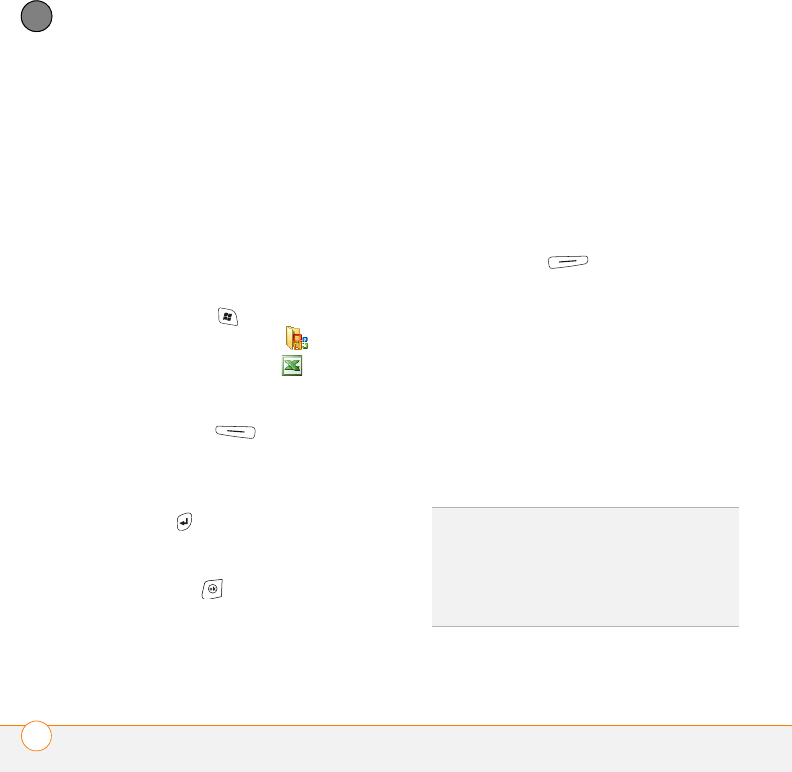
YOUR MICROSOFT OFFICE AND OTHER DOCUMENT TOOLS
EXCEL MOBILE
202
11
CHAPTER
•Hidden, dialog, and macro sheets
•VBA modules
•Text boxes
•Drawing objects and pictures
•Lists
•Conditional formats and controls
•Pivot table data (converted to values)
Creating a workbook
1Press Start and select Programs.
2Select Office Mobile .
3Select Excel Mobile .
4The first time you open Excel Mobile, a
new workbook appears. Otherwise,
press New (left action key).
5Highlight a cell where you want to enter
text or other info.
6Enter the info in the cell, and then press
Enter .
7Repeat steps 4 and 5 to enter the
remaining info.
8Press OK to save the file. When you
save a new workbook, it is automatically
named and placed in the workbook list.
Creating a workbook from a template
1Go to the workbook list.
2Tap the Show list in the upper-left and
select Te m p l a t e s . If you don’t see
Templates in the Show list, select More
Folders to access this folder.
3Open the template you want to use.
4Press Menu (right action key)
and select File > Save As.
5Select Name and enter a new name for
the workbook.
6Select the Folder list, and then select
the folder where you want to save the
workbook.
7Select the Ty p e list, and then select the
format in which you want to save the
workbook.
8Select Save.
TIP
To create a new template, highlight the
workbook you want to save as a template.
Press Menu (right action key), select
Rename/Move, select Name, and then enter
a name for the template. Select the Folder list
and select Templates. Press OK.
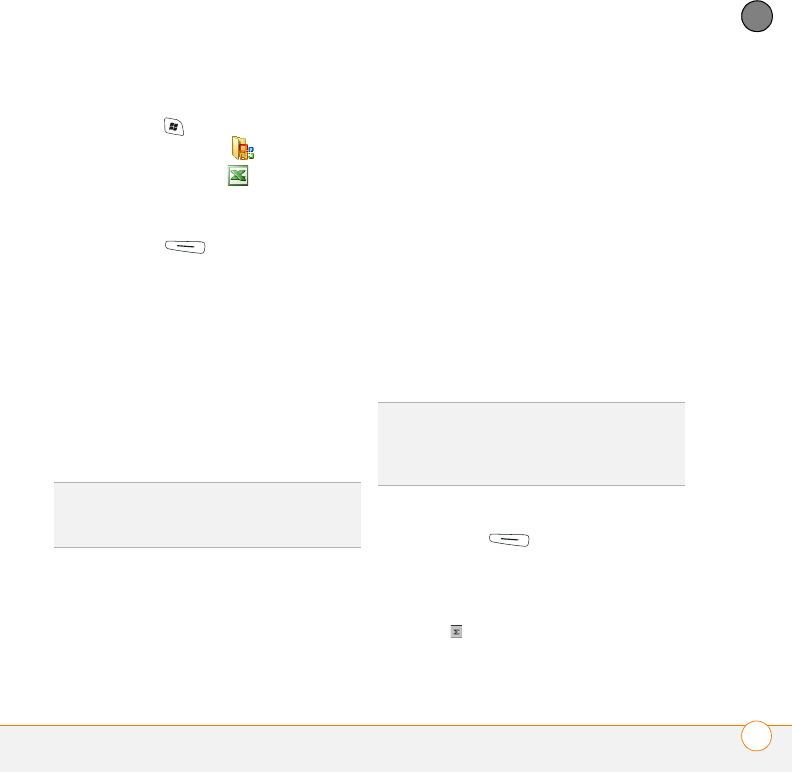
YOUR MICROSOFT OFFICE AND OTHER DOCUMENT TOOLS
EXCEL MOBILE 203
11
CHAPTER
Viewing a workbook
1Press Start and select Programs.
2Select Office Mobile .
3Select Excel Mobile .
4In the workbook list, select the
workbook you want to view.
5Press View (left action key) and
select any of the following:
Full Screen: Shows as much data as
possible on the screen. To return to the
normal view, select Restore in the
upper-right.
Zoom: Sets the magnification level so
that you can easily read the worksheet.
Sheet: Lets you switch to a different
worksheet.
Split: Divides the window into two
scrollable areas. To move the split bar,
tap and drag it. To remove the split bar,
select View > Remove Split.
Freeze Panes: Locks rows and columns
so they remain visible while you scroll.
Highlight the cell at the point at which
you want to lock before you select this
command. To unlock the rows or
columns, select View > Unfreeze
Panes.
To o l b a r : Indicates whether the toolbar
appears onscreen.
Status Bar: Indicates whether the
status bar appears onscreen.
Show: Indicates whether headings and
scroll bars appear onscreen.
Calculating a sum
1Press View (left action key) and
select Toolbar.
2Highlight the cell where you want to
insert the sum.
3Select .
DID
YOU
KNOW
?
You can also switch worksheets
by selecting the sheet list at the bottom of the
screen.
TIP
To jump to a cell or region, press Menu and
select Edit > Go To. Select Cell reference or
name and enter the target cell info or select
Current region. Select OK.
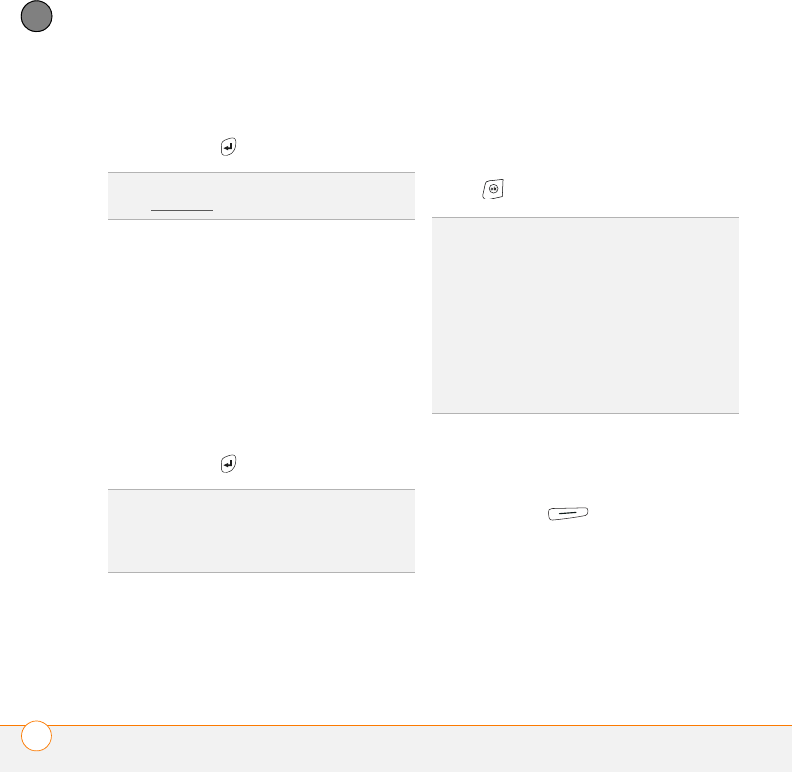
YOUR MICROSOFT OFFICE AND OTHER DOCUMENT TOOLS
EXCEL MOBILE
204
11
CHAPTER
4Tap and drag the stylus across the cells
you want to add.
5Press Enter .
Entering a formula
1Highlight the cell where you want to
enter the formula.
2Enter equals sign ( = ) followed by any
values, cell references, name
references, operators, and functions.
Examples:
•=(B4/25)+100
•=Revenue-Expenses
3Press Enter .
Referring to a cell or range in a formula
1Open the workbook where you want to
refer to a cell or range in a formula.
2Begin entering a formula in a cell.
3Select the cell, or select an entire range
to set the reference.
4Finish entering the formula and press
OK .
Inserting a function
1Open the workbook where you want to
insert the function.
2Press Menu (right action key)
and select Insert > Function.
TIP
For simple calculations, use the Calculator
(see Calculator).
TIP
To insert a symbol, place the cursor where
you want the symbol. Press Menu and select
Insert > Symbol. Highlight the symbol you
want to insert, and select Insert.
TIP
To refer to a cell from another worksheet in
your formula, enter the worksheet name
followed by an exclamation point (!) and the
cell, range, or name reference.
Example: =Sheet1!Earnings
TIP
To create a 3-D reference in your formula,
specify two or more sheets in a workbook;
use a colon between the first and last
worksheet names.
Example: =SUM(Sheet2:Sheet6!$A$2:$C$5)
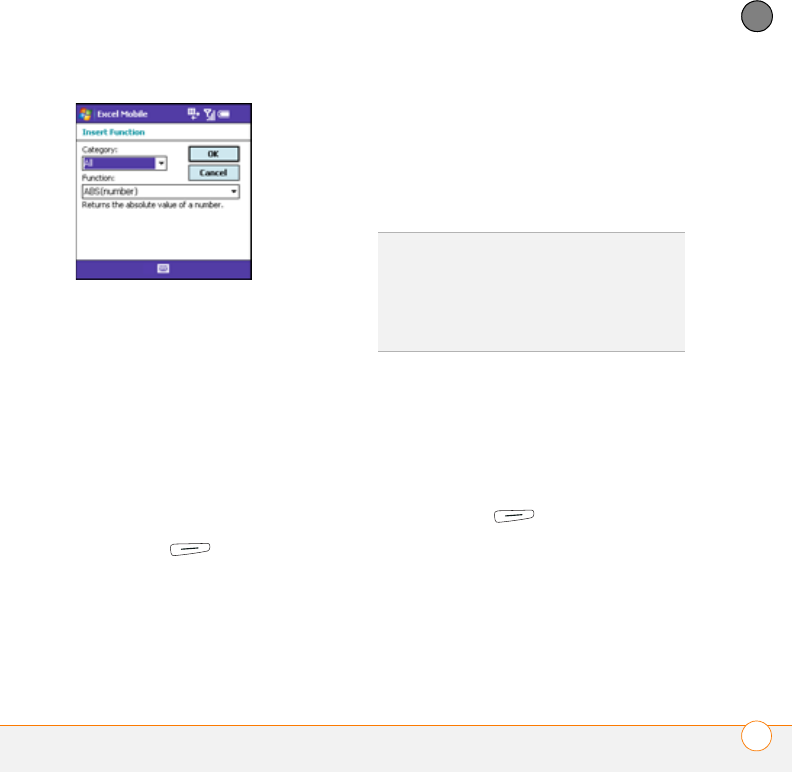
YOUR MICROSOFT OFFICE AND OTHER DOCUMENT TOOLS
EXCEL MOBILE 205
11
CHAPTER
3Select the Category list, and then
select the type of function you want to
insert.
4Select the Function list, and then select
the specific function you want to insert.
5Select OK.
Entering a sequence automatically
1Highlight both the cells containing the
info you want to automate and the
adjacent destination cells.
2Press Menu (right action key)
and select Edit > Fill.
3Select the Direction list, and then
select the direction you want to
populate.
4Select the Fill type list, and then
select Series.
5Select the Series type list, and then
select the type of series you want. If
you select Date or Number, enter a
Step value increment.
6Select OK.
Adding cells, rows, and columns
1Open the workbook you want.
2Highlight the area where you want to
insert elements.
3Press Menu (right action key)
and select Insert > Cells.
4Select how you want to insert the
elements:
Shift cells right: Inserts the same
number of new cells as the number of
cells you highlighted horizontally in step
2—for example, if you selected an area
TIP
Select Autofill as the series type to quickly
fill cells with repetitive data such as numbers
or repeated text. Autofill takes the content of
the first cell in the highlighted row or column
and copies it down or across the rest of the
selection.

YOUR MICROSOFT OFFICE AND OTHER DOCUMENT TOOLS
EXCEL MOBILE
206
11
CHAPTER
containing two cells horizontally (say, A1
and B1), selecting Shift cells right
inserts two horizontal cells; so the
original A1 and B1 (and their contents)
are now C1 and D1. The highlighted area
and all cells on the right move the same
number of columns—two in this
example—to the right.
Shift cells down: Inserts the same
number of new cells as the number of
cells you highlighted vertically in step
2—for example, if you selected an area
containing two cells vertically (say, A1
and A2), selecting Shift cells down
inserts two vertical cells; so the original
A1 and A2 (and their contents) are now
A3 and A4. The highlighted area and all
cells below it move the same number of
rows—two in this example—down.
Entire row: Inserts the same number of
new rows as the number of cells you
highlighted vertically in step 2—for
example, if you selected an area
containing two cells vertically (say A1
and A2), selecting Entire row inserts
two rows; so the original rows 1 and 2
(and their contents) are now rows 3 and
4. The rows containing the highlighted
area and all rows beneath it move the
same number of rows—two in this
example—down.
Entire column: Inserts the same
number of new columns as the number
of cells you highlighted horizontally in
step 2—for example, if you selected an
area containing two cells horizontally
(say, A1 and B1), selecting Entire
column inserts two columns; so the
original columns A and B (and their
contents) are now columns C and D.
The columns containing the highlighted
area and all columns on the right move
the same number of columns—two in
this example—to the right.
5Select OK.
TIP
To add a new worksheet, press Menu and
select Format > Modify Sheets. Select
Insert, enter a name for the worksheet, and
then press OK. To change the order of the
worksheets, highlight a worksheet you want
to move, select Move Up or Move Down,
and then press OK.

YOUR MICROSOFT OFFICE AND OTHER DOCUMENT TOOLS
EXCEL MOBILE 207
11
CHAPTER
Formatting cells
1Open the workbook you want to format.
2Highlight the cells you want to format.
3Press Menu (right action key)
and select Format > Cells.
4Select any of the following tabs:
Size: Sets the row height and column
width.
Number: Sets the type of information
the cells contain.
Align: Sets whether text wraps within
the highlighted cells, and sets horizontal
and vertical alignment position.
Font: Sets the typeface, color, size, and
style attributes.
Borders: Turns borders on and off for
various cell edges, and sets the border
and background colors.
5Press OK .
Formatting rows and columns
1Open the workbook you want to format.
2Highlight the rows or columns you want
to format.
3Press Menu (right action key)
and select Format > Row or Format >
Column.
4Select any of the following:
AutoFit: Adjusts the size of the
highlighted rows or columns to their
contents.
Hide: Hides the highlighted rows or
columns.
Unhide: Displays hidden rows or
columns in the highlighted area.
TIP
To name the highlighted cell or range of
cells, press Menu and select Insert > Define
Name. Enter the name and select Add. Press
OK.
DID
YOU
KNOW
?
You can adjust the column and
row size by tapping and dragging the right
edge of the column or the bottom edge of the
row. To automatically fit rows and columns to
their contents, double-tap the lower edge of
the row heading or the right edge of the
column heading.

YOUR MICROSOFT OFFICE AND OTHER DOCUMENT TOOLS
EXCEL MOBILE
208
11
CHAPTER
Renaming a worksheet
1Open the workbook containing the
worksheet you want to rename.
2Press Menu (right action key)
and select Format > Modify Sheets.
3In the Sheets list, highlight the
worksheet you want to rename.
4Select Rename, enter a new name for
the worksheet, and then press OK
twice.
Sorting info in a worksheet
1Highlight the cells you want to sort.
2Press Menu (right action key)
and select To o l s > Sort.
3Select the Sort by list, and then select
the primary sort column.
4Check the Ascending box to sort in
ascending order. Leave the box
unchecked to sort in descending order.
5(Optional) Select the Then by lists, and
then select second- and third-level
sorting options.
6Check or uncheck the Exclude header
row from sort box to indicate whether
you want to sort the header row.
7Select OK.
Filtering info in a worksheet
1Highlight the cells that contain the info
you want to filter.
2Press Menu (right action key)
and select To o l s > AutoFilter. A list
appears at the top of each related
column.
3Select one of the new lists, and then
select a filter. This hides all rows that do
not include the selected filter.
4(Optional) Do any of the following:
•Select the other lists, and select other
filters.
•To display all rows again, select the
filter lists, and select All.
•To turn off filtering, press Menu and
select To o l s > AutoFilter again.
DID
YOU
KNOW
?
You can also create custom filters
where you specify comparisons. Select the
filter lists, and then select Custom.

YOUR MICROSOFT OFFICE AND OTHER DOCUMENT TOOLS
EXCEL MOBILE 209
11
CHAPTER
Creating a chart
1Open the workbook in which you want
to create a chart.
2Highlight the cells you want to include
in the chart.
3Press Menu (right action key)
and select Insert > Chart.
4Select the type of chart, and then press
Next (right action key).
5Confirm the area you want the chart to
include, and then press Next
(right action key).
6Select the data layout, and then press
Next (right action key).
7Check the boxes to indicate whether
the first row and column represent
labels.
8Select whether you want the chart to
appear as a separate worksheet within
the current workbook, or as part of the
current worksheet.
9Press Finish (right action key).
Formatting or changing a chart
1Open the workbook that contains the
chart you want to format.
2Open the chart.
3Press Menu (right action key)
and select Format > Chart.
4Select any of the following tabs:
Titles: Specifies the title of the chart
and headings, whether a legend
appears, and the placement of the
legend.
Scale: Specifies the minimum and
maximum scales for charts with x and y
axes.
Ty p e : Specifies the chart style. You can
use this setting to convert your chart to
a different format.
Series: Lets you add, modify, format, or
delete related data points without
affecting the info in your worksheet.
5Press OK .
Finding or replacing info in a workbook
1Open the workbook containing the info
you want to find.
2Press Menu (right action key)
and select Edit > Find/Replace.

YOUR MICROSOFT OFFICE AND OTHER DOCUMENT TOOLS
EXCEL MOBILE
210
11
CHAPTER
3Select Find what and enter the info you
want to find.
4(Optional) Check the Match case box to
find text that matches the capitalization
in any text you entered in step 3.
5(Optional) Check the Match whole
words only box to find only full words
that match any text you entered in
step 3.
6Select Find to locate the first instance
of the info you entered in step 3, or
select Replace and enter the
replacement info.
7Select Next to find the next instance of
the info, or select Replace to replace it.
To replace all instances of the info,
select Replace All.
8When you see a message that Excel
Mobile is done searching, press OK .
Organizing your workbooks
You can rename your workbooks. You can
also move them to another folder or move
them between your smartphone and an
expansion card.
1Go to the workbook list.
2Select a file.
3Press Menu (right action key)
and select File > Rename/Move.
4Select Name and enter a new name for
the workbook.
5Select the Folder list, and then select
the folder to which you want to move
the workbook.
6Select the Location list, and then select
Main memory or Storage card.
7Press OK .
Deleting cells, rows, and columns
1Open the workbook containing the
elements you want to delete.
2Highlight the area you want to delete.
3Press Menu (right action key)
and select Edit > Delete Cells.
4Select how you want to remove the
elements:
Shift cells left: Deletes the highlighted
cells and moves all cells on their right to
the left.
TIP
When you go to a folder, you can easily
search your files by sorting by type.

YOUR MICROSOFT OFFICE AND OTHER DOCUMENT TOOLS
PDF VIEWER 211
11
CHAPTER
Shift cells up: Deletes the highlighted
cells and moves all cells below them up.
Entire row: Deletes the entire row(s) in
which the highlighted cells are located,
and moves all rows below up.
Entire column: Deletes the entire
column(s) in which the highlighted cells
are located, and moves all columns on
their right to the left.
NOTE Excel Mobile adjusts formulas to
reflect the new cell locations. However, a
formula that refers to a deleted cell
displays the #REF! error value.
5Select OK.
Customizing Excel Mobile
1Go to the workbook list.
2Press Menu (right action key)
and select Options.
3Set any of the following options:
Template for new workbook:
Specifies the default template for new
workbooks.
Save new workbooks to: Specifies
where new workbooks are stored.
Files to display in list view: Specifies
which types of files appear in the
workbook list.
4Press OK .
PDF Viewer
Picsel PDF Viewer lets you view PDF files
whether they are saved to your
smartphone, attached to email messages,
stored on an expansion card inserted into
your smartphone’s expansion card slot, or
downloaded from the web. You can
customize the document display.
TIP
To delete a workbook, go to the workbook
list and highlight the workbook you want to
delete. Press Menu (right action key) and
select Delete. Select Ye s to confirm.
TIP
To delete a worksheet, press Menu (right
action key) and select Format > Modify
Sheets. Highlight the worksheet you want to
delete, and then select Delete. Select Ye s and
press OK.
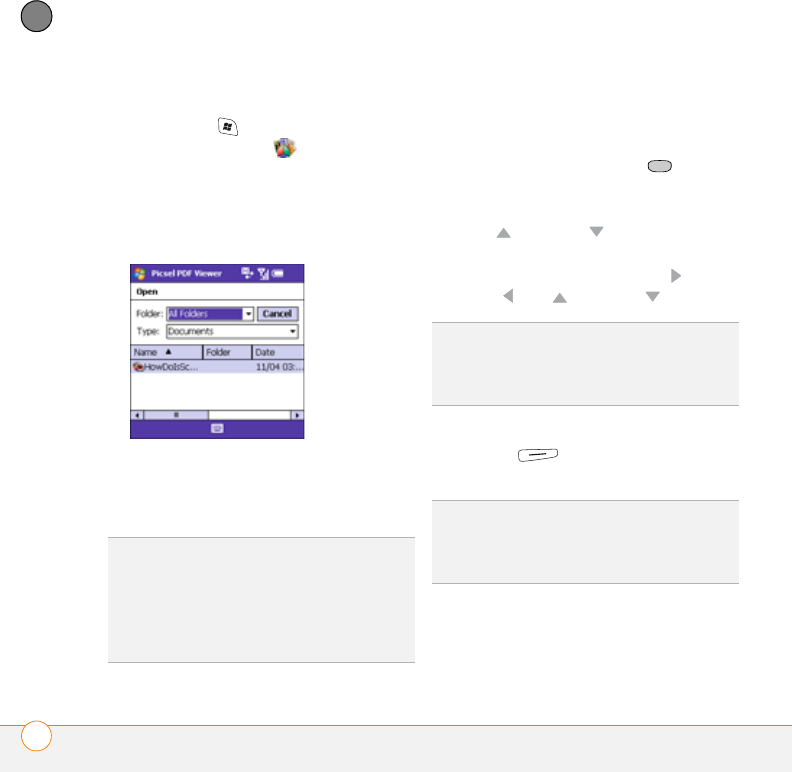
YOUR MICROSOFT OFFICE AND OTHER DOCUMENT TOOLS
PDF VIEWER
212
11
CHAPTER
Opening a file
1Press Start and select Programs.
2Select PDF Viewer .
3Select the Folder list, and then select
the folder containing the file you want
to open. If you’re not sure which folder
the file is in, select All Folders.
4Select the Ty p e list, and then select the
type of file you want to open.
5Select the file you want.
6(Optional) Optimize your viewing of the
file by doing any of the following:
•To switch between zoom mode and
pan mode, press Center .
•In zoom mode, to zoom in and out
while viewing the PDF file, press
Up , or Down .
•In pan mode, to pan the display in a
given direction, press Right ,
Left , Up , or Down .
•To rotate the displayed page, press
Menu (right action key) and
select Page > Rotate.
TIP
Select the Name, Folder, or Date column
heading to sort the displayed files by that
heading. This can help you find the file you
want more quickly.
TIP
To close the Open screen without making a
selection, select Cancel.
TIP
To see which mode you are in, press Show
Mode (left action key) to display the mode
icon. Press Hide Mode (left action key) to hide
the mode icon.
TIP
To open a file you have recently opened,
open PDF Viewer, press Menu (right action
key), and then select Recent > [the name of
the file you want].

YOUR MICROSOFT OFFICE AND OTHER DOCUMENT TOOLS
PDF VIEWER 213
11
CHAPTER
Moving around in PDF files
To move around within a PDF file, do either
of the following:
•To go to the next or previous page in the
file, press Menu (right action
key) and select Page > Next Page or
Page > Previous Page.
•To go to the first or last page in the file,
press Menu (right action key)
and select Page > First page or Page >
Last page.
Customizing the display
You can choose between two views for
displaying PDF files. You can also hide the
toolbar to view the file on the full screen.
1Press Menu (right action key)
and select Page.
2Select one of the following options:
Fit to width: Resizes the file so that the
width of the file matches the width of
the screen; you may need to scroll up or
down to view the entire document.
Fit to page: Resizes the file so that the
entire file—both width and height—fits
on one screen.
Customizing PDF Viewer
1Press Menu (right action key)
and select Settings.
2Select any of the following options:
Clear History: Deletes all files from the
Recent list (see Opening a file).
Files: Specifies which file types can be
opened with PDF Viewer.
About: Contains information on the PDF
Viewer application.

YOUR MICROSOFT OFFICE AND OTHER DOCUMENT TOOLS
PDF VIEWER
214
11
CHAPTER

CHAPTER
12
Your application and info
management tools
You r Palm ® Treo™800W smartphone comes equipped with a
variety of tools for managing and organizing your information.
Get the most out of your smartphone: Install some of the
thousands of business, education, or leisure-time applications
available. After you use your smartphone to create or capture
important business and personal information, use one of
several options to share the info with others. Insert expansion
cards (sold separately) for a compact and limitless answer to
the storage dilemma. And because there’s one on your
smartphone, you never need to carry a separate calculator.
Benefits
•Locate info in any application
•Install applications, games, and
other software
•Keep others up-to-date with
meaningful business and personal
information
•Store, carry, and exchange info
•Always have a calculator with you

In this chapter
Finding information . . . . . . . . . . . . . . . . . . . . . . . . . . . . . . . . . . . . . 217
Installing applications. . . . . . . . . . . . . . . . . . . . . . . . . . . . . . . . . . . . 219
Removing applications . . . . . . . . . . . . . . . . . . . . . . . . . . . . . . . . . . . 222
Sharing information . . . . . . . . . . . . . . . . . . . . . . . . . . . . . . . . . . . . . 223
Beaming information . . . . . . . . . . . . . . . . . . . . . . . . . . . . . . . . . . . . 223
Using expansion cards . . . . . . . . . . . . . . . . . . . . . . . . . . . . . . . . . . . 225
Calculator . . . . . . . . . . . . . . . . . . . . . . . . . . . . . . . . . . . . . . . . . . . . . 231
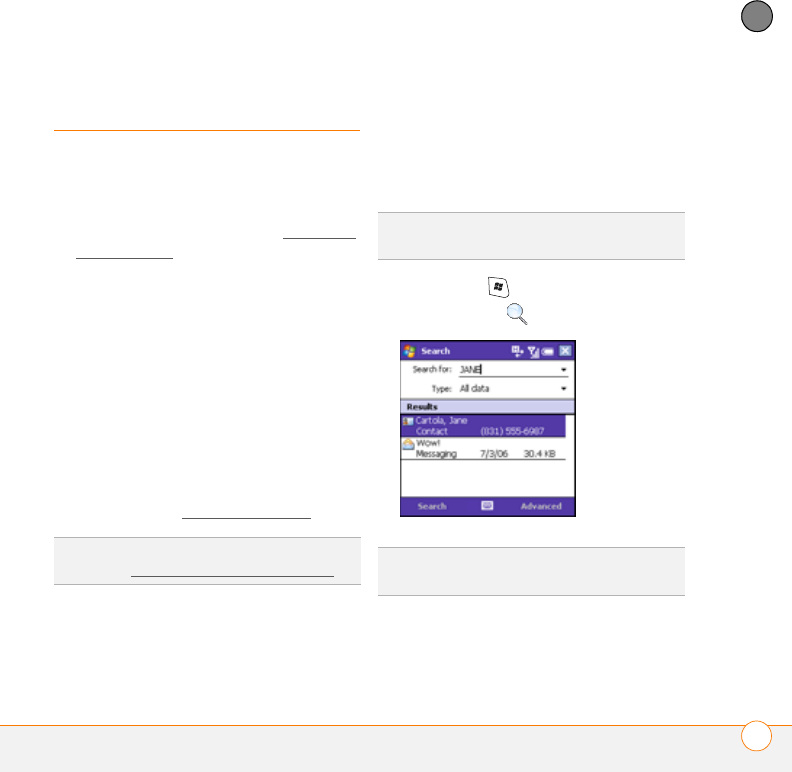
YOUR APPLICATION AND INFO MANAGEMENT TOOLS
FINDING INFORMATION 217
12
CHAPTER
Finding information
Quickly find who or what you’re looking for
by using one of these search features:
•Lookup: Find and dial your contacts by
name or phone number. See Dialing by
contact name for details.
•Search: Look through the text in all the
applications on your smartphone.
•File Explorer: Browse through the files
and folders on your smartphone or on
an expansion card.
•Global Address List Lookup: Look up
names in your online corporate address
list.
•Email message search: Display only
those messages whose senders,
recipients, or subjects match the text
you enter (see Finding messages).
Using Search
Search for files and other items stored in
the My Documents folder on your
smartphone or on an expansion card. You
can search by file name or by words
located in the item. For example, you can
search for words within notes,
appointments, contacts, and tasks.
1Press Start and select Programs.
2Select Search .
3Select Search for, and then enter the
file name, word, or other info you want
to find.
TIP
For information on opening and closing
apps, see Opening and closing applications.
DID
YOU
KNOW
?
Contacts on your SIM card do not
appear in the search results list.
DID
YOU
KNOW
?
You can also open Search by
pressing Option + left Shift.
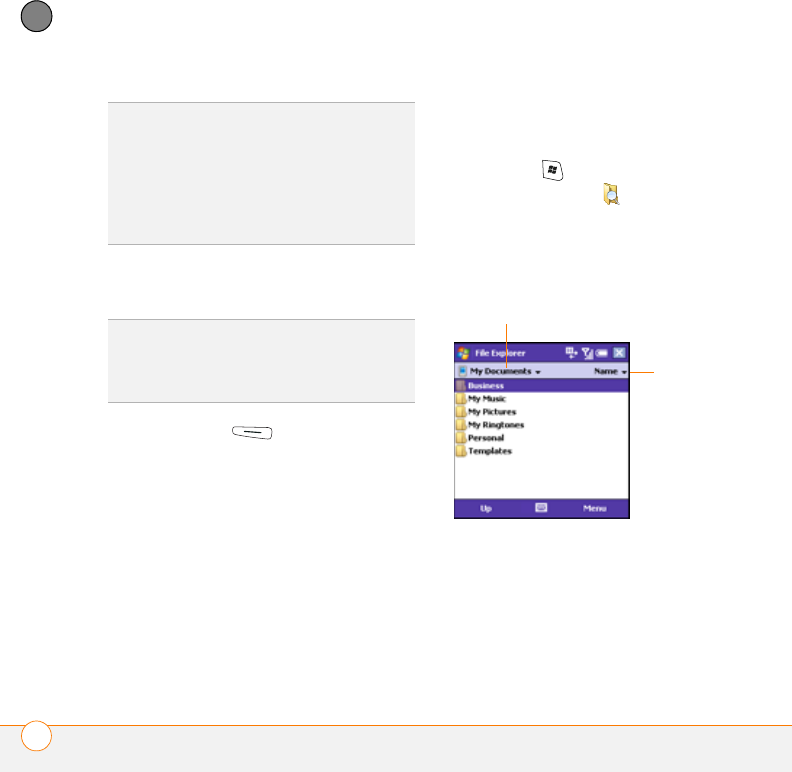
YOUR APPLICATION AND INFO MANAGEMENT TOOLS
FINDING INFORMATION
218
12
CHAPTER
4Select the Ty p e list, and then select the
kind of information you want to find.
5Press Search (left action key).
6Use the 5-way to select and view an
item from the results of the search. A
storage card symbol appears next to the
names of files that are located on an
expansion card.
Exploring files and folders
You can use File Explorer to browse the
contents of folders on your smartphone or
on an expansion card. The root folder on
your smartphone is named My Device. My
Device is similar to My Computer
(Windows XP) or Computer (Windows
Vista) on your computer.
1Press Start and select Programs.
2Select File Explorer .
3Select the folder you want to explore. If
the folder you want is not displayed, tap
the Show list in the upper-left and
select My Device to view all folders.
TIP
If you’ve looked for an item before, select
the Search for list, and then select the item in
the list.
TIP
When two or more words are entered in
the Search for field, the search results
contains only items that contain all of the
words.
TIP
If you are searching for information in
certain applications, such as Inbox or Word
Mobile, select Advanced for more search
options.
Show list
Sort by
list

YOUR APPLICATION AND INFO MANAGEMENT TOOLS
INSTALLING APPLICATIONS 219
12
CHAPTER
4Do any of the following:
•To open an item, select it.
•To quickly delete, rename, beam, or
email an item, highlight the item,
press and hold Center to open
the shortcut menu, and then select
the appropriate command.
•To move a file to another folder,
highlight the item, press and hold
Center to open the shortcut
menu, and select Cut or Copy. Open
the destination folder, press and hold
Center to open the shortcut
menu, and then select Paste.
•To highlight multiple items, tap and
drag the stylus.
IMPORTANT Do not delete any files that
you cannot identify. These files may be
required for your smartphone to function
properly.
Installing applications
Your smartphone comes with several
built-in and ready-to-use applications. You
can also install any of the additional
software included on the Windows Mobile
Getting Started CD as well as other
third-party applications that are compatible
with Microsoft Windows Mobile® 6
Professional edition devices, such as
business software, games, and more.
Applications you download to your
computer are likely to be in a compressed
format such as ZIP. If the file is
compressed, you need to use a
decompression utility on your computer,
such as WinZip, to decompress the file
before you install the application on your
smartphone.
These instructions tell you how to install
basic files onto your smartphone. Some
software uses an installer or wizard to
guide you through the process. For details,
DID
YOU
KNOW
?
When the items in a folder are
displayed, you can sort them by name, date,
size, or type. Select the Sort by list in the
upper-right, and then select the sort method.
TIP
The storage card symbol appears next to
the names of files that are stored on an
expansion card.

YOUR APPLICATION AND INFO MANAGEMENT TOOLS
INSTALLING APPLICATIONS
220
12
CHAPTER
consult the documentation that came with
the software.
Installing bonus software from the CD
The Windows Mobile Getting Started CD
includes several bonus software
applications that you can install on your
smartphone. You can install these
applications when you install the desktop
software, or you can install them later.
1Insert the Windows Mobile Getting
Started CD into the CD drive on your
computer.
2Click Add Programs (Windows XP) or
Bonus Software (Windows Vista).
3Click the name of the application you
want to install.
4Click Install (on the right side of the
screen).
5(Optional) Repeat steps 3 and 4 to
install additional applications.
6Synchronize your smartphone with your
computer to install the application(s) on
your smartphone.
Installing third-party applications
When installing third-party applications,
note the following:
•Install only apps that are designed for
Microsoft Windows Mobile 6
Professional.
•Apps designed for Microsoft Windows
Mobile 6 Standard or any edition of
Windows Mobile 5.x software are not
compatible with your smartphone.
•If you can try a free or trial version of
the software before purchasing it, you
can test it first to make sure it works
properly.
NOTE If you encounter a problem with a
third-party application (such as an error
message), contact the application’s vendor.
For general troubleshooting of third-party
applications, see Third-party applications.
TIP
If an application does not have a Microsoft
Mobile to Market certificate, you see a
message indicating that the application is
untrusted. If this occurs, you can indicate
whether you want to continue the installation.

YOUR APPLICATION AND INFO MANAGEMENT TOOLS
INSTALLING APPLICATIONS 221
12
CHAPTER
Installing applications from the Internet
You can use Internet Explorer Mobile to
install Windows Mobile apps in the CAB
file format directly from the Internet. For
files in any other format except CAB, you
must first download the files to your
computer and then install them to your
smartphone by synchronizing.
1Make sure your phone is on and that
you are in a coverage area (see Turning
your phone on).
2Press Start and select Internet
Explorer.
3Go to the page that contains the link to
the application you want to download.
4Press Left or Right to highlight the
link to the file, and then press Center
to start the download process.
5When the download has finished, press
Start and select Programs.
6Select File Explorer .
7Go to the My Documents folder in File
Explorer.
8Tap the file you downloaded to start the
installation program.
Installing applications from your
computer
BEFORE YOU BEGIN To install an
application from your computer to your
smartphone, you must first install the
desktop synchronization software on
your computer (see Installing ActiveSync
desktop software: Windows XP or
Installing Windows Mobile Device Center:
Windows Vista).
1Open My Computer or Windows
Explorer on your computer.
2Double-click the icon representing your
smartphone.
3Copy the application file(s) into the
folder.
4Connect your smartphone to your
computer to synchronize and install the
application(s) on your smartphone.
DID
YOU
KNOW
?
You can purchase a third-party
application that lets you run Palm OS®
applications on your smartphone.
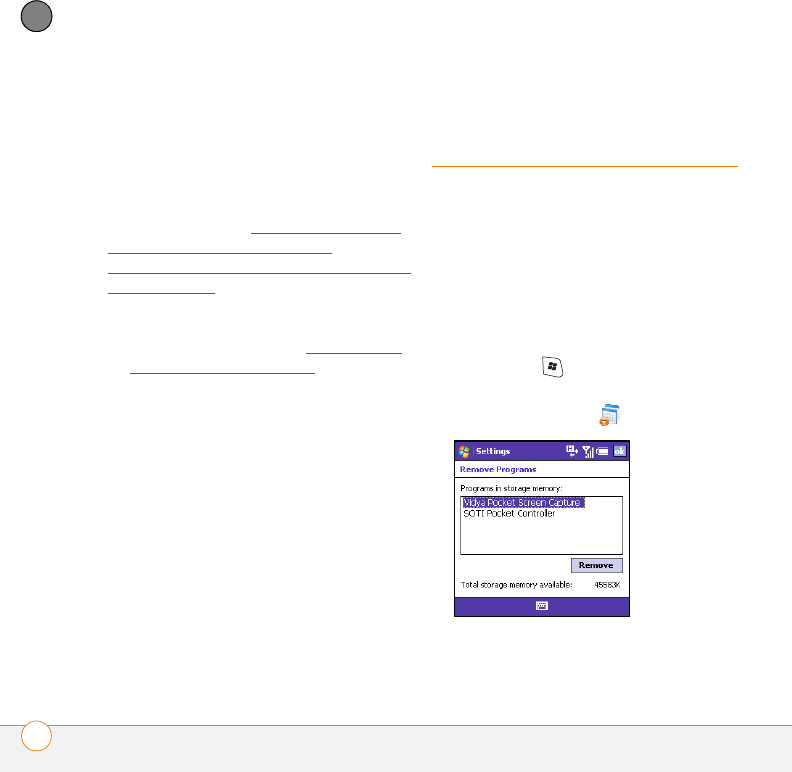
YOUR APPLICATION AND INFO MANAGEMENT TOOLS
REMOVING APPLICATIONS
222
12
CHAPTER
Installing applications onto an expansion
card
BEFORE YOU BEGIN To install an
application from your computer to an
expansion card, you must first install the
desktop synchronization software on
your computer (see Installing ActiveSync
desktop software: Windows XP or
Installing Windows Mobile Device Center:
Windows Vista).
1Insert the expansion card into the
expansion card slot (see Inserting and
removing expansion cards).
2Connect your smartphone to your
computer using the USB sync cable.
3Open My Computer or Windows
Explorer on your computer.
4Double-click the icon representing your
smartphone.
5Navigate to the folder representing the
expansion card.
6Copy the application file(s) into the
expansion card folder.
Removing
applications
To free up memory on your smartphone,
you can remove applications that you no
longer use. You can remove only
applications, patches, and extensions that
you install; you cannot remove the built-in
applications that reside in the Read-Only
Memory (ROM) portion of your
smartphone.
1Press Start and select Settings.
2Select the System tab, and then select
Remove Programs .
3Highlight the application that you want
to remove.

YOUR APPLICATION AND INFO MANAGEMENT TOOLS
SHARING INFORMATION 223
12
CHAPTER
4Select Remove.
5Select Ye s to confirm the deletion.
Sharing information
Your smartphone comes equipped
with a variety of options for sharing
information, so that you can choose the
quickest, most convenient way to send
your info or to receive info from another
device.
•When you have a file open in a program
such as Notes or PowerPoint Mobile,
you can easily share a file by selecting
the Menu, and then selecting Send via
E-Mail or Beam File.
•In Microsoft Outlook®, you can insert a
picture or attach a note or other file to
an email. You can also receive pictures
and attachments (see Your email).
•You can attach a picture, video, or sound
file to a multimedia message (see
Creating and sending a multimedia
message).
•You can synchronize to share info
between your smartphone and your
computer or between your smartphone
and Microsoft Exchange Server 2003 or
2007 (see Synchronizing information).
•If you are near someone, you can beam
files and applications between your
smartphone and your neighbor’s device
using the IR port or Bluetooth® wireless
technology (see Beaming information).
•You can also store files on an expansion
card and share the expansion card (see
Using expansion cards).
Beaming information
Your smartphone is equipped with an IR
(infrared) port that enables you to beam
information to another device with an IR
port. The IR port is located on the side of
your smartphone closest to the stylus, near
the top. You can also beam using the
DID
YOU
KNOW
?
Built-in applications that cannot be
deleted are not listed in the Remove Programs
list.
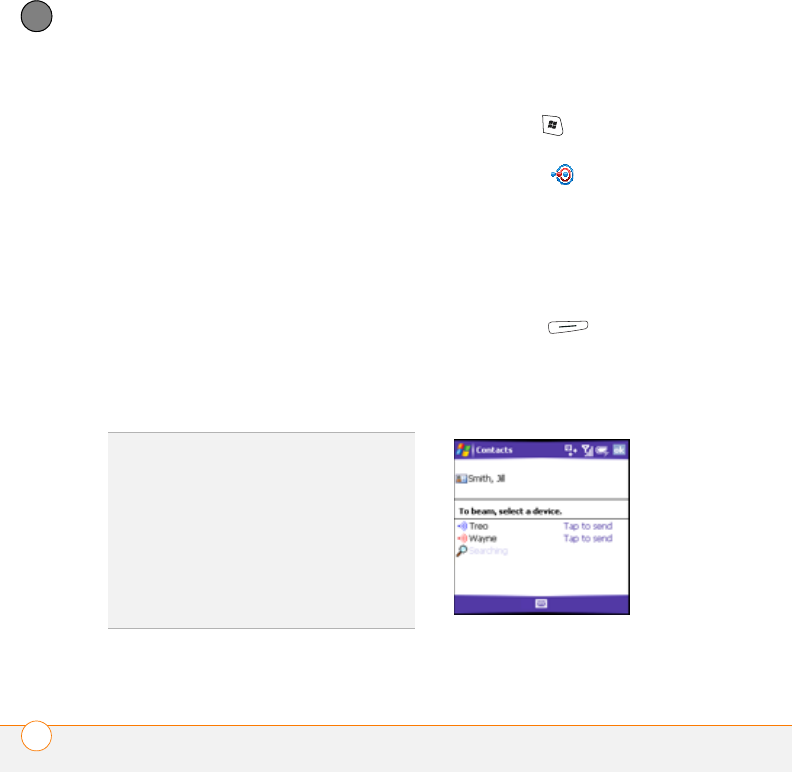
YOUR APPLICATION AND INFO MANAGEMENT TOOLS
BEAMING INFORMATION
224
12
CHAPTER
built-in Bluetooth wireless technology on
your smartphone.
The normal range for beaming with IR is
about 20 centimeters (8 inches). The
maximum range for beaming with
Bluetooth technology is about 9 meters
(30 feet). Performance and range are
affected by physical obstacles, radio
interference from nearby electronic
equipment, and other factors.
By default, the beaming option on your
smartphone is turned off. You need to turn
the beam option on before you can beam
using either the IR port or Bluetooth
wireless technology.
Turning on the beam option
1Press Start and select Settings.
2Select the Connections tab, and then
select Beam .
3Check the Receive all incoming
beams box.
Beaming an entry or file
1Highlight the entry or file you want to
beam.
2Press Menu (right action key)
and select Beam… (the menu item
changes names based on the type of
item you highlighted).
3Do one of the following:
TIP
For best results, the path between the two
devices must be clear of obstacles, and both
devices kept stationary. If you have difficulty
beaming, shorten the distance and avoid
bright sunlight.
DID
YOU
KNOW
?
The type of information you can
beam depends on the type of device you are
beaming to. Other Windows Mobile 6
Professional devices are always compatible
with your Treo 800W smartphone.
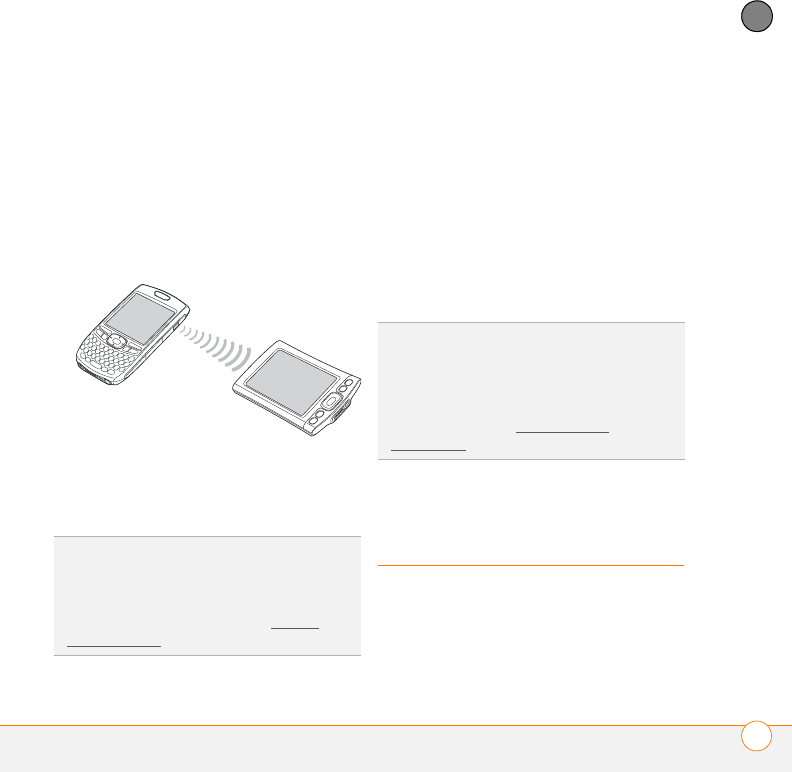
YOUR APPLICATION AND INFO MANAGEMENT TOOLS
USING EXPANSION CARDS 225
12
CHAPTER
Bluetooth: When the name of the
receiving device appears, select Ta p t o
send to begin the transfer. A blue icon
indicates a Bluetooth connection.
IR: Point the IR port on your smartphone
directly at the IR port of the receiving
device. A red icon indicates an IR
connection.
4Wait for Done to appear next to the
name of the receiving device before you
continue using your smartphone.
Receiving beamed information
1Turn on your screen if it is not already
on.
2If you are beaming over an IR
connection, point the IR port on your
smartphone directly at the IR port of the
transmitting device.
3When the Receiving Data message
appears, select Ye s to receive the
beam.
Using expansion
cards
The expansion card slot on your
smartphone enables you to add miniSD
cards to extend the storage capacity of
TIP
The regional setting determines the list of
characters that can be used when info is
beamed between devices. If you try to send
or receive a character that is not on the list, it
appears as a question mark (see Setting
display formats).
TIP
If you can’t receive beamed info, press
Start and select Settings. Select the
Connections tab, and then select Beam.
Make sure the Receive all incoming beams
box is checked. If you still can’t receive info,
try a soft reset (see Resetting your
smartphone).
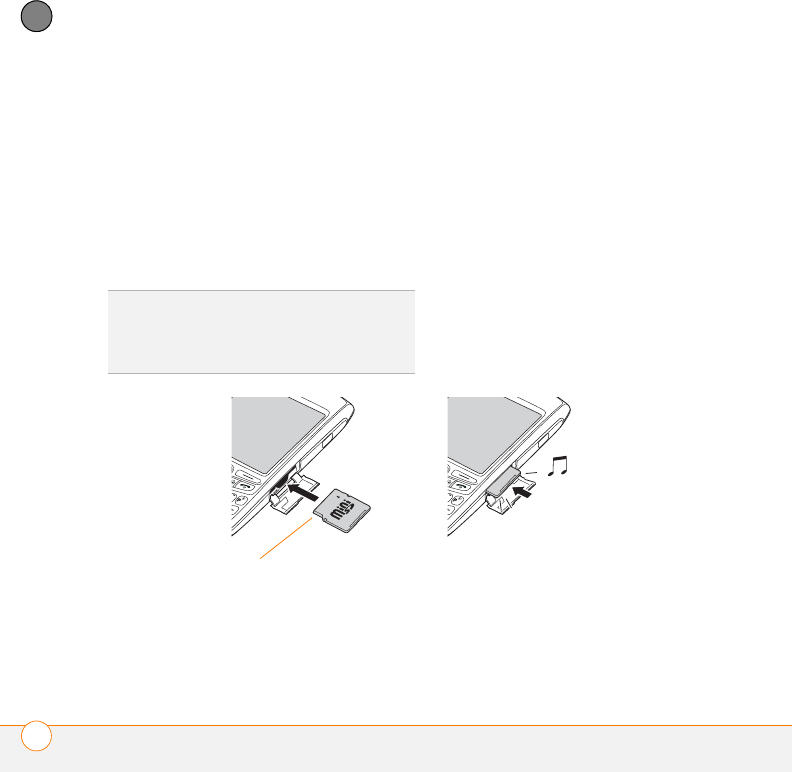
YOUR APPLICATION AND INFO MANAGEMENT TOOLS
USING EXPANSION CARDS
226
12
CHAPTER
your smartphone. For example, miniSD
expansion cards can store the following:
Expansion cards are sold separately.
Inserting and removing expansion cards
1Open the expansion card slot door by
sliding your fingernail or another thin
object into the notch.
2Hold your smartphone with the screen
facing you and hold the card with the
label facing you. The notch on the card
should be toward the bottom of your
smartphone.
3Insert the card into the expansion card
slot until you feel it lock into place and
you hear the confirmation tone.
•Pictures
•Videos
•Games
•Applications
•MP3 audio files
•Email attachments
•Databases
TIP
We recommend that you purchase
preformatted expansion cards. To format a
card on your own, you need to connect a card
reader (sold separately) to your computer.
Notch
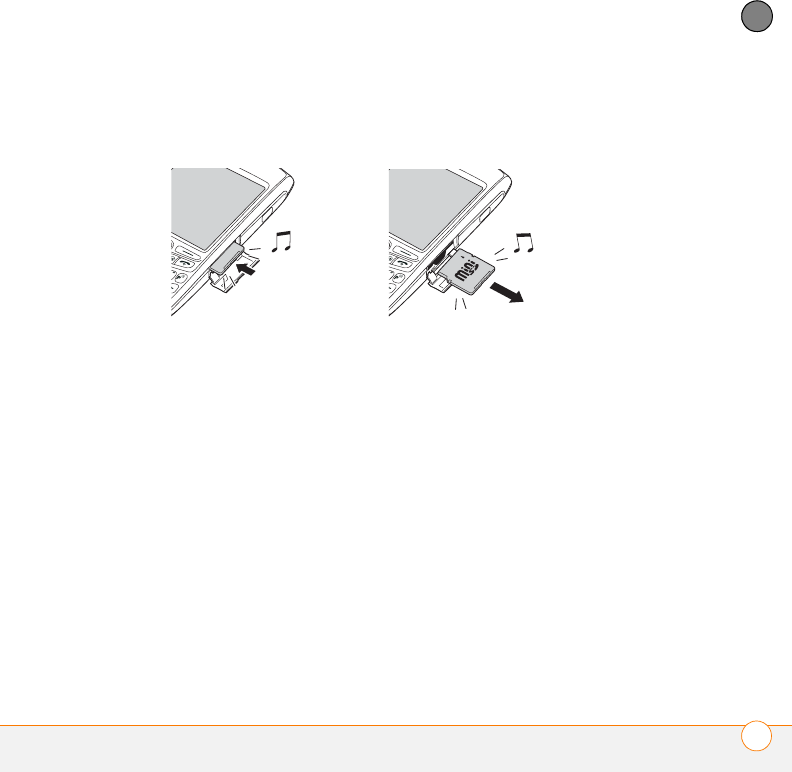
YOUR APPLICATION AND INFO MANAGEMENT TOOLS
USING EXPANSION CARDS 227
12
CHAPTER
4To remove an expansion card, press in
and release the card.
5After you feel the expansion card slot
eject the card, remove the card
from the slot.
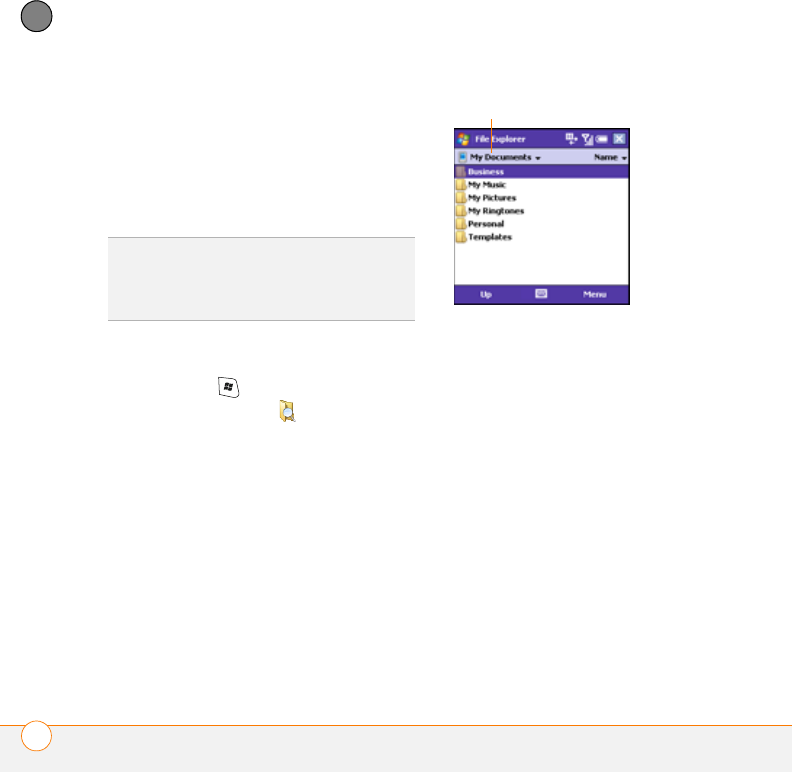
YOUR APPLICATION AND INFO MANAGEMENT TOOLS
USING EXPANSION CARDS
228
12
CHAPTER
Opening applications on an expansion
card
After you insert an expansion card into the
expansion card slot, you can open any of
the applications stored on the expansion
card.
1Insert the expansion card into the
expansion card slot.
2Press Start and select Programs.
3Select File Explorer .
4Tap the Show list in the upper-left and
select Storage Card.
5Select the application you want to open.
Saving files to an expansion card
You can save space on your smartphone by
saving files to an expansion card. For
example, when you create new Word
Mobile documents, notes, Excel Mobile
workbooks, pictures, videos, and audio
files, you can save them directly to an
expansion card. Saving files to an
expansion card also makes it easy to share
those files with others. (Some applications
may not support this feature.)
TIP
To run an application on an expansion card,
your smartphone must have enough free
space in the internal memory to run the
application.
Show list
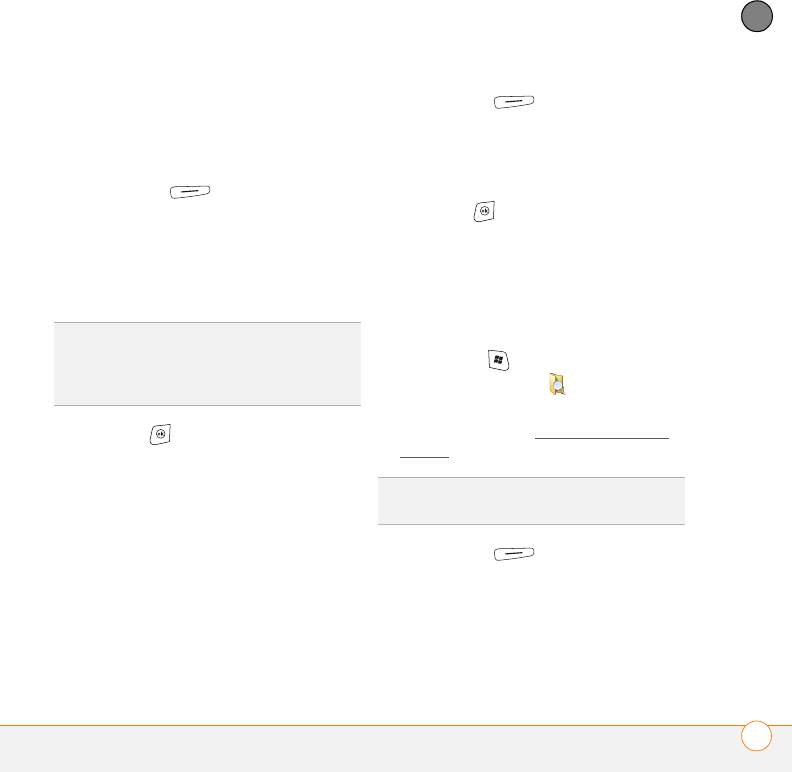
YOUR APPLICATION AND INFO MANAGEMENT TOOLS
USING EXPANSION CARDS 229
12
CHAPTER
1Insert an expansion card into the
expansion card slot.
2Open the application from which you
want to save the info.
3Press Menu (right action key)
and select Options.
4Select the option for where to save info,
and then select Storage Card. The
option name changes depending on the
application you are in.
5Press OK .
Moving info between your smartphone
and an expansion card
1Insert an expansion card into the
expansion card slot.
2Open the application from which you
want to move the info.
3Go to the list view, tap the Show list in
the upper-left, and select the file or
application you want to move.
4Press Menu (right action key)
and select Rename/Move.
5Select the Location list, and then select
where you want to move the info:
Storage Card or Main Memory.
6Press OK .
Copying or moving applications and files
between your smartphone and an
expansion card
1Insert the expansion card into the
expansion card slot.
2Press Start and select Programs.
3Select File Explorer .
4Select the file or application you want to
copy or move (see Exploring files and
folders).
5Press Menu (right action key)
and select Edit > Copy or Edit > Cut.
6Go to the folder where you want to
place the selected item.
TIP
If you don’t see a Save to option on the
Options screen, look on the other tabs (if
present). If you still can’t find a Save to list, the
application may not support this feature.
TIP
Your applications are usually located in the
My Device/Program Files folder.
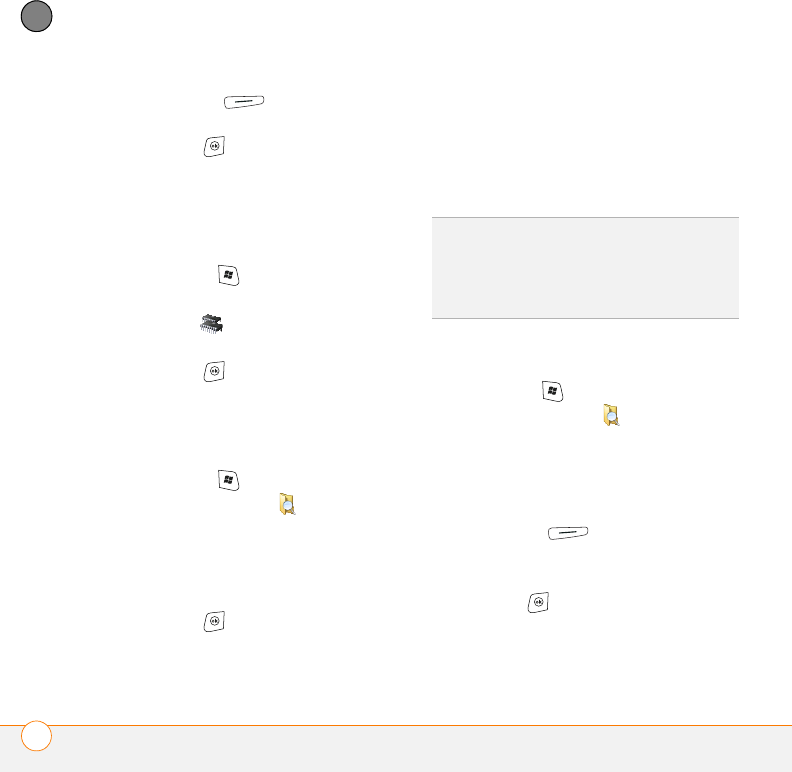
YOUR APPLICATION AND INFO MANAGEMENT TOOLS
USING EXPANSION CARDS
230
12
CHAPTER
7Press Menu (right action key)
and select Edit > Paste.
8Press OK .
Viewing available expansion card
memory
1Insert the expansion card into the
expansion card slot.
2Press Start and select Settings.
3Select the System tab, and then select
Memory .
4Select the Storage Card tab.
5Press OK .
Exploring files on an expansion card
1Insert the expansion card into the
expansion card slot.
2Press Start and select Programs.
3Select File Explorer .
4Tap the Show list in the upper-left and
select Storage Card.
5Select the folder or files you want to
view.
6Press OK .
Renaming an expansion card
If you change the contents of an expansion
card, you may at some point want to
rename the card to better match its
contents.
1Insert the expansion card into the
expansion card slot.
2Press Start and select Programs.
3Select File Explorer .
4Tap the Show list in the upper-left and
select My Device.
5Highlight the current expansion card
name (Storage Card by default).
6Press Menu (right action key)
and select Rename.
7Enter a new name for the card.
8Press OK .
TIP
Before copying information to or renaming
the files or folders on an expansion card, or
renaming the card itself, make sure the card is
not write-protected. See the instructions that
came with your card for details.
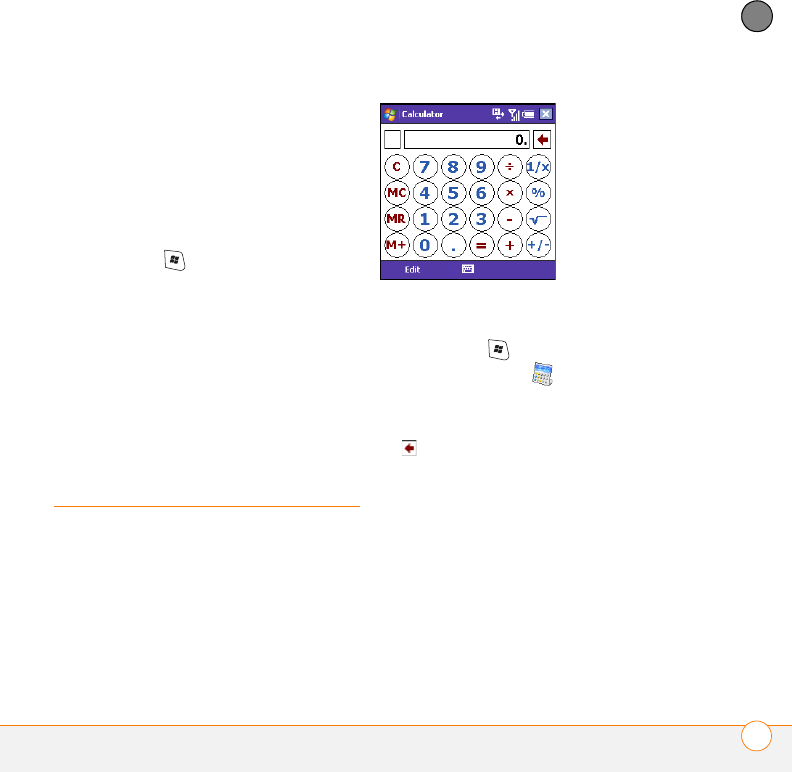
YOUR APPLICATION AND INFO MANAGEMENT TOOLS
CALCULATOR 231
12
CHAPTER
Encrypting an expansion card
When you encrypt an expansion card, the
info on the card can be read only by your
smartphone—so no one can see what’s on
the card if it gets lost or stolen.
1Insert the expansion card into the
expansion card slot.
2Press Start and select Settings.
3Select the System tab, and then select
Encryption.
4Check the Encrypt files placed on
storage cards box.
NOTE If your organization enforces an
encryption policy, you can see that the box
is checked but cannot uncheck it.
Calculator
You can use Calculator for basic arithmetic
calculations, such as addition, subtraction,
multiplication, and division.
Performing calculations
1Press Start and select Programs.
2Select Calculator .
3Enter numbers and perform
calculations, including the following:
Clears the last digit in a multi-digit
entry.
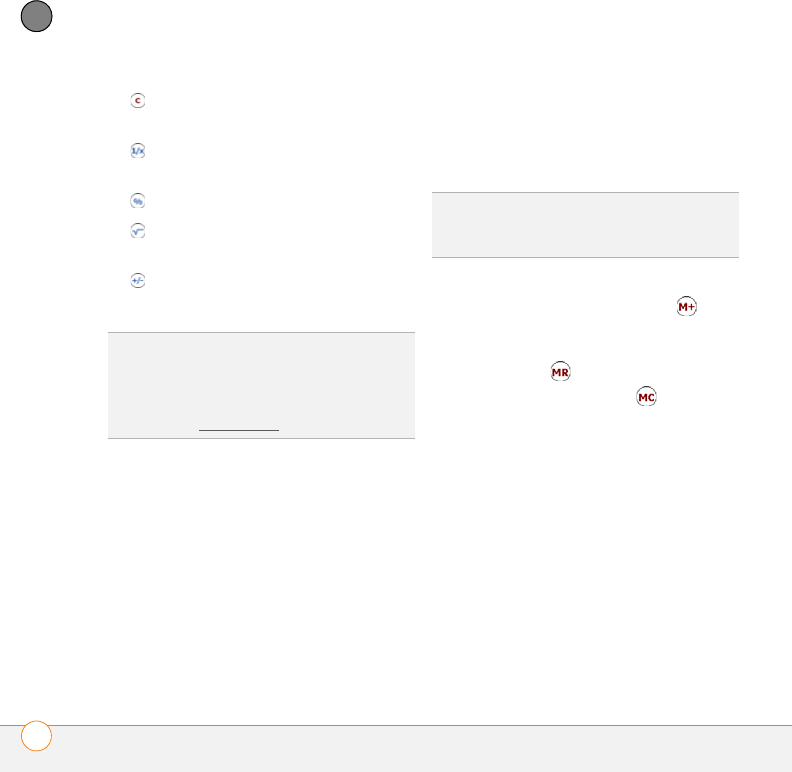
YOUR APPLICATION AND INFO MANAGEMENT TOOLS
CALCULATOR
232
12
CHAPTER
Clears the current calculation or the
displayed number.
Calculates the reciprocal of a
number.
Calculates percentage.
Calculates the square root of a
number.
Switches a number between
negative and positive.
Using the Calculator memory
•To store a displayed number, tap the box
to the left of the entry box or press M.
An M appears in the box.
•To add the displayed number to the
number stored in memory, tap or
press P.
•To display the number stored in
memory, tap or press R.
•To clear the memory, tap or press L.
TIP
You can paste numbers into Calculator as
well as copy calculation results to be pasted
into another app.
TIP
For more advanced calculations, use Excel
Mobile. See Excel Mobile for details.
DID
YOU
KNOW
?
When you store a number in
memory, it replaces the number that is
currently stored.

CHAPTER
13
Your personal settings
Customizing is optional. But why not personalize your Palm®
Treo™800W smartphone to make it match your lifestyle and
work even harder for you?
You can easily customize the sounds, fonts, screen colors, and
more on your smartphone. Take advantage of various levels of
security. Prevent making an accidental (and expensive) phone
call by locking the keyboard. Some preference settings can help
extend the life of your battery. There are lots of ways to make
your smartphone work better for you.
Benefits
•Conserve power
•Secure your phone and your data
•Make your screen easy to read
•Streamline smartphone use

In this chapter
Today screen settings. . . . . . . . . . . . . . . . . . . . . . . . . . . . . . . . . . . . 235
System sound settings. . . . . . . . . . . . . . . . . . . . . . . . . . . . . . . . . . . 236
Display and appearance settings . . . . . . . . . . . . . . . . . . . . . . . . . . . 238
Application settings . . . . . . . . . . . . . . . . . . . . . . . . . . . . . . . . . . . . . 240
Locking your smartphone and info . . . . . . . . . . . . . . . . . . . . . . . . . . 245
System settings . . . . . . . . . . . . . . . . . . . . . . . . . . . . . . . . . . . . . . . . 250
Connection settings . . . . . . . . . . . . . . . . . . . . . . . . . . . . . . . . . . . . . 256
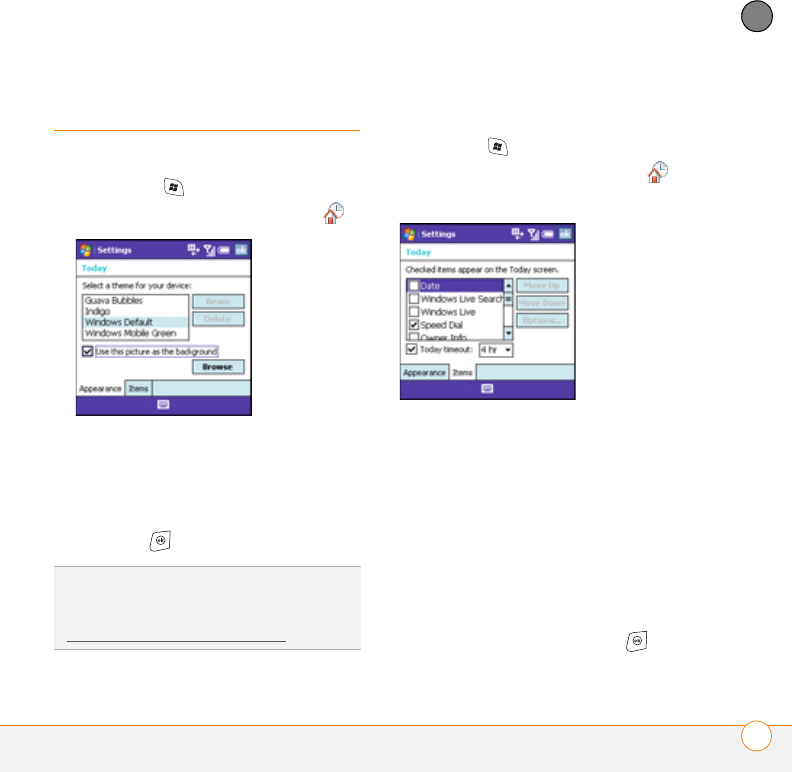
YOUR PERSONAL SETTINGS
TODAY SCREEN SETTINGS 235
13
CHAPTER
Today screen settings
Selecting your Today screen background
1Press Start and select Settings.
2On the Personal tab, select To d a y .
3On the Appearance tab, check the Use
this picture as the background box.
4Select Browse.
5Select the picture you want to use.
6Press OK .
Selecting which items appear on your
Today screen
1Press Start and select Settings.
2On the Personal tab, select To d a y .
3Select the Items tab.
4Check the boxes next to the items you
want to appear on your Today screen,
and uncheck any items that you do not
want to appear.
5(Optional) Highlight an item and select
Move Up or Move Down to change the
order in which items appear on the
Today screen.
6(Optional) Highlight an item and select
Options (if available) to configure the
settings for the item. Press OK to
return to Today Settings.
TIP
To change the color theme for your
smartphone, select a new theme from the
Appearance tab in Today Settings (see
Changing the system color scheme).
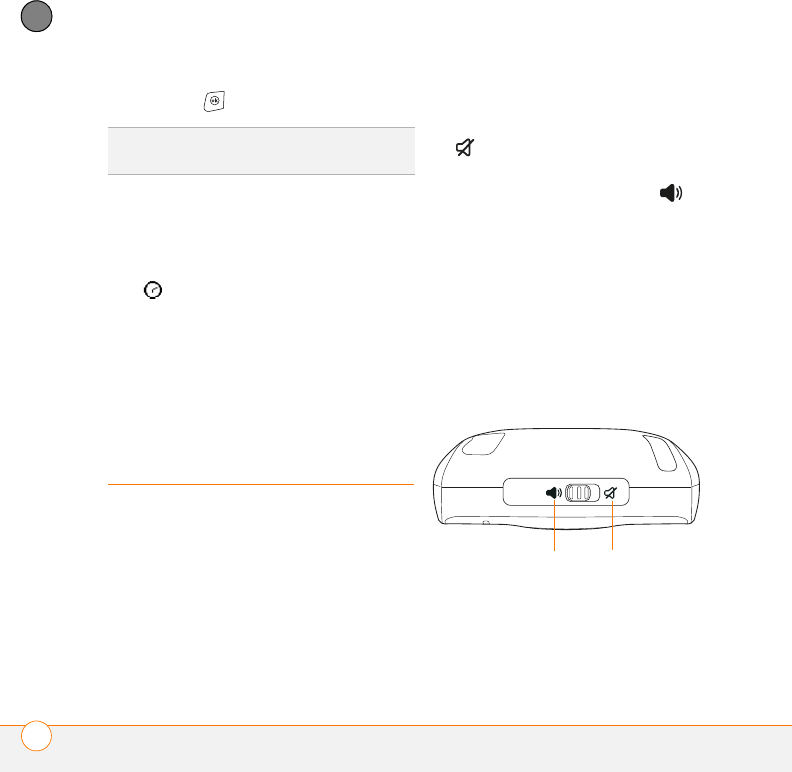
YOUR PERSONAL SETTINGS
SYSTEM SOUND SETTINGS
236
13
CHAPTER
7Press OK .
Changing the clock format
You can change the format of the clock on
the Today screen from digital to analog and
back. If you select analog format, a clock
icon appears displaying the time.
1Tap and hold the clock display with the
stylus.
2Select Analog or Digital.
System sound
settings
When you’re in a meeting, at the movies,
or anywhere that silence is required, you
can immediately silence all sounds on your
smartphone, including Calendar
notifications and system sounds. This does
not mute the speaker during phone calls.
Silencing sounds
1Slide the Ringer switch to Sound Off
. The smartphone vibrates briefly.
2To hear all sounds again, slide the
Ringer switch to Sound On .
When you slide the Ringer switch back to
the Sound On position, it restores the
previous sound settings. For example, if
the smartphone ring volume is set to the
loudest setting and you slide the Ringer
switch to Sound Off, you do not hear the
smartphone ring. When you move the
Ringer switch back to Sound On, the
smartphone ring volume is still set to the
loudest setting.
DID
YOU
KNOW
?
There are lots of third-party
plug-ins available for your Today screen.
Sound Off
Sound On
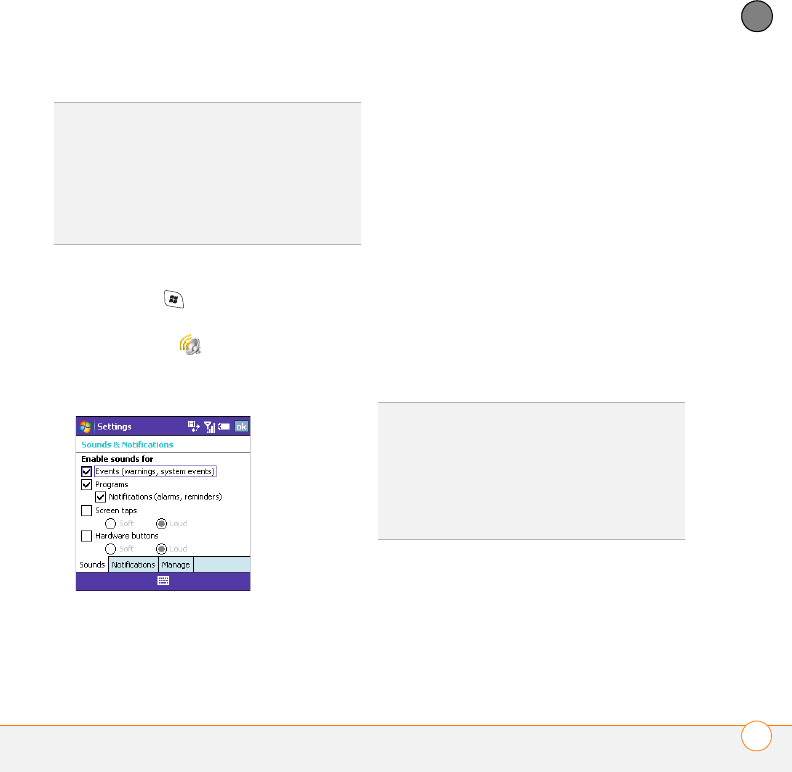
YOUR PERSONAL SETTINGS
SYSTEM SOUND SETTINGS 237
13
CHAPTER
Selecting Sounds & Notifications
1Press Start and select Settings.
2On the Personal tab, select Sounds &
Notifications .
3On the Sounds tab, set any of the
following options:
Events: Turns sounds on/off for system
warnings and error messages.
Programs: Turns sounds on/off in the
applications on your smartphone.
Notifications: Turns alarms and
reminders on/off in the applications on
your smartphone.
Screen taps: Turns sounds associated
with tapping the screen on/off, and sets
the volume level when this sound is
turned on.
Hardware buttons: Turns sounds
associated with pressing buttons on/off,
and sets the volume level when this
sound is turned on.
4Select the Notifications tab and set
any of the following options:
TIP
Can't get music to play out of the built-in
MP3 player? Check the Ringer switch. If it’s
set to Sound Off, you won’t be able to hear
music.
DID
YOU
KNOW
?
Your smartphone includes a silent
alarm that can vibrate even when the Ringer
switch is set to Sound Off.
TIP
To record, preview, delete, and send
sounds, select the Manage tab. To record a
sound, press Menu and select New Sound.
To play a sound, select it and press Play (left
action key). To delete a sound, highlight it and
press Backspace. To send a sound, highlight
it, press Menu, and select Send Sound.
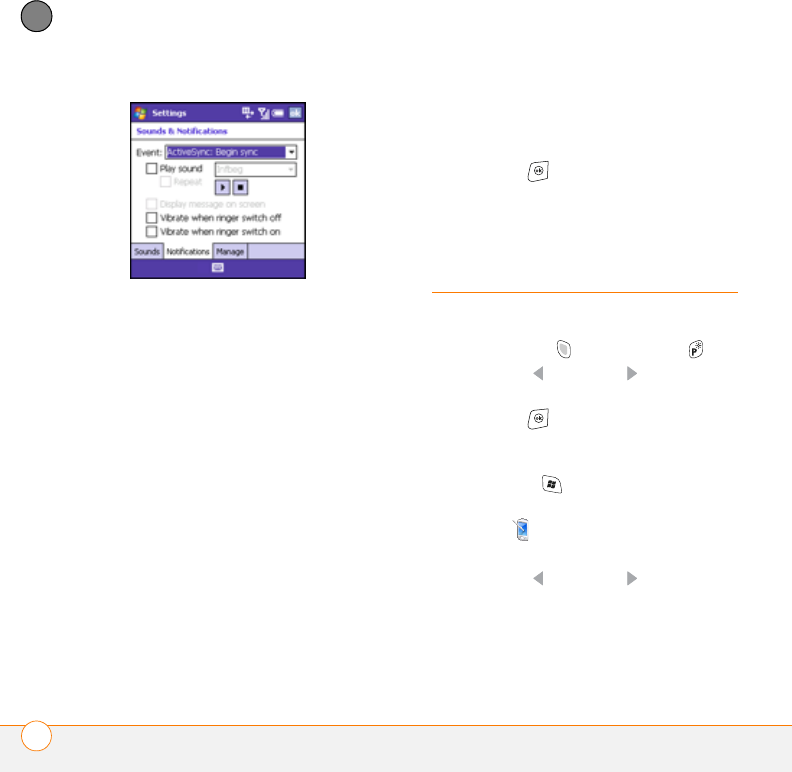
YOUR PERSONAL SETTINGS
DISPLAY AND APPEARANCE SETTINGS
238
13
CHAPTER
Event: Specifies the action for which
you want to change the settings. The
remaining options vary based on the
event you select.
Play sound: Lets you turn the sound
on/off for the selected event. To select a
different sound, select the list to the
right of this setting, and then select a
different sound. To preview the sound,
select Play Sound, and then select
Play.
Repeat: Indicates whether the sound
plays more than once, if turned on.
Display message on screen: Indicates
whether a notification message appears
onscreen for the selected event.
Vibrate: Indicates whether your
smartphone vibrates to notify you about
the selected event.
5Press OK .
Display and
appearance settings
Adjusting the brightness
1Press Option and then press .
2Press Left and Right to adjust the
brightness.
3Press OK .
Changing the text size and clarity
1Press Start and select Settings.
2Select the System tab, and then select
Screen .
3Select the Text Size tab.
4Press Left and Right to adjust the
text size.
5Select the Clear Type tab.
6To smooth the edges of screen fonts,
check the Enable Clear Type box.
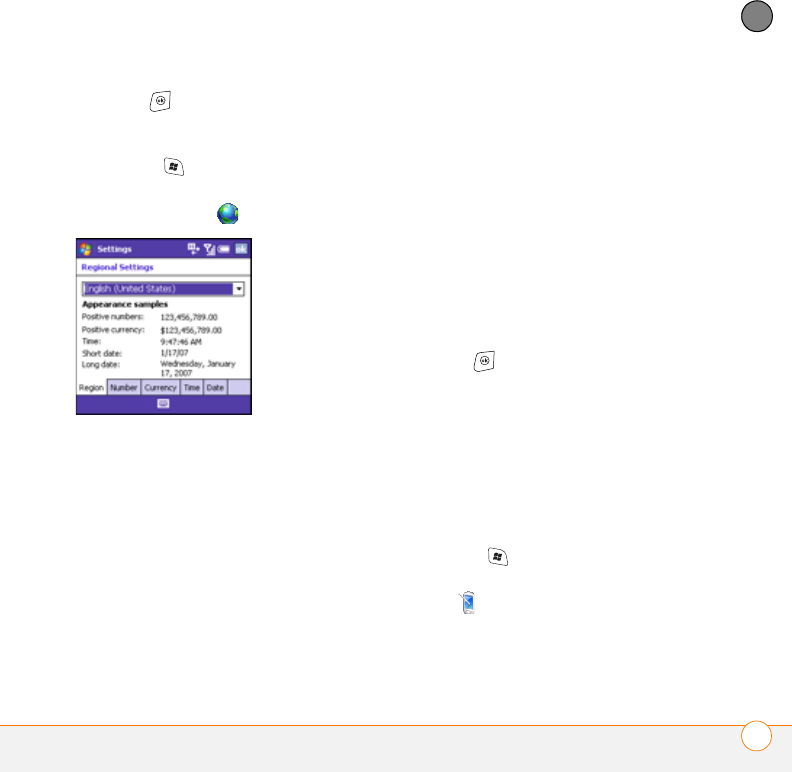
YOUR PERSONAL SETTINGS
DISPLAY AND APPEARANCE SETTINGS 239
13
CHAPTER
7Press OK .
Setting display formats
1Press Start and select Settings.
2Select the System tab, and then select
Regional Settings .
3On the Region tab, select a region from
the list. The region selection sets the
default format settings.
4(Optional) Select any of the following
tabs to customize the format settings:
Number: Sets the decimal symbol and
number of decimal places, the digit
grouping symbol and group size, list
separators, negative number sign
symbol and format, leading zero display,
and measurement system (metric vs.
U.S.).
Currency: Sets the currency symbol
and position, the decimal symbol and
position, digit grouping symbol and
group size, and negative number
format.
Time: Sets the time style, separators,
and AM and PM symbols.
Date: Sets the short date style,
separators, and long date style.
5Press OK .
Aligning the screen to correct tapping
problems
Occasionally, your screen may need to be
readjusted. You know your screen needs
adjustment when the wrong feature is
activated when you tap the screen. To fix
the problem, align the screen.
1Press Start and select Settings.
2Select the System tab, and then select
Screen .
3On the General tab, select Align
Screen.
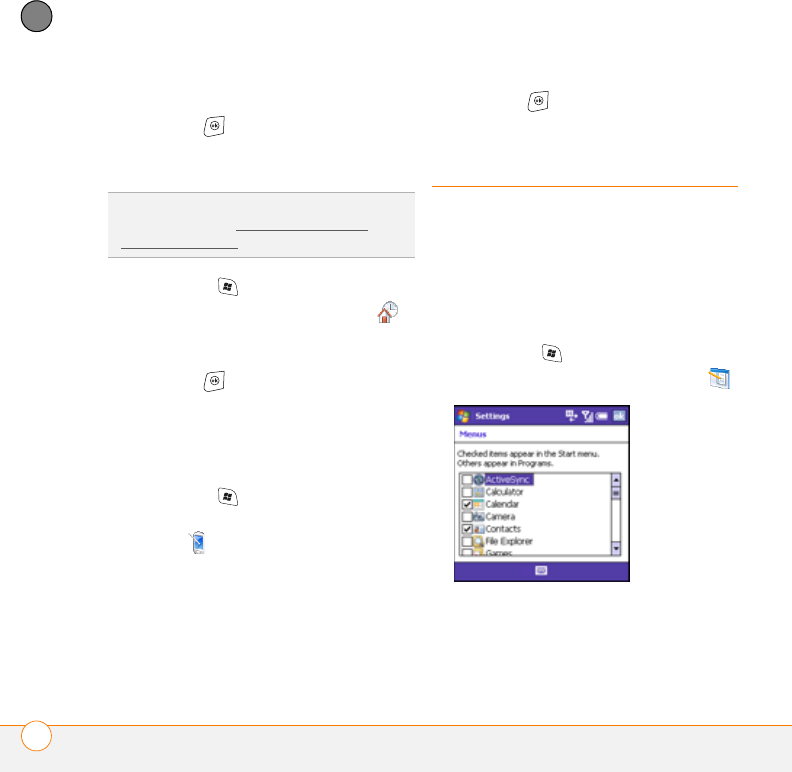
YOUR PERSONAL SETTINGS
APPLICATION SETTINGS
240
13
CHAPTER
4Tap the screen where indicated.
5Press OK .
Changing the system color scheme
1Press Start and select Settings.
2On the Personal tab, select To d a y .
3On the Appearance tab, select a theme
in the list.
4Press OK .
Changing screen orientation
Landscape orientations are determined by
which hand you would hold the stylus in.
1Press Start and select Settings.
2Select the System tab, and then select
Screen .
3Select the General tab.
4Select an orientation:
•Portrait
•Landscape (right-handed)
•Landscape (left-handed)
5Press OK .
Application settings
Arranging the Start menu
You can change the seven applications
listed on the Start menu. You can still
access the remaining applications by
selecting Programs from the Start menu,
and then selecting the application’s icon.
1Press Start and select Settings.
2On the Personal tab, select Menus .
3Check the boxes next to the
applications you want to see in the Start
menu.
TIP
You can also set the background for your
Today screen (see Selecting your Today
screen background).
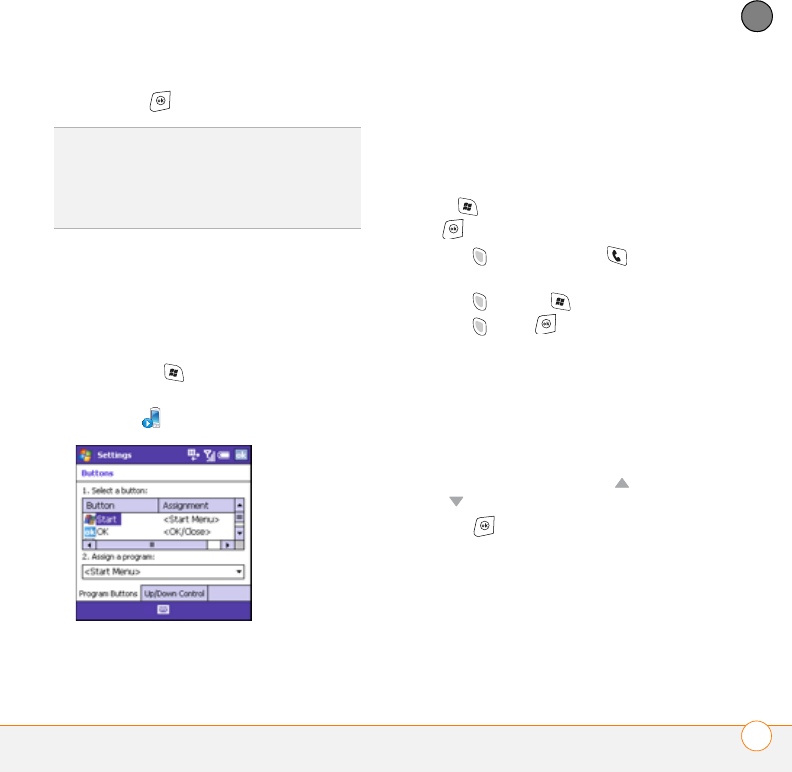
YOUR PERSONAL SETTINGS
APPLICATION SETTINGS 241
13
CHAPTER
4Press OK .
Reassigning buttons
You can use Buttons Settings to select
which applications to associate with many
of the buttons and key combinations on
your smartphone.
1Press Start and select Settings.
2On the Personal tab, select
Buttons .
3On the Program Buttons tab, highlight
the button or key combination you want
to change in the Button list. The
hardware buttons are mapped to the
following items:
•Start = Start menu
•OK = OK/Close
•Option + Phone/Send =
Messaging
•Option + Start = Calendar
•Option + OK = Task Manager
•Hold Side = Windows Media Player
4Select the Assign a program list, and
then select the application you want to
assign to the button or key combination
you selected in step 3.
5Select the Up/Down Control tab and
adjust the settings for the Up and
Down buttons on the 5-way.
6Press OK .
Setting up voice commands
IMPORTANT The Voice Command
application is available only for English,
French, and German.
TIP
Don’t forget the six icons across the top of
the Start menu. They’re the apps you opened
most recently, and it’s easy to get back to
them: just use the 5-way to select one of the
icons.
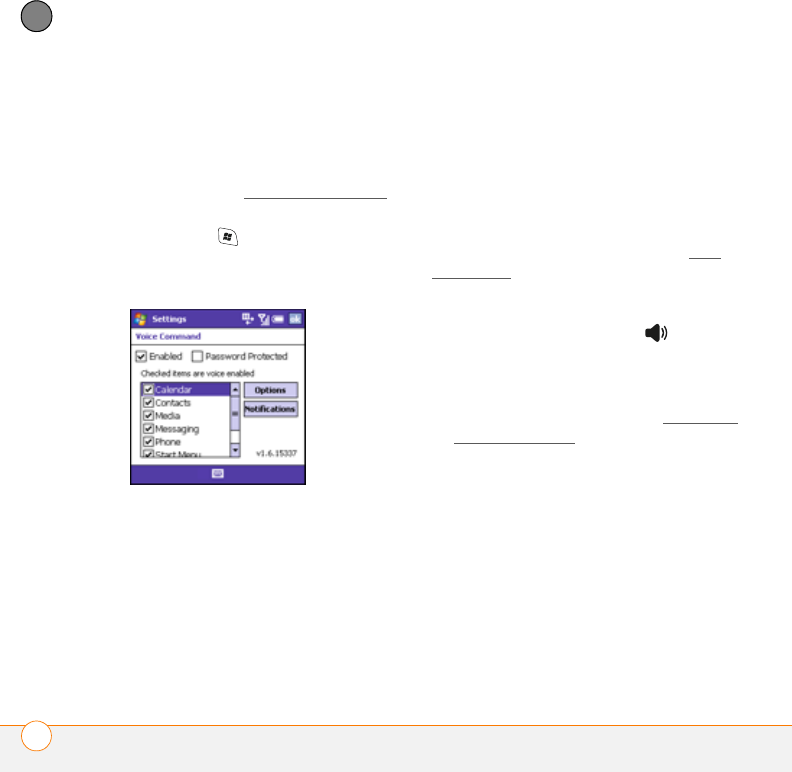
YOUR PERSONAL SETTINGS
APPLICATION SETTINGS
242
13
CHAPTER
Voice commands enable you to use speech
to execute some commands on the Start
menu and the Programs screen.
1Assign the Hold Side button to Voice
Command. See Reassigning buttons for
details.
2Press Start and select Settings.
3On the Personal tab, select Voice
Command.
4Select Enabled.
5Select the items you want to enable. If
an item is highlighted and the Options
button is active, select Options to
choose the features you want enabled
for the highlighted item.
6Select Notifications and select the
options for how you want to receive
voice command notifications.
Using voice commands
IMPORTANT Do not use voice commands
in your car until you read the End user
notice about this kind of usage; see End
user notice.
1Set the Ringer switch at the top of your
smartphone to Sound On .
2Hold your device about nine inches
(230mm) away from your mouth, and
then press and release the assigned
Voice Command button (see Setting up
voice commands). A tone plays and a
microphone icon appears at the top of
your screen.
3In a clear voice say the command. For
example:
•To access Help, say “Help.” After
Voice Command finishes speaking, a
microphone icon appears at the top of
your screen. Say your answer. For
example, say “General” to access
general Help topics.
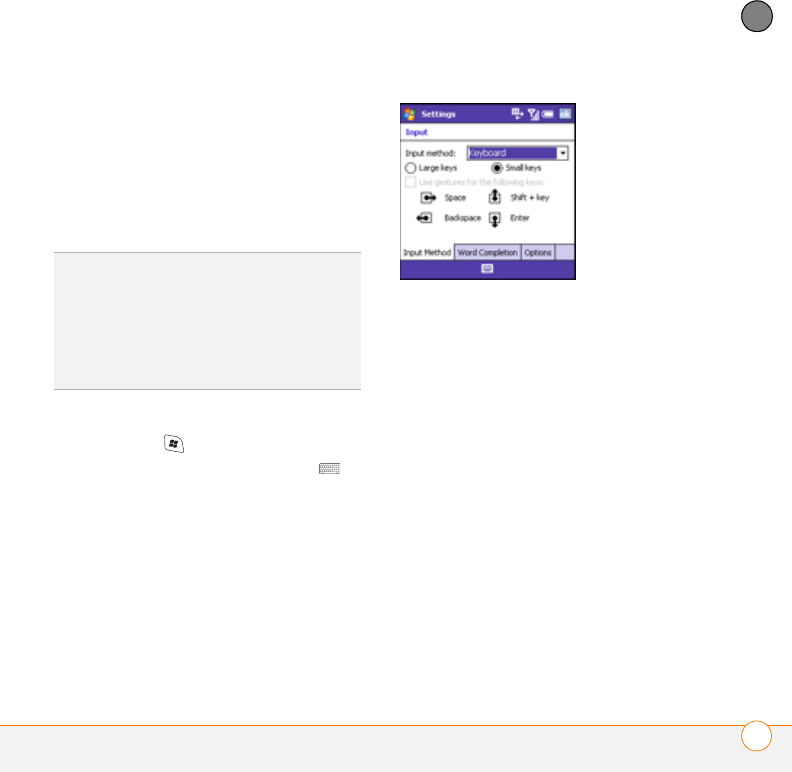
YOUR PERSONAL SETTINGS
APPLICATION SETTINGS 243
13
CHAPTER
•To access your Calendar, say “Start
Calendar.”
•To access your music, say “Start
Windows Media.” After Voice
Command finishes speaking, a
microphone icon appears at the top of
your screen. Say your answer.
Setting input options
1Press Start and select Settings.
2On the Personal tab, select Input .
3On the Input Method tab, set any of the
following options:
NOTE The Input Method options you
specify apply only to entering info using the
screen. You can still enter info using your
smartphone’s keyboard regardless of the
onscreen input method you choose.
Input method: Specifies which
onscreen input method you want to
use:
•Block Recognizer: Use a single
stroke to write letters, numbers,
symbols, and punctuation, which are
then converted into typed text. Use
gestures to enter Return and
Backspace.
•Keyboard: Tap keys on the onscreen
keyboard to enter text.
TIP
You can move quickly through voice
commands by stopping the voice command
response before it finishes. When Voice
Command responds, you can press the Voice
Command button before it completes the
question. After the microphone icon is visible,
you may say your answer.
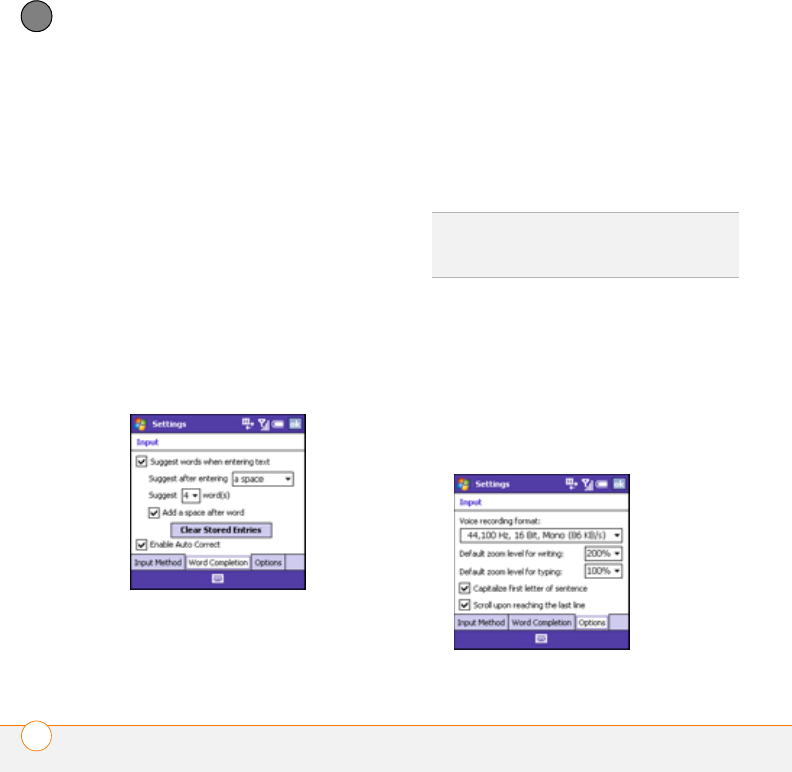
YOUR PERSONAL SETTINGS
APPLICATION SETTINGS
244
13
CHAPTER
•Letter Recognizer: Write individual
letters, numbers, and punctuation,
which are converted into typed text.
Large/Small keys: If you selected
Keyboard, select whether to use large
or small onscreen keys. If you select
Large keys, check the box if you want to
use gestures for the space, backspace,
shift, and enter keys.
Options: If you selected Letter
Recognizer, select Options and select
the options you want.
4Select the Word Completion tab and
set any of the following options:
Suggest words when entering text:
Indicates whether word suggestions
appear as you enter text. You can also
specify how many letters you want to
enter before a suggestion appears, how
many suggestions you want to see, and
whether a space appears after you
insert a suggested word.
Clear Stored Entries: Deletes the
database of word suggestions.
Enable Auto Correct: Indicates
whether common misspellings such as
“teh” are corrected automatically.
5Select the Options tab and set any of
the following options:
TIP
To enter a suggested word, press Down to
highlight the suggestion, and then press
Center to accept it.

YOUR PERSONAL SETTINGS
LOCKING YOUR SMARTPHONE AND INFO 245
13
CHAPTER
Voice recording format: Specifies the
format in which you save voice notes.
Default zoom level for writing:
Specifies the initial size of text entered
from onscreen writing methods.
Default zoom level for typing:
Specifies the initial size of text entered
using the keyboard.
Capitalize first letter of sentence:
Specifies whether the first letter of a
sentence automatically appears in
uppercase, without requiring you to
press a Shift key.
Scroll upon reaching the last line:
Specifies whether the display
automatically scrolls when you select
the last line of visible info.
6Press OK .
Locking your
smartphone and info
Your smartphone includes several features
that help you protect your smartphone
from inadvertent use and keep your
information private. The built-in security
software lets you use your smartphone for
emergency calls, such as dialing your
national emergency number (such as 911
or 112), even if it is locked.
Keyguard: Manually disables all buttons
and the screen’s touch-sensitive feature
to prevent accidental presses in your
briefcase or pocket.
Auto-Keyguard and touchscreen
lockout: Automatically enables Keyguard
after a period of inactivity and lets you
disable the screen’s touch-sensitive feature
during an active call.
Phone Lock: Requires a PIN to turn on
your phone so you can make and answer
calls.
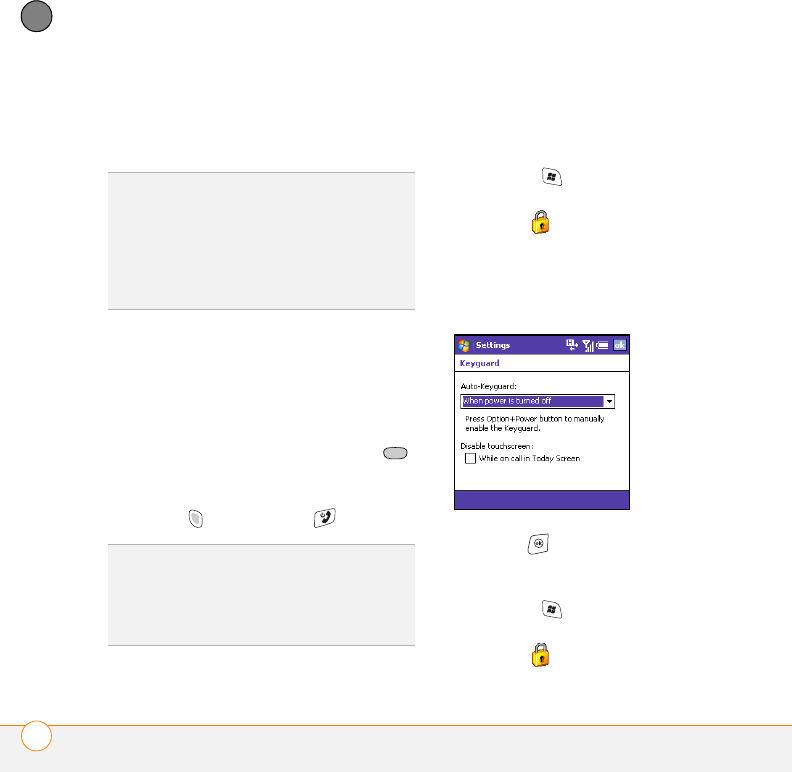
YOUR PERSONAL SETTINGS
LOCKING YOUR SMARTPHONE AND INFO
246
13
CHAPTER
System password lock: Requires a
password to see any information on your
smartphone.
Locking your keyboard (Keyguard)
By default, your keyboard locks so that you
don’t accidentally press buttons or activate
screen items while your smartphone is in a
pocket or bag.
•To dismiss Keyguard, press Center .
•To manually turn on Keyguard when
your smartphone screen is on, press
Option + Power/End .
Turning on Auto-Keyguard
Auto-Keyguard enables you to configure
the Keyguard feature.
1Press Start and select Settings.
2On the Personal tab, select
Keyguard .
3Select the Auto-Keyguard list and then
disable the Auto-Keyguard feature or set
the period of inactivity that passes
before the keyboard automatically locks.
4Press OK .
Locking your screen
1Press Start and select Settings.
2On the Personal tab, select
Keyguard .
TIP
To avoid accidentally pressing onscreen
buttons while you’re holding your smartphone
up to your ear to speak, you can disable the
screen’s touch-sensitive feature during active
calls. When the screen’s touch-sensitive
feature is disabled, you must use the 5-way
navigator to access items on the screen.
TIP
If you’re using a headset or hands-free
device and your smartphone is in a pocket or
bag, you can manually turn on Keyguard
during a call to prevent accidental key
presses.
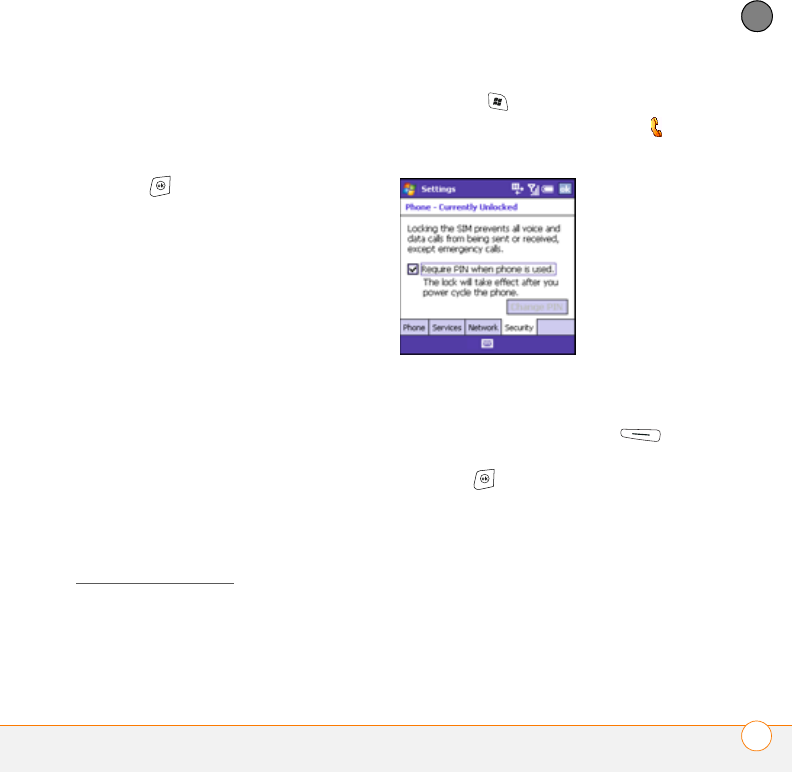
YOUR PERSONAL SETTINGS
LOCKING YOUR SMARTPHONE AND INFO 247
13
CHAPTER
3Check or uncheck the Disable
touchscreen box to determine whether
the screen’s touch-sensitive feature is
enabled during a call.
4Press OK .
Locking the SIM card
You can lock your SIM (Subscriber Identity
Module) card to prevent unauthorized use
of your mobile account. When your SIM
card is locked, you must enter the PIN to
power on your phone to make or receive
calls, except for emergency numbers. The
SIM card remains locked even if you move
the card to another phone.
When your SIM card is locked, you can
unlock your SIM card by trying to turn on
the phone. A dial pad appears for you to
enter your PIN.
BEFORE YOU BEGIN
•Make sure your phone is on and that
you’re inside a coverage area (see
Turning your phone on).
•Get your default PIN from your wireless
service provider.
1Press Start and select Settings.
2On the Personal tab, select Phone .
3Select the Security tab.
4Check the Require PIN when phone is
used box.
5Enter the PIN and press Done
(left action key).
6Press OK .
7Turn your phone off to activate the
phone lock feature.
Your SIM card locks when you turn off your
phone and turn it back on. When your SIM
card is locked, you can unlock your SIM
card by entering your PIN.
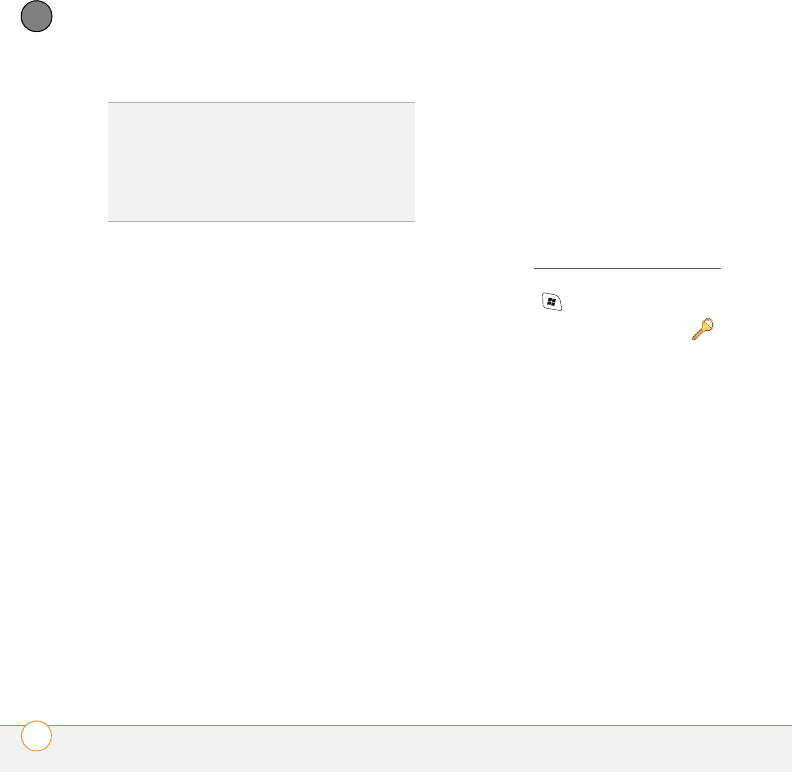
YOUR PERSONAL SETTINGS
LOCKING YOUR SMARTPHONE AND INFO
248
13
CHAPTER
NOTE You need your PIN number to edit
your PIN number or remove the locking
feature. If you enter an incorrect PIN more
times than allowed by your wireless
service provider, the SIM card locks. After
the SIM card locks, you need the PUK (PIN
Unlock Key) to unlock the SIM card.
Contact your wireless service provider for
more information and the PUK.
Locking your smartphone
To protect your personal information, you
can lock the system so that you need to
enter your password to access any of your
information or use other features of
your smartphone.
IMPORTANT If you lock your system, you
must enter the exact password to unlock it.
If you enter an incorrect password, you are
given another chance. Each time an
incorrect password is entered, you are
given progressively longer time periods
between your chances to enter the
password. If you forget the password, you
need to perform a hard reset to resume
using your smartphone. Performing a hard
reset deletes all the entries in your
smartphone. However, you can restore all
previously synchronized info the next time
you sync (see Synchronizing information).
1Press Start and select Settings.
2On the Personal tab, select Lock .
3On the Password tab, check the
Prompt if device unused for box to
turn on the password feature.
4Select the first list, and then select how
long a period of inactivity must pass
before you are prompted to enter a
password to unlock the system.
5Select the Password type list, and then
select a format for your password:
Strong alphanumeric: A strong
alphanumeric password must contain at
least 7 characters and must contain a
combination of letters, numerals, and
punctuation. You must press Option or
Alt before entering numerals or
punctuation.
DID
YOU
KNOW
?
You can permanently unlock your
SIM card. From your Today screen, press
Menu and select Preferences > Phone
Settings. Select the Security tab, and
uncheck the Require PIN when phone is
used box.
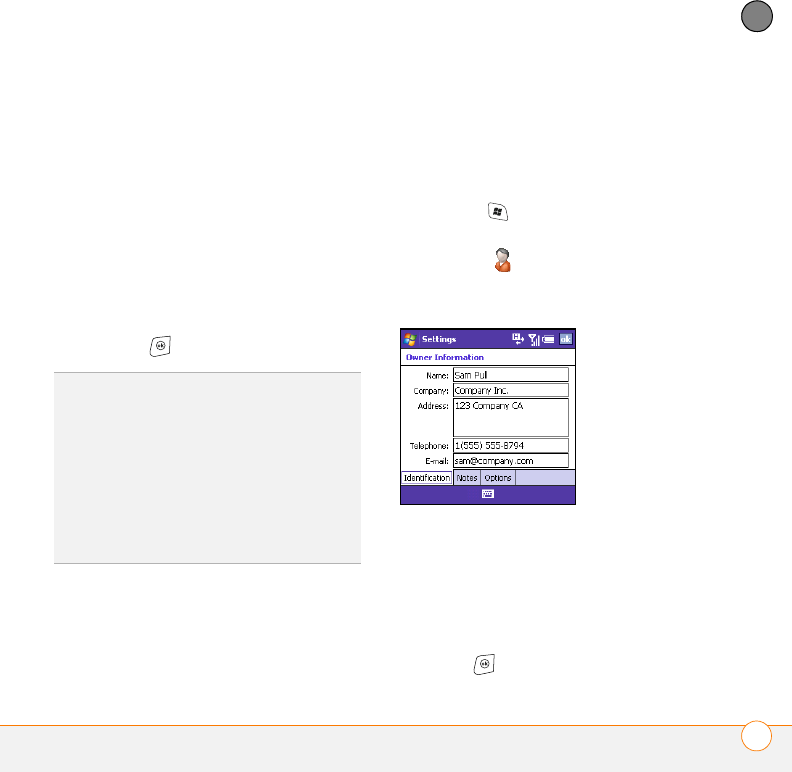
YOUR PERSONAL SETTINGS
LOCKING YOUR SMARTPHONE AND INFO 249
13
CHAPTER
Simple PIN: A simple PIN must contain
at least 4 characters and includes
numerals only. You do not need to press
Option before entering the PIN
numerals.
6Select Password and enter your
password.
7Select Confirm and enter the password
again.
8(Optional) Select the Hint tab and enter
a hint to help you recall your password.
9Press OK .
Entering owner information
You can enter personal information that you
want to associate with your smartphone,
such as your name, company name, and
phone number. You can also set whether
you want this information to appear when
you turn on your smartphone. If you lose
your smartphone, this feature can help the
person who finds it return it to you.
1Press Start and select Settings.
2On the Personal tab, select Owner
Information .
3On the Identification tab, enter any of
the information you want to include.
4Select the Notes tab and enter any
additional text you want to include.
5Select the Options tab and check the
boxes to indicate which info (if any) you
want to appear on the screen when you
turn on your smartphone.
6Press OK .
TIP
If you lock your smartphone and use a
Simple PIN as the password, you can dial an
emergency number by entering the number in
the password field and pressing Phone/Send.
You do not need to press Option before
entering the number. However, if you select
Strong alphanumeric as the password type,
you must first press Option twice before
entering an emergency number in the
password field.
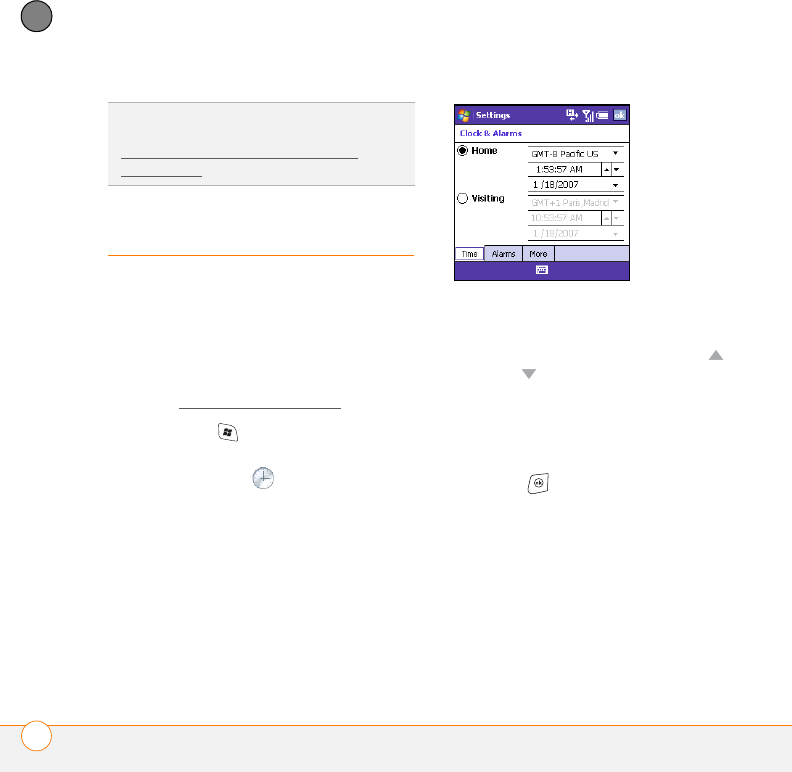
YOUR PERSONAL SETTINGS
SYSTEM SETTINGS
250
13
CHAPTER
System settings
Setting the date and time
Use Clock & Alarms Settings to set the
time zone, time, and date for your home
location and a location that you visit.
To set the display format for the date and
time, see Setting display formats.
1Press Start and select Settings.
2Select the System tab, and then select
Clock & Alarms .
3On the Time tab, select Home.
4Select the first list, and then select the
time zone for your home location.
5Select the hour, and then press Up
or Down to increase or decrease the
hour setting. Repeat this process for the
minute, seconds, and AM/PM settings.
6(Optional) Select Visiting and set the
info for a location that you visit often.
7Press OK .
8If prompted, select Ye s to accept your
changes.
Synchronizing the date, time, and time
zone with the network
By default your smartphone synchronizes
the date, time, and time zone with your
wireless service provider’s network
TIP
You can also display your Owner
Information on your Today screen. See
Selecting which items appear on your
Today screen for details.
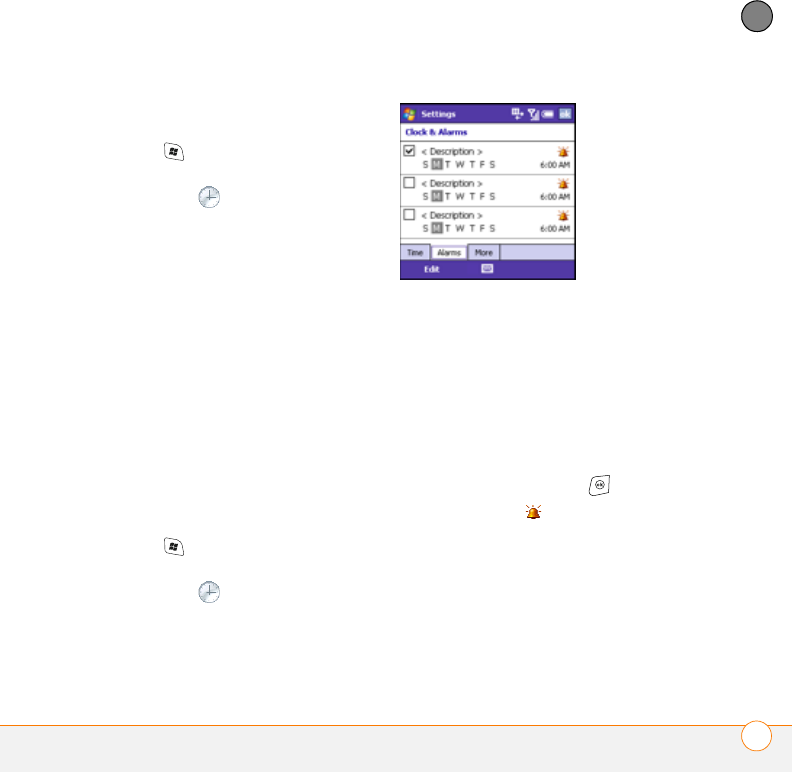
YOUR PERSONAL SETTINGS
SYSTEM SETTINGS 251
13
CHAPTER
whenever your phone is on and you are
inside a coverage area.
1Press Start and select Settings.
2Select the System tab, and then select
Clock & Alarms .
3Select the More tab.
4To disable this option, uncheck the
Enable local network time box.
5If you want to keep your smartphone
date and time set for your selected
location, uncheck the Use network
time zone box.
Setting system alarms
System alarms let you set alarms that are
not associated with a task or appointment.
For example, you can use your smartphone
as an alarm clock when you travel, or set
alarms to remind you when it’s time to take
medication or pick up the kids.
1Press Start and select Settings.
2Select the System tab, and then select
Clock & Alarms .
3Select the Alarms tab.
4Check a box to turn on that alarm.
5Select the description next to the box
you checked and enter a description for
the alarm.
6Select the days of the week you want
the alarm to go off. You can select
multiple days for each alarm.
7Select the time you want the alarm to
go off, and then press OK .
8Select the alarm icon, and then
check the boxes to select how you want
the alarm to go off. You can choose a
flashing light, a single sound, a
repeating sound, or vibration.
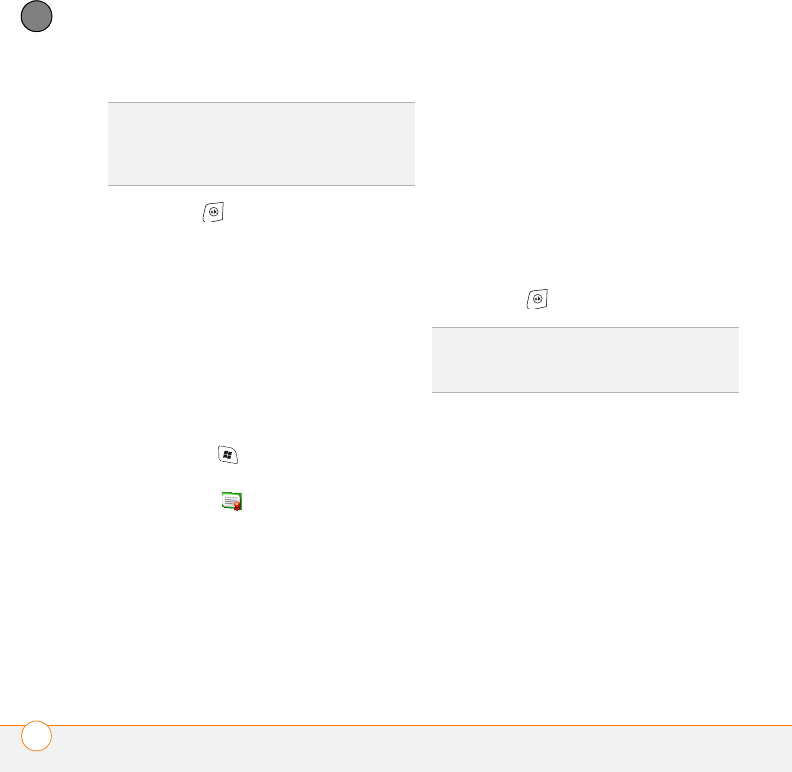
YOUR PERSONAL SETTINGS
SYSTEM SETTINGS
252
13
CHAPTER
9Press OK twice.
10 If prompted, select Ye s to accept your
changes.
Managing identity certificates
Your smartphone may include preinstalled
certificates. Certificates are digital
documents that are used to authenticate
and exchange information on networks.
Certificates can be issued for a user, a
device, or a service.
1Press Start and select Settings.
2Select the System tab, and then select
Certificates .
3Select any of the following tabs:
Personal: Displays certificates that
establish your identity when you log in
to a secured network, such as a
corporate network.
Intermediate: Displays certificates
issued by the root whose purpose is to
then issue personal certificates.
Root: Displays certificates that identify
the computers, such as servers, to
which you connect. These certificates
help prevent unauthorized users from
accessing your smartphone and
information.
4Press OK .
Enabling error reporting
Error Reporting sends info that helps
diagnose application errors for devices
running Windows Mobile® software. When
an error is detected, a text file is created.
You can review the file and choose
whether you want it delivered to Microsoft
technical support. The information is used
by programming groups at Microsoft for
quality control and is not used for tracking
individual users or installations for any
marketing purpose. The info that is
collected is technical info about the state of
TIP
To change the alarm sound, select the
alarm sound icon, select the Play Sound list,
and then select the alarm sound you want to
use.
TIP
To delete a certificate, tap and hold the
certificate in the list, and then select Delete
from the shortcut menu.
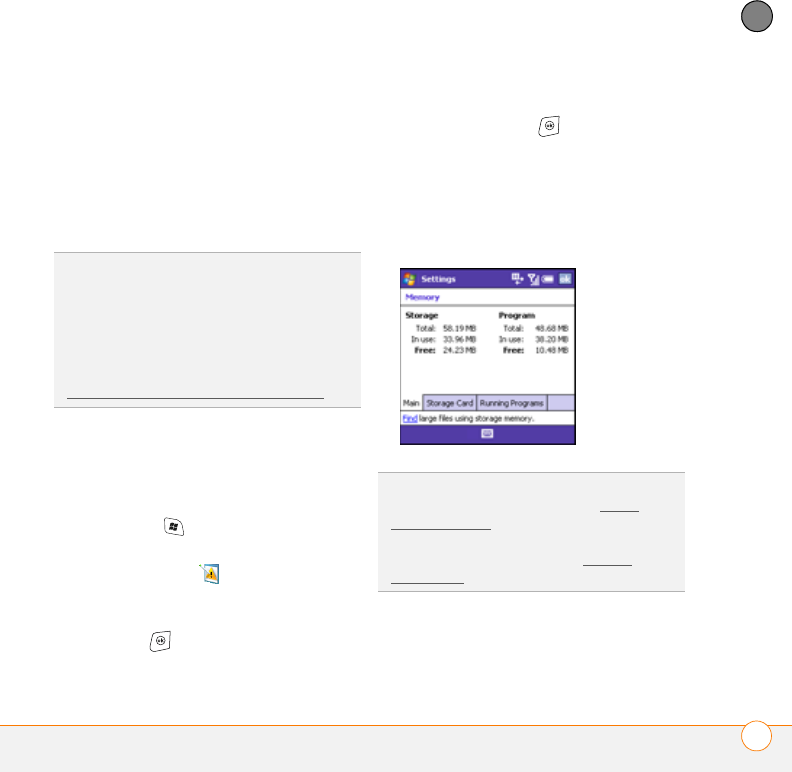
YOUR PERSONAL SETTINGS
SYSTEM SETTINGS 253
13
CHAPTER
your system when the error occurred. No
documents (or any info contained in them)
are intentionally sent with the report. To
ensure further security, the report is
transmitted via a secure connection and is
kept confidential and anonymous in a
limited-access database.
Your smartphone must be connected to
your computer when you send the error
report—provided your computer is
connected to the Internet.
1Press Start and select Settings.
2Select the System tab, and then select
Error Reporting .
3Select whether you want to enable or
disable error reporting.
4Press OK .
How much storage space do I have left?
1Press and hold OK .
2Select any of the following tabs:
Main: Displays the amount of memory
assigned to your applications and info,
as well as the amount of memory in use
versus the available memory.
DID
YOU
KNOW
?
This error reporting method meets
the privacy regulations of the European Union
(EU) as well as the Fair Information Practice
Principles of the Federal Trade Commission in
the United States. To view the Fair
Information Practice Principles, visit the
Federal Trade Commission website at
www.ftc.gov/reports/privacy3/fairinfo.htm.
TIP
If storage memory is low, consider using an
expansion card to store files (see Using
expansion cards). If program memory is low,
close some applications to avoid slow
smartphone performance (see Closing
applications).
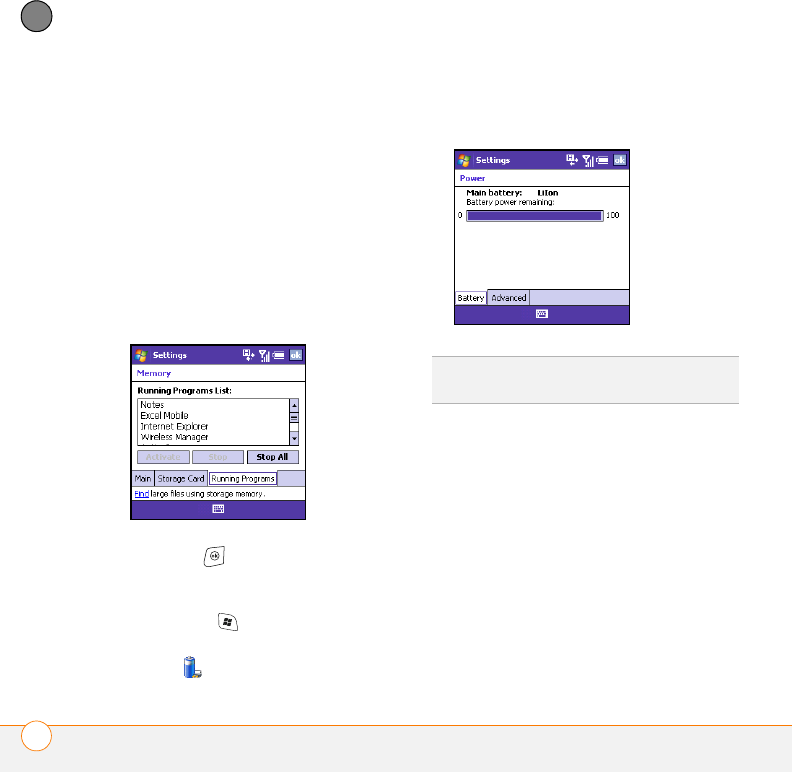
YOUR PERSONAL SETTINGS
SYSTEM SETTINGS
254
13
CHAPTER
Storage Card: Displays the amount of
memory available on an expansion card
that is inserted in the expansion slot on
your smartphone.
Running Programs: Lists the
applications that are in use on your
smartphone. To switch to an application,
highlight it and select Activate. To close
an application, highlight it and select
Stop. To close all open applications,
select Stop All.
3Press OK .
Optimizing power settings
1Press Start and select Settings.
2Select the System tab, and then select
Power .
3On the Battery tab, view the power
remaining in your battery.
4Select the Advanced tab and set
whether your smartphone screen turns
off automatically after a specified period
of inactivity. You can assign different
intervals for battery power and external
power.
TIP
An easy way to check the battery level is by
tapping the Battery icon in the title bar.

YOUR PERSONAL SETTINGS
SYSTEM SETTINGS 255
13
CHAPTER
5Press OK .
Turning wireless services on/off
1From the Today screen, press
Menu (right action key) and
select Wireless Manager.
2Turn the wireless features on your
smartphone on/off. Select All to turn all
wireless features on/off.
3Press OK .
You can also turn wireless services on and
off by tapping the signal-strength icon
at the top of the screen, and selecting
Wireless Manager.
TIP
To conserve additional battery power,
adjust the display backlight setting. Press
Start and select Settings. Select the System
tab, and then select Backlight. On the Battery
Power tab, set whether the display backlight
turns off automatically after a period of
inactivity.
TIP
To change the settings for one of the
displayed wireless features, press Menu (right
action key) and select the wireless feature you
want to change.

YOUR PERSONAL SETTINGS
CONNECTION SETTINGS
256
13
CHAPTER
Connection settings
Managing ISP settings
Your smartphone is already set up to
connect to the Internet using a high-speed
data connection on your wireless service
provider’s network. To connect to the
Internet, simply start Internet Explorer
Mobile.
For special situations, such as connecting
to your internet service provider (ISP) or to
a remote access server (RAS), you can set
up another connection.
BEFORE YOU BEGIN Obtain the following
information from your ISP or system
administrator:
•ISP server phone number or access
point
•Username
•Password
1Press Start and select Settings.
2Select the Connections tab, and then
select Connections .
3On the Tasks tab, select Manage
existing connections.
4Select the Modem tab.
5Highlight the connection you want to
view or change, and then select Edit, or
to create a new connection, select
New.
6Follow the onscreen instructions to edit
or create the connection.
Connecting to a VPN
If you want to use your smartphone to
access your corporate email account or
other files on your corporate server, you
may need to set up a VPN (virtual private
network). A VPN enables you to log in to
your corporate server through the
company’s firewall (security layer).
BEFORE YOU BEGIN Check with your
company’s system administrator to see if a
VPN is required to access the corporate
network. If you need a VPN, you
must purchase and install a third-party VPN
client to use this feature.
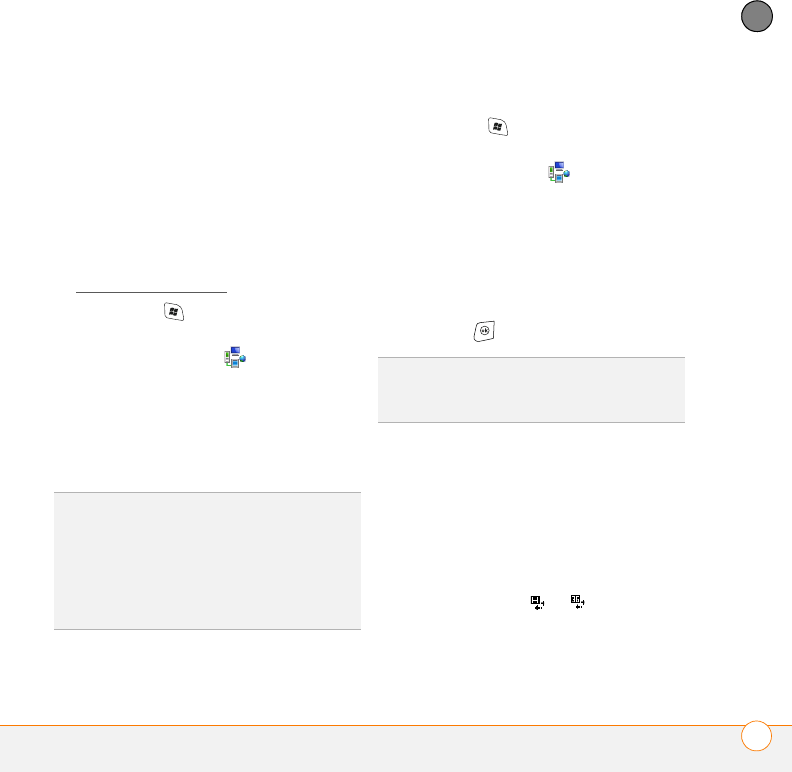
YOUR PERSONAL SETTINGS
CONNECTION SETTINGS 257
13
CHAPTER
Ask your corporate system administrator
for the following information:
•Your username and password
•Your server’s domain name
•Your server’s TCP/IP settings
•Your server’s host name or IP address
1Install your third-party VPN client (see
Installing applications).
2Press Start and select Settings.
3Select the Connections tab, and then
select Connections .
4On the Tasks tab, select Add a new
VPN server connection.
5Follow the onscreen instructions to
enter the settings provided by your
corporate system administrator.
Setting up a proxy server
1Press Start and select Settings.
2Select the Connections tab, and then
select Connections .
3On the Tasks tab, select Set up my
proxy server.
4Check both boxes near the top of the
screen.
5Select Proxy server and enter the proxy
server name.
6Press OK .
Ending a data connection
If your service plan includes
minutes-of-use fees for data connections,
you can reduce costs by ending the data
connection when you’ve finished browsing
the web.
1Use the stylus to tap one of the data
connection icons ( or ) on the title
bar.
TIP
To manually start a data connection on your
wireless service provider’s network or another
network, go to Connections Settings, and on
the Tasks tab, select Manage existing
connections. Tap and hold the connection
you want to start, and then select Connect
from the shortcut menu.
TIP
To change settings such as the port
number, proxy server type, or credentials,
select Advanced.

YOUR PERSONAL SETTINGS
SUBMITTING USAGE INFORMATION TO MICROSOFT
258
13
CHAPTER
2Select Disconnect from the shortcut
menu.
Submitting usage
information to
Microsoft
You can choose to anonymously send
information about your smartphone usage
to Microsoft. This information helps the
company improve its Windows Mobile
software. No personal information is
submitted, you do not incur data charges,
and participation is voluntary.
1Press Start and select Settings.
2Select the System tab, and then select
Customer Feedback .
3Select Send Feedback.

CHAPTER
14
Troubleshooting
Although we can’t anticipate all the questions you might have,
this chapter provides answers to some of the most commonly
asked questions. For additional information and answers to
other common questions, visit www.palm.com/
treo800W-support.

In this chapter
Transferring info from another device . . . . . . . . . . . . . . . . . . . . . . . 261
Reinstalling the desktop software . . . . . . . . . . . . . . . . . . . . . . . . . . 261
Resetting your smartphone . . . . . . . . . . . . . . . . . . . . . . . . . . . . . . . 262
Performance. . . . . . . . . . . . . . . . . . . . . . . . . . . . . . . . . . . . . . . . . . . 266
Screen . . . . . . . . . . . . . . . . . . . . . . . . . . . . . . . . . . . . . . . . . . . . . . . 267
Network connection. . . . . . . . . . . . . . . . . . . . . . . . . . . . . . . . . . . . . 267
Synchronization . . . . . . . . . . . . . . . . . . . . . . . . . . . . . . . . . . . . . . . . 272
Email . . . . . . . . . . . . . . . . . . . . . . . . . . . . . . . . . . . . . . . . . . . . . . . . 278
Web . . . . . . . . . . . . . . . . . . . . . . . . . . . . . . . . . . . . . . . . . . . . . . . . . 281
Camera. . . . . . . . . . . . . . . . . . . . . . . . . . . . . . . . . . . . . . . . . . . . . . . 282
Third-party applications . . . . . . . . . . . . . . . . . . . . . . . . . . . . . . . . . . 283
Making room on your smartphone. . . . . . . . . . . . . . . . . . . . . . . . . . 284
Voice quality . . . . . . . . . . . . . . . . . . . . . . . . . . . . . . . . . . . . . . . . . . . 285

TROUBLESHOOTING
TRANSFERRING INFO FROM ANOTHER DEVICE 261
14
CHAPTER
Transferring info from
another device
For information on transferring your info
from a previous Windows Mobile® device
or from a Palm OS® device to your new
Palm® Treo™800W smartphone, visit
www.palm.com/treo800W-support for
instructions.
IMPORTANT Do not use a backup utility to
transfer your info from another device to
your new smartphone. This can cause your
smartphone to malfunction.
Reinstalling the
desktop software
If you have problems synchronizing using
your desktop sync software, you may need
to reinstall the software.
BEFORE YOU BEGIN Make sure your
computer profile includes administrator
rights to install software. In large
organizations, these are usually granted
by the system administrator.
1Shut down your computer and turn it on
again.
2On your computer, click Start > Control
Panel > Add or Remove Programs.
3Remove your desktop software. For
computers running Windows XP, the
software is called Microsoft ActiveSync.
For computers running Windows Vista,
the software is called Windows Mobile
Device Center.
4Quit any active applications, including
virus scanners and Internet security
applications.
DID
YOU
KNOW
?
You can purchase a third-party
application that lets you run Palm OS®
applications on your smartphone.
DID
YOU
KNOW
?
If you have questions about
Windows Mobile, you can go to the Microsoft
Windows Mobile website. Search for Palm
devices for information.
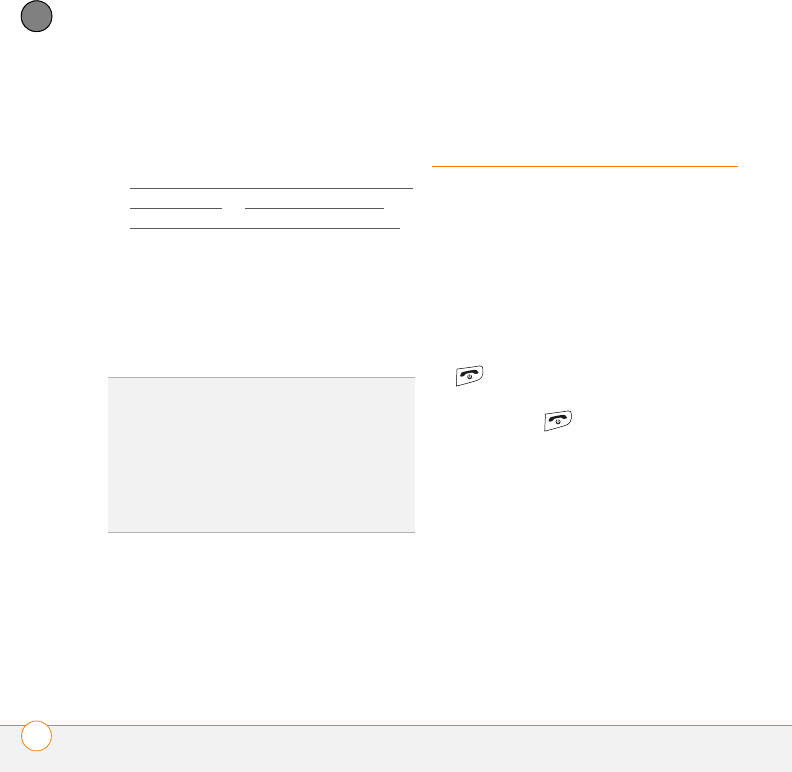
TROUBLESHOOTING
RESETTING YOUR SMARTPHONE
262
14
CHAPTER
5To reinstall the software, insert the
Windows Mobile Getting Started CD
into your computer’s CD drive, and
follow the onscreen instructions. See
Installing ActiveSync desktop software:
Windows XP or Installing Windows
Mobile Device Center: Windows Vista
for detailed instructions.
You must install the desktop sync
software that came with your
smartphone on the Windows Mobile
Getting Started CD. Other versions do
not work with this smartphone.
Resetting your
smartphone
Performing a soft reset
Performing a soft reset is similar to
restarting a computer. If your smartphone
is not responding or you have trouble
synchronizing with your computer, a soft
reset may help.
1If your smartphone responds to key
presses, press and hold Power/End
to turn off your phone.
2If the screen display is on, press
Power/End to turn off the screen.
3Open the expansion card slot door on
the side of your smartphone.
4Use the stylus tip to gently press the
reset button next to the expansion card
slot.
DID
YOU
KNOW
?
The Windows Mobile Getting
Started CD installs the software and drivers
that let you synchronize with Microsoft Office
Outlook®. If you want to synchronize with a
different personal information manager (PIM),
you must install a third-party solution. Contact
the PIM’s vendor to learn if software
is available for your smartphone.
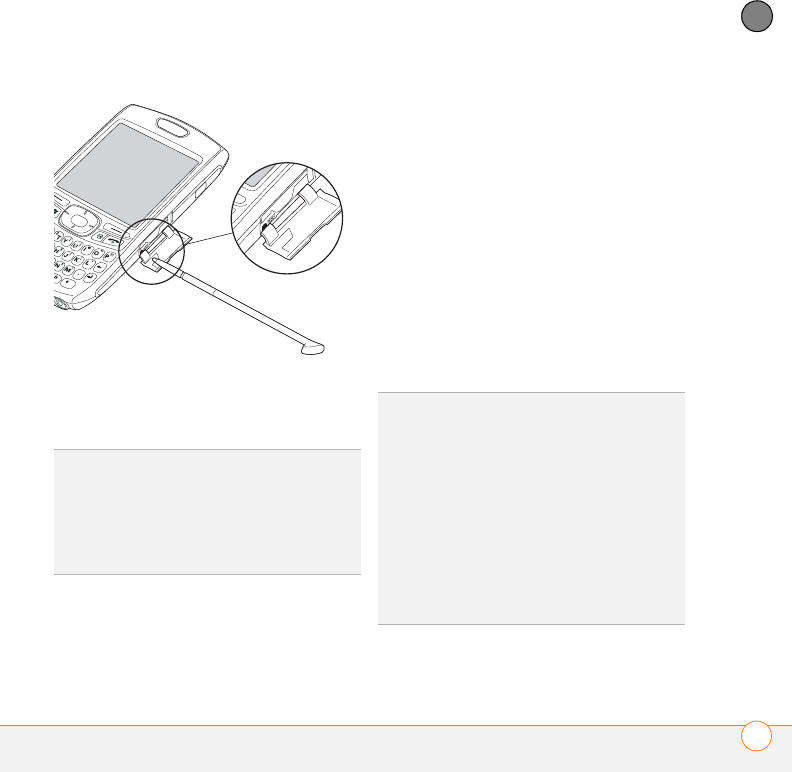
TROUBLESHOOTING
RESETTING YOUR SMARTPHONE 263
14
CHAPTER
5Wait for the progress bar on the Treo
logo screen to fill before continuing to
use your smartphone.
Performing a hard reset
A hard reset erases all personal
information, such as appointments,
contacts, and tasks, as well as programs
you have added, such as third-party
software on your smartphone. Never do a
hard reset without first trying a soft reset.
You can restore previously synchronized
information the next time you sync.
IMPORTANT Synchronize to restore your
Outlook data, such as Outlook email,
Calendar, Contacts, Notes, and Tasks. You
can use a backup and restore solution.
Make sure it’s an application that’s
approved by Palm, such as the one
included on the Windows Mobile Getting
Started CD.
TIP
You can also do a soft reset by removing
the battery and reinserting it.
DID
YOU
KNOW
?
If the phone or the Bluetooth®
wireless technology feature was on before a
reset, these automatically turn on after the
reset.
TIP
Some third-party applications do not create
a backup on your computer when you
synchronize. If you do a hard reset, you may
lose info in these applications and you need to
reinstall the application on your smartphone
after the hard reset. Please contact the
application vendor to find out if your info is
backed up during synchronization.
DID
YOU
KNOW
?
When you synchronize after a hard
reset, the source folder in My Documents
changes from Treo My Documents to
WM_your name.
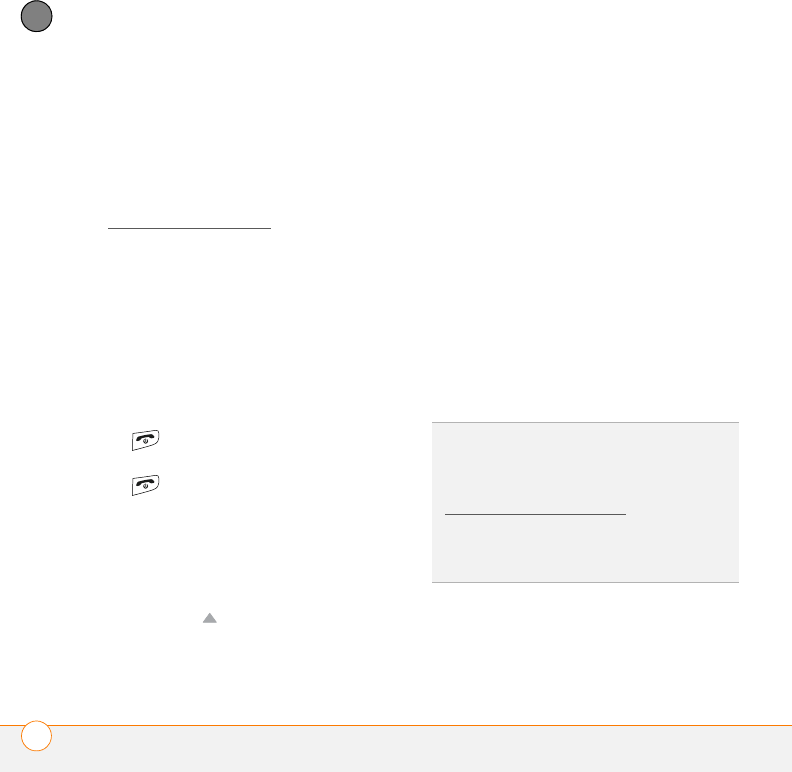
TROUBLESHOOTING
RESETTING YOUR SMARTPHONE
264
14
CHAPTER
A hard reset can tell you whether a
problem stems from your smartphone or
from an application installed on it. If you do
not experience the problem after you
perform a hard reset, the problem may be
related to software you installed. See
Third-party applications for suggestions on
diagnosing third-party software issues.
1Synchronize your smartphone with your
computer so that your smartphone
applications and info can be restored by
synchronizing again after you perform
the hard rest.
2Open the expansion card slot door on
the side of your smartphone.
3If the screen is off, press Power/End
to wake up the screen.
4While pressing and holding Power/End
, use the tip of the stylus to gently
press and hold the reset button next to
the expansion card slot.
5Continue pressing and holding both
buttons until the “Erase all data?”
prompt appears.
6Press Up to confirm the hard reset.
7Wait for the progress bar on the Treo
logo screen to fill before continuing to
use your smartphone.
8(Optional) Synchronize to restore your
previously synchronized info. If you use
a backup utility, you may also need to
restore a backup to recover additional
info and settings.
Replacing the battery
Your smartphone comes with a replaceable
battery. Be sure to use a replacement
battery from Palm that is compatible with
Treo 800W models. Do not use a battery
from any earlier model of smartphone.
TIP
Be sure to dispose of your old battery in an
environmentally responsible and legal way. In
some areas, disposal in household or
business trash is prohibited. Visit
www.palm.com/environment for more
information.
DID
YOU
KNOW
?
Your smartphone stores all your
info even when you remove the battery.
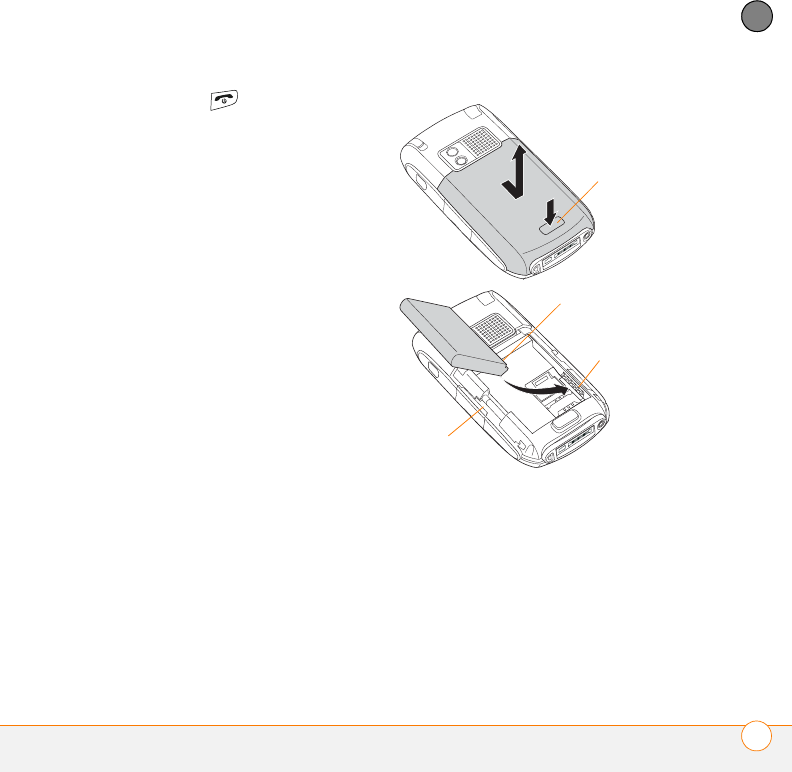
TROUBLESHOOTING
RESETTING YOUR SMARTPHONE 265
14
CHAPTER
1Press Power/End to turn off the
screen.
2Use one hand to press the Battery
door release and use the other hand to
slide the battery door downward to
remove it from your smartphone.
3Place a finger in the notch between the
stylus and the battery, and lift the
battery at a 45-degree angle.
4Align the new battery’s contacts with
the phone contacts inside the battery
compartment.
5Insert the new battery into the
compartment at a 45-degree angle,
pressing it into place. Slide the battery
door onto the back of the smartphone
until it clicks into place.
6Wait for the screen to turn on.
Battery door
release
Notch
Phone
contacts
Battery
contacts
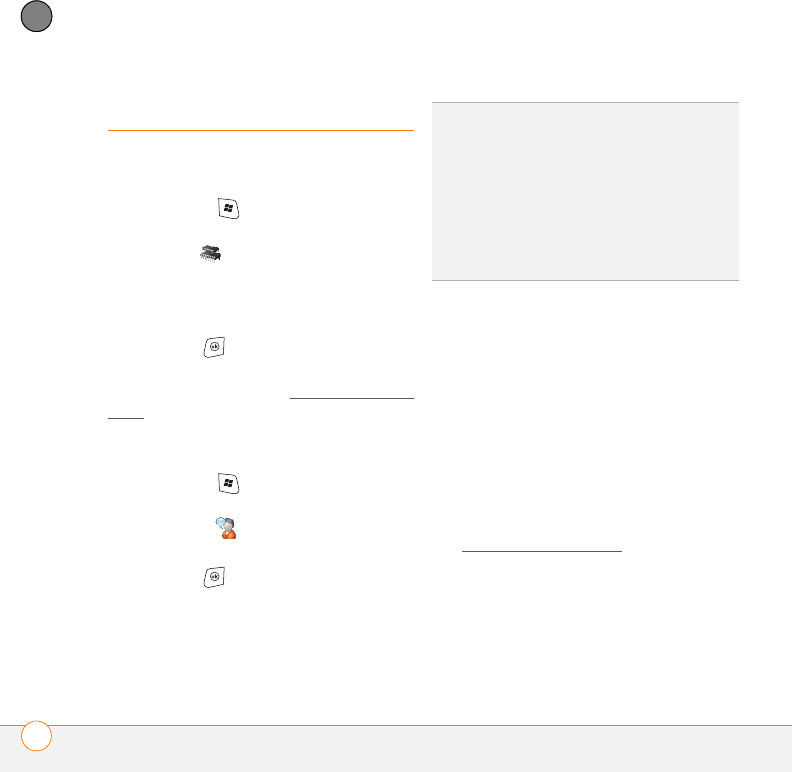
TROUBLESHOOTING
PERFORMANCE
266
14
CHAPTER
Performance
The applications are running slower than
usual
1Press Start and select Settings.
2Select System, and then select
Memory .
3Select Running Programs.
4Select Stop All to close all your open
applications.
5Press OK .
If the previous steps don’t fix the problem,
try doing a soft reset (see Performing a soft
reset). If the problem persists, follow these
steps to turn off the Voice Command
setting, if it is enabled:
1Press Start and select Settings.
2Select Personal, and then select Voice
Command .
3Uncheck the Enabled box.
4Press OK .
My battery seems to drain quickly
If you have a push email solution (such as
GoodLink™ wireless messaging) or if you
have set up a schedule for wireless
synchronization, check with your email
provider or system administrator to make
sure that the server is set up properly to
work with your smartphone. Incorrect
server setup can cause excessive drain on
your battery.
For more tips on conversing battery life,
see Maximizing battery life).
TIP
Be sure that third-party applications are
designed for Windows Mobile 6 Professional.
Applications written for Windows Mobile 6
Standard or earlier versions of Windows
Mobile software do not work with your
smartphone.
If you can try a free version of the software
before purchasing it, you can test it first to
make sure it works properly.
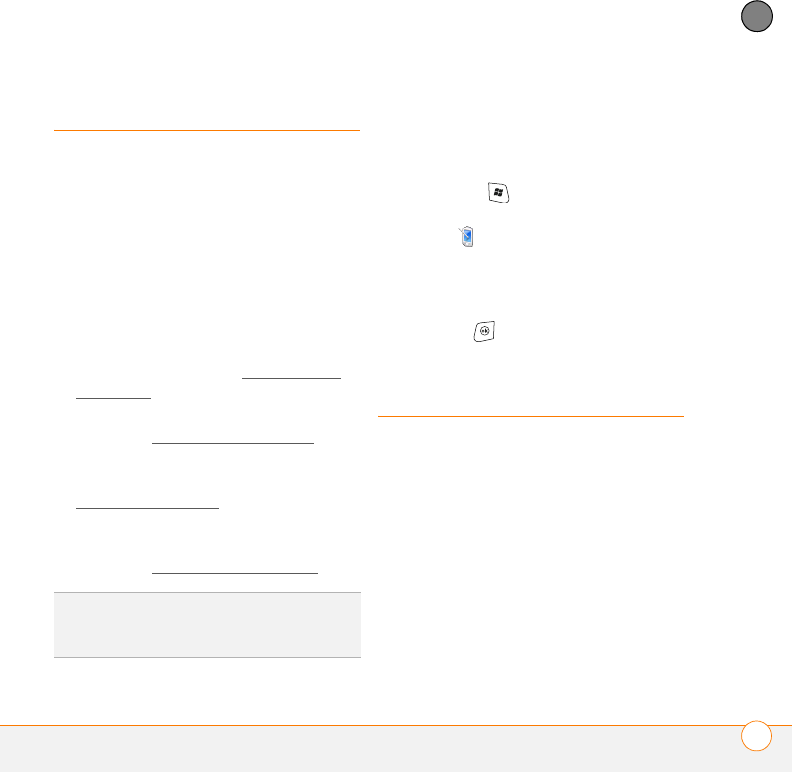
TROUBLESHOOTING
SCREEN 267
14
CHAPTER
Screen
The screen appears blank
1If you’re on a call, when the time period
specified in Backlight Settings expires,
the screen dims; one minute later, the
screen automatically turns off.
Press any key except Power/End to
wake up the screen. Pressing Power/
End hangs up the call.
2Look closely at the screen. If you can
see a dim image, try adjusting the
screen brightness (see Adjusting the
brightness).
3If that doesn’t work, perform a soft
reset (see Performing a soft reset).
4If that doesn’t work, connect your
smartphone to the AC charger (see
Charging the battery) and perform a soft
reset again.
5If that doesn’t work, perform a hard
reset (see Performing a hard reset).
The screen doesn’t respond accurately to
taps or activates wrong features
1Make sure there is no debris trapped
under the edges of the screen.
2Press Start and select Settings.
3Select the System tab, and then select
Screen .
4On the General tab, select Align
Screen.
5Tap the screen where indicated.
6Press OK .
Network connection
Signal strength is weak
1If you’re standing, move about 3 meters
(10 feet) in any direction.
2If you’re in a building, move near a
window. Open any metal blinds.
3If you’re in a building, move outdoors or
to a more open area.
4If you’re outdoors, move away from
large buildings, trees, or electrical wires.
TIP
If you are using a third-party application,
make sure that the application supports
240x240 screen resolution.

TROUBLESHOOTING
NETWORK CONNECTION
268
14
CHAPTER
5If you’re in a vehicle, move your
smartphone so that it’s level
with a window.
My smartphone won’t connect to the
mobile network
1Try the suggestions above for weak
signals.
2Turn off your phone and turn it on again
(see Turning your Palm® Treo™800W
smartphone on/off).
3Perform a soft reset (see Performing a
soft reset).
My phone seems to turn off by itself
If a system error and reset occur, the
phone automatically turns on if it was on
before the reset. However, if your
smartphone can’t determine if your phone
was on before the reset, it does not
automatically turn on the phone (see
Turning your phone on).
I can’t tell if data services are available
The following icons appear in the title bar
to indicate whether data services are
available:
TIP
Become familiar with low coverage areas
where you live, commute, work, and play so
you know when to expect signal strength
issues.
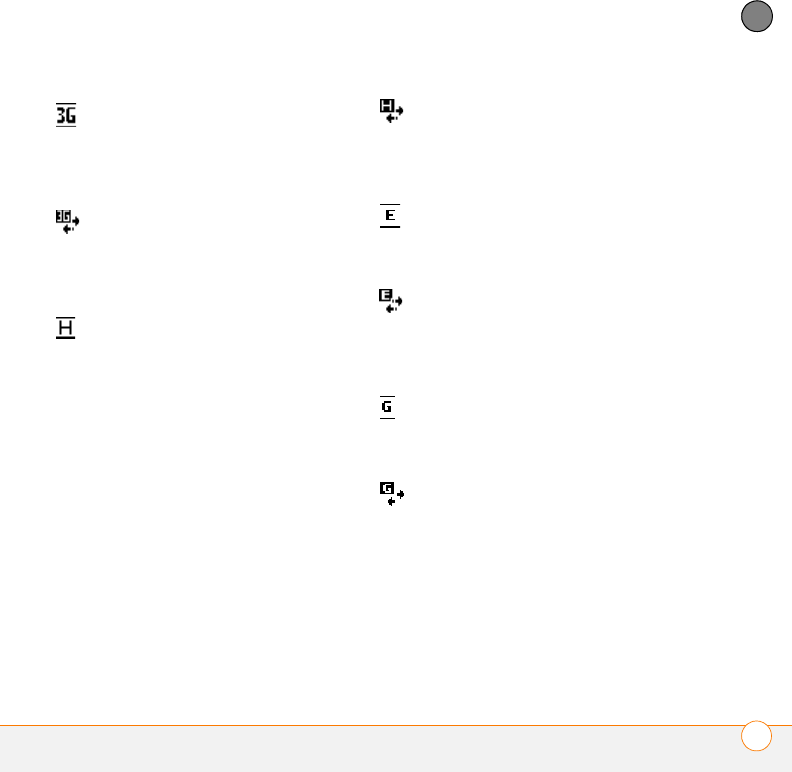
TROUBLESHOOTING
NETWORK CONNECTION 269
14
CHAPTER
Your phone is connected to a
CDMA2000 (3G or HSDPA)
network, but you are not actively
transmitting data. You can still
make or receive calls.
Your phone is on and a 3G
CDMA2000 data connection is
active. You can make and receive
calls and transmit data
simultaneously.
Your phone is connected to a
HSDPA CDMA2000 network, but
you are not actively transmitting
data. You can still make or
receive calls.
NOTE In most cases, when your
phone is connected to a
CDMA2000 network (either 3G
or HSDPA) but you are not
actively transmitting data, the 3G
icon appears. The H icon may
appear when your phone is
connected to a HSDPA
CDMA2000 network, but you are
not actively transmitting data
Your phone is on and an HSDPA
CDMA2000 data connection is
active. You can make and receive
calls and transmit data
simultaneously.
Your phone is connected to an
EDGE network, but you are not
actively transmitting data. You
can still make or receive calls.
Your phone is on and an EDGE if
data connection is active. You
can still make or receive calls,
but the data transmission is
automatically interrupted.
Your phone is connected to a
GPRS network, but you are not
actively transmitting data. You
can still make or receive calls.
Your phone is on and a GPRS
data connection is active. You
can still make or receive calls,
but the data transmission is
automatically interrupted.

TROUBLESHOOTING
NETWORK CONNECTION
270
14
CHAPTER
My smartphone won’t connect to the
Internet
Your smartphone supports GPRS or
CDMA2000 (3G or HSDPA) wireless data
networks. To connect to the Internet, you
must subscribe to data services with your
wireless service provider.
•Contact your wireless service provider
to verify that your subscription plan
includes data services and that these
services have been correctly activated.
Your wireless service provider should
also be able to tell you if there are any
outages in your location.
•Press and hold Power/End to turn
off your phone, then press and hold the
same button to turn it back on.
•Perform a soft reset (see Performing a
soft reset).
•Confirm that data services are correctly
configured on your smartphone by
doing the following:
1Press Start and select Settings.
2Select the Connections tab, and then
select Connections .
3On the Tasks tab, select Manage
existing connections.
4If your wireless service provider’s name
appears in the list, press OK . If not,
contact your wireless service provider
for assistance.
I can’t send or receive text or multimedia
messages
•Make sure your phone is on and that
you’re inside a coverage area (see
Turning your phone on).
•Contact your wireless service provider
to verify that your plan includes
messaging services, that these services
have been correctly activated, and that
they are available at your location. Your
wireless service provider should be able
to tell you if messaging services have
been experiencing transmission delays.
•If possible, contact the recipient or
sender of the message, and make sure
the receiving device can handle the type
of message you’re sending.
•If a text message arrives but does not
display a notification, perform a soft
reset (see Performing a soft reset).

TROUBLESHOOTING
NETWORK CONNECTION 271
14
CHAPTER
I can’t make or receive calls using a
hands-free device with Bluetooth®
wireless technology
Verify all of the following:
•The Turn on Bluetooth box is checked
in Bluetooth Settings.
•Your Bluetooth device is charged and
turned on.
•Your smartphone is within range of the
hands-free device. Bluetooth range is
up to 10 meters (30 feet) in optimum
environmental conditions, which include
the absence of the following: obstacles,
radio interference from nearby
electronic equipment, and other factors.
•The Bluetooth Settings screen is closed.
•You are away from other devices using
the 2.4 GHz radio frequency, such as
cordless phones, microwaves, and
Wi-Fi equipment. If this is impossible,
move the phone closer to the
hands-free device.
•The device specifications are
compatible with your smartphone.
I lost the connection between my
smartphone and my Bluetooth headset
1Press Start and select Settings.
2Select the Connections tab, and then
select Bluetooth.
3Select the Devices tab.
4Select your headset name from the list.
5In Partnership Settings, make sure the
Hands Free option box is checked.
6Select Save.
7Highlight the headset name.
8Press and hold Center to open the
shortcut menu, and then select Set as
Hands-Free.
9Test your headset by making or
receiving a call.
If the headset still doesn’t work, delete the
existing partnership and create a new one.
To delete the partnership:
1Press Start and select Settings.
2Select the Connections tab, and then
select Bluetooth.
3Highlight the headset device name.
4Press and hold Center to open the
shortcut menu, and then select Delete.
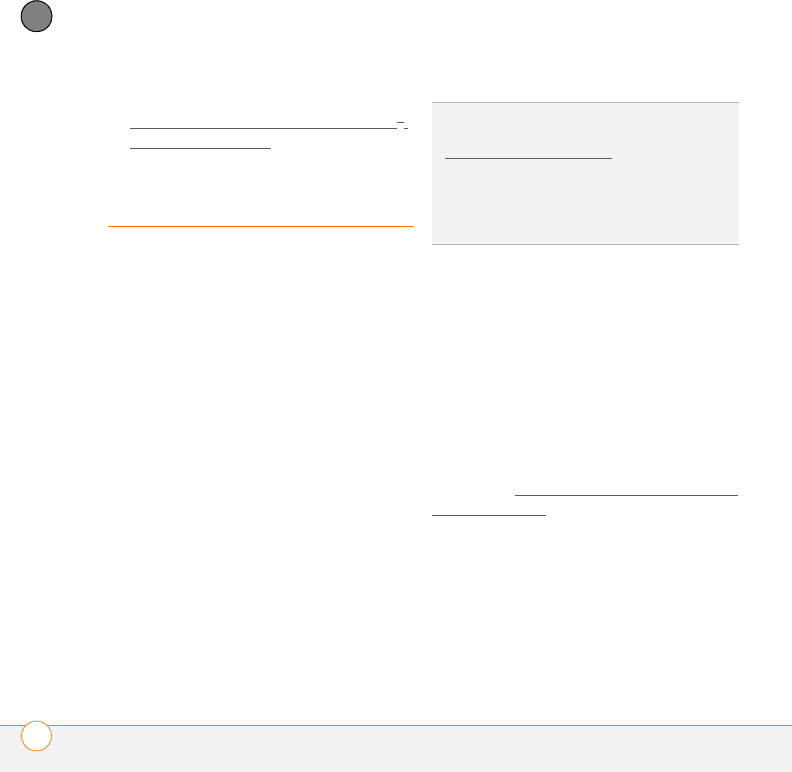
TROUBLESHOOTING
SYNCHRONIZATION
272
14
CHAPTER
5Create a new partnership (see
Connecting to devices with Bluetooth®
wireless technology.
Synchronization
Synchronization enables you to back up the
information on your smartphone onto your
computer or your server. If you ever need
to perform a hard reset or otherwise erase
all your information on your smartphone,
you can synchronize your smartphone with
your computer to restore the info. To make
sure you always have an up-to-date backup
of your info, synchronize frequently.
You can synchronize email and other
information directly with Microsoft
Exchange Server 2003 with Service Pack 2
or Exchange Server 2007 using Microsoft
Exchange ActiveSync®, or you can
synchronize your smartphone with your
computer, using the desktop sync software
from the Windows Mobile Getting Started
CD that came with your smartphone.
Desktop sync software
This section covers issues with
synchronizing using the desktop sync
software that came with your smartphone.
If you have a Windows XP computer, the
desktop sync software is called
ActiveSync® desktop software. If you have
a Windows Vista computer, the desktop
sync software is called Windows Mobile
Device Center.
NOTE See Exchange ActiveSync (wireless
synchronization) for help with direct
wireless synchronization with an Exchange
server.
The desktop sync software does not
respond to sync attempt
As you complete the following steps,
synchronize after each step. If the
DID
YOU
KNOW
?
You can go to the Windows
Mobile website for more information at
www.windowsmobile.com.
DID
YOU
KNOW
?
A common cause of sync
problems is the presence of protective
software, such as VPNs or firewalls, on your
computer or network.
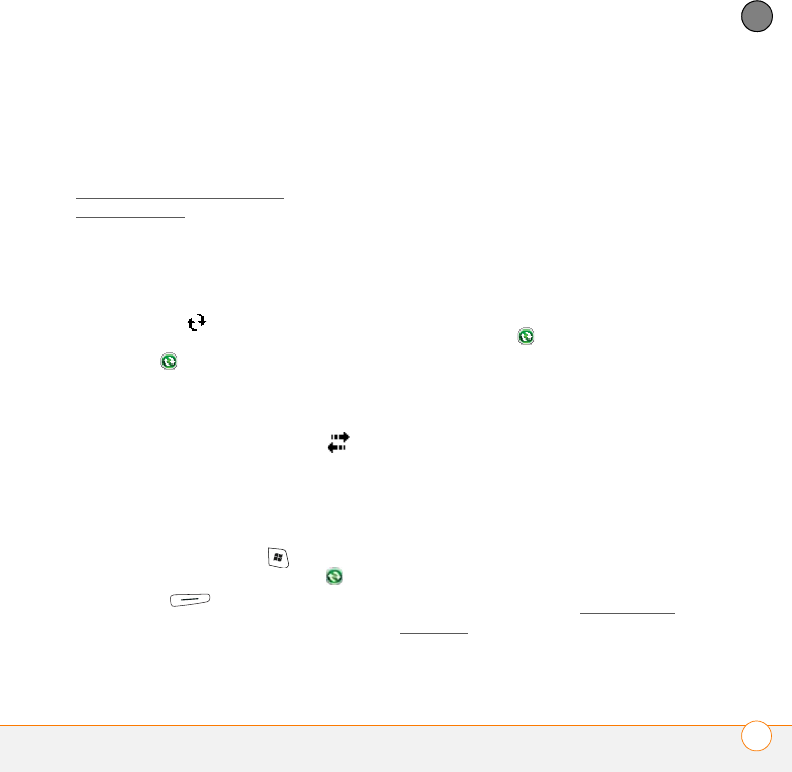
TROUBLESHOOTING
SYNCHRONIZATION 273
14
CHAPTER
synchronization is successful, you do not
need to complete the remaining steps.
1Verify that the USB sync cable is
securely connected at all points (see
Setting up your computer for
synchronization).
2Make sure that all of the files you’re
trying to sync are closed on both your
computer and your smartphone.
3On a Windows XP computer, look for
the ActiveSync icon at the top of
your smartphone screen and the
ActiveSync icon in the taskbar on
your computer to make sure ActiveSync
desktop software is running on your
computer. On a Windows Vista
computer, look for the connection
icon at the top of your smartphone
screen.
If the correct icons are not displayed, do
the following:
Smartphone: Press Start , select
Programs. and select ActiveSync .
Press Menu (right action key)
and select Connections. Make sure the
Synchronize all PCs using this
connection box is checked, and that
USB is selected from the list.
Windows XP computer: Click Start,
navigate to Programs, and then select
Microsoft ActiveSync.
Windows Vista computer: Click Start,
select All Programs, and then select
Windows Mobile Device Center.
4Do one of the following:
5 Windows XP computer: Double-click
the ActiveSync icon in your taskbar.
From the File menu, select Connection
Settings. Make sure the Allow USB
connections box is checked, and then
click Connect.
6 Windows Vista computer: Click Start,
select All Programs, and then select
Windows Mobile Device Center.
Select Connect without setting up
your device, and then select
Connection settings. Make sure the
Allow USB connections box is
checked, and click Connect.
7Perform a soft reset (see Performing a
soft reset).

TROUBLESHOOTING
SYNCHRONIZATION
274
14
CHAPTER
8Restart your computer and make sure
the desktop sync software is running.
9If problems persist and you’re
synchronizing through a USB hub, try
connecting the sync cable to a different
USB port or directly to your computer’s
built-in USB port.
10 If you’re already synchronizing through a
built-in USB port on the front of your
computer, move the sync cable to a
USB on the back of your computer if
your computer has USB ports in both
places.
11 Uninstall the desktop software that
came with your smartphone, and then
insert the Windows Mobile Getting
Started CD, which came with your
smartphone, and repeat the installation
process (see Reinstalling the desktop
software).
12 For a Windows XP computer only,
delete the existing partnership between
your smartphone and your computer
and create a new one by doing the
following steps in turn:
•Disconnect your smartphone and your
computer from the sync cable.
•Right-click the gray ActiveSync
icon in the taskbar in the lower-right
corner of your computer screen, and
then select Open Microsoft
ActiveSync.
•Click File, and then click Delete
Mobile Device. When asked to
confirm, click Ye s .
•Connect your smartphone and your
computer to the sync cable.
•When the Synchronization Setup
Wizard appears, follow the steps to
establish a sync relationship between
your smartphone and your computer.
13 If your organization uses a firewall or a
VPN connection, synchronizing with
ActiveSync may not work. For a
Windows XP computer only, go to
www.microsoft.com and search for the
following topics to help with specific
firewall setup situations:
•ActiveSync USB Connection
Troubleshooting Guide
•ActiveSync with Sygate Personal
Firewall
•ActiveSync with TrendMicro PC-cillin
Internet Security

TROUBLESHOOTING
SYNCHRONIZATION 275
14
CHAPTER
•ActiveSync with Norton Personal
Firewall
•ActiveSync with Zone Alarm Security
Suite
•ActiveSync with McAfee Personal
Firewall
•ActiveSync with Windows Firewall
14 Verify with your computer hardware
vendor that your operating system
supports your internal USB controller.
Synchronization finishes but info doesn’t
appear where it should
•With the included desktop sync
software, your smartphone can
synchronize with the root folders of
Microsoft Office Outlook Contacts,
Calendar, Tasks, and Notes (Outlook
sold separately; a free trial version is
available for download from the
Windows Mobile Getting Started CD). If
you want to synchronize with a global
Exchange Address Book, you must copy
the addresses to your local Contacts list
in Microsoft Office Outlook (right-click
the addresses and select Add to
Personal Address Book).
•Microsoft Office Outlook subfolders and
public folders are not accessible with
the included software. You may want to
use a third-party solution instead.
•If you’re trying to sync offline, be sure
to set your Microsoft Office Outlook
Calendar, Contacts, Notes, and Tasks to
be available offline.
•If you’re still having problems, try the
following:
1Make sure you’re synchronizing with
the intended desktop personal
information manager (PIM). The
Windows Mobile Getting Started CD
lets you synchronize with Microsoft
Office Outlook for Windows. If you use
a different PIM, you need to install
third-party software to synchronize. For
more information, consult the company
that makes the PIM.
2Open the desktop sync software on
your computer, and make sure the Files
synchronization option is selected (see
Changing which applications sync).
3Uninstall the desktop sync software,
reboot your computer, insert the
Windows Mobile Getting Started CD,
which came with your smartphone, and

TROUBLESHOOTING
SYNCHRONIZATION
276
14
CHAPTER
then repeat the installation process (see
Reinstalling the desktop software).
Synchronization starts but doesn’t finish
Make sure that you installed the desktop
software that came with your smartphone.
If you’re not sure whether this software is
installed, reinstall it (see Reinstalling the
desktop software).
My video and music files won’t sync
1Make sure you have Windows Media
Player 10 or later installed on your
computer.
2Reinstall the desktop sync software
from the Windows Mobile Getting
Started CD, which came with your
smartphone (see Reinstalling the
desktop software). Media file
synchronization fails if you installed the
desktop sync software before you
installed Windows Media Player.
My appointments show up in the wrong
time slot after I sync
1Make sure that you installed the
desktop sync software that came with
your smartphone. If you’re not sure
whether this software is installed,
reinstall it (see Reinstalling the desktop
software).
2Open Microsoft Office Outlook and
correct the wrong entries.
3Manually enter any information you
added to your smartphone since the last
time you synchronized.
4Synchronize your phone and your
computer.
My scheduled sync doesn’t work
By default, a scheduled sync does not work
while you are roaming. This is to prevent
roaming charges on your account. If
roaming charges are not a concern, follow
these steps to continue your sync schedule
while roaming:
1Press Start and select Programs.
2Select ActiveSync .
3Press Menu (right action key)
and select Schedule.
4Check the Use above setting when
roaming box.
5Press OK .

TROUBLESHOOTING
SYNCHRONIZATION 277
14
CHAPTER
An alert tells me that ActiveSync
encountered a problem on the server
There is a temporary problem with the
server or the server may be temporarily
overloaded. Try again later, and if the
problem persists, contact your system
administrator.
An alert tells me that there is not enough
free memory to sync my info
The ActiveSync application on your
smartphone ran out of storage space. Try
the following:
1Go to Memory Settings and close all
running programs (see Closing
applications).
2If the problem persists, see Making
room on your smartphone for
suggestions on other ways to free up
space on your smartphone.
An alert tells me that ActiveSync
encountered a problem with [item type]
[item name]
An error occurred during the sync of a
single item. This error can usually be
corrected only by removing the item that
caused the error. If you sync again to see if
the error persists, be aware that items
causing this type of error are skipped and
do not show up again.
My Today screen settings are not restored
after a hard reset
Settings such as the background image and
plug-in choices are not backed up during
synchronization, so they can’t be restored
after a hard reset. If you use a backup
utility, you may be able to restore a backup
to recover your Today screen setting and
other additional info.
Exchange ActiveSync (wireless
synchronization)
This section covers issues with direct
wireless synchronization with an Exchange
server. See Desktop sync software for help
with synchronizing using your desktop sync
software.
TIP
If you are synchronizing with an Exchange
server and you’re unable to change your lock
settings, check with your system
administrator to find out if a systemwide
locking policy is in place.

TROUBLESHOOTING
EMAIL
278
14
CHAPTER
An alert tells me that the server could not
be reached
Your smartphone had to wait too long to
connect to the Exchange server. The
connection may have been lost, the server
may be temporarily overloaded, or the
server may have encountered an internal
error. Check your Exchange server name
and proxy server settings (see Setting up
wireless synchronization), and try
again later.
An alert tells me that my account
information could not be detected
When you set up the Exchange server sync
options, the credentials page was left
blank. Correct the credentials (see Setting
up wireless synchronization), or set up your
smartphone to sync only with a computer,
and try to sync again.
An alert tells me the device timed out
while waiting for credentials
The Exchange server credentials screen
was left open too long. Re-enter the
Exchange server credentials, and try to
sync again.
Email
I have problems using my account
Occasionally you may experience problems
using an email account after you set it up. If
you followed the account setup procedure
and are experiencing problems in using the
account, verify that the account complies
with your email provider’s requirements by
following these steps:
•Verify both your password and your
username for your email account.
•Some email service providers require
you to be on their network to use your
email account. If this is the case, be
sure to use your provider’s network as
the connection type for the account.
•Some email service providers have
other requirements specific to their
service. For example, Yahoo! requires
you to set up POP mail forwarding for
your Yahoo! account to download email
messages to your smartphone. Check
with your service provider to see if any
provider-specific requirements exist.

TROUBLESHOOTING
EMAIL 279
14
CHAPTER
•Service provider settings frequently
change. If your email account was
working but you are currently
experiencing problems, check with your
service provider to see if any of the
account settings have changed.
I have problems sending and receiving
email
Short periods of time when email is
unavailable are common due to server
problems or poor wireless coverage. If you
have problems sending or receiving mail
for an extended period of time, check with
your ISP or email service provider to verify
that the service is working properly.
Scheduled email synchronization is not
working
If email synchronization is occurring and
you turn your smartphone off or the
connection to your email service provider is
disconnected, the synchronization fails.
•Check the synchronization schedule to
make sure that email sync is set to
occur at the expected day and time. See
Setting the synchronization schedule for
details.
•Press Start , select Programs, and
then select ActiveSync . Press
Menu (right action key) and
select Configure Server. Make sure the
verify password setting is on. This is
required for over-the-air synchronization.
I have problems sending email
If you are able to receive email messages
but cannot send them, try the following
steps, in turn:
•Make sure your ISP or email provider
allows you to access email on a
smartphone. Some providers do not
offer this option at all; other providers
require an upgrade for accessing email
on a smartphone.
•Press Start , select Programs, and
then select ActiveSync . Press
Menu (right action key) and
select Configure Server. Make sure the
SSL box is checked.
•Enter the name of a different outgoing
mail server for sending mail. Many ISPs,
such as cable companies, require that
you have an Internet connection to their
network to send email through their
servers. In this case, you can almost
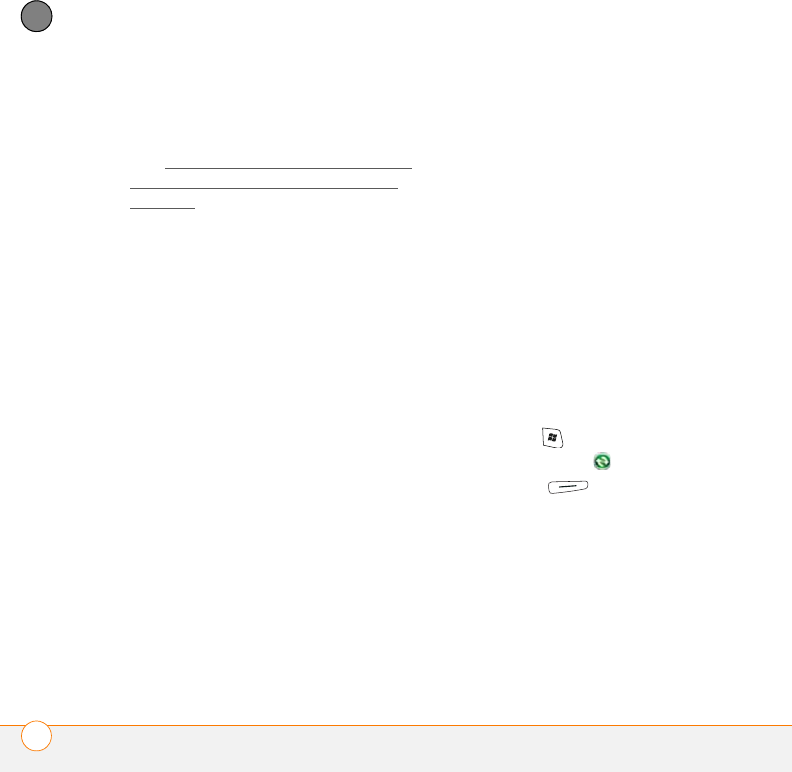
TROUBLESHOOTING
EMAIL
280
14
CHAPTER
always receive email from these
accounts, but if you want to send email,
you must send it through another server
(see Setting up a POP/IMAP account in
the Inbox application: Common email
providers).
My vCard or vCal email attachment isn’t
forwarding correctly
Microsoft Office Outlook provides several
features including vCard and vCal that work
with email client software on a Windows
computer. For these features to work
correctly, the email client software must be
properly set up. Follow these steps to
check the settings:
1Click Start on your computer, and then
select Settings.
2Select Control Panel.
3Select Internet Options, and then click
the Programs tab.
4Make sure that the email field is set to
the correct email client software.
5Click OK.
6Start the email client software and
make sure it is configured as the default
MAPI client. Consult the documentation
for your desktop email application for
more information.
When I sync with my Exchange server my
info is not downloading to my
smartphone
Check with your system administrator to
obtain the name of the mail server that
offers you wireless access to the corporate
mail system. If you cannot obtain the name
of this server (some companies do not give
it out, because they do not want wireless
access to their servers), you cannot use
Exchange ActiveSync to synchronize with
the Exchange server. You can also check
the following setting:
1Press Start and select Programs.
2Select ActiveSync .
3Press Menu (right action key)
and select Configure Server.
4Make sure the SSL box is checked.

TROUBLESHOOTING
WEB 281
14
CHAPTER
Web
I can’t access a web page
First, make sure you have Internet access:
Open Internet Explorer Mobile and try to
view a web page you’ve loaded before. To
ensure that you’re viewing the page
directly from the Internet, press Menu
(right action key) and select Refresh.
After confirming your Internet connection,
try to view the page in question again. If it
comes up blank, press Menu (right
action key) and select Refresh.
If you’re still having trouble, the page may
contain elements that are not supported by
Internet Explorer Mobile, such as Flash,
Shockwave, VBScript, WML script, and
other plug-ins.
Some websites use a redirector to their
true home page. For example, if you enter
the address http://www.palm.com/support,
it may resolve to http://www.palm.com/us/
support. If Internet Explorer Mobile can’t
follow the redirect, try using a desktop
browser to see the landing page of the
redirector, and enter that address in
Internet Explorer Mobile.
An image or map is too small on my
smartphone screen
Internet Explorer Mobile has several
viewing modes: One Column, Default,
Desktop, and Full Screen. Switch to
Desktop to see the full-size image (see
Viewing a web page).
A secure site refuses to permit a
transaction
Some websites don’t support certain
browsers for transactions. Please contact
the site’s webmaster to make sure the site
allows transactions using Internet Explorer
Mobile.
TIP
Your smartphone can open your email
application when you select an email address
on a web page. If nothing happens when you
select the link, try setting up your email
application first.

TROUBLESHOOTING
CAMERA
282
14
CHAPTER
Camera
Here are some tips for taking good pictures
with the built-in camera:
•Clean the camera’s lens with a soft,
lint-free cloth.
•Take pictures in bright lighting
conditions. Low-light images may be
grainy, due to the sensitivity of the
camera.
•Hold the camera as still as possible. Try
supporting your picture-taking arm
against your body or a stationary object
(such as a wall).
•Keep the subject of the pictures still.
Exposure time is longer with lower light
levels, so you may see a blur.
•For best results, verify that you have the
brightest light source coming from
behind you, lighting the subject’s face.
Avoid taking indoor pictures with the
subject in front of a window or light.
•Make sure the subject is at least 0.5
meters (18 inches) away from the
camera to ensure good focus.
Remember that when you synchronize,
your Camera images are stored in the
C:\Documents and
Settings\<Username>\My Documents\Treo
My Documents folder on your hard drive
(see Camera).
The Camera preview image looks strange
Some third-party applications overwrite the
color settings on your smartphone with
their own 8-bit color settings. This can
affect the Camera Preview Mode. Delete
third-party applications one by one until the
preview image improves (see Removing
applications).
DID
YOU
KNOW
?
Pictures are 16-bit color.
Resolution settings range from the low end of
VGA (160 x 120 pixels) to a high end of 1.3
megapixels (1280 x 1024). Video resolution
settings range from a low end of 176 x 144
pixels to a high end of 352 x 288 pixels. You
can change the resolution setting by pressing
Menu (right action key) and selecting
Resolution (still images) or Quality (video).

TROUBLESHOOTING
THIRD-PARTY APPLICATIONS 283
14
CHAPTER
Third-party
applications
Sometimes third-party applications can
cause conflicts on your smartphone.
Third-party applications that modify
wireless features may affect the
performance of your smartphone and may
require extra troubleshooting. Use caution
when installing the following types of
applications:
•Ringtone managers
•Caller ID applications
•Instant messaging
•Applications that modify when your
phone or data connections turn on or off
and how your phone behaves
If you recently installed an application and
your smartphone seems to be stuck, try
the following:
1Perform a soft reset (see Performing a
soft reset).
2Make sure the third-party application is
compatible with the Windows Mobile 6
Professional operating system on your
smartphone.
3Delete the most recently installed
application from your smartphone (see
Removing applications).
4If the problem persists, perform another
soft reset.
5If possible, synchronize or use a backup
utility to back up your most recent info.
6Perform a hard reset (see Performing a
hard reset).
7Synchronize or restore your backup to
restore the info in your built-in
applications.
8If the problem is resolved, begin
reinstalling your third-party applications
one at a time.
9If the problem recurs, delete the last
application you installed and report the
problem to its developer.
Getting more help
Contact the vendor of any third-party
software if you require further assistance.

TROUBLESHOOTING
MAKING ROOM ON YOUR SMARTPHONE
284
14
CHAPTER
Making room on your
smartphone
If you store a large amount of information,
or install many third-party applications, the
internal memory on your smartphone may
fill up. Here are some common ways to
clear space on your smartphone:
•Camera: Large images or videos take
up a lot of memory. Move images to an
expansion card or delete images from
your smartphone (see Pictures &
Videos).
•Messaging: Multimedia content and
email attachments can consume
excessive memory. Move multimedia
content and attachments to an
expansion card, or delete large files
from your smartphone (see Deleting
messages and Deleting a single
message). You may also want to empty
the deleted items folder.
•Internet: If you save links to pages
you’ve visited in Internet Explorer
Mobile, you may want to clear all recent
pages (see Customizing your Internet
Explorer Mobile settings).
•Third-party applications: You can
delete infrequently used applications or
move them to an expansion card (see
Copying or moving applications and files
between your smartphone and an
expansion card).
Also, remember that your smartphone
includes an expansion card slot, and that
you can store applications and information
on expansion cards. However, you still
need free memory on the smartphone
itself to run applications from an expansion
card.
TIP
Remember that not all third-party
applications were written with the Treo 800W
smartphone keyboard and 5-way navigator in
mind. You may encounter strange behavior or
errors in these applications if you use the
keyboard and the 5-way navigator.

TROUBLESHOOTING
VOICE QUALITY 285
14
CHAPTER
Voice quality
Is the other person hearing an echo?
•Try decreasing the volume on your
smartphone to avoid coupling
or feedback on the other person’s end.
This applies to both the speakerphone
and to the handset earpiece.
•Position the smartphone closer to your
ear to prevent sound leaking back to the
microphone. Keep your hand away from
the microphone hole, which is on the
lower-right side of your smartphone.
•If you’re using Speakerphone mode
with your smartphone lying on a flat
surface, try turning the smartphone
“face down” (screen facing the
surface).
Are you hearing your own voice echo?
Ask the other person to turn down their
volume or to hold the phone closer to
their ear.
Is your voice too quiet on the other end?
Be sure to hold the bottom of the
smartphone, or the hands-free
microphone, close to your mouth.
Check the signal strength indicator. If the
signal is weak, try to find an area with
better coverage.

TROUBLESHOOTING
VOICE QUALITY
286
14
CHAPTER

WHERE TO LEARN MORE 287
Where to learn more
For a quick introduction
•Quick Tour: The Quick Tour introduces
you to many of your Palm® Treo™800W
smartphone’s features. It is already
installed on your smartphone, and you
can open it any time. Press Start ,
select Programs, and then select Quick
Tour .
While using your smartphone
•On-device Help: Your smartphone
includes on-device help that is specially
formatted for your smartphone screen.
To view the on-device help, press Start
and select Help.
•Online support from Palm: For
up-to-date downloads, troubleshooting,
and support information, go to
www.palm.com/treo800W-support.
If you need more information
•Books: Many books on Windows
Mobile® devices are available in local or
online book retailers (look in the
computers section).
•Customer service from your wireless
service provider: For questions about
your mobile account or features, contact
your wireless service provider’s
customer care.

WHERE TO LEARN MORE
288

TERMS 289
Terms
ActiveSync®
The software on your smartphone that
exchanges and updates the information
on your Palm® Treo™800W smartphone with
the information on your computer.
ActiveSync desktop software
The software on your Windows XP
computer that exchanges and updates the
information on your computer with the
information on your smartphone. To open
ActiveSync on your computer, double-click
the ActiveSync icon in the taskbar in the
lower-right corner of your screen. If the
icon does not appear, click Start, click All
Programs (or navigate to the Programs
group), and then select Microsoft
ActiveSync. See Installing ActiveSync
desktop software: Windows XP.
Alt (alternative)
The key that you use to enter accented
characters and symbols that do not appear
on your keyboard. Press Alt , and then
press a key on the keyboard to view the
alternative characters available for that key.
See Entering other symbols and accented
characters.
auto-off interval
The time of inactivity that passes before
the screen on your smartphone turns off.
The wireless features on your smartphone
are unaffected by this setting. See
Optimizing power settings.
beam
The process of sending or receiving an
entry or application using the infrared port
on your smartphone or using Bluetooth®
wireless technology. See Beaming
information.
Bluetooth® wireless technology
Technology that enables devices such as
smartphones, mobile phones, and
computers to connect wirelessly to each
other so that they can exchange
information over short distances. For more
info, visit www.bluetooth.com. See
Connecting to devices with Bluetooth®
wireless technology.
desktop software
A Personal Information Manager (PIM)
application for computers, such as

TERMS
290
Microsoft Outlook®, that helps you manage
your personal information and keep it
synchronized with your smartphone. See
Installing ActiveSync desktop software:
Windows XP.
dialog box
A set of options and command buttons that
is enclosed by a border and that enables
you to carry out a specific task.
EDGE (Enhanced Data rates for GSM
Evolution)
An enhanced version of GPRS that delivers
data speeds that are up to 3 times faster
than standard GPRS connections, with
rates up to 236.8 Kbps. (Additional charges
may apply.) See What are all those icons?
GPRS (General Packet Radio Service)
A mobile Internet connectivity technology
that allows persistent data connections.
(Additional charges may apply.) See What
are all those icons?
HSDPA (High-Speed Download Packet
Access)
An evolutionary enhancement to
CDMA2000 packet data. HSDPA uses
different modulation and coding techniques
to improve downlink performance. Your
smartphone supports data rates up to
700Kbps.
infrared (IR)
A way of transmitting information using
light waves. You use the IR port on
your smartphone to transfer information
between other IR devices within a
short radius. See Beaming information.
Lithium-ion (Li-ion)
The rechargeable battery technology used
in your smartphone. See Charging the
battery.
Microsoft Exchange ActiveSync®
Technology that allows your smartphone to
synchronize email, contacts, calendar
events, and tasks wirelessly with Microsoft
Exchange Server 2003 or 2007. See Setting
up wireless synchronization.
MMS (Multimedia Messaging System)
An enhanced messaging system that
enables you to send pictures, animations,
and ringtones almost instantly. See
Creating and sending a multimedia
message.

TERMS 291
Mobile Device
The component on your Windows XP
computer that enables you to install
applications and other information on your
smartphone. To access it, open Windows
Explorer or My Computer and look for the
icon that represents your smartphone. See
Installing applications from your computer.
Option
Press this key and then a second key to
enter the character or to access the feature
displayed above the letter on the second
key. See Entering numbers, punctuation,
and symbols.
partnership
The connection that you make between
two devices by means of Bluetooth
wireless technology. The devices recognize
each other because each device finds the
same passkey on the other device. After
you create a partnership between the
devices, you no longer need to enter the
passkey. Partnership is also known as
paired relationship, pairing, trusted device,
and trusted pair on some devices. See
Connecting to devices with Bluetooth®
wireless technology.
Phone Off
Appearing on the Today screen, this
indicates that your smartphone is not
connected to any network, and you cannot
make calls except those to emergency
numbers. You can still use the organizer
features, however. To turn the phone on/
off, go to the Wireless Manager. See
Turning your phone on.
Phone/Send
The button on your smartphone that
provides quick access to your Today screen
and dials after you’ve entered a phone
number. See Making calls from the Today
screen.
piconet
An ad-hoc network of devices that uses
Bluetooth wireless technology to connect
one master device with up to seven active
slave devices. The network can include up
to 255 inactive, or parked, slave devices
which the master device can bring into
active status at any time.

TERMS
292
PIM (personal information manager)
A genre of software that includes
applications such as Microsoft Outlook,
Palm® Desktop software, Lotus Notes, and
ACT!. PIMs generally store contacts,
schedules, tasks, and memos.
PIN (personal identification number)
The password assigned to your SIM card
by your wireless service provider. Turning
on the PIN lock secures your wireless
account. See also PUK. See Locking the
SIM card.
PIN2 (personal identification number 2)
A code that protects certain network
settings such as fixed dialing.
PUK (PIN unlock key)
A special extended password assigned to
your SIM card. If you enter the wrong PIN
more than the allowed number of times,
your SIM is blocked and you must call your
wireless service provider for the PUK. See
Locking the SIM card.
Secure Sockets Layer (SSL)
A security protocol that enables you to
send personal information in a more secure
manner over the Internet.
SIM (Subscriber Identity Module) card
The smartcard, inserted into your
smartphone, that contains your mobile
account information, such as your phone
number and the services to which you
subscribe. You can also store addresses,
phone numbers, and SMS messages on
the SIM card. See Inserting the SIM card
and battery.
SMS (Short Messaging Service)
The service that exchanges short text
messages almost instantly between
mobile devices. Your smartphone can send
and receive text messages while you are
on a call. See Creating and sending a text
message.
Start
The menu on your smartphone from which
you can open all applications. See Opening
applications.
streaming
Technology that enables you to access
media content—for example, watch video
or listen to an audio program—directly
from the Internet on your smartphone
without needing to download and a save a

TERMS 293
file on your smartphone. See Viewing a
video.
synchronization
The process in which information that is
entered or updated on your smartphone,
your computer, or a server is automatically
updated in one of the other locations either
wirelessly or by means of a cable
connection. See Synchronizing information.
UMTS (Universal Mobile
Telecommunications System)
One of the third-generation (3G) mobile
phone technologies that is designed for
high-speed data transfer, with rates up to
384 Kbps, as well as voice and multimedia
services. It uses W-CDMA as the
underlying technology. See What are all
those icons?
username
The name associated with your
smartphone that distinguishes it from
other Windows Mobile® devices. If you
install ActiveSync® desktop software, you
are asked to give your smartphone a
username. If you only synchronize
wirelessly using Microsoft Exchange
ActiveSync, you do not need to give your
smartphone a username. See Installing
ActiveSync desktop software: Windows
XP.
Windows Mobile
The operating system of your Treo 800W
smartphone. Your smartphone uses
Windows Mobile® 6 Professional edition.
When installing third-party applications to
your smartphone, be sure to install only
apps that are written for Microsoft
Windows Mobile 6 Professional. Apps
designed for Microsoft Windows Mobile 6
Standard or any edition of Windows Mobile
5.0 software are not compatible with your
Treo 800W smartphone. See Installing
third-party applications.
Windows Mobile Device Center
The software on your Windows Vista
computer that enables you to synchronize
content and manage music, pictures, and
videos between your smartphone and your
computer. To open Windows Mobile
Device Center on your computer, click
Start, click All Programs, and select
Windows Mobile Device Center. See
Installing Windows Mobile Device Center:
Windows Vista.

TERMS
294

IMPORTANT SAFETY INFORMATION 295
Important Safety
Information
FCC Notice
This equipment has been tested and found to comply with the limits
for a Class B digital device, pursuant to part 15 of the FCC Rules.
These limits are designed to provide reasonable protection against
harmful interference in a residential installation. This equipment
generates, uses and can radiate radio frequency energy and, if not
installed and used in accordance with the instructions, may cause
harmful interference to radio communications. However, there is no
guarantee that interference will not occur in a particular installation. If
this equipment does cause harmful interference to radio or television
reception, which can be determined by turning the equipment off and
on, the user is encouraged to try to correct the interference by one or
more of the following measures:
• Reorient or relocate the receiving antenna.
• Increase the separation between the equipment and receiver.
• Connect the equipment into an outlet on a circuit different from
that to which the receiver is connected.
• Consult the dealer or an experienced radio/TV technician for help.
Changes or modifications not expressly approved by Palm could void
the user’s authority to operate this equipment.
The following statement is normally required to be on the FCCID
label. If the device is too small, the statement must be included in the
user manual.
This device complies with part 15 of the FCC rules. Operation is
subject to the following two conditions:
• This device may not cause harmful interference, and
• This device must accept any interferences received, including
interference that may cause undesired operation.
This guide contains important operational and safety
information to help you safely use your Palm® Treo ™800W. Failure
to read and follow the information provided in this guide may result in
serious bodily injury, death, or property damage.
General Precautions
There are several simple guidelines to operating your smartphone
properly and maintaining safe, satisfactory service.
• Speak directly into the microphone.
• Avoid exposing your smartphone and accessories to rain or liquid
spills. If your smartphone does get wet, immediately turn the
power off and remove the battery.
• Although your smartphone is quite sturdy, it is a complex piece of
equipment and can be broken. Avoid dropping, hitting, or bending
it, or sitting on it.
• Any changes or modifications to your smartphone not expressly
approved in this document could void your warranty for this
equipment and void your authority to operate this equipment.
Maintaining Safe Use of and Access to Your
Smartphone
Do Not Rely on Your Smartphone’s Phone for Emergency Calls
Wireless phones such as the one on your Treo 800W operate using
radio signals, which cannot guarantee connection in all conditions.
Therefore you should never rely solely upon any wireless phone for
essential communication (for example, medical emergencies).
Emergency calls may not be possible on all cellular networks or when
certain network services and/or phone features are in use. Check
with your local service provider for details.
Using Your Phone While Driving
Talking on your phone while driving (or operating the phone without a
hands-free device) is prohibited in some jurisdictions. Laws vary as to
specific restrictions. Remember that safety always comes first.

IMPORTANT SAFETY INFORMATION
296
Following Safety Guidelines
To operate your smartphone safely and efficiently, always follow any
special regulations in a given area. Turn your smartphone’s phone off
in areas where use is forbidden or when it may cause interference or
danger.
Using Your Smartphone’s Phone Near Other Electronic Devices
Most modern electronic equipment is shielded from radiofrequency
(RF) signals. However, RF signals from wireless phones may affect
inadequately shielded electronic equipment.
RF signals may affect improperly installed or inadequately shielded
electronic operating systems and/or entertainment systems in motor
vehicles. Check with the manufacturer or their representative to
determine if these systems are adequately shielded from external RF
signals. Also check with the manufacturer regarding any equipment
that has been added to your vehicle.
Consult the manufacturer of any personal medical devices, such as
pacemakers and hearing aids, to determine if they are adequately
shielded from external RF signals.
NOTE Always turn off the phone in health care facilities and request
permission before using the phone near medical equipment.
Turning Off Your Phone Before Flying
NOTE Turn off your phone before boarding any aircraft. To prevent
possible interference with aircraft systems, the U.S. Federal Aviation
Administration (FAA) regulations require you to have permission from
a crew member to use your phone while the plane is on the ground.
To prevent any risk of interference, FCC regulations prohibit using
your phone while the plane is in the air.
Turning Off Your Phone in Dangerous Areas
To avoid interfering with blasting operations, turn your phone off
when in a blasting area or in other areas with signs indicating
two-way radios should be turned off. Construction crews often use
remote-control RF devices to set off explosives.
Turn your phone off when you’re in any area that has a potentially
explosive atmosphere. Although it’s rare, your phone and accessories
could generate sparks. Sparks can cause an explosion or fire,
resulting in bodily injury or even death. These areas are often, but not
always, clearly marked. They include:
• Fueling areas such as gas stations.
• Below deck on boats.
• Fuel or chemical transfer or storage facilities.
• Areas where the air contains chemicals or particles such as grain,
dust, or metal powders.
• Any other area where you would normally be advised to turn off
your vehicle’s engine.
NOTE Never transport or store flammable gas, flammable liquid, or
explosives in the compartment of your vehicle that contains your
phone or accessories.
Restricting Children’s Access to Your Smartphone
Your Treo 800W is not a toy. Do not allow children to play with it as
they could hurt themselves and others, damage the smartphone and/
or its phone, or make calls that increase your monthly bill.
Using Your Phone With a Hearing Aid Device
Yo u r Pa l m ® Treo™ 800W smart device by Palm is compliant with the
FCC Hearing Aid Compatibility (HAC) requirements. For additional
HAC information, including the HAC rating of this product, please
refer to www.palm.com/CentroHAC.
Your smartphone has been tested for hearing aid device compatibility.
When some wireless phones are used near some hearing devices
(hearing aids and cochlear implants), users may detect a buzzing,
humming, or whining noise. Some hearing devices are more immune
than others to this interference noise, and phones also vary in the
amount of interference they generate.

IMPORTANT SAFETY INFORMATION 297
The wireless telephone industry has developed ratings for some of
their mobile phones, to assist hearing-device users in finding phones
that may be compatible with their hearing devices. Not all phones
have been rated. Phones that have been rated have a label on the
box. Your Palm Treo 800W phone has an M4 and T4 rating.
These ratings are not guarantees. Results will vary, depending on the
level of immunity of your hearing device and the degree of your
hearing loss. If your hearing device happens to be vulnerable to
interference, you may not be able to use a rated phone successfully.
Trying out the phone with your hearing device is the best way to
evaluate it for your personal needs.
M-Ratings: Phones rated M3 or M4 meet FCC requirements and are
likely to generate less interference with hearing devices than phones
that are not labeled. M4 is the better/higher of the two ratings.
T-Ratings: Phones rated T3 or T4 meet FCC requirements and are
likely to be more usable with a hearing device’s telecoil (“T Switch” or
“Telephone Switch”) than unrated phones. T4 is the better/higher of
the two ratings. (Note that not all hearing devices contain telecoils.)
The more immune your hearing aid device is, the less likely you are to
experience interference noise from your wireless phone. Hearing aid
devices should have ratings similar to those of phones. Ask your
hearing health-care professional for the rating of your hearing aid. Add
the rating of your hearing aid and your phone to determine probable
usability:
• Any combined rating equal to or greater than six offers best use.
• Any combined rating equal to five is considered normal use.
• Any combined rating equal to four is considered usable.
Thus, if you pair an M3 hearing aid with an M3 phone, you will have a
combined rating of six for “best use.” This is synonymous for T
ratings.
Palm further suggests that you experiment with multiple phones
(even those not labeled M3/T3 or M4/T4) while in the store to find the
one that works best with your hearing aid device. If you experience
interference or find the quality of service unsatisfactory after
purchasing your device, promptly return it to the store within 30 days
of purchase. With the Palm 30-day Risk-Free Guarantee, you may
return the device within 30 days of purchase for a full refund, and you
will only be responsible for charges based on your actual usage.
Getting the Best Hearing Device Experience With Your
Smartphone
To further minimize interference:
There is usually less interference on the microphone setting than on
the telecoil setting.
Set the phone’s screen and keyboard backlight settings to ensure the
minimum time interval.
Move the phone around to find the point with the least interference.
If your hearing aid is equipped with a telecoil, turn on the HAC setting
on your smartphone.
Turning on the HAC Setting
When the HAC setting is on, your smartphone sends the audio from
your phone calls to the telecoil rather than to the microphone of your
hearing aid. You are likely to hear calls much better because volume is
increased and background noise and feedback are diminished. The
HAC setting improves only the calls you listen to through the
earpiece. Turn off BT. Turn off WiFi. It does not affect calls heard on
the speakerphone or with a car kit or headset. HAC requires extra
battery power, so watch your battery consumption when it's turned
on.
CAUTION Do not turn on the HAC setting unless you use a hearing
aid with a telecoil. Using this setting without a hearing aid or with a
hearing aid without a telecoil may be harmful to your hearing.
1Make sure your phone is turned on (see “Turning Your Device’s
Phone On and Off” on page 55).
2Press Phone .
3Press Menu .
4Select Options and then select Phone Preferences.
5Check the Hearing Aid Compatibility box.
6Select OK.

IMPORTANT SAFETY INFORMATION
298
Caring for the Battery
Protecting Your Battery
NOTE The guidelines listed below help you get the most out of your
battery’s performance.
• Recently there have been some public reports of wireless phone
batteries overheating, catching fire, or exploding. It appears that
many, if not all, of these reports involve counterfeit or
inexpensive, aftermarket-brand batteries with unknown or
questionable manufacturing standards. Palm is not aware of
similar problems with Treo 800Ws resulting from the proper use
of batteries and accessories approved by Palm or the
manufacturer of your phone. Use only Palm or
manufacturer-approved batteries and accessories found at Palm
Stores or through your smartphone’s manufacturer, or call
1-866-343-1114 to order. They’re also available at
www.Palm.com—click Accessories under the Shop & Browse
menu. Buying the right batteries and accessories is the best way
to ensure they’re genuine and safe.
• In order to avoid damage, charge the battery only in temperatures
that range from 32° F to 113° F (0° C to 45° C).
• Don’t use the battery charger in direct sunlight or in high humidity
areas, such as the bathroom.
• Never dispose of the battery by incineration.
• Keep the metal contacts on top of the battery clean.
• Don’t attempt to disassemble or short-circuit the battery.
• The battery may need recharging if it has not been used for a long
period of time.
• It’s best to replace the battery when it no longer provides
acceptable performance. It can be recharged hundreds of times
before it needs replacing.
• Don’t store the battery in high temperature areas for long periods
of time. It’s best to follow these storage rules:
•Less than one month: -4° F to 140° F (-20° C to 60° C)
•More than one month: -4° F to 113° F (-20° C to 45° C)
Battery Safety Information
• Do not disassemble or open, crush, bend or deform, puncture or
shred.
• Do not modify or remanufacture, attempt to insert foreign objects
into the battery, immerse or expose to water or other liquids,
expose to fire, explosion or other hazard.
• Only use the battery for the system for which it is specified.
• Only use the battery with a charging system that has been
qualified with the system per this standard. Use of an unqualified
battery or charger may present a risk of fire, explosion, leakage,
or other hazard.
• Do not short circuit a battery or allow metallic conductive objects
to contact battery terminals.
• Replace the battery only with another battery that has been
qualified with the system per this standard, IEEE-Std-1725-200x.
Use of an unqualified battery may present a risk of fire, explosion,
leakage or other hazard.
• Promptly dispose of used batteries in accordance with local
regulations.
• Battery usage by children should be supervised.
• Avoid dropping the phone or battery. If the phone or battery is
dropped, especially on a hard surface, and the user suspects
damage, take it to a service center for inspection.
• Improper battery use may result in a fire, explosion or other
hazard.
Disposal of Lithium-Ion (Li-Ion) Batteries
Do not handle a damaged or leaking li-ion battery as you can be
burned.
For safe disposal options of your li-ion batteries, contact your nearest
Palm authorized service center.
Special Note: Be sure to dispose of your battery properly. In some
areas, the disposal of batteries in household or business trash may be
prohibited.
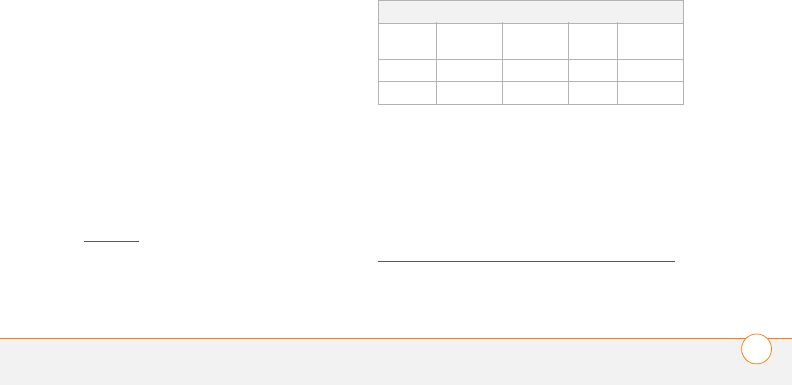
IMPORTANT SAFETY INFORMATION 299
Radiofrequency (RF) Energy
Understanding How Your Phone Operates
Your phone is basically a radio transmitter and receiver. When it’s
turned on, it receives and transmits radiofrequency (RF) signals.
When you use your phone, the system handling your call controls the
power level. This power can range from 0.006 watts to 0.2 watts in
digital mode.
Knowing Radiofrequency Safety
NOTE The design of your Palm Treo 800W complies with updated
NCRP standards described below.
NOTE In 1991-92, the Institute of Electrical and Electronics
Engineers (IEEE) and the American National Standards Institute
(ANSI) joined in updating ANSI’s 1982 standard for safety levels with
respect to human exposure to RF signals. More than 120 scientists,
engineers and physicians from universities, government health
agencies and industries developed this updated standard after
reviewing the available body of research. In 1993, the Federal
Communications Commission (FCC) adopted this updated standard
in a regulation. In August 1996, the FCC adopted hybrid standard
consisting of the existing ANSI/IEEE standard and the guidelines
published by the National Council of Radiation Protection and
Measurements (NCRP).
Body-Worn Operation
NOTE To maintain compliance with FCC RF exposure guidelines, if
you wear a handset on your body, use the Palm-supplied or -approved
carrying case, holster, or other body-worn accessory. Use of
non-Palm-approved accessories may violate FCC RF exposure
guidelines. Be sure to use an accessory that contains NO metal
(snaps, clips, etc) and provides AT LEAST 1.5 cm of separation
between the users body and the unit.
NOTE For more information about RF exposure, visit the FCC Web
site at www.fcc.gov.
Specific Absorption Rate (SAR) for Wireless Phones
The SAR is a value that corresponds to the relative amount of RF
energy absorbed in the head of a user of a wireless handset.
The SAR value of a phone is the result of an extensive testing,
measuring, and calculation process. It does not represent how much
RF the phone emits. All phone models are tested at their highest
value in strict laboratory settings. But when in operation, the SAR of a
phone can be substantially less than the level reported to the FCC.
This is because of a variety of factors including its proximity to a base
station antenna, phone design, and other factors. What is important
to remember is that each phone meets strict federal guidelines.
Variations in SARs do not represent a variation in safety.
All phones must meet the federal standard, which incorporates a
substantial margin of safety. As stated above, variations in SAR
values between different model phones do not mean variations in
safety. SAR values at or below the federal standard of 1.6 W/kg are
considered safe for use by the public.
The highest reported (FCC) SAR values of the Palm Treo 800W are:
FCC Radiofrequency Emission
This phone meets the FCC Radiofrequency Emission Guidelines and
is certified with the FCC as:
FCC ID # O8F-715
IC ID # 3905A-715
More information on the phone’s SAR can be found from the
following FCC Web site:
https://gullfoss2.fcc.gov/prod/oet/cf/eas/reports/GenericSearch.cfm.
• Static Electricity, ESD, and Your Smartphone
Maximum Scaled SAR Values (W/kg) FCC
CDMA2000
Cellular
CDMA2000
PCS
WLAN Co-location
Head 0.837 1.420 0.067 1.433
Body 0.577 0.456 0.018 0.595

IMPORTANT SAFETY INFORMATION
300
Electrostatic discharge (ESD) can cause damage to electronic devices
if discharged into the device, so you should take steps to avoid such
an occurrence.
Description of ESD
Static electricity is an electrical charge caused by the buildup of
excess electrons on the surface of a material. To most people, static
electricity and ESD are nothing more than annoyances. For example,
after walking over a carpet while scuffing your feet, building up
electrons on your body, you may get a shock—the discharge event—
when you touch a metal doorknob. This little shock discharges the
built-up static electricity.
ESD-Susceptible Equipment
Even a small amount of ESD can harm circuitry, so when working
with electronic devices, take measures to help protect your electronic
devices, including your Palm® smartphone, from ESD harm. While
Palm has built protections against ESD into its products, ESD
unfortunately exists and, unless neutralized, could build up to levels
that could harm your equipment. Any electronic device that contains
an external entry point for plugging in anything from cables to docking
stations is susceptible to entry of ESD. Devices that you carry with
you, such as your smartphone, build up ESD in a unique way because
the static electricity that may have built up on your body is
automatically passed to the device. Then, when the device is
connected to another device such as a docking station, a discharge
event can occur.
Precautions Against ESD
Make sure to discharge any built-up static electricity from yourself
and your electronic devices before touching an electronic device or
connecting one device to another. The recommendation from Palm is
that you take this precaution before connecting your smartphone to
your computer, placing the smartphone in a cradle, or connecting it to
any other device. You can do this in many ways, including the
following:
• Ground yourself when you’re holding your mobile device by
simultaneously touching a metal surface that is at earth ground.
For example, if your computer has a metal case and is plugged
into a standard three-prong grounded outlet, touching the case
should discharge the ESD on your body.
• Increase the relative humidity of your environment.
• Install ESD-specific prevention items, such as grounding mats.
Conditions That Enhance ESD Occurrences
Conditions that can contribute to the buildup of static electricity in the
environment include the following:
• Low relative humidity.
• Material type (The type of material gathering the charge. For
example, synthetics are more prone to static buildup than natural
fibers like cotton.)
• The rapidity with which you touch, connect, or disconnect
electronic devices.
While you should always take appropriate precautions to discharge
static electricity, if you are in an environment where you notice ESD
events, you may want to take extra precautions to protect your
electronic equipment against ESD.
Owner’s Record
The model number, regulatory number, and serial number are located
on a nameplate inside the battery compartment. Record the serial
number in the space provided below. This will be helpful if you need
to contact us about your phone in the future.
Model: Palm® Tr eo™800W
Serial No.:
User’s Guide Proprietary Notice
CDMA Technology is licensed by QUALCOMM Incorporated under
one or more of the following patents:
4,901,307 5,109,390 5,267,262 5,416,797
5,506,865 5,544,196 5,657,420 5,101,501
5,267,261 5,414,796 5,504,773 5,535,239
5,600,754 5,778,338 5,228,054 5,337,338
5,710,784 5,056,109 5,568,483 5,659,569
5,490,165 5,511,073

SPECIFICATIONS 301
Specifications
Radio •CDMA2000 with EVDO
Phone features •Personal speakerphone
•Hands-free headset jack (2.5 mm, 3-barrel connector)
•Microphone mute option
•TTY compatible
Processor technology •Samsung processor—300MHz
Expansion •miniSD card slot
Battery •Rechargeable Lithium-ion
•1200mAh power
•Removable for replacement
•3 hours full charge time
Operating system •Windows Mobile® 6 Professional
Camera •Still image capture resolution:1280 x 1024, 1.3 megapixel
•2x digital zoom
Size •4.44 in. x 2.34 in. x 0.84 in.
(112.9mm x 59.3mm x 21.3mm)
Weight •5.4 ounces (154 grams)
Connectivity •Infrared (1.0 compliant)
•Bluetooth® wireless technology (1.2 compliant)

SPECIFICATIONS
302
Display •Touch-sensitive LCD screen (includes stylus)
•65,536 colors (16-bit color)
•Resolution: 240 x 240
•User-adjustable brightness
Keyboard •Built-in QWERTY keyboard plus 5-way navigator
•Backlight for low lighting conditions
Included software •Today/Phone (includes
Speed Dial and Dial Pad)
•Messaging (text,
multimedia, and email)
•Internet Explorer Mobile
(web browser)
•Camera
•Pictures & Videos
•Windows Media Player
Mobile
•File Explorer
•Contacts
•Calendar
•Tasks
•Notes
•Calculator
•ActiveSync®
•Excel Mobile
•Word Mobile
•PowerPoint Mobile
•Voice Command
•Quick Tour
•Search
•Terminal Services
•Picsel PDF Viewer
•Bluetooth Plug-in

SPECIFICATIONS 303
System requirements •Windows XP or Vista (later versions may also be
supported)
•32MB of available memory (RAM)
•170MB of free hard disk space
•Available USB port
Operating and storage
temperature range
•32°F to 104°F (0°C to 40°C)
•5% to 90% RH

SPECIFICATIONS
304

INDEX 305
Index
SYMBOLS
! on battery icon 12
NUMERICS
112 calls 37, 245
1st day of week option 181
3GP files 163
3GPP files 123, 160
3GPP2 files 123, 160
5-way navigator 7, 19, 21,
284
911 calls 37, 245
A
AC charger 11, 79
accented characters 28, 29
accessing
ActiveSync 78
alternate characters 28
applications 30, 240
calculator 231
Calendar application 176
Contacts application 173
Dial Pad 41
File Explorer 218
information 31, 252
Internet Explorer 137
menu items 22, 23, 24
Messaging app 121
Notes application 185
on-device help 287
online address books 107
options in lists 24
Outlook folders 275
Palm online support 287
PDF Viewer 193
Phone Settings screen 15
Pictures & Videos
application 159, 160,
164, 166
Quick Tour 287
remote files 256
speed-dial buttons 38
spreadsheet templates
202
Tasks application 183
Tasks entry bar 185
the Internet 256, 270
Today screen 14, 31
web pages 137, 139, 141,
281
Wireless Manager 36
accounts
conference calls and 48
customer service support
for 287
missing phone numbers
and 16
preventing unauthorized
use of 245, 252
removing email 99
troubleshooting 278
Accounts tab 99, 105, 110
action keys 7, 22
actions 22, 238
activating items on screen 22
active call info 44
active calls. See phone calls
ActiveSync
defined 289
installing 71
opening 78
receiving email and 103
synchronizing with 71, 73,
261, 272
troubleshooting 261, 272–
277
ActiveSync icon 78, 81, 191,
289
ActiveSync Plug-in for
Bluetooth 86
Add a new VPN server
connection option 257

INDEX
306
Add Contact prompt 46
Add Favorite dialog box 139
Add Media command 124
Add Picture command 124
Add Recipient command 121
Add Server Source command
82
Add Sound command 124
Add to Contacts command
127
Add to Favorites command
139
Add to Personal Address
Book command 275
adding
a second call 47
applications 240
appointments 177, 179
attachments to email 102,
117, 219
bookmarks 139
bulleted or numbered lists
197
caller ID pictures 174
connections 256, 257
contacts 46, 60, 173
document templates 195
expansion cards 226
files to playlists 167
folders 198
notes 174, 185, 186
online address book 106–
107
passkeys 146
signatures 110, 131
speed-dial buttons 50
spreadsheets 200
tasks 183
untimed events 178, 179
address book 106, 107, 112,
175, 275
Address List Lookup 217
address messaging options
112
Address tab 107, 112
addresses
adding 173
checking for 112
copying 275
entering email 102, 112
entering web 32, 137
looking up corporate 217
multiple recipients and
102, 122
selecting 22, 281
synchronizing 275
adjusting screen brightness
238
Advanced tab (Power
Settings) 254
advancing slides 199, 200
After calls from numbers…
option 60
Agenda View (calendar) 176
alarm clock 251
alarm sounds 252
alarms
adding 178, 183
setting 238, 251
turning on and off 237
Alarms tab 251
albums 160
alert tones. See alarms;
ringtones
aligning the screen 239
alignment settings
documents 197
spreadsheets 200
Allow cookies check box 142
Allow USB connections
check box 273
Alt key 26, 289
alternate characters 28, 29
alternate characters list 28,
29
AMR files 122
animation 163, 199, 200

INDEX 307
anniversaries 179
Answer button 42
answering the phone 42, 47
Appearance tab 235, 240
application icons 30, 241
applications
See also third-party
applications
associating with buttons
241
battery life and 13
caution for hard resets and
263
choosing menu items in
23, 24
closing 30, 254
copying 229
customizing 240–245
deleting 222, 284
displaying 30, 254
downloading 219, 221
error reporting for 252
included with device 302
installing 219–220, 283,
284
losing information in 263
moving through 20, 21
moving to expansion cards
229
opening 30, 228, 240
phone calls and 45
reinstalling 261, 263
running from expansion
cards 228, 284
running multiple 30
selecting 30
storing 284
synchronizing information
in 73, 88
troubleshooting 264, 266
turning sounds on or off
for 237
viewing memory usage for
253
Appointment tab 177
appointments
adding 177
appearing in wrong time
slots 276
deleting 180, 181
hiding 180
marking as private 180
reminders for 178
scheduling repeating 179
viewing 176
Appointments tab 182
Area code option 175
arrow icons 19
ascending sort order 208
ASF files 160
Assign a program list 241
attachments
adding 102, 117, 219
downloading 104, 105
embedded objects in 106
internal memory and 284
opening 104
storing 105, 113
troubleshooting 280
Attendees option 179
audio 42, 159, 163
auto-completion options 243
AutoCorrect command 162
Autofill option 205
AutoFilter command 208
AutoFilter settings
(spreadsheets) 201
auto-keyguard feature 245,
246
Auto-Keyguard list 246
Automatically download
MMS messages check
box 131
auto-off interval 289
available memory 253
available storage space 253

INDEX
308
B
back view (device) 8
backgrounds 154, 161, 169,
235
backing up information 69,
261, 263
backlight (keyboard) 26, 255
backlight shut-off interval 27
Backspace key 22, 26, 28
backup and restore
application 81
backup utilities 261, 263,
264, 277
backups, restoring 264, 277
battery
Bluetooth connections
and 144
charging 11–12
conserving power for 255
disposing of 264, 298
inserting 10
maximizing life of 13–14
purchasing 11
removing 263, 265
replacing 264–265
specifications for 301
viewing remaining power
for 254
viewing status of 67
battery door 10
battery door release 8
battery icon 12
Battery Power tab 27
battery status icons 67
Battery tab 254
Beam File command 223
Beam tab 225
Beam… command 224
beaming 14, 219, 223–225,
289
birthdays 179
blank screens 267
Block incoming calls list 61
Block outgoing calls list 61
blocking phone calls 60
Bluetooth connections
battery level and 144
battery life and 14
checking status of 56
communicating over 54
hands-free devices and
54, 55, 56
overview 143
synchronizing over 86
Bluetooth devices
beaming to 225
connecting to 54–56,
143–146
creating partnerships for
145
discovery setting for 147
phone calls and 56
receiving information over
145, 147
sending information over
145, 147
troubleshooting 271
Bluetooth icon 56, 68, 144
Bluetooth Plug-in 144
Bluetooth Settings screen
144–147
Bluetooth wireless
technology 135, 224, 289
BMP files 159
Bold option 196
bookmarks 139
See also favorites
border highlight 21
borders 200
brightness, adjusting 238
browsing files and folders
218, 230
browsing the web. See web
browsing
built-in applications 222, 302
built-in camera. See camera
bulleted lists 197

INDEX 309
bullets 193
Burst mode 156
button settings 169
buttons
assigning to media files
169
assigning voice
commands to 241
associating with
applications 241
creating speed-dial 50
disabling 246
editing speed-dial 52
opening menus and 22
reassigning 241
selecting or activating 21
showing voicemail 51
turning sounds on or off
for 237
Buttons icon 241
Buttons list 241
Buttons screen 241
Buttons tab (Options) 169
C
CAB files 221
calculations 203, 204, 231
Calculator application 231
calculator buttons 232
Calculator icon 231
calendar
adding items to 178, 179
displaying 176
removing events 181
setting alarms for 178
setting options for 181
unavailable slots on 180
Calendar application
adding contacts and 173
customizing 181–182
managing schedules with
177–181
selecting views 176
starting 176
untimed events in 178
calendar options 181–182
Calendar views 176, 181,
182
call forwarding 49
call forwarding icon 49
Call Log 40
Call Sender command 127
call waiting 47
call-barring password 61
caller ID applications 283
caller ID blocking 46
caller ID pictures 154, 174
caller IDs 61
call-waiting notifications 62
camcorder icon 155
camera
battery life and 13
capturing videos with
156–157
specifications for 301
taking pictures 154–156
troubleshooting 282
camera lens 8
Camera Preview Mode 282
camera settings 157–159
Camera tab 158
Cancel Bluetooth command
56
capitalization 27, 245
Capitalize first letter of
sentence check box 245
Caps Lock icon 27
Caps Lock mode 27
captions 124
Carrier
call forwarding and 49
conference calls and 48
cascading menus 24
case-sensitive searching
195, 210
categories
contacts 174

INDEX
310
events 180
playlists 167
tasks 183, 184
cell patterns (spreadsheets)
200
certificates 137, 252
Certificates icon 252
Certificates screen 252
changes, undoing 162
changing
alarm sounds 252
color themes 235, 240
connections 256
contacts 174
date and time settings 250
email accounts 99
information 209
picture or video resolution
155, 156, 282
PIN numbers 248
speed-dial buttons 52
text 195
text size 238
character entry 29
character sets 142
characters
capitalizing 27, 245
entering 26, 27, 204, 243
phone calls and 51
scrolling 20
text messages and 121,
122
typing alternate 28
charge indicator 7, 12
charger cable 11
charging
device 11, 13
device battery 11–12
charging status 12
Chart command 209
chart options 209
charts 201, 209
Chat icon 128
chat sessions 128, 131
Chat tab 132
check boxes 21
chronological list of calls 40
Clear Cookies button 143
Clear History button 142
Clear Now Playing command
168
Clear Type tab 238
clearing web links 142
Clock & Alarms icon 250,
251
Clock & Alarms Settings
screen 250, 251
closing
applications 30, 254
menus 24
notification messages 126
screens 21
color settings 282
color themes 235, 240
command button 242, 243
commands 22, 242
See also menus; voice
commands
Company Directory
command 108
company names 41, 174
comparisons 208
completed tasks 183, 184
components (Treo device) 3
compressed files 219
computers
connecting to 79
installing from 221, 222
reinstalling desktop
software on 261
synchronizing with 87, 89
system requirements 75
viewing videos and
pictures on 153
Conference button 48
conference calls 48

INDEX 311
confidential events 180
Confidential option 180
configurations
troubleshooting 270
Configure Server command
280
configuring
data services 270
mail servers 280
TTY devices 59
Confirm message deletions
check box 131
confirmation messages 132
Connect command 257
Connect via Bluetooth
command 87
Connect via IR command 87
connecting
charger cable 11
device to PCs 79
headsets 52
to Bluetooth devices 54–
56, 143–146
to hands-free car kits 54
to mobile networks 268
to service providers 256
to the Internet 256, 270
to TTY devices 59
to VPNs 256–257
to web sites 137, 147
connection icons 257
Connection Settings
command 273
connections
adding 256, 257
changing 256
displaying 256
ending 257
losing 271
manually starting 257
precautions for 300
removing Bluetooth 146
setting up 256–257
setting up wireless 148
timing out 278
troubleshooting 267–272,
281
trusted devices and 147
Connections icon 256
Connections screen 256,
257, 270, 271
Connections tab 225, 256
connectivity specs 301
conserving battery power
255
contact categories 174
contacts
adding 46, 60, 173
addressing messages to
102, 112, 121, 123
assigning ringtones to 51,
59, 161, 174
changing 174
displaying 174
linking speed-dial buttons
to 50
looking up 32, 38, 175
making calls to 38
personalizing 59
removing 175
saving information for 46
selecting communication
method for 39
sending messages to 122,
179
viewing details list for 39
Contacts application 173–
175
Contacts list 39, 47, 122,
127, 175
context-sensitive menus 24
continuous playback (slides)
200
cookies 137
Copy command 141, 161,
196, 229

INDEX
312
copying
addresses 275
applications 229
items in folders 219
phone numbers 40, 41,
141
pictures and videos 161
text 141, 196
copyrighted items 160
corporate mail systems 256,
280
corporate networks 252
corporate servers 256, 280
coupling 285
coverage area 14, 35, 268
Create chat from messages
option 132
creating
appointments 177, 179
bookmarks 139
bulleted or numbered lists
197
caller ID pictures 174
connections 256, 257
contacts 46, 60, 173
documents 193, 194, 195
email messages 102
folders 198
multimedia messages 122
notes 185, 186
online address book 106–
107
partnerships 145
passkeys 146
playlists 167
signatures 110, 131
speed-dial buttons 50
spreadsheets 200
tasks 183
templates 127, 195, 202
text messages 121
untimed events 178, 179
video ringtones 161
workbooks 202
credentials 257, 278
cropping pictures 162
currency symbols 239
Currency tab 239
customer assistance 287
Customize the playlists…
check box 164
customizing
applications 240–245
Calendar 181–182
camera 157–159
chat settings 131
Contacts application 175
dates and time 250
email settings 110
Excel Mobile 211
format settings 239
Internet Explorer Mobile
142–143
Media Player Mobile 168
Messaging application
130–133
network settings 133
Notes application 187
phone 57–65
system settings 250–255
system sounds 236
tasks 184
Today screen 235
voicemail system 51, 58
Word Mobile 198
Cut command 161, 196
cutting. See deleting
D
daily schedules 176
data 263
See also information
data connection icons 257
data filters 181, 208
data formats 239
data service icons 268

INDEX 313
data service providers 256,
270, 279
data services 3, 268, 270
data transmission speeds 3
date format settings 239
Date tab 239
dates 205, 239, 250
See also calendar
Day View 176, 181
day-planner formats 176
decimal places 239
decimal symbols 239
decompression utility 219
default document template
198
default format settings 239
Default mode option 187
Default option 138
default PINs 247
Default template option 187
Default zoom level options
245
defined names
(spreadsheets) 207
delays 36, 270
Delete Appointment
command 180, 181
Delete Cells command 210
Delete command 130, 198,
211
Delete Contact command
175
Delete Files button 142
Delete Task command 184
Deleted folder 113, 284
deleting
applications 222, 284
Bluetooth connections
146
certificates 252
contacts 175
directory services 107
documents 198
email accounts 99
events 181
favorites 140
files 219, 284
items from libraries 166
items from playlists 167
items in folders 219
messages 112, 130, 131
notes 187
partnerships 146, 271
pictures 162
speed-dial buttons 52
tasks 184
text 22
web files 142
workbooks 211
worksheets 211
descending sort order 208
Desktop option 138
desktop software 261, 289
See also applications;
software
device
additional information for
287
caution for resetting 263
caution for storing 8
charging 11, 13
compatibility with
third-party vendors 73
compatible hands-free
devices for 54
components of 3, 7–9
connecting to PCs 79
disabling touch-sensitivity
for 246
features described 3
freeing space on 222, 284
getting help with 259, 287
getting phone number for
15
locking 248
losing 81, 249

INDEX
314
low lighting conditions and
26
management tools for 215
moving around on 17
not responding 262, 268,
283
personalizing 233
required items for 4
resetting 248, 262–264,
268
setting up 9–16
specifications for 301
system requirements for
303
third-party applications and
282, 283
troubleshooting 287
turning on and off 36
unlocking 248
updating information on
69
device names. See
usernames
Device Setup Wizard 164
devices
See also Bluetooth
devices; device
battery life and 13
beaming to 224
configuring TTY/TTD 59
discovering trusted 143,
144, 147
electrostatic discharge and
299
physically-impaired
disabilities and 59
transferring information
from 261
troubleshooting 271
Devices tab 145, 271
diagnostic information 252
Dial Lookup list 15
Dial Pad 39, 41
dialing 14, 36–40, 41, 51
dialog boxes 290
digit grouping 239
digital cameras 159
See also camera
digital certificates 137, 252
dimmed images 267
Direct Push Technology 82
directory service 106, 107,
112
Disable touchscreen check
box 247
Disconnect Bluetooth
command 87
Disconnect command 258
discoverable setting 147
discovering trusted devices
143, 144, 147
disk space 303
See also memory
Dismiss button 44
display formats 239
Display message on screen
check box 238
display options (web) 138
display settings 238–240
See also screen
displaying
alternate characters 28
animated images 163
applications on device 30
appointments 176
calendar 176
contacts 39, 174
current connection 256
daily schedules 176
events 178, 180
folder contents 218
memory usage 253
multimedia messages 128
notifications 58, 238
on-device help 287
PDF files 193
pictures 153, 154, 159

INDEX 315
power settings 254
Quick Tour documentation
287
running applications 254
space on expansion cards
230, 254
tasks 184
videos 153, 154, 159
web pages 137, 138
wireless settings 255
DOC files 193
document file types 193, 199
documentation 4, 287
documents
See also Word Mobile
application
creating 193, 194, 195
deleting 198
finding and replacing text
in 195
moving or copying text in
196
opening 194
organizing 198
saving 193, 194, 196, 198
sending 91
setting margins for 197
spell-checking 197
supported features for 193
unsupported features for
193
documents list 199
DOT files 193
downloading
applications 219, 221
attachments 104, 105
email 84, 103, 104
files 140
images 141, 163
multimedia messages
126, 131
Palm-specific information
and updates 287
pictures 159
ringtones 57
videos 163
Downloads favorite 141
downward-pointing arrows
24
drained battery 13
drawing 185
drivers 262
Drop and Answer command
48
drop-down lists
accessing 24
exiting 25
highlighting in 20, 25
scrolling through 20
selecting items in 22, 25
drop-down menus 24
E
earpiece 7, 285
echoes 285
EDGE connections 290
Edit command 162, 174
Edit Server Settings screen
82
Edit Speed Dial command 52
editing. See changing
electrostatic discharge 300
email
adding address book for
106–107
adding attachments to
102, 117, 219
addressing 102, 112
creating 102
deleting 112, 113
dialing from 41
downloading 84, 103, 104
entering contacts and 173,
179
forwarding 109
getting from corporate
servers 256, 280

INDEX
316
getting from Exchange
servers 103
internal memory and 284
priority settings for 103
receiving attachments
with 104
reply options for 112
requirements for 3
selecting addresses 22
sending 103, 104, 117,
139, 279
synchronizing 13, 103,
272, 279, 280
troubleshooting 278–280
email accounts
changing 99
deleting 99
troubleshooting 278
email applications 281
E-mail button 104
email client software 280
email message icons 129
embedded images 106
emergency calls 37, 245
emoticons 122
Enable Clear Type check box
238
Enable fixed dialing check
box 64
Enable local network time
check box 251
encoding options 142
encryption 137
End Show command 199
End User License
Agreement 4
ending
active calls 45
data connections 257
playback 165
endnotes 194
entering
alternate characters 28, 29
data in spreadsheets 202,
205
information 27–28
numbers 26, 27
owner information 249
passkeys 55, 146
passwords 83, 95, 98,
248, 249
phone numbers 14, 36,
39, 41
PINs 247
text 244, 245
web addresses 32, 137
Entire column option 211
Entire row option 211
entry fields
deleting text in 22
highlighting in 20, 22
moving to 20
opening drop-down lists in
25
scrolling through 20
Erase all data? prompt 264
erasing. See deleting
error messages 237, 277
error reporting 252–253
Error Reporting icon 253
Error Reporting screen 253
errors 252, 268, 277
ESD (electrostatic discharge)
299–300
Even when roaming check
box 131
event categories 180
event icons 182
Event list 238
events
creating 178, 179
deleting 181
filtering 181
hiding 180
marking as sensitive 180
reminders for 178
selecting sounds for 238

INDEX 317
setting notification
preferences for 238
Events check box 237
Excel files 189
See also Excel Mobile;
spreadsheets
Excel Mobile application
customizing 211
display settings for 203
overview 200
searching in 209
starting 202
supported features 200
unsupported features 201
Excel Mobile icon 202
Exchange ActiveSync 280,
290, 293
Exchange Address Book 275
Exchange server credentials
screen 278
Exchange server sync
options 84, 278
Exchange servers
accessing 175
getting email from 103
setting up accounts for
82–84
synchronizing with 13, 72,
87, 277
troubleshooting 278, 280
exiting applications 30, 254
expanding lists in fields 25
expansion card slot 8, 226,
301
expansion cards
as storage medium 284
browsing on 230
displaying available space
on 230, 254
inserting 226–227
installing apps on 222
moving apps to 229
moving information to
198, 210, 229
opening items on 228
removing 227
renaming 230
searching on 217, 219
storing attachments on
105, 113
transferring files to 163,
166, 228, 229
types supported 226
extensions (phone) 51
external power sources 254
External Power tab 27
Extra Digits button 43, 51
Extra Digits text box 51
Extract command 49
F
factory settings 169
factory-installed applications
222, 302
favorites 139–140
See also web pages
Favorites button 140
Favorites command 140
features 3
Federal Trade Commission
website 253
feedback 285
fields. See entry fields
File Explorer 217, 218–219,
230, 231
File Explorer icon 218
file names 196, 198, 217
file types
displaying 199
documents 193
Media Player 163
multimedia 122
pictures 159
videos 160
files
accessing from corporate
accounts 256

INDEX
318
browsing 218
decompressing 219
deleting 219, 284
downloading 140
moving 198, 219
saving 228
searching for 217, 219
selecting multiple 219
transferring to expansion
cards 163, 166, 228,
229
fill series (spreadsheets) 205
Filter command 174, 181
Filter option 184
filtering
events 181
information 174, 208
tasks 184
filters 181, 208
Find Online command 175
Find/Replace command 195,
209
finding
contacts 32, 38, 175
information 209
text 195
firewalls 272
5-way navigator 7, 19, 21,
284
fixed dialing 63
folder names 198
folders
accessing Outlook 275
adding documents to 196
arranging pictures and
videos in 161
browsing 218, 230
creating 140, 198
moving items to 198, 210,
219
opening items in 219
organizing web favorites in
139, 140
sorting contents 219
synchronizing messages
in 103
Font color option 196
Font command 196
Font option 196
fonts 194, 196, 201, 238
footers 194
footnotes 194
forgetting passwords 248
format settings 239
formats, losing 193
formatting
charts 209
paragraphs and lists 197
spreadsheets 200, 207
system data 239
text 196
Formatting toolbar 197
forms (web) 139
formulas 201, 204, 211
Forward command 109
forwarding
messages 109, 127
phone calls 49
freeing memory 222, 277,
284
Freeze Panes option 203
front view (device) 7
full charge (battery) 11
Full Screen option 138
functions (spreadsheets)
201, 204
G
games 13
getting started 4, 5, 14, 287
GIF files 123, 159, 163
Global Address List 106,
107, 175
Global Address List Lookup
217
Glossary 289
Go to Slide command 199

INDEX 319
GPRS connections 290
graphics programs 162
H
HAC setting 297
Hands Free check box 56,
271
hands-free car kit 53, 56
hands-free devices
connecting to 54
setting up 52
tips for 57
troubleshooting 271
turning Keyguard on or off
for 246
hanging indents 197
hanging up phone 15, 45
hard resets 248, 263
hardware 3
Hardware buttons check box
237
headers 194
headset button 53
headset jack 7
headsets
configuring as trusted
devices 144
connecting 52–54
disabling Keyguard and
246
hearing-impaired 59
heat sources 14
help 259, 287
Help topics 30
hiding
appointments 180
events 180
images 138
speed-dial buttons 38
Tasks entry bar 185
highlight 21
Highlight option 197
highlighting
applications 30
items in folders 219
items on screen 20, 21–
22
menu items 23, 24
options in lists 20, 25
text 22, 197
Hint tab 249
hints (passwords) 249
History command 141, 166
History list 141, 142
Hold button 45
home locations 250
Home page option 142
hypertext links. See links
I
icons
application 30, 241
battery status 12
data connections 257
data services 268
email 129
events 182
message status 129
navigator 19
phone status 66
signal-strength 35, 255
Identification tab 249
Ignore with text message
command 42
image file types 159
image files 123, 153, 284
images
See also pictures
dimmed 267
downloading 141
hiding web page 138
incorrect color settings
and 282
receiving 106
setting background 161,
235

INDEX
320
troubleshooting web page
281
IMAP accounts 94, 96, 105
inactivity 156, 157, 254
Inbox 20, 103, 129
Inbox application 102, 106
Include file attachments
check box 105
incorrect passwords 248
Indentation setting 197
indented lists 194
indenting text 197
indicator light 7, 12
information
accessing 31, 252
backing up 69, 261, 263
changing 209
entering 27–28
erasing all 272
filtering 174, 208
losing 193, 263
moving 198, 210, 229
protecting 245–249
removing battery and 264
restoring 263, 264
searching for 195, 210,
217–218
sharing 223
sorting 208
storing 225, 284
synchronizing 71, 73, 272
transferring 69, 261
updating 69
infrared port. See IR port
infrared transmissions 87,
290
Input icon 243
input options 26, 243
Input screen 243, 244
inserting expansion cards
226–227
installation, troubleshooting
264, 283
installing
ActiveSync 71
applications 219–220,
283, 284
bonus software 220
SIM smartcards 9–16
synchronization software
75, 76, 77
VPN clients 256
Windows drivers 262
instant messaging
applications 283
internal memory. See
memory
Internet 256, 270
See also web browsing;
websites
Internet Connection Sharing
147
Internet Connection Speed
option 169
Internet Explorer Mobile
browsing with 137–142
closing 139
customizing 142–143
installing from 221
scrolling in 20
starting 137
unsupported elements for
137, 281
IR connections 225
IR port 8, 87, 224, 290
ISP mail systems 96
ISP settings 256
ISPs (Internet Service
Providers) 256, 279
Italics option 197
Items tab 235
J
JavaScript 137
JPEG files 123
JPG files 159

INDEX 321
K
keyboard
accessing alternate
characters on 28
dialing from 36
entering information from
27–28, 245
locking 246
scrolling with 20
selecting menu items
from 24
setting key combinations
for 241
specifications for 302
troubleshooting 284
keyboard backlight 26, 255
keyboard icon 26
Keyguard 246
Keyguard icon 246
Known Caller option 57
L
language-impaired 59
leading zeros 239
left action key 22, 177
Legacy Pocket Word files
194
libraries (media) 166
Library command 165
Library list 165
Library screen 165, 169
Library tab 169
lightening bolt 12
Li-Ion battery 290
See also battery
links
clearing web 142
internal memory and 284
media files and 166
messages and 129, 139
selecting 21, 138
troubleshooting 281
list separators 239
List setting 197
Listen button 44
listening to
media files 163
voicemail messages 44
lists
accessing 24
creating 194, 197
displaying alternate
characters and 28
exiting 25
formatting 197
highlighting in 20, 25
navigating web page 139
scrolling through 20
selecting items in 22, 25
Lithium Ion battery 290
See also battery
locating
contacts 32, 38, 175
information 209
location-specific information
239, 250
Lock icon 137, 160, 248
Lock screen 248
locking
SIM smartcards 247
spreadsheet rows and
columns 203
the keyboard 246
the screen 246
Treo device 248
logging in to
corporate servers 256
networks 252
looking up contacts 32, 38,
175
lookup feature 217
losing
connections 271
information 193, 263
passwords 248
Treo device 81, 249
low coverage areas 268

INDEX
322
low lighting conditions 26
lowercase letters 27
M
magnet 8
magnification. See zoom
settings
mail servers 256, 280
Main tab 253
Make the device
discoverable check box
144
Make this device
discoverable setting 147
Manage existing connections
option 256, 257
Manage Folders command
103
Manage tab 237
management tools 215
manually closing applications
31
MAPI clients 280
maps 281
margins 197
Match case box 195, 210
Match whole words only
check box 195, 210
measurement units 239
media files
creating playlists for 167
formats for 163
linking to 166
playing 164
synchronizing 164
transferring 163, 166
troubleshooting 276
media libraries 166
Media Player 276
Media Player Mobile 163–
169
media players 13
Media sync option 164
meeting invitations
accepting/declining 116
meeting requests 106, 107,
179, 182
memory
available 303
freeing 222, 277, 284
low conditions for 31, 253
running apps and 30, 228
storing numbers in 232
viewing expansion card
230
memory buttons 232
Memory icon 230
memory options (web) 142
Memory screen 253
Memory Settings screen 31
Memory tab 142
memory usage 253
memos. See messages;
notes
menu items 23
Menu key 23, 24
menus 22–24
Menus icon 240
Menus screen 240
Message Details command
127
message list 128, 129
Message Options command
125
Message Options screen
125
Message Priority list 125
message status icons 129
Message tab 111
Message validity period
option 131
messages
See also multimedia
messages; text
messages; voice notes
adding signatures to 110,
131

INDEX 323
addressing 102, 122, 123
automatically resending
131
creating email 102
deleting 112, 130, 131
dialing from 41
displaying notification 238
displaying status of 129
forwarding 109, 127
invalid characters and 122
listening to 44
receiving notifications for
126, 132, 270
saving 103
sorting 130
storing 284
Messages tab 131
Messaging application
See also text messages;
multimedia messages
adding contacts and 173
chat sessions and 128
customizing 130–133
email settings in 110
messaging options in 125
notification options in 126
overview 121
play options in 127
starting 121
status icons in 129
messaging applications 283
messaging services 270,
290
microphone 7, 45, 159, 285
microphone icon 242
Microsoft ActiveSync. See
ActiveSync
Microsoft Exchange
ActiveSync.See Exchange
ActiveSync
Microsoft Office 189
Microsoft Office Excel 201
See also spreadsheets
Microsoft Windows Mobile
software 220
Microsoft Windows Mobile
website 261
Microsoft Word documents.
See documents
MIDI files 122
miniSD cards 225
mirror 8, 155
Missed call option 57
MMS files 166
MMS messaging 121, 290
mobile accounts. See
accounts
Mobile Device component
(Windows) 291
Mobile Device folder 78,
221, 222
mobile devices 224, 261
mobile networks 267, 268
mobile phone numbers 173
Mobile to Market certificates
220
Mode tab 144
model numbers 300
Modem tab 256
ModemLink application 147
modems 147
Modify Sheets command
208, 211
Month View 177
most recently dialed
numbers list 40
moving
documents to folders 198,
219
files to expansion cards
163, 166, 228, 229
information 198, 210, 229
pictures and videos 161
speed-dial buttons 52
text 196
workbooks 210

INDEX
324
moving around the screen
19–21
moving through web pages
138
MP3 files 163
MP4 files 163
MPEG files 160
MPEG4 files 123
multi-connector 7
multi-line fields 20
multimedia features 119,
151
multimedia file types 160
multimedia files 159, 284
multimedia messages
creating 122
deleting 130, 131
displaying 128
downloading 126, 131
forwarding 127
internal memory and 284
opening 126
overview 119
phone numbers in 41
playing 126–128
previewing 125
receiving 126
replying to 127
requirements for 3
saving 127
sending 123, 125, 128
setting options for 125
sorting 130
troubleshooting 270
Multimedia Messaging
System. See MMS
messaging
multiple recipients 102, 122
music 42, 163, 165, 237
See also media files
music files 276
Mute command 45
My Device folder 218
My Device library 166
My Documents folder 217,
218, 263
My Pictures folder 154, 156
My Playlists category 167
My Storage Card library 166
My Text command 102
My Text phrases 102
N
names 32, 293
naming
document files 196, 198
expansion cards 230
folders 198
groups of pictures 158
speed-dial buttons 50
templates 195, 202
workbooks 210
worksheets 206, 208
navigating the screen 19–21
navigating web pages 138
navigator. See 5-way
navigator
navigator buttons 19, 21
negative numbers 239
network protocols 168
network settings 64, 133
Network tab 64, 168
networks
changing 65
connecting to 65
logging in to 252
troubleshooting 267–272
New Account command 94,
96
New Appointment command
177, 178
New MMS command 123
New Partnership option 145
New Sound command 237
New Speed Dial command
50

INDEX 325
notes
adding 174, 183
creating 185, 186
removing 187
saving 187
Notes application 185–188
Notes icon 185
Notes list 186, 187
Notes tab 174, 249
notification options 126, 132,
238
notification screens. See
notifications
Notification tab 132
notifications
changing event 238
closing 126
displaying 58
downloading sounds for
57
enabling or disabling 238
phone calls and 62
previewing sounds for 58
receiving messages and
126, 132
receiving phone calls and
47
receiving transmissions
and 147
receiving voicemail 44
setting ringtones for 57
setting system sounds for
237
silencing sounds for 236
troubleshooting 270
Notifications check box 237
Notifications tab 57, 237
Now Playing playlist 167,
168
Now Playing screen 167
number format settings 239
number pad 14
number sign symbol 239
Number tab 239
numbered lists 197
numbers
See also phone numbers
entering 26, 27
formatting 201, 205
pasting into Calculator 232
O
Off Hold button 45
Office Outlook. See Outlook
Office Word documents. See
documents
offline synchronization 275
Off-peak times options 85
OK button 7, 31
One Column option 138
online address book 106,
107, 112, 175
online support (Palm) 287
Open URL command 166
opening
ActiveSync 78
alternate characters list 28
applications 30, 228, 240
attachments 104
calculator 231
Dial Pad 41
documents 194
email applications 281
File Explorer 218
items in folders 219
menus 22, 24
multimedia messages 126
on-device help 287
Outlook folders 275
PDF Viewer 193
Phone Settings screen 15
Quick Tour 287
templates 202
text messages 127
Today screen 14, 31
web pages 137, 139, 141
Wireless Manager 36

INDEX
326
operating system (device)
266, 293, 301
operating systems (PCs) 75
Option key 20, 26, 27, 291
Option Lock icon 27
Option Lock mode 27
options
displaying 180
highlighting 20, 21, 25
selecting 24, 25
Options screen (ActiveSync)
88
Options screen (Internet
Explorer) 142
Options screen (messaging)
105, 110, 111, 113, 114,
130
Options tab 235, 244, 249
organizer features 36, 171
orientation (screen) 240
orientation (slides) 200
orientation options 240
Orientation tab 200
outages 270
Outbox 129
Outlook
accessing folders for 275
copying addresses to 275
downloading messages
from 103, 105
email client software and
280
installing drivers for 262
synchronizing with 82,
108
Outlook E-mail screen 94,
96, 102
overdue tasks 184
Override playback options
200
owner information 249
Owner Information icon 249
Owner Information screen
249
P
page breaks 194
paired relationships. See
partnerships
pairing. See partnerships
Palm (online support) 287
Palm applications 221
Palm devices 79, 261
Paragraph command 197
paragraph formatting 197
partial battery icon 12
partnerships 145, 271, 291
passkeys 55, 146
Password tab 248
Password type list 248
passwords
call-blocking and 61
corporate email accounts
and 83, 98
entering 83, 95, 98, 248,
249
forgetting or losing 248
locking device and 246,
248
saving 95, 98
spreadsheets and 201
Paste command 161, 196
patches 222
patterns in workbooks 200
Pause playback option 127,
168
PDF files 193
PDF Viewer 193, 211
Peak times options 85
performance 266, 283
Personal Address Book 275
personal computers
connecting to 79
installing from 221, 222
reinstalling desktop
software on 261

INDEX 327
synchronizing with 87, 89
system requirements 75
viewing videos and
pictures on 153
personal events 180
personal identification
numbers (PINs) 63, 247,
292
personal information 248,
249, 290
personal information
managers 275, 292
See also PIM applications
Personal option 180
Personal tab 57
personalizing your device
233
phone
See also phone calls;
phone numbers; device
adjusting volume 15, 59
advanced features 44–50
answering 42, 47
customizing 57–65
dialing 14, 36–40, 41, 51
disabling touch-sensitive
feature for 246
hanging up 15, 45
network settings for 64
ringtones for 57, 58
running applications and
45
selecting wireless band for
62
silencing ringer 42
specifications for 301
waking up screen for 45
phone calls
See also phone; phone
numbers
adding a second 47
blocking 60
ending 15, 45
forwarding 49
hands-free devices and
53, 56, 57
making 14, 36, 41, 44,
127
placing on hold 45
receiving 42, 44
receiving notifications for
62
restricting 63
sending to voicemail 42
setting up conference 48
troubleshooting 271, 285
Phone dialog box 41
phone headset 52–54
See also headsets
Phone icon 247
phone lock feature 245
phone numbers
See also phone; phone
calls
assigning to speed-dial
buttons 50
copying 40, 41, 141
entering 14, 36, 39, 41
entering extra digits with
51
locating device 15
missing from Phone
Settings screen 16
redialing most recent 40
saving 46
selecting 22
Phone Off message 35, 291
Phone Settings screen 15,
16, 60, 247
phone status icons 66
Phone tab 60
Phone/Send button 7, 15,
37, 291
Phone/Send icon 37
phone-off icon 13, 35
photo albums 160
photos. See pictures

INDEX
328
pick lists
accessing 24
exiting 25
highlighting in 20, 25
scrolling through 20
selecting items in 22, 25
Picsel PDF Viewer 211
picture files 123, 153
picture formats 159
Picture Speed Dial button 51
picture speed-dial buttons
38, 50
pictures
adding as backgrounds
161, 235
adding as screensaver 158
adding sounds to 124
adding to messages 124
adjusting resolution of
155, 162
creating caller ID 174
default resolution settings
for 282
deleting 162
downloading 159
editing 162
hiding on web pages 138
naming groups of 158
previewing 156, 157, 282
receiving 154
saving 158
sending 160
setting default size 158
storing 284
synchronizing 153
taking 154–156, 282
viewing 153, 154, 159
Pictures & Videos application
157, 159–163
PIM applications 289, 292
PIMs 262, 275, 292
PIN unlock key 292
PINs 63, 247, 292
Play button 165
Play Slide Show command
160
Play Sound box 58
Play sound check box 238
Play Sound list 252
playback icons 51
playback options 168, 200
Playback screen 168, 169
Playback tab 168, 200
playing
media files 164
multimedia messages
126–128
presentations 199, 200
sounds 159
voice notes 186
voicemail messages 44
playlists 163, 164, 167
plug-ins 137, 236
POP accounts 94, 96
pop-up menus 24
port numbers 257
ports. See IR port; USB ports
Power icon 254
Power screen 254
Power/End button 7, 35
PowerPoint files 189
PowerPoint Mobile
application 199–200
PowerPoint Mobile icon 199
precautions 300
preferences 131, 233
See also customizing
preinstalled applications 222,
302
presentations 199, 200
See also PowerPoint
Mobile
Preview Message command
125
Preview Mode (camera) 282
previewing
multimedia messages 125

INDEX 329
pictures 156, 157, 282
sounds 58, 238
videos 157
priority levels 125, 183
Priority list 103
privacy mode 126, 132
private events 180
Private option 180
processor 301
Program Buttons tab 241
Program Files folder 229
Programs check box 237
Programs screen 30
programs. See applications;
software
Prompt if device unused for
check box 248
Properties command 139
protected spreadsheets 201
protecting
information 245–249
Treo device 245
proxy servers 257
PSW files 194
PUK (PIN unlock key) 292
punctuation marks 27, 29
Purge command 130
Purge screen 130
push technology 82
Q
QCELP files 122
Quality command 156
Quick Keys 38, 51
Quick Tour 287
Quick Tour icon 287
QuickTime Player 163
quitting applications 30, 254
R
radio 301
RAS connections 256
reassigning buttons 241
Receive all incoming beams
check box 225
receiving
attachments 104
beamed information 225
email 103, 104, 279
meeting requests 106
multimedia messages
122, 126, 131
pictures 154
text messages 121, 126,
270
videos 154
Receiving Data message 225
recently-viewed web pages
141
rechargeable battery. See
battery
recipients, sending to
multiple 102, 122
Record button action option
187
recording
sounds 237
videos 156–157
voice notes 245
Recording icon 186
recording toolbar 186
records (data) 224
recurring appointments. See
repeating appointments
redialing phone numbers 40
redirector (websites) 281
Refresh command 138
refreshing web pages 138,
281
Region tab 239
regional settings 239, 250
Regional Settings icon 239
Regional Settings screen 239
regulatory numbers 300
reinstalling software or
applications 261, 263
Reminder option 178

INDEX
330
reminders
adding 178, 183
events and 182
system alarms and 251
tasks and 184
turning on and off 237
remote access servers 256
remote files 256
Remove Programs icon 222,
224
Remove Programs list 223
Remove Programs screen
222, 224
Remove Split command 203
removing
applications 222, 284
battery 263, 265
battery door 10
Bluetooth connections
146
certificates 252
contacts 175
directory services 107
documents 198
email accounts 99
events 181
expansion cards 227
favorites 140
files 219, 284
items from folders 219
items from libraries 166
items from playlists 167
messages 112, 130, 131
notes 187
partnerships 146, 271
pictures 162
speed-dial buttons 52
tasks 184
text 22
web files 142
workbooks 211
worksheets 211
Rename command 230
Rename/Move command
195, 198, 210, 229
renaming
documents 198
expansion cards 230
items in folders 219
workbooks 210
worksheets 208
Repeat check box 238
Repeat command 165
repeat patterns 179
repeating appointments 179
repeating current song 165
repeating sounds 238
repeating tasks 183
Replace All button 195, 210
Replace button 195, 210
replacing
information 209
text 195
the battery 264–265
Request Delivery/Read
Receipt check box 125
Require PIN when phone is
used check box 247
reset button 8, 262
resets 248, 262–264, 268
caution for 263
resizing text 139
resolution (camera) 282
resolution (screen) 267, 302
Resolution command 155,
282
restarting Treo device. See
resets
restoring
backups 264, 277
information 263, 264
sound settings 236
Resume playback option
127, 168
retrieving voicemail 44
Return key 26
reverse type 22

INDEX 331
Revert to Saved command
162
revision marks 193
right action key 22
right-click menus. See
shortcut menus
Ringer switch 9, 236
ringer volume 59
ringer, silencing 42
ringtone files 122
ringtone managers 283
ringtones
assigning to contacts 51,
59, 161, 174
creating video 161
downloading 57
previewing 58
selecting 57
roaming 85, 276
Roaming option 58
rotating pictures 157, 162
RTF files 193
RTSP files 160
running multiple applications
30
Running Programs tab 31,
254
S
safety guidelines 295
Save As command 141, 196
Save Image command 141
Save links… option 142
Save password check box
83, 95, 98
Save to Contact Ring Tone
command 161
Save to Contacts command
47
Save to list 229
Save to option 187
Save to Template command
127
Saved folder 103
saving
documents 193, 194,
196, 198
email messages 103
files 228
multimedia items 127
multimedia messages 127
notes 187, 245
passwords 95, 98
phone numbers 46
pictures and videos 158
text messages 127
workbooks 200, 202, 211
Schedule command 85
Schedule screen 85
scheduled syncs 276, 279
schedules
adding items to 177, 178,
179, 183
managing 177–181
organizing events for 180
removing events 181
removing tasks 184
sorting tasks on 184
unavailable time on 180
viewing daily 176
scheduling synchronization
84–85
screen
activating items on 22
activating wrong features
267
adjusting brightness 238
adjusting display 238–240
aligning 239
arranging web pages on
138
battery life and 14
caring for 8
changing color themes for
235, 240
changing orientation 240

INDEX
332
disabling touch-sensitivity
for 245
locking 246
moving around on 19–21
scrolling in 20–21, 245
selecting items on 22
setting backgrounds for
161, 235
setting delays for 36
specifications for 302
troubleshooting 239, 267
turning on or off 35, 36,
254, 289
waking up 36, 45
screen fonts 238
Screen icon 238, 239
screen resolution 267, 302
Screen taps check box 237
Screen view 239
screens, returning to
previous 21
screensavers 158
scroll arrows 21
scroll bar 21
Scroll upon reaching the last
line check box 245
scrolling
device screen 20–21, 245
slides 199
spreadsheets 203
web pages 138
SD expansion cards 225
Search button 218
Search dialog box 217
Search for list 217, 218
Search icon 217
search results list 217, 218
searching
contacts list 39
documents 195
spreadsheets 209
web pages 137
searching for files 217, 219
searching for information
195, 210, 217–218
searching for signal 14
secure websites 281
security 146, 245–249, 252
security certificates 137, 252
security options (web) 143
security software 245
Security tab 142, 247
Select All Text command 141
selecting
applications 30
items in folders 219
items in lists 25
items on screen 21, 22
menu items 23, 24
options in lists 22, 24, 25
speed-dial entries 32
tabs 20
web links 21, 138
self-portrait mirror 8, 155
Send Link via E-mail
command 139
Send meeting requests via
option 182
Send outgoing items…
check box 85
Send Sound command 237
Send via E-Mail command
223
Send/Receive command 104
sending
copyrighted items 160
email 103, 104, 117, 139,
279
meeting requests 107,
179, 182
multimedia messages
123, 125, 128
pictures 160
sounds 237
text messages 42, 121
videos 160
sensitivity options 180, 183

INDEX 333
Sent folder 112, 129
serial numbers 300
servers, troubleshooting
277, 278, 280
See also Exchange servers
service contracts 3
service providers 256, 270,
279
Services tab 49, 61, 62, 64
Set as Hands-Free command
271
Set as Today Background
command 161
Set reminders for new items
option 182, 184
Set up my proxy server
option 257
setting alarm clock 251
settings. See options
shaded lightning bolt 12
sharing information 223
sheet list 203
Shift cells options 210
Shift key 26, 27
Short Messaging Service.
See SMS messaging
shortcut menus 24
shortcuts 22
Show alphabetical index
option 175
Show contact names only
option 175
Show half hour slots option
181
Show icons option 182
Show list 160, 228
Show Options command
200
Show Pictures option 138
Show start and due dates
option 184
Show Tasks entry bar option
185
Show time stamps of each
message option 132
Show week numbers option
182
Shuffle command 165
side button 7
signal, searching for 14
signal strength 66, 267, 285
signal-strength icon 35, 255
Signature box 131
signatures 110, 131
Signatures screen 110, 131
silencing system sounds 9,
236
silencing the ringer 42
silent alarm 237, 238
SIM smartcards 9, 11, 247,
292
Size option 196
sketching 185
Skins tab 169
Slide Show tab 157
slide show toolbar 160
slide shows 158, 160, 199,
200
slide timing option 200
slider 21
slides 124, 128
smartcard. See SIM
smartcards
smartphone
getting help with 259
troubleshooting 259
SMS messaging 121, 292
soft resets 262
software
See also applications
caution for hard resets and
263
included with device 4,
302
installing 76, 77, 220
purchasing 266

INDEX
334
reinstalling 261, 263
songs. See music
Sort By command 184
Sort by list 208, 219
Sort command 130, 208
sort options 184
sort order 208
sorting
folder items 219
History list items 142
information 208
messages 130
pictures and videos 161
tasks 184
sound clips 122
Sound Mode buttons 236
sound settings 236, 237
sounds
adding to pictures 124
changing alarm 252
customizing 236
playing 159
previewing 58, 238
recording 237
selecting event 238
sending 237
setting ringtone 57
setting system 237
silencing 9, 236
turning off event 238
Sounds & Notifications
screen 57
Sounds & Notifications
Settings icon 237
Sounds & Notifications
Settings screen 237
Sounds tab 237
Space key 26
speaker 8, 163
speakerphone 45, 285
Speakerphone command 45
special characters 29
special characters. See
alternate characters;
symbols
special occasions 178
specifications 301
speech-impaired services 59
Speed Dial Options
command 52
speed-dial buttons 37, 50–52
Spell Check command 103
spell-checking 103, 197
Spelling command 197
split bar 203
spreadsheet templates 200,
202, 211
spreadsheets
See also Excel Mobile;
workbooks;
worksheets
accessing 189
adding charts to 209
calculations in 203–205
changing order of
worksheets 206
creating 200
defining filters for 208
deleting elements in 210
display options for 203
entering data in 202, 205
formatting 200, 207
insertion options for 205
scrolling 203
searching 209
sending 91
sorting in 208
unsupported features for
201
SSL (Secure Sockets Layer)
137
standby mode 156, 157
Start button 7, 30
Start menu 30, 240, 292
starting
data connections 257

INDEX 335
Excel Mobile 202
Internet Explorer Mobile
137
PowerPoint Mobile 199
Word Mobile 194
static 300
status icons 66, 129
stereo headphones 163
Still image compression level
list 158
Still Mode command 155
Stop command 165
stopping playback 165
stopping synchronization 89
Storage Card folder 222, 230
storage card symbol 219
Storage Card tab 230, 254
storage cards. See expansion
cards
storage space 253, 277
Storage tab 112
storage temperatures 303
storing
applications 284
attachments 105, 113
device 8
document files 196
information 225, 284
passwords 83, 98
pictures 284
workbooks 210
streaming 292
Strikethrough option 197
stylus 9
submenus 24
Suggest words when
entering text check box
244
support 287
Swap button 48, 49
Symbol command 204
symbols 28, 29, 51, 204
Sync button 86
sync cable 75, 79
sync conflicts 83
sync schedules 276, 279
synchronization
backing up information
and 263
battery life and 13
benefits of 69
defaults for 72
defined 293
hard resets and 263, 264
overview 71
preparing for 75
scheduling 84–85
setting options for 88
setting up 82, 86, 87
stopping 89
troubleshooting 262, 272–
278, 280
synchronization software 73,
75, 76, 77, 275
synchronizing
addresses 275
dates and time 250
email 13, 103, 272, 279,
280
information 71, 73, 272
manually 85
media files 164
multimedia files 153
offline 275
over Bluetooth
connections 86
over IR ports 87
playlists 164
through USB hubs 274
wirelessly 72, 81, 86, 87,
277
with multiple computers
87
with third-party
applications 73, 263
system alarms 251
system dates and time 250

INDEX
336
system errors 268
system locks 246, 248
system requirements 75,
303
system settings 250–255
system sounds 9, 236, 237
system warnings 237
T
tables in documents 193
tabs 20
taking pictures 154–156, 282
tapping 19, 22, 239
tapping sounds 237
task categories 183, 184
Task tab 183
tasks
adding notes to 183
completing 184
creating 183
customizing 184
deleting 184
displaying 184
filtering 184
filtering and sorting 184
marking as sensitive 183
setting due dates for 183
setting reminders for 183,
184
Tasks application 182–185
Tasks entry bar 183, 185
Tasks icon 183
Tasks list 184
Tasks tab (Connections) 256,
257
TDD devices 59
technical support 287
telecommunications devices
for impaired. See TTY
devices
temperature range 303
templates
documents 195, 198
multimedia messages 127
notes 186, 187
spreadsheets 200, 202,
211
text messages 127
Templates folder 195, 202
tentative appointments 177
text
aligning 197
changing 195
copying 141
deleting 22
entering 26, 27, 244, 245
finding and replacing 195,
244
formatting 196
highlighting 22, 197
moving or copying 196
resizing 139, 238
selecting 22
spell-checking 103, 197
word-processing features
for 193
text captions 124
text fields
moving to 20
opening drop-down lists in
25
removing text in 22
scrolling through 20
text files 252
text messages
creating 121
deleting 130, 131
forwarding 127
links in 129
opening 127
overview 119
phone calls and 45
phone numbers in 41
receiving 126, 270
replying to 127
saving 127
sending 42, 121

INDEX 337
setting options for 125
sorting 130
troubleshooting 270
Text Size tab 238
Text Speed Dial button 51
text speed-dial buttons 38,
50
text telephone devices. See
TTY devices
themes 235, 240
third-party applications
accessing Outlook folders
and 275
caution for hard resets and
263
compatibility with 219
deleting 284
getting help with 283
installing 220, 283, 284
navigator and 19, 284
previewing pictures and
282
reinstalling 261, 263
screen resolution and 267
synchronizing with 73,
263
troubleshooting 220, 266,
283–284
third-party vendors 73
Thumbnail View 156, 157
Thumbnails button 157
TIF files 159
time format settings 239
time system settings 250
Time tab 239, 250
time units 178
time zones 250
Timer 155
tips 3
Today icon 235
Today screen
accessing 14, 31
accessing Dial Pad from
41
color themes for 240
components of 32
customizing 161, 235
dialing from 36, 37, 40, 41
overview 31
recovering settings for
277
retrieving voicemail from
43
Today Settings screen 235
top view (device) 9
touchscreen. See screen
touchscreen lockout 245,
246
touch-sensitive feature 245
transactions 281
transferring
applications 229
files 163, 166, 228, 229
information 69, 261
transition effects (slides) 200
transmission delays 270
Transparency level list 161
troubleshooting 259, 287
Trusted Device list 144
trusted devices 143, 144,
147
See also partnerships
trusted pairs. See
partnerships
TTY devices 59
TTY/TDD options 60
Turn on Bluetooth check box
54, 144
turning on or off
alarms 237, 251
caller IDs 61
Caps Lock 27
device 36
event sounds 238
keyboard backlight 26
Keyguard 246
Option Lock 27

INDEX
338
reminders 237
Ringer switch 236
screen 35, 36, 254
wireless services 13
TXT files 193
Typing mode 187
U
UMTS services 293
unauthorized users 245, 252
unavailable time slots 180
Underline option 197
underlining text 194, 197
Undo command 162
Unfreeze Panes option 203
Unknown Caller option 58
unlocking
device 248
SIM smartcards 247
spreadsheet rows and
columns 203
unread messages 129
unretrieved voicemail 43
untimed events 178, 179
Update Library command
166
updating information 69
upgrades 261
uppercase letters 27, 245
urgent message icon 129
URLs 166, 199
See also web links
USB connections 148
USB controllers 275
USB hubs 274
USB ports 79, 274
USB sync cable 79
Use above settings while
roaming check box 85
Use network time zone
check box 251
User Guide 287
usernames 293
V
Validity Period list 125
vCal attachments 280
vCard attachments 124, 280
Vibrate when… check boxes
58, 238
vibrating alarm 237, 238
video albums 160
video file types 160
video files 123, 153, 276
Video Mode command 156
video options 168
video ringtones 154, 161
Video tab 159, 168
videos
adding sounds 159
adding to messages 124
changing resolution 156
defaults for 159
downloading 163
limiting length 159
previewing 157
receiving 154
recording 156–157
saving 158
sending 160
setting resolution for 282
synchronizing 153
viewing 153, 154, 159
View By command 174
View command 138, 176
View Recording Toolbar
command 186
viewing
alternate characters 28
animated images 163
applications on device 30
appointments 176
calendar 176
contacts 39, 174
current connection 256
daily schedules 176
events 178, 180

INDEX 339
folder contents 218
memory usage 253
multimedia messages 128
notifications 58, 238
on-device help 287
PDF files 193
pictures 153, 154, 159
power settings 254
Quick Tour documentation
287
running applications 254
space on expansion cards
230, 254
tasks 184
videos 153, 154, 159
web pages 137, 138
wireless settings 255
virtual private networks. See
VPN connections
voice captions 124
Voice Command button 242,
243
Voice Command icon 266
Voice Command screen 242
Voice Command settings
242, 266
voice commands 14, 243
Voice mail option 58
voice notes 185, 245
Voice recording format list
245
voice recording formats 245
voicemail
customizing 51, 58
receiving notifications for
44
retrieving messages 44
sending calls to 42, 47
setting up 43
voicemail buttons 51
Voicemail icon 43, 44
voicemail systems 43
volume
phone 15, 59
ringer 59
tapping sounds 237
Volume button 7, 15, 59
VPN clients 256, 272
VPN connections 96, 105,
256–257
VPN software 256
W
waking up screen 36, 45
wallpaper 154
warnings 237
warranty 4
WBMP files 123
weak signals 267, 285
web addresses 32, 137, 281
See also web links
web browser. See Internet
Explorer Mobile
web browsing
memory consumption and
284
requirements for 3
secure sites and 137, 281
troubleshooting 281
web files 142
web links
clearing 142
internal memory and 284
messages and 129, 139
Palm online support 287
selecting 21, 138
troubleshooting 281
web pages
accessing 137, 139, 141,
281
arranging on screen 138
clearing links to 284
copying from 141
dialing from 41, 141
display options for 138
downloading items from
140, 221

INDEX
340
hiding images on 138
moving through 138
playing media files from
166
refreshing 138, 281
resizing text on 139
returning to recently
viewed 141
scrolling 138
searching 137
security settings for 143
selecting addresses on
281
sending email from 139
setting as home 142
viewing 137, 138
Web search field 137
websites
See also web browsing
accessing 135
compatibility with 137
connecting to 137, 147
ending connections to 257
redirectors and 281
searching over 137
submitting transactions
and 281
week numbers 182
Week View 176, 181
Week view option 181
Windows Mobile devices
224, 261
Windows Mobile Getting
Started Disc 4, 220
Windows Mobile operating
system 266, 293
Windows Mobile software
220
wireless band setting 62
wireless connections 135,
143, 148
wireless coverage 14, 35
wireless features 13, 135,
255, 283
Wireless Manager 13, 36,
255
Wireless Manager command
13, 36
wireless modems 147
wireless services 13, 255
wireless synchronization 72,
81, 86, 87, 277
WMA files 160, 163
WMV files 160, 163
Word application 189
See also documents
Word Completion tab 244
word matching 195, 210
Word Mobile application 20,
193–199
Word Mobile icon 194
word-processing features
193
workbook list 211
workbooks
See also Excel Mobile
application;
spreadsheets
creating 202
deleting 211
displaying 203
moving around in 203
naming 210
organizing 210
replacing information in
209
saving 200, 202, 211
searching 209
setting default template
for 211
worksheet names 201
worksheets
See also spreadsheets;
workbooks
adding 206
adjusting column and row
size for 207

INDEX 341
deleting 211
entering defined names in
207
entering formulas in 204,
211
entering functions in 204
filtering data in 208
formatting options for 207
inserting cells, rows, and
columns 205
moving between 203
naming 206
removing cells, rows, and
columns 210
renaming 208
Writing mode 187
Y
Year View 177
Z
ZIP files 219
zoom buttons (camera) 155
Zoom command 194
zoom icons (presentations)
199
Zoom In command 199
zoom options 155
zoom settings 201, 203, 245

INDEX
342